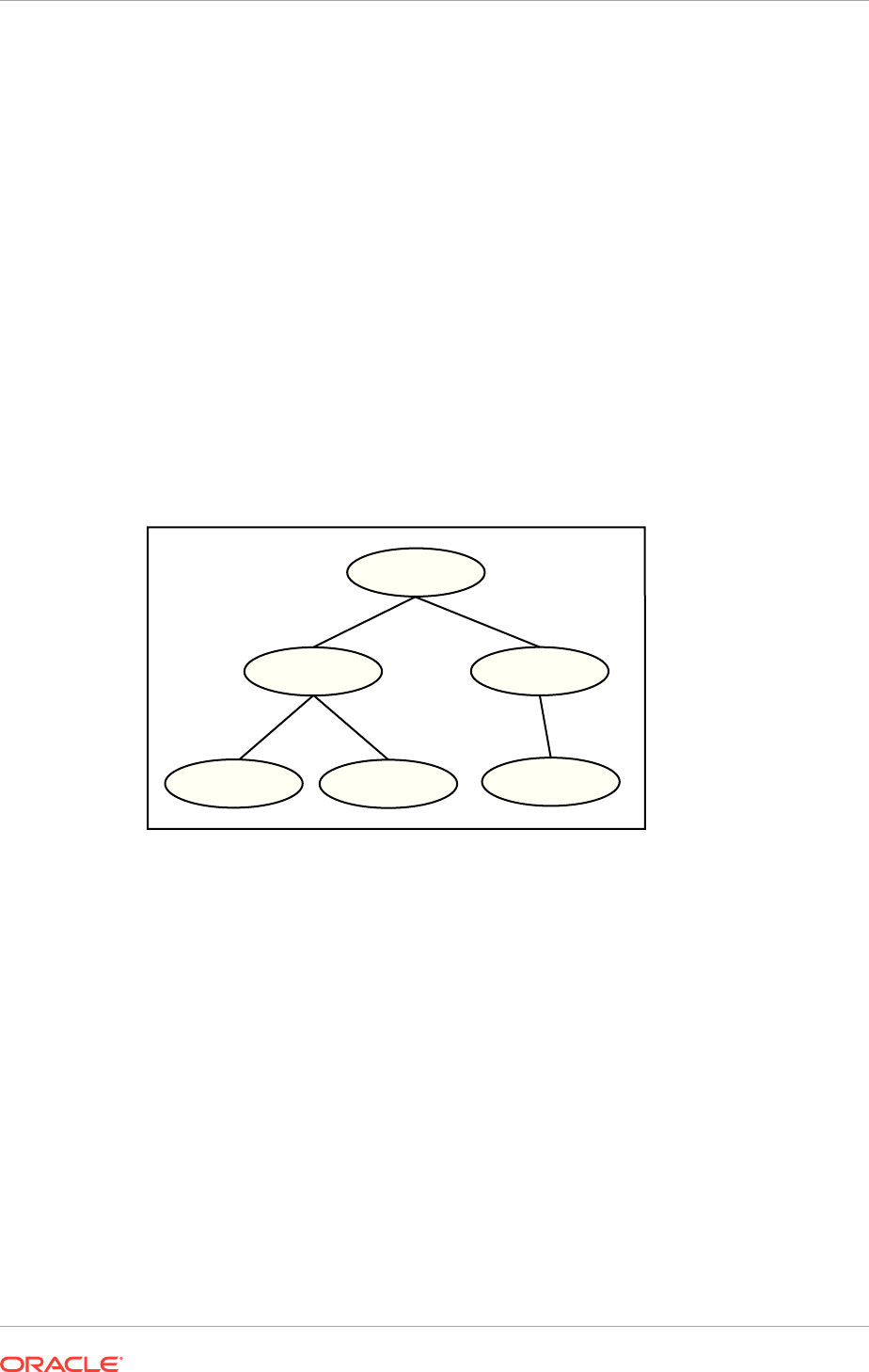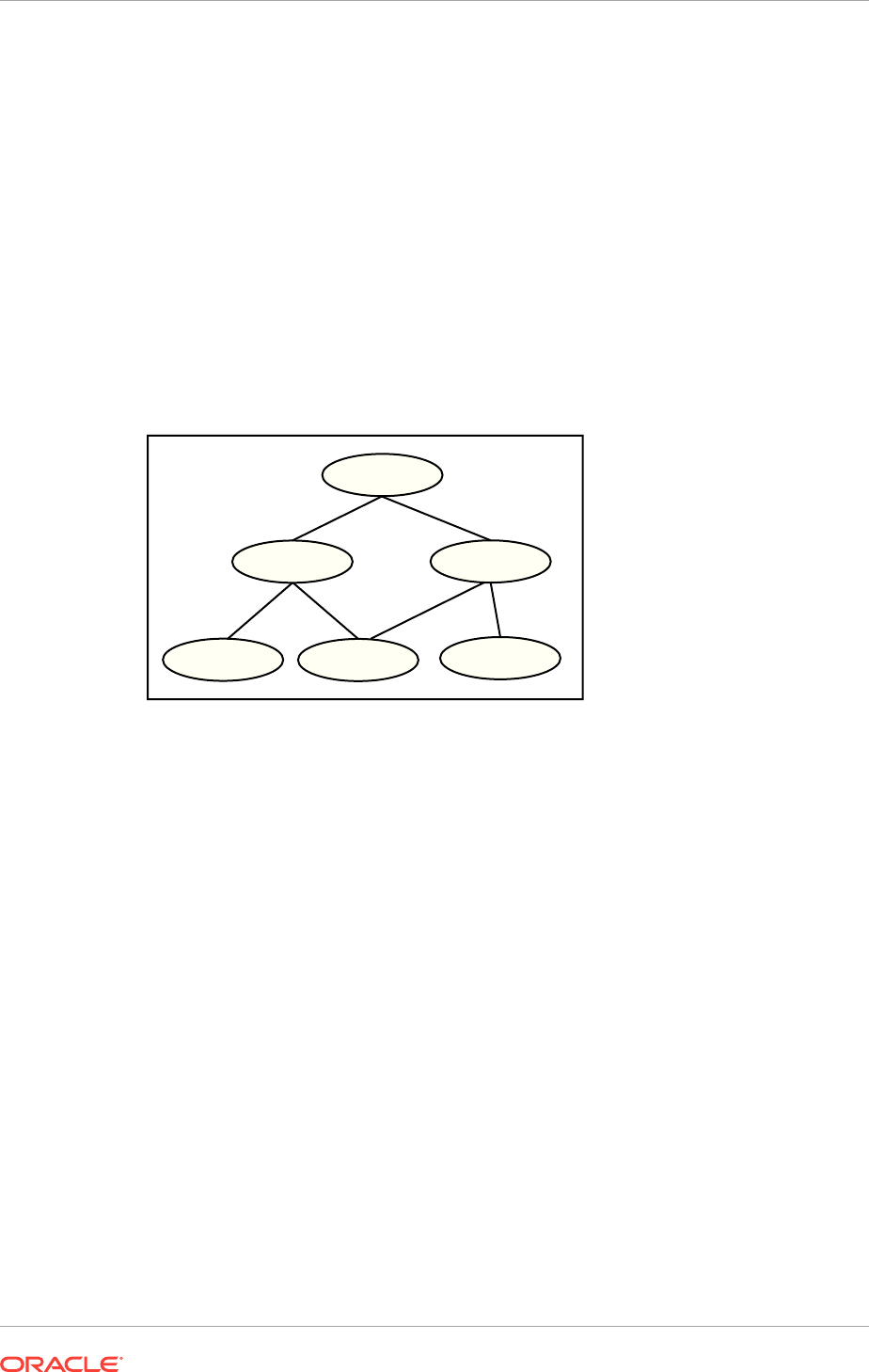
Oracle® Database
Workspace Manager Developer's Guide
18c
E84306-01
February 2018
Oracle Database Workspace Manager Developer's Guide, 18c
E84306-01
Copyright © 2000, 2018, Oracle and/or its affiliates. All rights reserved.
Primary Author: Chuck Murray
Contributors: Bill Beauregard, Ben Speckhard
This software and related documentation are provided under a license agreement containing restrictions on
use and disclosure and are protected by intellectual property laws. Except as expressly permitted in your
license agreement or allowed by law, you may not use, copy, reproduce, translate, broadcast, modify,
license, transmit, distribute, exhibit, perform, publish, or display any part, in any form, or by any means.
Reverse engineering, disassembly, or decompilation of this software, unless required by law for
interoperability, is prohibited.
The information contained herein is subject to change without notice and is not warranted to be error-free. If
you find any errors, please report them to us in writing.
If this is software or related documentation that is delivered to the U.S. Government or anyone licensing it on
behalf of the U.S. Government, then the following notice is applicable:
U.S. GOVERNMENT END USERS: Oracle programs, including any operating system, integrated software,
any programs installed on the hardware, and/or documentation, delivered to U.S. Government end users are
"commercial computer software" pursuant to the applicable Federal Acquisition Regulation and agency-
specific supplemental regulations. As such, use, duplication, disclosure, modification, and adaptation of the
programs, including any operating system, integrated software, any programs installed on the hardware,
and/or documentation, shall be subject to license terms and license restrictions applicable to the programs.
No other rights are granted to the U.S. Government.
This software or hardware is developed for general use in a variety of information management applications.
It is not developed or intended for use in any inherently dangerous applications, including applications that
may create a risk of personal injury. If you use this software or hardware in dangerous applications, then you
shall be responsible to take all appropriate fail-safe, backup, redundancy, and other measures to ensure its
safe use. Oracle Corporation and its affiliates disclaim any liability for any damages caused by use of this
software or hardware in dangerous applications.
Oracle and Java are registered trademarks of Oracle and/or its affiliates. Other names may be trademarks of
their respective owners.
Intel and Intel Xeon are trademarks or registered trademarks of Intel Corporation. All SPARC trademarks are
used under license and are trademarks or registered trademarks of SPARC International, Inc. AMD, Opteron,
the AMD logo, and the AMD Opteron logo are trademarks or registered trademarks of Advanced Micro
Devices. UNIX is a registered trademark of The Open Group.
This software or hardware and documentation may provide access to or information about content, products,
and services from third parties. Oracle Corporation and its affiliates are not responsible for and expressly
disclaim all warranties of any kind with respect to third-party content, products, and services unless otherwise
set forth in an applicable agreement between you and Oracle. Oracle Corporation and its affiliates will not be
responsible for any loss, costs, or damages incurred due to your access to or use of third-party content,
products, or services, except as set forth in an applicable agreement between you and Oracle.

Contents
Preface
Audience xvi
Documentation Accessibility xvi
Related Documents xvi
Conventions xvii
Changes in This Release for Oracle Database Workspace Manager
Developer's Guide
Changes in Oracle Database Release 18.1 xviii
Changes in Oracle Database 12c Release 2 (12.2) xix
Part I Conceptual and Usage Information
1
Introduction to Workspace Manager
1.1 Workspace Manager Overview 1-3
1.1.1 Workspace Hierarchy 1-5
1.1.2 Using Savepoints 1-5
1.1.2.1 Design Issue: Savepoint or Child Workspace? 1-6
1.1.3 Merging and Rolling Back Workspace Changes 1-7
1.1.4 Resolving Conflicts Before a Merge or Refresh Operation 1-7
1.1.5 Freezing and Unfreezing Workspaces 1-8
1.1.6 Removing Workspaces 1-9
1.1.7 Using Workspace Manager Events 1-9
1.1.8 Autocommitting of Workspace Manager Operations 1-9
1.1.9 Continually Refreshed Workspaces 1-10
1.1.10 Multiparent Workspaces 1-11
1.1.11 Infrastructure for Version-Enabling of Tables 1-12
1.1.12 Creation of Row Versions and Historical Copies 1-13
1.1.13 Workspace Manager Schema, Metadata, and Package 1-15
1.2 Session Context Information for Workspace Manager 1-15
iii

1.3 Lock Management with Workspace Manager 1-16
1.3.1 Exclusive Locking and Row Versions 1-18
1.3.2 Locks Taken for Workspace Manager Operations 1-19
1.4 Privilege Management with Workspace Manager 1-24
1.5 System Parameters for Workspace Manager 1-25
1.6 Import and Export Considerations 1-31
1.7 Bulk Loading into Version-Enabled Tables 1-33
1.8 DDL Operations Related to Version-Enabled Tables 1-34
1.9 Constraint Support with Workspace Manager 1-37
1.9.1 Referential Integrity Support 1-37
1.9.1.1 Locking with DML Operations on Tables with Referential Integrity
Constraints 1-39
1.9.2 Unique Constraints 1-40
1.9.3 SET NULL Constraints 1-40
1.10 Triggers on Version-Enabled Tables 1-40
1.11 Virtual Private Database Considerations 1-41
1.12 Support for Table Synonyms 1-41
1.13 Materialized View Support 1-41
1.14 Spatial and Graph Topology Support 1-42
1.14.1 Locking Considerations with Topologies 1-42
1.14.2 Additional Considerations with Topologies 1-43
1.15 Workspace Manager Reserved Words and Characters 1-43
1.16 DBMS_WM Subprogram Categories 1-44
1.16.1 Table Management Subprograms 1-44
1.16.2 Workspace Management Subprograms 1-45
1.16.3 Savepoint Management Subprograms 1-46
1.16.4 Privilege Management Subprograms 1-47
1.16.5 Lock Management Subprograms 1-47
1.16.6 Conflict Management Subprograms 1-48
1.16.7 Bulk Load Support Subprograms 1-48
1.17 Simplified Examples Using Workspace Manager 1-49
1.17.1 Example: Marketing Budget Options 1-49
1.17.2 Example: Warehouse Expansion Options 1-52
2
Workspace Manager Events
2.1 List of Workspace Manager Events 2-2
2.2 Event Parameters 2-2
2.3 ALLOW_CAPTURE_EVENTS System Parameter 2-3
2.4 AQ Operations and Workspace Manager Events 2-4
2.4.1 Workspace Manager Event Queue Administration 2-4
2.4.2 Privileges and Access Control for Queues 2-4
iv

2.4.3 Rule-Based Subscription 2-5
2.4.4 Listening for Events 2-6
2.4.5 Asynchronous Notification 2-6
3
Workspace Manager Valid Time Support
3.1 Valid Time Support: Introduction and Example 3-2
3.2 WM_PERIOD Data Type 3-3
3.3 Valid Time Constants 3-4
3.4 API Features for Valid Time Support 3-4
3.5 Operators for Valid Time Support 3-5
3.5.1 WM_CONTAINS 3-6
3.5.2 WM_EQUALS 3-7
3.5.3 WM_GREATERTHAN 3-7
3.5.4 WM_INTERSECTION 3-8
3.5.5 WM_LDIFF 3-9
3.5.6 WM_LESSTHAN 3-10
3.5.7 WM_MEETS 3-11
3.5.8 WM_OVERLAPS 3-12
3.5.9 WM_RDIFF 3-12
3.6 Queries and DML Operations with Valid Time Support 3-13
3.6.1 Queries 3-13
3.6.2 Data Manipulation (DML) Operations 3-14
3.6.2.1 Update Operations 3-14
3.6.2.2 Insert Operations 3-15
3.7 Constraint Management for Valid Time Support 3-16
3.7.1 Referential Integrity Constraints 3-16
3.7.2 Unique Constraints 3-16
3.8 Locking with Valid Time Support 3-17
3.9 Static Data Dictionary Views Affected by Valid Time Support 3-17
3.9.1 xxx_CONF Views and Valid Time Support 3-17
3.9.2 xxx_DIFF Views and Valid Time Support 3-17
3.9.3 xxx_HIST Views and Valid Time Support 3-18
3.9.4 xxx_LOCK Views and Valid Time Support 3-18
3.9.5 xxx_MW Views and Valid Time Support 3-18
3.10 Adding Valid Time Support to an Existing Table 3-18
3.11 Merging and Refreshing Workspaces for Tables with Valid Time Support 3-19
Part II Reference Information
v

4
DBMS_WM Package: Reference
4.1 Add_Topo_Geometry_Layer 4-4
4.2 AddAsParentWorkspace 4-5
4.3 AddUserDefinedHint 4-7
4.4 AlterSavepoint 4-8
4.5 AlterVersionedTable 4-9
4.6 AlterWorkspace 4-12
4.7 BeginBulkLoading 4-13
4.8 BeginDDL 4-15
4.9 BeginResolve 4-16
4.10 ChangeWorkspaceType 4-17
4.11 CommitBulkLoading 4-18
4.12 CommitDDL 4-21
4.13 CommitResolve 4-23
4.14 CompressWorkspace 4-24
4.15 CompressWorkspaceTree 4-28
4.16 CopyForUpdate 4-31
4.17 CopyWorkspace 4-32
4.18 CreateSavepoint 4-33
4.19 CreateWorkspace 4-34
4.20 Delete_Topo_Geometry_Layer 4-36
4.21 DeleteSavepoint 4-37
4.22 DisableVersioning 4-40
4.23 EnableVersioning 4-42
4.24 Export 4-45
4.25 Export_Schemas 4-49
4.26 FindRICSet 4-51
4.27 FreezeWorkspace 4-52
4.28 GetBulkLoadVersion 4-54
4.29 GetConflictWorkspace 4-56
4.30 GetDiffVersions 4-56
4.31 GetLockMode 4-57
4.32 GetMultiWorkspaces 4-57
4.33 GetOpContext 4-58
4.34 GetOriginalDDL 4-59
4.35 GetPhysicalTableName 4-60
4.36 GetPrivs 4-61
4.37 GetSessionInfo 4-61
4.38 GetSystemParameter 4-63
4.39 GetValidFrom 4-63
vi

4.40 GetValidTill 4-64
4.41 GetVersion 4-64
4.42 GetWMMetadataSpace 4-65
4.43 GetWorkspace 4-66
4.44 GotoDate 4-66
4.45 GotoSavepoint 4-68
4.46 GotoWorkspace 4-69
4.47 GrantGraphPriv 4-69
4.48 GrantPrivsOnPolicy 4-71
4.49 GrantSystemPriv 4-72
4.50 GrantWorkspacePriv 4-73
4.51 Import 4-75
4.52 Import_Schemas 4-77
4.53 Initialize_After_Import 4-79
4.54 IsWorkspaceOccupied 4-80
4.55 LockRows 4-81
4.56 MergeTable 4-83
4.57 MergeWorkspace 4-85
4.58 Move_Proc 4-87
4.59 PurgeTable 4-88
4.60 RecoverAllMigratingTables 4-90
4.61 RecoverFromDroppedUser 4-91
4.62 RecoverMigratingTable 4-92
4.63 RefreshTable 4-93
4.64 RefreshWorkspace 4-94
4.65 RemoveAsParentWorkspace 4-96
4.66 RemoveDeferredWorkspaces 4-97
4.67 RemoveUserDefinedHint 4-98
4.68 RemoveWorkspace 4-98
4.69 RemoveWorkspaceTree 4-100
4.70 RenameSavepoint 4-101
4.71 RenameWorkspace 4-101
4.72 ResolveConflicts 4-102
4.73 RevokeGraphPriv 4-104
4.74 RevokeSystemPriv 4-106
4.75 RevokeWorkspacePriv 4-107
4.76 RollbackBulkLoading 4-108
4.77 RollbackDDL 4-109
4.78 RollbackResolve 4-110
4.79 RollbackTable 4-111
4.80 RollbackToSP 4-112
vii

4.81 RollbackWorkspace 4-113
4.82 SetCaptureEvent 4-115
4.83 SetCompressWorkspace 4-116
4.84 SetConflictWorkspace 4-117
4.85 SetDiffVersions 4-118
4.86 SetLockingOFF 4-119
4.87 SetLockingON 4-120
4.88 SetMultiWorkspaces 4-121
4.89 SetSystemParameter 4-122
4.90 SetTriggerEvents 4-123
4.91 SetValidTime 4-125
4.92 SetValidTimeFilterOFF 4-125
4.93 SetValidTimeFilterON 4-126
4.94 SetWMValidUpdateModeOFF 4-127
4.95 SetWMValidUpdateModeON 4-127
4.96 SetWoOverwriteOFF 4-128
4.97 SetWoOverwriteON 4-129
4.98 SetWorkspaceLockModeOFF 4-129
4.99 SetWorkspaceLockModeON 4-130
4.100 UnfreezeWorkspace 4-132
4.101 UnlockRows 4-133
4.102 UseDefaultValuesForNulls 4-135
5
Workspace Manager Static Data Dictionary Views
5.1 ALL_MP_GRAPH_WORKSPACES 5-3
5.2 ALL_MP_PARENT_WORKSPACES 5-4
5.3 ALL_REMOVED_WORKSPACES 5-4
5.4 ALL_VERSION_HVIEW 5-5
5.5 ALL_WM_CONS_COLUMNS 5-6
5.6 ALL_WM_CONSTRAINT_VIOLATIONS 5-6
5.7 ALL_WM_CONSTRAINTS 5-7
5.8 ALL_WM_IND_COLUMNS 5-7
5.9 ALL_WM_IND_EXPRESSIONS 5-8
5.10 ALL_WM_LOCKED_TABLES 5-8
5.11 ALL_WM_MODIFIED_TABLES 5-9
5.12 ALL_WM_POLICIES 5-9
5.13 ALL_WM_RIC_INFO 5-9
5.14 ALL_WM_TAB_TRIGGERS 5-10
5.15 ALL_WM_VERSIONED_TABLES 5-12
5.16 ALL_WM_VT_ERRORS 5-13
viii

5.17 ALL_WORKSPACE_PRIVS 5-14
5.18 ALL_WORKSPACE_SAVEPOINTS 5-14
5.19 ALL_WORKSPACES 5-15
5.20 DBA_REMOVED_WORKSPACES 5-17
5.21 DBA_WM_SYS_PRIVS 5-17
5.22 DBA_WM_VERSIONED_TABLES 5-17
5.23 DBA_WM_VT_ERRORS 5-17
5.24 DBA_WORKSPACE_PRIVS 5-18
5.25 DBA_WORKSPACE_SAVEPOINTS 5-18
5.26 DBA_WORKSPACE_SESSIONS 5-18
5.27 DBA_WORKSPACES 5-18
5.28 ROLE_WM_PRIVS 5-20
5.29 USER_MP_GRAPH_WORKSPACES 5-20
5.30 USER_MP_PARENT_WORKSPACES 5-20
5.31 USER_REMOVED_WORKSPACES 5-20
5.32 USER_WM_CONS_COLUMNS 5-21
5.33 USER_WM_CONSTRAINTS 5-21
5.34 USER_WM_IND_COLUMNS 5-21
5.35 USER_WM_IND_EXPRESSIONS 5-21
5.36 USER_WM_LOCKED_TABLES 5-21
5.37 USER_WM_MODIFIED_TABLES 5-21
5.38 USER_WM_POLICIES 5-21
5.39 USER_WM_PRIVS 5-22
5.40 USER_WM_RIC_INFO 5-22
5.41 USER_WM_TAB_TRIGGERS 5-22
5.42 USER_WM_VERSIONED_TABLES 5-22
5.43 USER_WM_VT_ERRORS 5-22
5.44 USER_WORKSPACE_PRIVS 5-23
5.45 USER_WORKSPACE_SAVEPOINTS 5-23
5.46 USER_WORKSPACES 5-23
5.47 WM_COMPRESS_BATCH_SIZES 5-23
5.48 WM_COMPRESSIBLE_TABLES 5-23
5.49 WM_EVENTS_INFO 5-24
5.50 WM_INSTALLATION 5-24
5.51 xxx_CONF Views 5-24
5.52 xxx_DIFF Views 5-26
5.53 xxx_HIST Views 5-27
5.54 xxx_LOCK Views 5-28
5.55 xxx_MW Views 5-29
ix

List of Tables
1-1 Freeze Results of Procedures 1-9
1-2 Name Length Guidelines for Workspace Manager 1-12
1-3 Workspace Manager Lock Modes and Data Modification Ability 1-17
1-4 Operations and Incompatible Freeze Modes for Workspace Types 1-20
1-5 Workspace Manager Privileges 1-24
1-6 Workspace Manager System Parameters 1-26
1-7 Workspace Manager Reserved Words and Characters 1-43
1-8 Table Management Subprograms 1-44
1-9 Workspace Management Subprograms 1-45
1-10 Savepoint Management Subprograms 1-47
1-11 Privilege Management Subprograms 1-47
1-12 Lock Management Subprograms 1-47
1-13 Conflict Management Subprograms 1-48
1-14 Bulk Loading Support Subprograms 1-48
2-1 Workspace Manager Events 2-2
2-2 Workspace Manager Event Parameters 2-2
2-3 AQ Administrative Views for Workspace Manager 2-4
3-1 Constants for Valid Time Support 3-4
3-2 API Features for Valid Time Support 3-4
3-3 validTill Values and Intersection Result from Merge or Refresh Operation 3-19
4-1 Add_Topo_Geometry_Layer Procedure Parameters 4-5
4-2 AddAsParentWorkspace Procedure Parameters 4-6
4-3 AddUserDefinedHint Procedure Parameters 4-7
4-4 AlterSavepoint Procedure Parameters 4-8
4-5 AlterVersionedTable Procedure Parameters 4-9
4-6 AlterWorkspace Procedure Parameters 4-12
4-7 BeginBulkLoading Procedure Parameters 4-13
4-8 BeginDDL Procedure Parameters 4-15
4-9 BeginResolve Procedure Parameters 4-16
4-10 ChangeWorkspaceType Procedure Parameters 4-17
4-11 CommitBulkLoading Procedure Parameters 4-19
4-12 CommitDDL Procedure Parameters 4-21
4-13 CommitResolve Procedure Parameters 4-23
4-14 CompressWorkspace Procedure Parameters 4-24
4-15 CompressWorkspaceTree Procedure Parameters 4-28
xii

4-16 CopyForUpdate Procedure Parameters 4-31
4-17 CopyWorkspace Procedure Parameters 4-32
4-18 CreateSavepoint Procedure Parameters 4-33
4-19 CreateWorkspace Procedure Parameters 4-35
4-20 Delete_Topo_Geometry_Layer Procedure Parameters 4-36
4-21 DeleteSavepoint Procedure Parameters 4-38
4-22 DisableVersioning Procedure Parameters 4-40
4-23 EnableVersioning Procedure Parameters 4-43
4-24 Export Procedure Parameters 4-46
4-25 Export_Schemas Procedure Parameters 4-49
4-26 FindRICSet Procedure Parameters 4-51
4-27 FreezeWorkspace Procedure Parameters 4-53
4-28 GetBulkLoadVersion Function Parameters 4-55
4-29 GetOriginalDDL Procedure Parameters 4-59
4-30 GetPhysicalTableName Function Parameters 4-60
4-31 GetPrivs Function Parameters 4-61
4-32 GetSessionInfo Procedure Parameters 4-61
4-33 GetSystemParameter Procedure Parameters 4-63
4-34 GotoDate Procedure Parameters 4-66
4-35 GotoSavepoint Procedure Parameters 4-68
4-36 GotoWorkspace Procedure Parameters 4-69
4-37 GrantGraphPriv Procedure Parameters 4-70
4-38 GrantPrivsOnPolicy Procedure Parameters 4-71
4-39 GrantSystemPriv Procedure Parameters 4-72
4-40 GrantWorkspacePriv Procedure Parameters 4-73
4-41 Import Procedure Parameters 4-75
4-42 Import_Schemas Procedure Parameters 4-78
4-43 Initialize_After_Import Procedure Parameters 4-80
4-44 IsWorkspaceOccupied Function Parameters 4-81
4-45 LockRows Procedure Parameters 4-82
4-46 MergeTable Procedure Parameters 4-83
4-47 MergeWorkspace Procedure Parameters 4-85
4-48 Move_Proc Procedure Parameters 4-87
4-49 PurgeTable Procedure Parameters 4-88
4-50 RecoverAllMigratingTables Procedure Parameters 4-90
4-51 RecoverFromDroppedUser Procedure Parameters 4-91
4-52 RecoverMigratingTable Procedure Parameters 4-92
xiii

4-53 RefreshTable Procedure Parameters 4-93
4-54 RefreshWorkspace Procedure Parameters 4-94
4-55 RemoveAsParentWorkspace Procedure Parameters 4-96
4-56 RemoveWorkspace Procedure Parameters 4-97
4-57 RemoveUserDefinedHint Procedure Parameters 4-98
4-58 RemoveWorkspace Procedure Parameters 4-99
4-59 RemoveWorkspaceTree Procedure Parameters 4-100
4-60 RenameSavepoint Procedure Parameters 4-101
4-61 RenameWorkspace Procedure Parameters 4-102
4-62 ResolveConflicts Procedure Parameters 4-102
4-63 RevokeGraphPriv Procedure Parameters 4-105
4-64 RevokeSystemPriv Procedure Parameters 4-106
4-65 RevokeWorkspacePriv Procedure Parameters 4-107
4-66 RollbackBulkLoading Procedure Parameters 4-108
4-67 RollbackDDL Procedure Parameters 4-109
4-68 RollbackResolve Procedure Parameters 4-110
4-69 RollbackTable Procedure Parameters 4-111
4-70 RollbackToSP Procedure Parameters 4-112
4-71 RollbackWorkspace Procedure Parameters 4-114
4-72 SetCaptureEvent Procedure Parameters 4-115
4-73 SetCompressWorkspace Procedure Parameters 4-116
4-74 SetConflictWorkspace Procedure Parameters 4-117
4-75 SetDiffVersions Procedure Parameters 4-118
4-76 SetLockingON Procedure Parameters 4-120
4-77 SetMultiWorkspaces Procedure Parameters 4-121
4-78 SetSystemParameter Procedure Parameters 4-122
4-79 SetTriggerEvents Procedure Parameters 4-124
4-80 SetValidTime Procedure Parameters 4-125
4-81 SetValidTimeFilterON Procedure Parameters 4-126
4-82 SetWorkspaceLockModeOFF Procedure Parameters 4-130
4-83 SetWorkspaceLockModeON Procedure Parameters 4-131
4-84 UnfreezeWorkspace Procedure Parameters 4-133
4-85 UnlockRows Procedure Parameters 4-133
4-86 UseDefaultValuesForNulls Procedure Parameters 4-135
5-1 Columns in the xxx_CONF Views 5-25
5-2 Columns in the xxx_DIFF Views 5-26
5-3 Columns in the xxx_HIST Views 5-27
xiv

Preface
Oracle Database Workspace Manager Developer's Guide describes Oracle
Workspace Manager, often referred to as Workspace Manager, which enables
applications to create workspaces and group different versions of table row values in
different workspaces.
• Audience
• Documentation Accessibility
• Related Documents
• Conventions
Audience
Oracle Database Workspace Manager Developer's Guide is intended for application
designers and developers. It is assumed that you have some experience programming
in PL/SQL.
Documentation Accessibility
For information about Oracle's commitment to accessibility, visit the Oracle
Accessibility Program website at http://www.oracle.com/pls/topic/lookup?
ctx=acc&id=docacc.
Access to Oracle Support
Oracle customers that have purchased support have access to electronic support
through My Oracle Support. For information, visit http://www.oracle.com/pls/topic/
lookup?ctx=acc&id=info or visit http://www.oracle.com/pls/topic/lookup?ctx=acc&id=trs
if you are hearing impaired.
Related Documents
For more information about using this product in a development environment, see the
following documents:
• Oracle Call Interface Programmer's Guide
• Oracle Database Concepts
• Oracle Database PL/SQL Language Reference
Preface
xvi

Conventions
The following text conventions are used in this document:
Convention Meaning
boldface Boldface type indicates graphical user interface elements associated
with an action, or terms defined in text or the glossary.
italic Italic type indicates book titles, emphasis, or placeholder variables for
which you supply particular values.
monospace
Monospace type indicates commands within a paragraph, URLs, code
in examples, text that appears on the screen, or text that you enter.
Preface
xvii

Changes in This Release for Oracle
Database Workspace Manager
Developer's Guide
This preface contains:
• Changes in Oracle Database Release 18.1
• Changes in Oracle Database 12c Release 2 (12.2)
Changes in Oracle Database Release 18.1
The following are changes in Oracle Database Workspace Manager Developer's
Guide for Oracle Database Release 18.1.
• New DBMS_WM Procedure: CopyWorkspace
• New Static Data Dictionary View: ALL_WM_CONSTRAINT_VIOLATIONS
New DBMS_WM Procedure: CopyWorkspace
The new CopyWorkspace procedure copies all of the rows that have been modified in
a source workspace into a tearget workspace. Other changes related to this new
procedure include:
• New error codes are added in Workspace Manager Error Messages:
WM_ERROR_393 The LIVE workspace cannot be the source or target workspace
WM_ERROR_396 The source and target workspaces cannot be the same
workspace
• A row for CopyWorkspace is added to the table of Operations and Incompatible
Freeze Modes for Workspace Types in Locks Taken for Workspace Manager
Operations.
•
WORKSPACE_COPY
is added as a return value for the GetOpContext function.
New Static Data Dictionary View:
ALL_WM_CONSTRAINT_VIOLATIONS
The new ALL_WM_CONSTRAINT_VIOLATIONS static data dictionary view contains
information related to unique, foreign key, and check constraint violation errors raised
while executing certain procedures.
Changes in This Release for Oracle Database Workspace Manager Developer's Guide
xviii

Changes in Oracle Database 12c Release 2 (12.2)
The following are changes in Oracle Database Workspace Manager Developer's
Guide for Oracle Database 12c Release 1 (12.2).
• New Features (12.2)
• Desupported: Advanced Replication Support in Workspace Manager (12.2)
New Features (12.2)
The following features are new in this release:
• New DBMS_WM Subprograms (12.2)
• Changes to Existing DBMS_WM Subprograms (12.2)
• Other Enhancements (12.2)
• Workspace Manager Static Data Dictionary Views (12.2)
• System Parameter-Related Changes (12.2)
• Privilege-Related Changes (12.2)
New DBMS_WM Subprograms (12.2)
The following are new DBMS_WM subprograms. They are documented in DBMS_WM
Package: Reference.
• Initialize_After_Import
• RemoveDeferredWorkspaces
Changes to Existing DBMS_WM Subprograms (12.2)
Changes to existing DBMS_WM subprograms include the following:
• Export: The staging table now includes a wm$deletedrow column when the
versioned_db
parameter is set to
true
, which can be used to determine if the row
was in a deleted form in the source database.
• RemoveWorkspace:
defer_option
is a new parameter.
• RemoveWorkspaceTree:
defer_option
is a new parameter.
Other Enhancements (12.2)
Other enhancements to Workspace Manager include the following.
DDL enhancements: You can now do the following within a DDL session (see DDL
Operations Related to Version-Enabled Tables):
• Add invisible indexes.
• Add reverse indexes.
• Use the
compress
and
prefix_length
parameter options on an index.
Changes in This Release for Oracle Database Workspace Manager Developer's Guide
xix

Enable-versioning enhancements: Virtual columns and identity columns are supported
on version-enabled tables.
Referential integrity constraint enhancements: You can add, drop, enable, or disable a
referential integrity constraint that involves two tables regardless of whether (A) both
tables are version-enabled, or (B) one table is version-enabled and the other table is
not. Previously, both tables needed to be version-enabled. For more information, see
Referential Integrity Support.
Locking enhancements: The new
D
(disregard) lockmode can be used to create a test
(“sandbox”) workspace that allows the modification of any rows, even rows that are
locked by other workspaces, with the restriction that the workspace cannot be merged
or refreshed.
Workspace Manager Static Data Dictionary Views (12.2)
The following are new Workspace Manager static data dictionary views and changes
to existing views. The views are documented in Workspace Manager Static Data
Dictionary Views.
• For every DBA_xxx view, a CDB_xxx view is defined.
• The FREEZE_MODE column is now of type VARCHAR2(16) in the
xxx_WORKSPACES views.
• The PRIVILEGE column is now of type VARCHAR2(23) in the
xxx_WORKSPACE_PRIVS, xxx_WM_PRIVS, and DBA_WM_SYS_PRIVS views.
System Parameter-Related Changes (12.2)
CREATEWORKSPACE_SHARED_LOCK is a new system parameter that changes
the type of lock taken on the parent workspace when executing the CreateWorkspace
procedure.
DEFAULT_WORKSPACE is a new system parameter that allows a new default
workspace to be defined, instead of
LIVE
.
REMOVEWORKSPACE_DEFERRED is a new system parameter that allows the
physical removal of rows to be delayed during RemoveWorkspace and
RemoveWorkspaceTree operations, as well as MergeWorkspace when the
remove_workspace
parameter set to
true
.
Privilege-Related Changes (12.2)
GRANTPRIV_WORKSPACE is a new workspace level privilege that allows the user to
grant other users privileges on a specific workspace.
GRANTPRIV_ANY_WORKSPACE is a new system privilege that allows the user to
grant other users privileges on any workspace.
WM_ADMIN is a new privilege that provides a user with all Workspace Manager-
related privileges.
These privileges are included in Privilege Management with Workspace Manager.
Changes in This Release for Oracle Database Workspace Manager Developer's Guide
xx

Desupported: Advanced Replication Support in Workspace Manager
(12.2)
Advanced Replication is desupported effective with Oracle Database Release 12.2. As
a result, the Workspace Manager guide no longer contains the following topics:
• DBMS_WM subprograms dropReplicationSupport, generateReplicationSupport,
relocateWriterSite, and synchronizeSite
• The previous appendix “Using Replication with Workspace Manager”
Changes in This Release for Oracle Database Workspace Manager Developer's Guide
xxi

Part I
Conceptual and Usage Information
This document has three parts:
• Part I provides conceptual and usage information about Workspace Manager.
• Reference Information provides reference information about the Workspace
Manager PL/SQL API (DBMS_WM package) and static data dictionary views.
• Supplementary Information provides supplementary information (appendixes and
a glossary).
Part I is organized for efficient learning about Workspace Manager. It covers basic
concepts and techniques first, and proceeds to more advanced material (such as
Workspace Manager events and valid time support). Part I contains the following
chapters:
• Introduction to Workspace Manager
Oracle Workspace Manager, often referred to as Workspace Manager, provides
an infrastructure that enables applications to create workspaces and group
different versions of table row values in different workspaces.
• Workspace Manager Events
Certain applications may be interested in knowing what Workspace Manager
operations are being performed and may want to take some actions based on that.
Several types of Workspace Manager operations can be captured as events.
• Workspace Manager Valid Time Support
This chapter describes the support for valid time, also known as effective dating,
with version-enabled tables.

1
Introduction to Workspace Manager
Oracle Workspace Manager, often referred to as Workspace Manager, provides an
infrastructure that enables applications to create workspaces and group different
versions of table row values in different workspaces.
Users are permitted to create new versions of data to update, while maintaining a copy
of the old data. The ongoing results of the activity are stored persistently, assuring
concurrency and consistency.
Applications that can benefit from Workspace Manager typically do one or more of the
following operations:
• Manage a collection of updates and insertions as a unit before incorporating them
into production data
You can review changes and roll back undesirable ones before making the
changes public. Until you make the changes public, they are invisible to other
users of the database, who will access only the regular production data. You can
organize the changes in a simple set of workspaces or in a complex workspace
hierarchy. A typical example might be a life sciences application in which
Workspace Manager supports the discovery and quality assurance (QA)
processes by managing a collection of updates before they are merged with the
production data.
• Support a collaborative development effort
A team can share access to a collection of updates and insertions for a
collaborative project. Workspace privileges control access to a workspace and its
operations, and you can restrict workspace access to single-writer, read-only, or
no access. Workspace locks prevent update conflicts between projects in separate
workspaces. A typical example might be an application to design an engineering
project, in which multiple subprojects are concurrently developed in separate
workspaces.
• Use a common data set to create multiple scenarios for what-if analyses or
multiple editions of data for publication
You can organize changes in workspaces to view them in the context of the whole
database, but without requiring that you actually copy data between tables.
Different users can make simultaneous changes to the same row, and you can
detect and resolve conflicts. A typical example might be a telecommunications
application in which you create multiple cell phone coverage scenarios to find the
optimal design.
• Keep a history of changes to data
You can navigate workspaces and row versions to view the database as of a
particular milestone or point in time. You can roll back changes to a row or table in
a workspace to a milestone. A typical example might be a land information
management application where Workspace Manager supports regulatory
requirements by maintaining a history of all changes to land parcels.
1-1

Workspace Manager is also useful in managing long-transaction scenarios, where
complex, long-duration database transactions can take days to complete, and multiple
users must access the same database.
This chapter explains concepts and operations that you must understand to use
Workspace Manager. For complete examples of Workspace Manager, see Simplified
Examples Using Workspace Manager. However, you may want to read the rest of this
chapter first, to understand the concepts that the examples illustrate.
Note:
Workspace Manager is installed by default in the Oracle seed database and
any database created using the Database Configuration Assistant (DBCA). To
use Workspace Manager in any other Oracle database, you must first perform
the installation procedure described in Installing Workspace Manager with
Custom Databases.
• Workspace Manager Overview
Workspace Manager enables you to version-enable one or more user tables in
the database. When a table is version-enabled, all rows in the table can support
multiple versions of the data.
• Session Context Information for Workspace Manager
Users perform Workspace Manager operations within a standard Oracle session.
• Lock Management with Workspace Manager
• Privilege Management with Workspace Manager
Workspace Manager provides a set of privileges that are separate from standard
Oracle database privileges.
• System Parameters for Workspace Manager
Workspace Manager provides a set of system parameters that allow a user with
the WM_ADMIN system privilege to enforce global Workspace Manager-specific
settings for the database.
• Import and Export Considerations
Workspace Manager supports the import and export of version-enabled tables in
any of the following ways: a full database import and export, an import and export
that only includes the schemas required by Workspace Manager, or a workspace-
level import and export through Workspace Manager procedures.
• Bulk Loading into Version-Enabled Tables
You can use SQL*Loader to perform bulk loading into version-enabled tables, but
you must also call some special Workspace Manager procedures, and some
restrictions apply.
• DDL Operations Related to Version-Enabled Tables
To perform DDL (data definition language) operations on a version-enabled table,
you must use special Workspace Manager procedures before and after the DDL
operations, and you must specify the name of a special table created by
Workspace Manager.
• Constraint Support with Workspace Manager
This section describes Workspace Manager considerations relating to the use of
database constraints.
Chapter 1
1-2

• Triggers on Version-Enabled Tables
Version-enabled tables can have triggers defined; however, the following
considerations and restrictions apply.
• Virtual Private Database Considerations
You can use Workspace Manager in conjunction with the Oracle Virtual Private
Database (VPD) technology.
• Support for Table Synonyms
For any Workspace Manager procedure or function input parameter that calls for a
table name, you can instead specify a synonym.
• Materialized View Support
This section describes considerations for using Workspace Manager with
materialized views.
• Spatial and Graph Topology Support
This section describes special considerations and techniques for using Workspace
Manager with tables in Oracle Spatial and Graph topologies,
• Workspace Manager Reserved Words and Characters
Because Workspace Manager creates internal objects using its own naming
conventions, you must avoid some words and characters in the names for certain
kinds objects.
• DBMS_WM Subprogram Categories
The Workspace Manager application programming interface (API) consists of
PL/SQL subprograms (procedures and functions) in a single PL/SQL package
named
DBMS_WM
.
• Simplified Examples Using Workspace Manager
This topic presents two simplified examples of using Workspace Manager to try
out some scenarios and select one of them.
1.1 Workspace Manager Overview
Workspace Manager enables you to version-enable one or more user tables in the
database. When a table is version-enabled, all rows in the table can support multiple
versions of the data.
The versioning infrastructure is not visible to the users of the database, and application
SQL statements for selecting, inserting, modifying, and deleting data continue to work
in the usual way with version-enabled tables, although you cannot update a primary
key column value in a version-enabled table. (Workspace Manager implements these
capabilities by maintaining system views and creating
INSTEAD OF
triggers, as explained
in Infrastructure for Version-Enabling of Tables; however, application developers and
users do not need to see or interact with the views and triggers.)
After a table is version-enabled, users in a workspace automatically see the correct
version of the record in which they are interested. If you no longer need a table to be
version-enabled, you can disable versioning for the table.
A workspace is a virtual environment that one or more users can share to make
changes to the data in the database. A workspace logically groups collections of new
row versions from one or more version-enabled tables, and isolates these versions
until they are explicitly merged with production data or discarded, thus providing
maximum concurrency. Users can perform a variety of operations involving
workspaces: go to, create, refresh, merge, roll back, remove, compress, alter, and
other operations.
Chapter 1
Workspace Manager Overview
1-3

Users in a workspace always see a transactionally consistent view of the entire
database; that is, they see changes made in their current workspace plus the rest of
the data in the database as it existed either when the workspace was created or when
the workspace was most recently refreshed with changes from the parent workspace.
(Workspace hierarchy and parent and child workspaces are explained in Workspace
Hierarchy.)
Workspace Manager automatically detects conflicts, which are differences in data
values resulting from changes to the same row in a workspace and its parent
workspace. You must resolve conflicts before merging changes from a workspace into
its parent workspace. You can use workspace locks to avoid conflicts.
Savepoints are points in the workspace to which row changes in version-enabled
tables can be rolled back, and to which users can go to see the database as it existed
at that point. Savepoints are usually created in response to a business-related
milestone, such as the completion of a design phase or the end of a billing period. (For
more information about savepoints, see Using Savepoints.)
The history option enables you to timestamp changes made to all rows in a version-
enabled table and to save a copy of either all changes or only the most recent
changes to each row. If you keep all changes (specifying the "without overwrite"
history option) when version-enabling a table, you keep a persistent history of all
changes made to all row versions, and enable users to go to any point in time to view
the database as it existed from the perspective of that workspace.
Workspace Manager provides a comprehensive PL/SQL API that you can add to new
and existing applications to manage workspaces, savepoints, history information,
privileges, access modes, and Workspace Manager locks, and to detect and resolve
conflicts. You can also perform many of these operations using the Oracle Enterprise
Manager graphical user interface.
Another database object created by Workspace Manager is a database-wide system
table that maps row versions to workspaces. This table is not visible to users.
• Workspace Hierarchy
• Using Savepoints
• Merging and Rolling Back Workspace Changes
• Resolving Conflicts Before a Merge or Refresh Operation
• Freezing and Unfreezing Workspaces
• Removing Workspaces
• Using Workspace Manager Events
• Autocommitting of Workspace Manager Operations
• Continually Refreshed Workspaces
• Multiparent Workspaces
• Infrastructure for Version-Enabling of Tables
• Creation of Row Versions and Historical Copies
• Workspace Manager Schema, Metadata, and Package
Chapter 1
Workspace Manager Overview
1-4

1.1.1 Workspace Hierarchy
There can be a hierarchy of workspaces in the database. For example, a workspace
can be a parent to one or more workspaces (child workspaces). By default, when a
workspace is created, it is created from the topmost, or
LIVE
, database workspace.
(Workspace names are case-sensitive, and the workspace name of the live database
is spelled
LIVE
. The length of a workspace name must not exceed 30 characters, and
the depth of the workspace hierarchy must not exceed 30 levels.) Users are included
in a workspace by a GotoWorkspace operation.
Figure 1-1 shows a hierarchy of workspaces.
Workspace1
and
Workspace4
were formed
off the
LIVE
database workspace;
Workspace2
and
Workspace3
were formed off
Workspace1
, and
Workspace5
was formed off
Workspace4
. After
Workspace1
was created, a
user executed a GotoWorkspace operation specifying
Workspace1
, and then executed
CreateWorkspace operations to create
Workspace2
and
Workspace3
. A comparable
sequence was followed with
Workspace4
and
Workspace5
.
Figure 1-1 Workspace Tree
LIVE workspace
Workspace1
Workspace2
Workspace4
Workspace3
Workspace5
See also Design Issue: Savepoint or Child Workspace? for a discussion of design
issues in deciding whether to create a child workspace or a savepoint for certain
needs
1.1.2 Using Savepoints
A savepoint is a point in the workspace to which data changes can be rolled back.
Workspace Manager accomplishes the rollback by deleting the row versions that
contain the unwanted changes.
An explicit savepoint is a savepoint that you create and name. You can later roll back
changes in version-enabled tables to the savepoint, or you can go to the savepoint to
view the state of the entire database (including versioned rows) at the time the
savepoint was created. In Figure 1-2,
SP1
,
SP2
,
SP3
, and
SP4
are explicit savepoints that
were created in the workspaces indicated. (Savepoints are indicated by dashed lines
in Figure 1-2.)
Chapter 1
Workspace Manager Overview
1-5

Figure 1-2 Savepoints
LIVE workspace
Workspace1
Workspace2
Workspace4
Workspace3
Workspace5
SPa
SPd
SPb
SPc
SPe
SP1
SP3
SP2
SP4
In addition, implicit savepoints are created automatically whenever a new workspace
is created. An implicit savepoint is needed so that the users in the child workspace get
a view of the database that is frozen at the time of the workspace creation. Thus, in
Figure 1-2 two implicit savepoints (
SPa
and
SPd
) are created in the
LIVE
workspace
corresponding to
Workspace1
and
Workspace4
creation; two implicit savepoints (
SPb
and
SPc
) are created in
Workspace1
corresponding to
Workspace2
and
Workspace3
creation;
and one implicit savepoint (
SPe
) is created in
Workspace4
corresponding to
Workspace5
creation.
Workspace Manager uses the name
LATEST
to designate a logical savepoint that refers
to the latest version in the workspace.
LATEST
is often the default when a savepoint is
an optional parameter for a
DBMS_WM
subprogram (procedure or function).
A removable savepoint is a savepoint that can be deleted by the
CompressWorkspace, CompressWorkspaceTree, and DeleteSavepoint procedures. A
savepoint is removable if either of the following applies:
• It is an explicit savepoint.
• It is an implicit savepoint that does not have any child dependencies.
• Design Issue: Savepoint or Child Workspace?
1.1.2.1 Design Issue: Savepoint or Child Workspace?
A Workspace Manager design issue that you may face is whether to create a
savepoint or a child workspace to "save" a project at a given point. Both a savepoint
and a child workspace allow you to group a set of changes, compare changes in
different row versions, and roll back a set of changes. However, creating a savepoint
enables you to continue to make changes in the same workspace, and it allows other
users in the workspace immediate access to the changes. (Changes in another
workspace are not visible to users until the current workspace is refreshed or merged.)
Creating a savepoint also makes it convenient to archive a set of changes, to which
you can later roll back.
On the other hand, creating a child workspace is convenient for providing an isolated
environment in which a complex set of changes can be made, completely removed
Chapter 1
Workspace Manager Overview
1-6

from the parent workspace (for example, the production data). If you want to set up an
independent environment for a scenario, and if regular users in the parent workspace
do not need access to this scenario's data, you probably want to create a child
workspace instead of simply creating a savepoint in the parent workspace.
1.1.3 Merging and Rolling Back Workspace Changes
Workspaces can be merged or rolled back.
Merging a workspace involves applying changes made in a child workspace to its
parent workspace, after which the child workspace is removed. To merge a
workspace, use the MergeWorkspace procedure.
Rolling back a workspace involves deleting either all data changes (row versions)
made in the workspace or all changes made after an explicit savepoint.
• To roll back all changes made in the workspace, use the RollbackWorkspace
procedure.
• To roll back changes made in the workspace after a savepoint, use the
RollbackToSP procedure.
Note:
You cannot roll back to a savepoint if any implicit savepoints were created
since the specified savepoint, unless you first merge or remove the
descendent workspaces that caused the implicit savepoints to be created.
For example, referring to the figure in Using Savepoints, the user in
Workspace1
cannot roll back to savepoint
SP1
until
Workspace3
(which caused
implicit savepoint
SPc
to be created) is merged or removed.
A workspace cannot be rolled back when it has open database transactions. Rollback
of a workspace leaves behind the workspace structure for future use; only the data in
the workspace is deleted. (To completely remove a workspace, use the
RemoveWorkspace procedure, as described in Removing Workspaces.)
1.1.4 Resolving Conflicts Before a Merge or Refresh Operation
When a child workspace is merged, the row changes in the child workspace are
incorporated in its parent workspace; and when a child workspace is refreshed, row
changes in the parent workspace are incorporated in the child workspace. When a row
is changed in both the child and parent workspace, a data conflict is created. Conflicts
are automatically detected when a merge or refresh operation is requested, and they
are presented to the user in conflict (xxx_CONF) views. There is one conflict view for
each table, as described in xxx_CONF Views. This view lists the column values of the
rows in the two workspaces involved in the conflict.
You must resolve conflicts manually by setting the workspace conflict context for the
session and then using the ResolveConflicts procedure. For each conflict you can
choose to keep the row from the child workspace, the row from the parent workspace,
or the common base row (that is, no change: keep the original data values for the
row). You must resolve the conflicts before you can perform a merge
(MergeWorkspace) or refresh (RefreshWorkspace) operation.
Chapter 1
Workspace Manager Overview
1-7

The base row is the currently visible row at the time of the first update or delete
operation in the child workspace. In the case of an insert operation, the base row does
not exist, except if the inserted row was previously deleted in an ancestor version of a
parent workspace, the base row is that deleted row. The parent row is the currently
visible row in the parent workspace at the time of the conflict resolution, and the child
row is the currently visible row in the child workspace at the time of the conflict
resolution.
Absence of data is not a conflict. In these cases, you can use the xxx_DIFF view
(described in xxx_DIFF Views) to detect a change in one workspace when there is no
row or no change to the row in the other workspace.
The general process for resolving conflicts is as follows:
1. Use the GotoWorkspace or SetConflictWorkspace procedure to set the workspace
conflict context for the session.
2. Examine the xxx_CONF views (described in xxx_CONF Views) to see what
conflicts exist.
3. Execute the BeginResolve procedure.
4. Execute the ResolveConflicts procedure as often as needed: once for each
affected combination of table and workspace.
5. After resolving all conflicts, execute one of the following procedures:
• CommitResolve if you want to make permanent all changes from the
preceding step. (However, the changes are not made permanent in the
database until you perform a standard database commit operation and
execute the MergeWorkspace or RefreshWorkspace procedure, as described
in the next step.)
• RollbackResolve to discard all changes from the preceding step. (If you
discard all changes, do not perform the next step.)
6. Perform a standard database commit operation and execute the MergeWorkspace
or RefreshWorkspace procedure.
1.1.5 Freezing and Unfreezing Workspaces
You can control read and write access to a workspace by freezing and unfreezing the
workspace. If a workspace is frozen, the ability of users to access the workspace and
to make changes to rows in version-enabled tables is restricted. You can freeze a
workspace in any of the following modes: no access, read-only, and one writer only
(
1WRITER
).
To make a workspace frozen, use the FreezeWorkspace procedure. To make a frozen
workspace not frozen, use the UnfreezeWorkspace procedure.
In addition, some procedures automatically freeze one or more workspaces. Table 1-1
lists these procedures, the workspaces affected, and the mode in which the
workspaces are frozen. (For explanations of the mode values, see the
FreezeWorkspace procedure description in DBMS_WM Package: Reference .)
Chapter 1
Workspace Manager Overview
1-8

Table 1-1 Freeze Results of Procedures
Procedure Workspace and Mode
BeginResolve Specified workspace:
1WRITER
MergeWorkspace Specified workspace:
NO_ACCESS
Parent workspace:
READ_ONLY
CompressWorkspace Specified workspace:
NO_ACCESS
(Also, checks to ensure that
there are no sessions on savepoints other than
LATEST
.)
CompressWorkspaceTree Specified workspace:
NO_ACCESS
(Also, checks to ensure that
there are no sessions on savepoints other than
LATEST
.)
CreateSavepoint Specified workspace:
READ_ONLY
DeleteSavepoint Specified workspace:
NO_ACCESS
CreateWorkspace Specified workspace:
READ_ONLY
RemoveWorkspace Specified workspace:
NO_ACCESS
RefreshWorkspace Specified workspace:
READ_ONLY
Parent workspace:
READ_ONLY
RollbackResolve Specified workspace:
1WRITER
RollbackWorkspace Specified workspace:
NO_ACCESS
1.1.6 Removing Workspaces
A workspace can be removed with the RemoveWorkspace procedure.
RemoveWorkspace rolls back the data in a workspace and then deletes the
workspace structure. An entire tree of workspaces can be removed with the
RemoveWorkspaceTree procedure. This will remove the workspace and all its
descendant workspaces. A workspace cannot be removed when it has users in it.
1.1.7 Using Workspace Manager Events
Several types of Workspace Manager operations can be captured as events, and can
be communicated to applications through the Oracle Advanced Queuing (AQ)
framework. Messaging features provided by AQ, such as asynchronous notification,
persistence, propagation, access control, history, and rule-based subscription, can be
used for Workspace Manager events.
Support for Workspace Manager events includes the
ALLOW_CAPTURE_EVENTS
Workspace
Manager system parameter, the SetCaptureEvent procedure, and the
WM_EVENTS_INFO metadata view.
Workspace Manager Events describes Workspace Manager events and explains how
to use them in applications.
1.1.8 Autocommitting of Workspace Manager Operations
Many Workspace Manager operations are by default executed as autonomous
database transactions that will be committed when they finish. That is, each such
transaction is an independent transaction that is called from within the current
database transaction, leaves the context of the calling transaction, performs the
Chapter 1
Workspace Manager Overview
1-9

Workspace Manager operation and then automatically commits it, and then returns to
the calling transaction's context and continues with that transaction. Workspace
Manager (
DBMS_WM
) subprograms that operate in this way have an optional
auto_commit
parameter, which has a default value of
TRUE
.
For example, the CompressWorkspace procedure by default starts an autonomous
transaction, compresses the workspace, commits the compression operation, and
returns to the calling transaction's context, where the current database transaction
continues.
However, if you want such subprograms not to start an autonomous transaction, but
instead to execute in the context of the calling transaction, you can specify the
auto_commit
parameter with a value of
FALSE
. In this case, the Workspace Manager
operation is executed as part of the current database transaction; and if there is no
current open transaction, the Workspace Manager operation starts a new transaction.
In either case, the Workspace Manager operation does not take effect until that
transaction ends with a commit operation. For example, if you call the
CompressWorkspace procedure with the
auto_commit
parameter specified as
FALSE
, the
workspace is not compressed until the transaction is committed; and if the transaction
is rolled back, the workspace is not compressed.
Note that if you specify
FALSE
for the
auto_commit
parameter, you must remember to
commit or roll back the transaction explicitly.
If the
auto_commit
parameter value is
TRUE
and any open transactions exist, the
following considerations apply:
• For the CompressWorkspace and CompressWorkspaceTree procedures, an
exception is raised if there is any open transaction.
• For all other Workspace Manager procedures, an exception is raised if there is an
open transaction in a parent or child workspace of any table that needs to be
modified.
1.1.9 Continually Refreshed Workspaces
A continually refreshed workspace is a workspace that is automatically refreshed
from its parent workspace whenever data changes are committed in the parent
workspace or are merged into the parent workspace from another child workspace.
You do not need to call the RefreshWorkspace procedure for a continually refreshed
workspace.
Any workspace in a branch of the workspace tree can be continually refreshed. A child
workspace can be a continually refreshed workspace, regardless of whether its parent
workspace is continually refreshed. However, if a parent workspace is a continually
refreshed workspace, its child workspaces must also be continually refreshed.
To create a continually refreshed workspace, specify
TRUE
for the
isrefreshed
parameter in the call to the CreateWorkspace procedure. See the Usage Notes for the
CreateWorkspace procedure for rules that apply to the creation of a continually
refreshed workspace.
To change a workspace that is not continually refreshed to be continually refreshed,
use the ChangeWorkspaceType procedure.
If a workspace is not continually refreshed, you must call the RefreshWorkspace
procedure whenever you want to ensure that data changes in its parent workspace are
visible in the workspace.
Chapter 1
Workspace Manager Overview
1-10

1.1.10 Multiparent Workspaces
A multiparent workspace is a child workspace that has two or more parent
workspaces. A workspace is initially created with a single parent workspace. However,
if the need arises, you can add other workspaces as parent workspaces to an existing
workspace, thus making it a multiparent workspace. The multiparent workspace can
see data from all of its parent workspaces and their ancestor workspaces, and it can
be merged with and refreshed from its parent workspaces.
Figure 1-3 shows the same hierarchy of workspaces in Figure 1-1, except that
Workspace3
is now a multiparent workspace with two parent workspaces:
Workspace1
and
Workspace4
.
Figure 1-3 Multiparent Workspace in a Workspace Hierarchy
LIVE workspace
Workspace1
Workspace2
Workspace4
Workspace3
Workspace5
(multiparent)
A multiparent workspace is also called a multiparent leaf workspace. Thus, in
Figure 1-3,
Workspace3
is a multiparent leaf workspace. The nearest common ancestor
of all parent workspaces of a multiparent lead workspace is called the multiparent
root workspace. In Figure 1-3, the
LIVE
workspace is the multiparent root workspace
of
Workspace3
. All of the workspaces in the directed acyclic graph (DAG) formed as a
result of adding parent workspaces as parents of a leaf workspace are called
multiparent graph workspaces. In Figure 1-3,
Workspace1
,
Workspace4
, and
Workspace3
are the multiparent graph workspaces.
Multiparent workspaces are allowed only if the
ALLOW_MULTI_PARENT_WORKSPACE
Workspace Manager system parameter is set to
ON.
In addition, for a continually
refreshed workspace to be a multiparent workspace, the
CR_WORKSPACE_MODE
Workspace
Manager system parameter must be set to
PESSIMISTIC_LOCKING
; and for a workspace
that is not continually refreshed to be a multiparent workspace, the
NONCR_WORKSPACE_MODE
Workspace Manager system parameter must be set to
PESSIMISTIC_LOCKING
. For information about Workspace Manager system parameters,
see System Parameters for Workspace Manager.
To create a multiparent workspace, use the AddAsParentWorkspace procedure. To
remove a workspace as a parent of a multiparent workspace, use the
RemoveAsParentWorkspace procedure. To grant and revoke privileges on multiparent
graph workspaces, use the GrantGraphPriv and RevokeGraphPriv procedures,
respectively. These procedures are described in DBMS_WM Package: Reference .
Chapter 1
Workspace Manager Overview
1-11

Workspace Manager provides the following static data dictionary views (described in
Workspace Manager Static Data Dictionary Views ) to store information about
multiparent workspaces:
• USER_MP_GRAPH_WORKSPACES and ALL_MP_GRAPH_WORKSPACES
contain information about multiparent graph workspaces.
• USER_MP_PARENT_WORKSPACES and ALL_MP_PARENT_WORKSPACES
contain information about parent workspaces of multiparent leaf workspaces.
1.1.11 Infrastructure for Version-Enabling of Tables
When you version-enable a table using the EnableVersioning procedure, Workspace
Manager automatically performs operations and creates data structures that are
invisible to non-DBA users, but that permit Workspace Manager to function. Some of
the information maintained by Workspace Manager is stored in the static data
dictionary views described in Workspace Manager Static Data Dictionary Views , and
some is stored in system data structures not accessible by users.
When a table is version-enabled, Workspace Manager renames the table to <table-
name>_LT, and it adds several columns to this table to store versioning metadata. The
added columns have names starting with WM_: WM_VERSION, WM_CREATETIME,
WM_RETIRETIME, WM_NEXTVER, WM_DELSTATUS, and WM_LTLOCK.
Note that users and applications should not specify the <table-name>_LT table in SQL
statements; they should continue to specify the original table name (<table-name>). (If
you ever need to find the name of the <table_name>_LT table associated with a
version-enabled table, or if you want to find out if a table is version-enabled by
checking for the existence of a <table_name>_LT table, use the
GetPhysicalTableName function.)
Workspace Manager also creates a view on the original table (<table-name>), as well
as
INSTEAD OF
triggers on the view for insert, update, and delete operations. When an
application executes a statement to insert, update, or delete data in a version-enabled
table, the appropriate
INSTEAD OF
trigger performs the actual operation. When the view
is accessed, it uses the workspace metadata to show only the row versions relevant to
the current workspace of the user.
Because Workspace Manager uses the original object name when it creates
infrastructure objects, the effective maximum length of the name for some kinds of
objects is shorter than the maximum permitted by Oracle Database. The database can
be defined to support either 30 or 128 character identifiers based on the database's
compatible setting. If the compatibility setting is >= 12.2 then the identifier length
(<DB–identifier–length>) is 128; otherwise, it is 30. The specific object length
restrictions are expressed as an offset of (a value to be subtracted from) that <DB–
identifier–length> value.
Table 1-2 provides guidelines for the maximum name length for version-enabled tables
and related objects. (See also the information in Workspace Manager Reserved
Words and Characters about reserved words and characters for certain names.)
Table 1-2 Name Length Guidelines for Workspace Manager
Type of Object Maximum Name Length in Characters
Table <DB–identifier–length> – 5
Chapter 1
Workspace Manager Overview
1-12

Table 1-2 (Cont.) Name Length Guidelines for Workspace Manager
Type of Object Maximum Name Length in Characters
Column <DB–identifier–length> – 2
Index <DB–identifier–length> (<DB–identifier–length> — 4 if the index is created or
altered between calls to the BeginDDL and CommitDDL procedures)
Trigger <DB–identifier–length>
Constraint <DB–identifier–length> (<DB–identifier–length> - 4 if the constraint is created
or altered between calls to the BeginDDL and CommitDDL procedures)
Workspace Manager does not support SQL MERGE statement (any use), or the
RETURNING clause with INSERT or UPDATE statements, on version-enabled tables.
The RETURNING clause restriction is caused by the fact that Workspace Manager
creates views with
INSTEAD OF
triggers on version-enabled tables, and Oracle Database
does not support the RETURNING clause on views that have
INSTEAD OF
triggers
defined on them.
1.1.12 Creation of Row Versions and Historical Copies
This section describes the process by which Workspace Manager creates new row
versions and maintains historical copies of old versions.
A new row version is created in a version-enabled table when you do either of the
following:
• Create an explicit savepoint in the current workspace, and update the row.
• Create a child workspace (using the CreateWorkspace procedure) under the
current workspace, thus creating an implicit savepoint in the current workspace;
execute the GotoWorkspace procedure to go to the child workspace; and update
the row.
Any subsequent update of the current row overwrites the current row version, unless
history is enabled on the table or another savepoint is created.
• If history is enabled without overwrite (
VIEW_WO_OVERWRITE
), each update of the
current row version creates a full copy of the current row version with the changes
and with a timestamp based on the transaction time. This copy becomes the new
current row version.
• If history is enabled with overwrite (
VIEW_W_OVERWRITE
), each update of the current
row version overwrites the current row version and updates the transaction
timestamp.
• If a savepoint is created in the workspace, the next change to the row creates a
new version, and the history cycle begins again.
Row versions created in a workspace are not visible from the parent workspace until
you execute the MergeWorkspace or MergeTable procedure.
When you execute the MergeWorkspace procedure for a child workspace, only the
current row version in the child workspace is merged into the parent workspace. If you
specify the
remove_workspace
parameter as
TRUE
, any intermediate row versions in the
child workspace are deleted when the child workspace is removed. To retain all
Chapter 1
Workspace Manager Overview
1-13

intermediate versions created in the child workspace, the
remove_workspace
parameter
value must be
FALSE
(the default).
When you execute the CompressWorkspace procedure on a child workspace to
eliminate intermediate savepoints, you can also remove the associated historical
copies of that row version. If you do not remove these copies, they are associated with
the next version.
Intermediate row versions can only be selected for read-only access. To select an
intermediate row version for read-only access, go to the workspace (GotoWorkspace
procedure) if you are not already in it, and execute either the GotoDate procedure to
set the session context to a historical time or the GotoSavepoint procedure to set the
session context to a specific savepoint. Subsequent SELECT statements will select,
for read-only access, the latest row version as of the specified date or savepoint.
Example 1-1 shows when row versions are created for a version-enabled table after
the creation of an implicit savepoint and an explicit savepoint. For the example,
assume that the EMP table contains columns named EMPNO, SALARY, and
COMMISSION.
If Example 1-1 is executed for a table that has the
VIEW_WO_OVERWRITE
history option,
then the xxx_HIST views (see xxx_HIST Views) will contain a single row for each DML
operation. For example:
select salary, commission, wm_workspace, wm_optype from EMP_HIST where empno = 100;
SALARY COMMISSION WM_WORKSPACE WM_OPTYPE
0 0 LIVE I
10000 0 LIVE U
10000 1000 LIVE U
20000 1000 Workspace 1 U
20000 2000 Workspace 1 U
30000 3000 LIVE U
40000 3000 LIVE U
40000 4000 LIVE U
40000 4000 LIVE D
However, if Example 1-1 is executed for a table that has the
VIEW_W_OVERWRITE
or
NONE
history option, then the xxx_HIST views (see xxx_HIST Views) will contain only a
single row for each savepoint, because the row version is overridden by subsequent
DML operations within the same savepoint. For example:
select salary, commission, wm_workspace, wm_optype from EMP_HIST where empno = 100;
SALARY COMMISSION WM_WORKSPACE WM_OPTYPE
10000 1000 LIVE U
20000 2000 Workspace 1 U
30000 3000 LIVE U
40000 4000 LIVE D
Chapter 1
Workspace Manager Overview
1-14

Example 1-1 Row Versions Created After Implicit and Explicit Savepoints
execute dbms_wm.GotoWorkspace('LIVE') ;
insert into EMP(empno, salary, commission) values (100, 0, 0) ;
update EMP set salary = 10000 ;
update EMP set commission = 1000 ;
commit ;
–- CreateWorkspace creates an implicit savepoint in 'LIVE'; DML operations
–- create new row versions for both workspaces.
execute dbms_wm.CreateWorkspace('WorkSpace 1') ;
execute dbms_wm.GotoWorkspace('WorkSpace 1') ;
update EMP set salary = 20000 ;
update EMP set commission = 2000 ;
commit ;
execute dbms_wm.GotoWorkspace('LIVE') ;
update EMP set salary = 30000, commission = 3000 ;
commit ;
-– CreateSavepoint creates an explicit savepoint in 'LIVE'; DML operations
-– create new row versions for only the LIVE workspace.
execute dbms_wm.CreateSavepoint('LIVE', 'SP1') ;
update EMP set salary = 40000 ;
update EMP set commission = 4000 ;
delete EMP where empno = 100 ;
commit ;
1.1.13 Workspace Manager Schema, Metadata, and Package
Workspace Manager creates a user named
WMSYS
. The
WMSYS
schema is used to store
all the metadata information for Workspace Manager. A PL/SQL package with the
public synonym
DBMS_WM
contains the Workspace Manager subprograms (procedures
and functions).
The following privileges are granted to the
PUBLIC
user group:
•
SELECT
privilege on Workspace Manager static data dictionary views (described in
Workspace Manager Static Data Dictionary Views )
•
EXECUTE
privilege on the
DBMS_WM
package (described in DBMS_WM Package:
Reference )
1.2 Session Context Information for Workspace Manager
Users perform Workspace Manager operations within a standard Oracle session.
A session is a specific connection of a user to an Oracle instance through a user
process; a session lasts from the time the user connects until the time the user
disconnects or exits the database application. When you perform Workspace Manager
operations, information relating to the session context is automatically recorded.
The session context information includes the workspace name and a context value,
and it determines what data the session can see in the workspace and what
workspaces the session can enter. The context value is one of the following:
•
LATEST
: The session is currently set to the
LATEST
savepoint (explained in Using
Savepoints), and it can see changes as they are made in the workspace. The
Chapter 1
Session Context Information for Workspace Manager
1-15

context is automatically set to
LATEST
when the session enters the workspace
(using the GotoWorkspace procedure).
• A savepoint name: The session is currently set to a savepoint in the workspace.
The session cannot see changes as they are made in the latest version of the
workspace, but instead sees a static view of the data as of the savepoint creation
time. The session context is set to the savepoint name after a call to the GotoDate
procedure.
• An instant (a point in time): The session is currently set to a specific point in time.
The session cannot see changes as they are made in the latest version of the
workspace, but instead sees a static view of the data as of the specific time. The
session context is set to an instant after a call to the GotoDate procedure. (The
exact time point depends on the history option for tracking modifications, as set by
the EnableVersioning procedure or modified by the SetWoOverwriteOFF or
SetWoOverwriteON procedure.)
You can retrieve information about the session context by using the GetSessionInfo
procedure. Retrieving this information can be useful if you need to know where a
session is (workspace and context) -- for example, after you performed a combination
of GotoWorkspace, GotoSavepoint, and GotoDate operations.
1.3 Lock Management with Workspace Manager
In addition to locks provided by regular Oracle database transactions, Workspace
Manager provides two types of version locks. These locks are primarily intended to
eliminate row conflicts between a parent workspace and a child workspace. You can
enable locking for the workspace, the session, or specified rows, or some combination:
• Lock at the workspace level (SetWorkspaceLockModeON procedure) if the data
changes are in one or a few workspaces, or if you want all data changes in the
workspace to be locked.
• Lock at the session level (SetLockingON procedure) if the data changes are being
made in many workspaces. When locking is enabled for a session, Workspace
Manager locks rows in all workspaces in which the session participates.
• Lock specific rows (LockRows procedure) either to lock the rows before they are
updated or to automatically lock rows after they are inserted (or updated if they
satisfy the
WHERE
clause after the update).
Workspace or session locks persist for the duration of the workspace or session,
respectively, or until the workspace is merged or rolled back.
Like database locks, Workspace Manager locks can be exclusive or shared:
• Exclusive locks - The locks are very similar to database transaction locks in that
once an exclusive lock is placed on a record, no other user in the database can
change the record except for the session (user) that locked it. When exclusive
locking is enabled for a user, any row that the user changes is locked exclusively.
In addition, the parent row to that row is also locked exclusively. Thus, exclusive
locking can be used to eliminate data conflicts between a child and its parent
workspace. (However, see Exclusive Locking and Row Versions for information
about row versions with exclusive locking, and how the timing of an exclusive lock
with respect to an update operation can affect whether other users can update a
row.)
• Shared locks - Once a shared lock is placed on a row, only users in the workspace
in which it is locked are allowed to modify it. Shared locks are also placed on the
Chapter 1
Lock Management with Workspace Manager
1-16

parent version of the row, thus protecting the row from conflicts. The benefit of
shared locks over exclusive locks is that all users in the workspace where the row
is locked can access the row for changes. An ideal use for this kind of lock is on a
row that needs to have no conflicts with its parent, but that needs to be changed
by a collection of users participating in a group project. Note that shared locking
must be individually enabled for each session in the workspace.
Workspace-exclusive locks and version-exclusive locks are forms of exclusive locking
that control which users can and cannot change data values, but (unlike exclusive
locking) they do not prevent conflicts from occurring. Workspace-exclusive locks
lock rows such that only the user that set the lock can change the values in the current
workspace; however, other users in other workspaces can change the values.
Version-exclusive locks lock rows such that only the user that set the lock can
change the values (and that user can be in any workspace); no other users (in any
workspace) can change the values.
The following table indicates, for a row locked by a specific user in a specific
workspace, which users in which workspaces can and cannot modify the row. For
example, the first two entries in this table mean that when a shared (S) lock is placed
on a row, any user in the workspace in which the row was locked can modify the row,
but any user in a workspace different from the workspace in which the row was locked
cannot modify the row.
Table 1-3 Workspace Manager Lock Modes and Data Modification Ability
Lock Mode User Workspace of User Can Modify?
Shared (S) Any user Workspace in which row was
locked
Yes
Shared (S) Any user Different from workspace in
which row was locked
No
Exclusive (E) User that locked the row Workspace in which row was
locked
Yes
Exclusive (E) User that locked the row Different from workspace in
which row was locked
No
Exclusive (E) Different user from the one
that locked the row
Any workspace No
Workspace
Exclusive (WE)
User that locked the row Any workspace Yes
Workspace
Exclusive (WE)
Different user from the one
that locked the row
Different from workspace in
which row was locked
Yes
Workspace
Exclusive (WE)
Different user from the one
that locked the row
Workspace in which row was
locked
No
Version
Exclusive (VE)
User that locked the row Any workspace Yes
Version
Exclusive (VE)
Different user from the one
that locked the row
Any workspace No
Locking a row does not affect workspace merge, refresh, and rollback operations, but
it affects what can be done with the row after these operations. You can control these
workspace operations by using workspace privileges, calling the FreezeWorkspace
procedure, and checking the workspace xxx_LOCK view or views (described in
xxx_LOCK Views) before performing the operations.
Chapter 1
Lock Management with Workspace Manager
1-17

The xxx_LOCK static data dictionary views (described in xxx_LOCK Views) contain
information about locks in each version-enabled table.
For information about Workspace Manager locking with DML operations on tables with
referential integrity constraints, see Locking with DML Operations on Tables with
Referential Integrity Constraints.
• Exclusive Locking and Row Versions
• Locks Taken for Workspace Manager Operations
1.3.1 Exclusive Locking and Row Versions
The timing of an exclusive lock with respect to an update operation in a child
workspace can affect which version, if any, of the row can be updated in a parent
workspace. For example, when a table is version-enabled in the
LIVE
workspace, each
original row is assigned version 0. Assume that a workspace named
W1
is created as a
child of the
LIVE
workspace. When workspace
W1
is created, the following things
happen:
• Version 1 is assigned to the
LIVE
workspace (but no additional row is created).
• Version 2 is assigned to workspace
W1
(but no additional row is created). Queries
in workspace
W1
still return version 0 of the row that is in the
LIVE
workspace.
Using this example, if a user in workspace
W1
places an exclusive lock on a row before
it updates the row, only that user in workspace
W1
can update the row. Specifically:
• Version 0 of the row is locked, preventing any update of the row from any
workspace until the row is unlocked.
• The lock can be placed from workspace
W1
(or a descendent workspace of
W1
)
because version 0 is the current physical row for the workspace.
• When a user in workspace
W1
updates the row, a new row (version 2) is created
that is visible only from workspace
W1
and any of its child workspaces.
However, if the row is not locked in the
LIVE
workspace and if a user in workspace W1
updates the row and then places an exclusive lock on the row, a user in the
LIVE
workspace can update the row. Specifically:
• A new row (version 2) is created that is visible only from workspace
W1
and any of
its child workspaces.
• Version 2 of the row is locked. No user in workspace
W1
other than the user that
placed the lock, or no user in any child workspace of
W1
, can update the row or
create a new version of the row.
• Version 0 of the row in the
LIVE
workspace is not locked. If a user in the
LIVE
workspace or a sibling workspace of
W1
updates the row, a new version (version 1)
of the row is created. (Version 0 is not locked because it is no longer the current
version of the row for users in workspace
W1
; rather, version 2 is the current
version of the row in that workspace.)
In other words, an exclusive lock after an update does not lock previous versions of
the row in workspaces above the locking workspace in the workspace tree or in other
branches of the workspace tree.
Chapter 1
Lock Management with Workspace Manager
1-18

1.3.2 Locks Taken for Workspace Manager Operations
Workspace Manager automatically takes locks when performing certain operations
related to DBMS_WM subprograms. Workspace Manager checks:
• If the required lock can be successfully requested
• If the workspace is frozen in a mode that is incompatible with the requested
operation
If the required lock cannot be requested or if the workspace is frozen in an
incompatible mode, an error is generated.
Table 1-4 lists Workspace Manager operations and the incompatible freeze modes for
certain types of workspaces (parent workspace, current workspace, intermediate
multiparent workspace) to be locked for the operation. In Table 1-4:
• N/A means not applicable; that is, no freeze modes are incompatible.
• Exclusive + means that in addition to an exclusive lock, no sessions can be in the
workspace.
• Sub eXclusive means the SX_MODE constant as used in the
DBMS_LOCK
procedure,
described in Oracle Database PL/SQL Packages and Types Reference.
SX_MODE can be used on an aggregate object to indicate that exclusive locks are
being acquired on sub-parts of the object.
• Shared Sub eXclusive means the SSX_MODE constant as used in the
DBMS_LOCK
procedure, described in Oracle Database PL/SQL Packages and Types
Reference. SSX_MODE can be used to indicate that the entire aggregate object
has a shared lock, but some of the sub-parts may also have exclusive locks.
• Sub Shared means the SS_MODE constant as used in the
DBMS_LOCK
procedure,
described in Oracle Database PL/SQL Packages and Types Reference.
SS_MODE can be used on an aggregate object to indicate that share locks are
being acquired on subparts of the object.
• Shared(1) means shared, except Shared Sub eXclusive when
ROW_LEVEL_LOCKING=OFF.
For CompressWorkspaceand CompressWorkspaceTree, when the current version
within any affected workspace is contained in a compressible range with at least one
other version, an attempt is made to acquire a Shared Sub eXclusive lock on that
workspace. If it fails to be acquired, no error is raised, but the current version is not
compressed.
When the MergeTable and MergeWorkspace procedures are executed with the
create_savepoint
parameter set to
true
, the parent workspace lock taken is an SSX
(Shared Sub eXclusive) lock.
Chapter 1
Lock Management with Workspace Manager
1-19

Table 1-4 Operations and Incompatible Freeze Modes for Workspace Types
Operation Parent
Workspace
Incompatible
Freeze Modes
Current
Workspac
e
Incompatible
Freeze Modes
Intermediate
Multiparent
Workspace
Incompatible
Freeze Modes
Any DML None N/A Shared DEFERRED_R
EMOVAL,
NO_ACCESS,
READ_ONLY,
ONEWRITER,
ONEWRITER_
SESSION,
WM_ONLY
None N/A
BeginResolve None N/A Shared Sub
eXclusive
DEFERRED_R
EMOVAL
None N/A
ChangeWorkspaceTy
pe
Shared N/A Shared Sub
eXclusive
DEFERRED_R
EMOVAL,
NO_ACCESS,
ONEWRITER,
ONEWRITER_
SESSION,
READ_ONLY
Exclusive NO_ACCESS,
ONEWRITER,
ONEWRITER_
SESSION,
READ_ONLY
CommitResolve None N/A Shared Sub
eXclusive
DEFERRED_R
EMOVAL
None N/A
CompressWorkspace None N/A Shared DEFERRED_R
EMOVAL,
NO_ACCESS,
READ_ONLY,
ONEWRITER,
ONEWRITER_
SESSION
None N/A
CompressWorkspace
Tree
None N/A Shared DEFERRED_R
EMOVAL,
NO_ACCESS,
READ_ONLY,
ONEWRITER,
ONEWRITER_
SESSION
None N/A
CopyWorkspace None N/A Shared DEFERRED_R
EMOVAL,
NO_ACCESS,
READ_ONLY,
ONEWRITER,
ONEWRITER_
SESSION
None N/A
Chapter 1
Lock Management with Workspace Manager
1-20

Table 1-4 (Cont.) Operations and Incompatible Freeze Modes for Workspace Types
Operation Parent
Workspace
Incompatible
Freeze Modes
Current
Workspac
e
Incompatible
Freeze Modes
Intermediate
Multiparent
Workspace
Incompatible
Freeze Modes
CreateSavepoint None N/A Shared
(Shared
Sub
eXclusive
when new
version
must be
created)
DEFERRED_R
EMOVAL,
NO_ACCESS
None N/A
CreateWorkspace None N/A Shared
(Shared
Sub
eXclusive
when new
version
must be
created)
DEFERRED_R
EMOVAL,
NO_ACCESS
None N/A
DeleteSavepoint None N/A Exclusive + DEFERRED_R
EMOVAL,
NO_ACCESS,
READ_ONLY,
ONEWRITER,
ONEWRITER_
SESSION
None N/A
Export None N/A Shared DEFERRED_R
EMOVAL,
NO_ACCESS
None N/A
FreezeWorkspace None N/A Shared Sub
eXclusive
DEFERRED_R
EMOVAL
None N/A
GotoWorkspace None N/A Sub Shared DEFERRED_R
EMOVAL,
NO_ACCESS
1
None N/A
Import None N/A Shared Sub
eXclusive
DEFERRED_R
EMOVAL,
NO_ACCESS,
READ_ONLY,
ONEWRITER,
ONEWRITER_
SESSION
None N/A
LockRows None N/A Shared DEFERRED_R
EMOVAL,
NO_ACCESS,
READ_ONLY,
ONEWRITER,
ONEWRITER_
SESSION
None N/A
Chapter 1
Lock Management with Workspace Manager
1-21

Table 1-4 (Cont.) Operations and Incompatible Freeze Modes for Workspace Types
Operation Parent
Workspace
Incompatible
Freeze Modes
Current
Workspac
e
Incompatible
Freeze Modes
Intermediate
Multiparent
Workspace
Incompatible
Freeze Modes
MergeTable
(remove_data=>false
)
Shared NO_ACCESS,
READ_ONLY,
ONEWRITER,
ONEWRITER_
SESSION
Sub
eXclusive
DEFERRED_R
EMOVAL,
NO_ACCESS
Sub
eXclusive
NO_ACCESS
MergeTable
(remove_data=>true)
Shared NO_ACCESS,
READ_ONLY,
ONEWRITER,
ONEWRITER_
SESSION
Sub
eXclusive
DEFERRED_R
EMOVAL,
NO_ACCESS,
READ_ONLY,
ONEWRITER,
ONEWRITER_
SESSION
Sub
eXclusive
NO_ACCESS,
READ_ONLY,
ONEWRITER,
ONEWRITER_
SESSION
MergeWorkspace
(remove_workspace=
>false)
Shared(1) NO_ACCESS,
READ_ONLY,
ONEWRITER,
ONEWRITER_
SESSION
Shared Sub
eXclusive
DEFERRED_R
EMOVAL,
NO_ACCESS
Exclusive NO_ACCESS
MergeWorkspace
(remove_workspace=
>true)
Shared(1) NO_ACCESS,
READ_ONLY,
ONEWRITER,
ONEWRITER_
SESSION
Exclusive + DEFERRED_R
EMOVAL,
NO_ACCESS,
READ_ONLY,
ONEWRITER,
ONEWRITER_
SESSION
Exclusive + NO_ACCESS,
READ_ONLY,
ONEWRITER,
ONEWRITER_
SESSION
PurgeTable None N/A None; table
locked in
Exclusive
mode
None None N/A
RefreshTable Shared(1) NO_ACCESS Shared DEFERRED_R
EMOVAL,
NO_ACCESS,
READ_ONLY,
ONEWRITER,
ONEWRITER_
SESSION
Shared NO_ACCESS,
READ_ONLY,
ONEWRITER,
ONEWRITER_
SESSION
RefreshWorkspace Shared(1) NO_ACCESS Shared DEFERRED_R
EMOVAL,
NO_ACCESS,
READ_ONLY,
ONEWRITER,
ONEWRITER_
SESSION
Exclusive NO_ACCESS,
READ_ONLY,
ONEWRITER,
ONEWRITER_
SESSION
RemoveDeferredWor
kspaces
None N/A Exclusive + N/A None N/A
Chapter 1
Lock Management with Workspace Manager
1-22

Table 1-4 (Cont.) Operations and Incompatible Freeze Modes for Workspace Types
Operation Parent
Workspace
Incompatible
Freeze Modes
Current
Workspac
e
Incompatible
Freeze Modes
Intermediate
Multiparent
Workspace
Incompatible
Freeze Modes
RemoveWorkspace Shared(1) N/A Exclusive + NO_ACCESS,
READ_ONLY,
ONEWRITER,
ONEWRITER_
SESSION
Shared N/A
RenameSavepoint None N/A Exclusive + DEFERRED_R
EMOVAL
NO_ACCESS,
READ_ONLY,
ONEWRITER,
ONEWRITER_
SESSION
None N/A
RenameWorkspace None N/A Exclusive + DEFERRED_R
EMOVAL
NO_ACCESS,
READ_ONLY,
ONEWRITER,
ONEWRITER_
SESSION
None N/A
RollbackResolve None N/A Shared Sub
eXclusive
DEFERRED_R
EMOVAL
None N/A
RollbackTable None N/A Shared Sub
eXclusive
DEFERRED_R
EMOVAL,
NO_ACCESS,
READ_ONLY,
ONEWRITER,
ONEWRITER_
SESSION
None N/A
RollbackWorkspace None N/A Shared Sub
eXclusive
DEFERRED_R
EMOVAL,
NO_ACCESS,
READ_ONLY,
ONEWRITER,
ONEWRITER_
SESSION
None N/A
SetConflictWorkspac
e
None NO_ACCESS Sub Shared DEFERRED_R
EMOVAL,
NO_ACCESS
None N/A
SetDiffVersions None N/A Sub Shared DEFERRED_R
EMOVAL,
NO_ACCESS
None N/A
Chapter 1
Lock Management with Workspace Manager
1-23

Table 1-4 (Cont.) Operations and Incompatible Freeze Modes for Workspace Types
Operation Parent
Workspace
Incompatible
Freeze Modes
Current
Workspac
e
Incompatible
Freeze Modes
Intermediate
Multiparent
Workspace
Incompatible
Freeze Modes
SetMultiWorkspaces None N/A Sub Shared DEFERRED_R
EMOVAL,
NO_ACCESS
None N/A
SetWorkspaceLockM
odeOFF
None N/A Shared Sub
eXclusive
DEFERRED_R
EMOVAL,
NO_ACCESS
None N/A
SetWorkspaceLockM
odeON
None N/A Shared Sub
eXclusive
DEFERRED_R
EMOVAL,
NO_ACCESS
None N/A
UnfreezeWorkspace None N/A Shared Sub
eXclusive
DEFERRED_R
EMOVAL
None N/A
UnlockRows None N/A Shared DEFERRED_R
EMOVAL,
NO_ACCESS,
READ_ONLY,
ONEWRITER,
ONEWRITER_
SESSION
None N/A
1
The LIVE workspace cannot be frozen in NO_ACCESS mode.
1.4 Privilege Management with Workspace Manager
Workspace Manager provides a set of privileges that are separate from standard
Oracle database privileges.
Workspace Manager workspace-level privileges (with names in the form
xxx_WORKSPACE) allow the user to affect a specified workspace, and system-level
privileges (with names in the form xxx_ANY_WORKSPACE) allow the user to affect
any workspace.
Table 1-5 lists the Workspace Manager privileges.
Table 1-5 Workspace Manager Privileges
Privilege Description
ACCESS_WORKSPACE
Allows the user to go to a specified workspace.
ACCESS_WORKSPACE
or
ACCESS_ANY_WORKSPACE
privilege is
needed for all other privileges.
ACCESS_ANY_WORKSPACE
Allows the user to go to any workspace.
ACCESS_WORKSPACE
or
ACCESS_ANY_WORKSPACE
privilege is needed for all other
privileges.
CREATE_WORKSPACE
Allows the user to create a child workspace in a specified
workspace.
Chapter 1
Privilege Management with Workspace Manager
1-24

Table 1-5 (Cont.) Workspace Manager Privileges
Privilege Description
CREATE_ANY_WORKSPACE
Allows the user to create a child workspace in any
workspace.
FREEZE_WORKSPACE
Allows the user to freeze and unfreeze a specified
workspace.
FREEZE_ANY_WORKSPACE
Allows the user to freeze and unfreeze any workspace.
GRANTPRIV_WORKSPACE
Allows the user to grant privileges on the workspace to
other users.
GRANTPRIV_ANY_WORKSPACE
Allows the user to grant privileges on any workspace to
other users.
MERGE_WORKSPACE
Allows the user to merge the changes in a specified
workspace to its parent workspace.
MERGE_ANY_WORKSPACE
Allows the user to merge the changes in any workspace to
its parent workspace.
REMOVE_WORKSPACE
Allows the user to remove a specified workspace.
REMOVE_ANY_WORKSPACE
Allows the user to remove any workspace.
ROLLBACK_WORKSPACE
Allows the user to roll back the changes in a specified
workspace.
ROLLBACK_ANY_WORKSPACE
Allows the user to roll back the changes in any workspace.
WM_ADMIN
Provides the user with all Workspace Manager-related
privileges with the grant option.
Each privilege can be granted with or without the grant option. The grant option
allows the user to which the privilege is granted to grant the privilege to other users.
The
WM_ADMIN
system privilege has all Workspace Manager privileges with the grant
option. By default, the
WM_ADMIN
system privilege is granted to
WM_ADMIN_ROLE
. This role
is in turn granted to the database administrator (
DBA
role). Thus, after you decide which
users should be granted which privileges, either have the DBA grant the privileges, or
have the DBA grant the
WM_ADMIN_ROLE
role to one or more selected users and have
these users grant the privileges.
The GrantWorkspacePriv and GrantSystemPriv procedures are used to grant
workspace-level privileges and system-level privileges, respectively.
The RevokeWorkspacePriv and RevokeSystemPriv procedures are used to revoke
workspace-level privileges and system-level privileges, respectively. These
procedures require that the user have sufficient privilege to revoke the specified
privilege from the specified user. The user that granted a privilege can revoke it.
1.5 System Parameters for Workspace Manager
Workspace Manager provides a set of system parameters that allow a user with the
WM_ADMIN system privilege to enforce global Workspace Manager-specific settings
for the database.
The
WM_ADMIN
system privilege is described in Privilege Management with Workspace
Manager. These Workspace Manager system parameters are not Oracle initialization
Chapter 1
System Parameters for Workspace Manager
1-25

parameters. The only way to set Workspace Manager system parameters is to use the
SetSystemParameter procedure, described in DBMS_WM Package: Reference .
To set a system parameter, use the SetSystemParameter procedure. To get the
current setting for a system parameter, use the GetSystemParameter procedure. Both
procedures are described in DBMS_WM Package: Reference.
The following table lists the Workspace Manager system parameters.
Table 1-6 Workspace Manager System Parameters
Parameter Name Values
ADD_UNIQUE_COLUMN_TO_HISTORY_VIEW ON
adds columns to the xxx_HIST views (described
in xxx_HIST Views) of version-enabled tables.
When a table is version-enabled with valid time
support (described in Workspace Manager Valid
Time Support),
WM_ROWID
(rowid) and
WM_FLAG
(integer) are added. When a table is version-
enabled without valid time support, only the
WM_ROWID
column is added. These columns can be
used to uniquely identify each row in the xxx_HIST
views. For a table with valid time support, you must
use the
WM_ROWID
column and the
WM_FLAG
column
in any
WHERE
clauses.
OFF
(the default) does not add any columns to the
xxx_HIST views.
ALLOW_CAPTURE_EVENTS ON
allows Workspace Manager events (described in
Workspace Manager Events) to be captured.
Setting this parameter to
ON
causes some
additional internal Workspace Manager processing
operations; therefore, for performance reasons you
should not set the value to
ON
unless you plan to
capture events.
OFF
(the default) does not allow Workspace
Manager events to be captured.
ALLOW_MULTI_PARENT_WORKSPACES ON
allows multiparent workspaces (described in
Multiparent Workspaces) to be created. Setting this
parameter to
ON
causes some additional internal
Workspace Manager processing operations;
therefore, for performance reasons you should not
set the value to
ON
unless you plan to use
multiparent workspaces.
OFF
(the default) does not allow multiparent
workspaces to be created.
ALLOW_NESTED_TABLE_COLUMNS ON
allows tables containing a nested table column
to be version-enabled. Setting this parameter to
ON
causes some additional internal Workspace
Manager processing operations; therefore, for
performance reasons you should not set the value
to
ON
unless you plan to version-enable any tables
with nested table columns.
OFF
(the default) does not allow tables containing a
nested table column to be version-enabled.
Chapter 1
System Parameters for Workspace Manager
1-26

Table 1-6 (Cont.) Workspace Manager System Parameters
Parameter Name Values
COMPRESS_PARENT_AFTER_REMOVE ON
(the default) implicitly calls the
CompressWorkspace procedure to compress the
parent workspace after a RemoveWorkspace
operation, or after a MergeWorkspace operation in
which the
remove_workspace
parameter was set to
true
.
OFF
does not compress the parent workspace in
these cases.
CR_WORKSPACE_MODE OPTIMISTIC_LOCKING
allows a record to be edited
in two or more continually refreshed workspaces. If
differences occur between parent and child
workspaces, the record is considered to be in
conflict, and the conflict must be resolved before
the child workspace can be merged or refreshed.
PESSIMISTIC_LOCKING
does not allow a record to
be edited in two or more continually refreshed
workspaces. This setting ensures that there are no
conflicts between parent and child workspaces.
OPTIMISTIC_LOCKING
is the default for new
installations, but
PESSIMISTIC_LOCKING
is the
default for upgrades from a version before release
9.2.0.2.
CREATEWORKSPACE_SHARED_LOCK
Applies to the creation of workspaces that are not
continually refreshed.
ON
causes the CreateWorkspace procedure to
acquire only a Shared lock on the parent
workspace when creating the workspace, if
possible. This allows multiple CreateWorkspace
procedures from the same parent workspace to be
executed simultaneously, as well to run at the
same time as other procedures that have a
compatible lock on the same workspace. This is
implemented by creating the workspace not from
the latest version, but from the most recent non-
latest savepoint. Any modified rows in the latest
version of the workspace will not be seen by the
workspace until a refresh operation occurs.
OFF
(the default) causes the CreateWorkspace
procedure to acquire a Shared Sub eXclusive
(SSX) lock on the parent workspace when creating
a workspace. This prevents multiple
CreateWorkspace procedures from the same
parent workspace being run simultaneously, but
creates the workspace from the latest version of
the workspace, and so all data from the parent
workspace is immediately seen.
Chapter 1
System Parameters for Workspace Manager
1-27

Table 1-6 (Cont.) Workspace Manager System Parameters
Parameter Name Values
DEFAULT_WORKSPACE
The name of an existing workspace, identifying the
default workspace that users are placed into when
first connecting to the database. This is the
workspace that will be used for all queries and DML
operations until the GotoWorkspace procedure is
explicitly executed. The default is the
LIVE
workspace. Any workspace specified must have
the
ACCESS_WORKSPACE
privilege granted to
PUBLIC
.
FIRE_TRIGGERS_FOR_NONDML_EVENTS ON
(the default) causes user-defined triggers on
version-enabled tables to be fired when a
workspace non-DML operation (such as
MergeWorkspace or MergeTable) is executed,
unless later overridden for specific triggers by the
SetTriggerEvents procedure.
OFF
causes user-defined triggers on version-
enabled tables not to be fired when a workspace
non-DML operation (such as MergeWorkspace or
MergeTable) is executed, unless later overridden
for specific triggers by the SetTriggerEvents
procedure.
KEEP_REMOVED_WORKSPACES_INFO ON
keeps information about any workspaces that
are removed. This information will be available in
the DBA_REMOVED_WORKSPACES,
ALL_REMOVED_WORKSPACES, and
USER_REMOVED_WORKSPACES views.
ON
also
adds two new columns to xxx_HIST views
(described in xxx_HIST Views):
WM_CREATEWORKSPACEID and
WM_RETIREWORKSPACEID can be used to
determine the workspace from which a row was
merged and the workspace that merged a row that
caused the row to be retired.
OFF
(the default) does not keep this information
about any workspaces that are removed.
NONCR_WORKSPACE_MODE OPTIMISTIC_LOCKING
(the default for both new
installations and upgrades) allows a record to be
edited in two or more workspaces that are not
continually refreshed. If differences occur between
parent and child workspaces, the record is
considered to be in conflict, and the conflict must
be resolved before the child workspace can be
merged or refreshed.
PESSIMISTIC_LOCKING
does not allow a record to
be edited in two or more workspaces that are not
continually refreshed. This setting ensures that
there are no conflicts between parent and child
workspaces.
Chapter 1
System Parameters for Workspace Manager
1-28

Table 1-6 (Cont.) Workspace Manager System Parameters
Parameter Name Values
NUMBER_OF_COMPRESS_BATCHES
A number from 1 to 1000, identifying the number of
batches to be used when the
batch_size
parameter value is
PRIMARY_KEY_RANGE
and general
statistics, but not histogram statistics, are available
for a primary key column of type NUMBER,
INTEGER, DATE, or TIMESTAMP. (See the
reference information for any DBMS_WM
subprogram that has a
batch_size
parameter.)
REMOVEWORKSPACE_DEFERRED
Specifies the default value for the
defer_option
parameter of the RemoveWorkspace and
RemoveWorkspaceTree procedures.
OFF
(the default) causes the RemoveWorkspace
and RemoveWorkspaceTree operations to
completely remove any rows or locks associated
with the removed workspace from any version-
enabled table that was modified in the workspace.
FAST
removes the workspace in its entirety, so that
it is no longer available for use. However, any rows
associated with the workspace that are stored in a
version-enabled table are not deleted. Keeping the
rows means locks that were associated with the
workspace might not be released. These locks,
along with the versioned rows, will remain until the
RemoveDeferredWorkspaces procedure is
executed.
REMOVE_LOCKS
, like
FAST
, removes the workspace in
its entirety, and any rows associated with the
workspace that are stored in a version-enabled
table are not deleted. Unlike with
FAST
, though, any
locks that could prevent other users in different
workspaces from modifying or obtaining a lock on a
row are released. The rows that are contained
within version-enabled tables that are part of the
workspace will not be removed until the
RemoveDeferredWorkspaces procedure is
executed.
Chapter 1
System Parameters for Workspace Manager
1-29

Table 1-6 (Cont.) Workspace Manager System Parameters
Parameter Name Values
ROW_LEVEL_LOCKING ON
takes row-level locks on any rows that need to
be merged or refreshed during MergeTable,
MergeWorkspace, or RefreshWorkspace
operations. This allows these procedures to run in
parallel for workspaces that share the same parent.
It allows multiple workspaces or session threads to
issue merge or refresh requests concurrently
against the same table; it does not parallelize a
single merge or refresh operation that includes a
list of tables. (However, parallel merge and refresh
operations are supported only for tables without
valid time support, and only for workspaces that are
not continually refreshed.) The
ON
setting does not
take effect for continually refreshed workspaces or
if any of the tables that need to be merged or
refreshed have valid time support enabled.
OFF
(the default) takes workspace-level locks for all
workspace operations. This setting prevents
MergeTable, MergeWorkspace, and
RefreshWorkspace operations from running in
parallel while operating on the same parent
workspace.
TARGET_PGA_MEMORY
A number representing the maximum amount of
memory, specified in bytes, that should be used for
selecting rows into memory during any
MergeTable, MergeWorkspace, or
RefreshWorkspace operation. The default is
8388608 (8 megabytes). Workspace Manager uses
this value to determine the optimal number of rows
to fetch at any one time. This value does not affect
the amount of memory used by other database
processes, but only internal workspace operations.
UNDO_SPACE
A string containing
UNLIMITED
(for no specified
limit) or a number representing the maximum
number of bytes for undo space available for
Workspace Manager operations. Example:
'1048576'
for 1 megabyte. Workspace manager
tries to minimize the amount of undo space used in
a single transaction so as not to exceed the
UNDO_SPACE
value.
You can override the value of the
UNDO_SPACE
system parameter by specifying the
undo_space
parameter in the call to the EnableVersioning
procedure.
Chapter 1
System Parameters for Workspace Manager
1-30

Table 1-6 (Cont.) Workspace Manager System Parameters
Parameter Name Values
USE_SCALAR_TYPES_FOR_VALIDTIME ON
causes Workspace Manager to use two
columns, named WM_VALIDFROM and
WM_VALIDTILL, of type
TIMESTAMP WITH TIME
ZONE
, instead of a single column named
WM_VALID (of type
WM_PERIOD
) to indicate the
valid time range in views created on a version-
enabled table that has valid time support. (The
WM_PERIOD type is described in WM_PERIOD
Data Type.)
OFF
(the default) causes Workspace Manager to a
single column named WM_VALID (of type
WM_PERIOD
) to indicate the valid time range in views
created on a version-enabled table that has valid
time support.
This parameter affects only tables that are
subsequently version-enabled; it does not affect
the views on existing version-enabled tables. To
change the views on an existing version-enabled
table, use the AlterVersionedTable procedure and
specify the
alter_option
parameter value
USE_SCALAR_TYPES_FOR_VALIDTIME
or
USE_WM_PERIOD_FOR_VALIDTIME
.
USE_TIMESTAMP_TYPE_FOR_HISTORY ON
(the default) causes Workspace Manager, if the
Oracle database release is 9.0.1 or later, to use the
TIMESTAMP WITH TIME ZONE
type for
WM_CREATETIME and WM_RETIRETIME
columns.
OFF
causes Workspace Manager to use the
DATE
type for WM_CREATETIME and
WM_RETIRETIME columns.
1.6 Import and Export Considerations
Workspace Manager supports the import and export of version-enabled tables in any
of the following ways: a full database import and export, an import and export that only
includes the schemas required by Workspace Manager, or a workspace-level import
and export through Workspace Manager procedures.
No other export modes, such as single schema, table, or partition level, are currently
supported.
Full database import and export operations can be performed on version-enabled
databases using the Oracle utilities; however, the following considerations and
restrictions apply:
• A database with version-enabled tables can be exported to another Oracle
database only if the other database has Workspace Manager installed and does
not currently have any version-enabled tables or workspaces (that is, other than
the
LIVE
workspace).
• For an import operation using the Oracle Data Pump Import utility, if the dump file
includes the WMSYS schema, you must specify
table_exists_action=truncate
. If
Chapter 1
Import and Export Considerations
1-31

the dump file does not include the WMSYS schema, you can specify
table_exists_action=append
if the version-enabled tables being imported do not yet
exist or are empty. (In general, dump files generated by Oracle Database release
10.2 or later will not include the WMSYS schema, while dump files generated by
earlier releases will include the WMSYS schema.)
The dump files must be from compatible versions of Workspace Manager. In
general, any dump file created with
VERSION=12
is capable of being supported.
• If you are using Data Pump Import, the dump file must have been created using
Data Pump Export.
• The
REMAP_SCHEMA
capability in Data Pump Import utility is not supported with
version-enabled databases.
• Workspace Manager no longer supports using the original Import and Export
utilities for this mode.
Do not use the SYS schema when performing Workspace Manager import or export
operations.
You can perform a limited (as opposed to full) export and import that includes all
schemas related to version-enabled tables and workspaces, as well as any
Workspace Manager metadata, but excludes all other schemas, as follows:
1. Call the Export_Schemas procedure to generate a dump file with the necessary
objects and data.
2. Call the Import_Schemas procedure. (As with a full database import, Workspace
Manager must already be installed and there must be no existing version-enabled
tables or workspaces other than the
LIVE
workspace.)
For workspace-level export operations, each version-enabled table can be exported at
the workspace level. Follow these steps to export a version-enabled table from one
database into another database:
1. Call the Export procedure to store all of the data that needs to be exported into a
staging table (for example,
t1
). The data that is exported can either be all of the
data as seen from a particular workspace, savepoint, or instant, or only the data
that was modified in the particular workspace. See the information about the
Export procedure in DBMS_WM Package: Reference for more details.
Note:
Tables with valid time support (that is, with a column named WM_VALID of
type WM_PERIOD) are not supported with the Export procedure. (Valid
time support is explained in Workspace Manager Valid Time Support.)
To export multiple workspaces for a version-enabled table, call the Export
procedure again, specifying the new workspace that needs to be exported as well
as the original staging table. If you intend to import the data into a non-versioned
table, specify the
versioned_db
parameter as
FALSE
.
2. Export the staging table (for example,
t1
), using the Oracle Data Pump Export
utility or the original Export utility.
3. Import the staging table (for example,
t1
), using the Oracle Data Pump Import
utility or the original Import utility, into the destination database.
Chapter 1
Import and Export Considerations
1-32

4. If you are importing into a version-enabled table, call the Import procedure to move
the data from the staging table to the version-enabled table, specifying the
workspace where the data resided on the source database and the workspace into
which the data should be stored.
The structure of the staging table must match that of the version-enabled table. By
default, all enabled constraints must be validated before the import procedure
successfully completes.
Note:
For exporting or importing version-enabled topologies, see also the Usage
Notes for the relevant DBMS_WM procedures, including Export_Schemas and
Initialize_After_Import.
1.7 Bulk Loading into Version-Enabled Tables
You can use SQL*Loader to perform bulk loading into version-enabled tables, but you
must also call some special Workspace Manager procedures, and some restrictions
apply.
You can perform both direct-path and conventional-path bulk loading of data into either
the latest version of any workspace or into the root version (version number 0, which is
in the
LIVE
workspace). The root version is the ancestor of all other versions, so data in
the root version is visible from all other workspaces (unless non-
LIVE
workspaces have
updated the data).
Follow these general steps for bulk loading into a version-enabled table:
1. Call the BeginBulkLoading procedure to prepare the table for bulk loading. When
data is being bulk loaded into a version-enabled table, DML and workspace
operations on the table are not allowed, although workspace operations that do
not involve this table are allowed. The BeginBulkLoading procedure prevents
invalid operations from being performed on this table.
2. Use SQL*Loader to perform the bulk loading. Only one line needs to be changed
in the control file, to specify the <table_name>
_LT
name. For example, assume
that the existing control file has the following line:
Load data into table departments (name, loc)
The line in the control file for bulk loading into the version-enabled table should be
changed to:
Load data into table departments_LT (name, loc)
Chapter 1
Bulk Loading into Version-Enabled Tables
1-33

Note:
In versions of Workspace Manager before 12.1, it was necessary to include
the
wm_version
column. This column is now automatically populated by
Workspace Manager, and an error will be generated if you populate it
explicitly. This ensures that all the bulk-loaded rows will be tagged with the
appropriate version, and that the other Workspace Manager-specific
columns for these rows will have null values.
If the table was version-enabled with the history option, create and retire times can
be bulk loaded into the
wm_createtime
and
wm_retiretime
columns of
<table_name>
_LT
.
3. Complete the bulk loading process by calling either the CommitBulkLoading
procedure to commit the bulk loading changes or the RollbackBulkLoading
procedure to roll back the bulk loading changes.
If you commit the bulk loading changes, Workspace Manager ensures that the data is
updated in the required workspace and version. By default, the bulk-loaded data is
checked for each unique or referential constraint defined on the table, and any bulk-
loaded rows that are in violation of any constraints are moved to a discards table
specified as a parameter to the CommitBulkLoading procedure. If you specified to
check for duplicates (that is, records in the data to be bulk loaded that have the same
values in the primary key columns), for any duplicate records only the record with the
lowest ROWID value is loaded into the table, and the rest are moved to the discards
table.
The following restrictions apply to bulk loading with version-enabled tables in the
current release:
• Bulk loading into a table with a self-referential integrity constraint is not allowed.
• Bulk loading into a workspace, other than
LIVE
, that has continually refreshed child
workspaces is not allowed.
• Only the owner of a table or a user with the
WM_ADMIN
system privilege can bulk
load into a version-enabled table.
• The user that is bulk loading the version-enabled table must have the
INSERT
privilege for <table_name>
_LT
.
• User-defined triggers on version-enabled tables are not executed during bulk
loading.
• Session locking mode is not enforced for the bulk-loaded rows. Use the LockRows
procedure to lock these rows.
1.8 DDL Operations Related to Version-Enabled Tables
To perform DDL (data definition language) operations on a version-enabled table, you
must use special Workspace Manager procedures before and after the DDL
operations, and you must specify the name of a special table created by Workspace
Manager.
You cannot perform DDL operations in the usual manner on the table or any index or
trigger that refers to the table. For example, to add a column to a table named
Chapter 1
DDL Operations Related to Version-Enabled Tables
1-34

EMPLOYEES
that has been version-enabled, you cannot simply enter a statement in the
form
ALTER TABLE EMPLOYEES ADD (
column-name data-type
)
.
The reason for these requirements is to ensure that Workspace Manager versioning
metadata is updated to reflect the DDL changes. Therefore, DDL operations affecting
a version-enabled table must be preceded by a call to the BeginDDL procedure, and
must be concluded by a call to either the CommitDDL or RollbackDDL procedure. The
BeginDDL procedure creates an empty temporary table with a name in the form
<table-name>_LTS (the S standing for skeleton). The actual DDL statement must
specify the name of the temporary <table-name>_LTS table, and must not specify the
<table-name> or <table-name>_LT name. The CommitDDL and RollbackDDL
procedures delete the temporary <table-name>_LTS table.
Note:
An exception to this procedure is adding valid time support to an existing
version-enabled table. To add valid time support, use the AlterVersionedTable
procedure, as explained in Adding Valid Time Support to an Existing Table.
The following DDL operations related to version-enabled tables are supported:
• Table-related: Modifying the following table properties:
logging
,
pctfree
,
pctused
,
initrans
,
next
,
minextents
,
maxextents
,
pctincrease
,
freelists
, and
buffer_pool
;
adding and removing supplemental logging on the table; modifying the
compression options on the table
• Column-related:
ADD
,
DROP
,
MODIFY
(but for
MODIFY
only the following operations:
changing the default value of a column; changing the data type of a column that
contains only null values or for which there are no existing data rows; changing the
length of a column of type
VARCHAR2
,
VARCHAR
,
CHAR
,
NCHAR
,
NVCHAR
, or
NVCHAR2
;
changing the scale or precision of a column of type
NUMBER
); renaming a column
Note that any new length, scale, or precision for a column should be adequate for
any existing data in the column.
• Index-related:
CREATE INDEX
,
DROP INDEX
,
ALTER INDEX
(but for
ALTER INDEX
only the
following options:
logging
,
pctfree
,
initrans
,
initialextent
,
minextents
,
nextextent
,
maxextents
,
pctincrease
,
freelists
,
freelist groups
, and
buffer_pool
)
If the name of the index on a version-enabled table is longer than 26 characters,
you must use the AlterVersionedTable procedure if you want to rename the index;
you cannot use the ALTER INDEX statement with the RENAME clause. If the
name of the index on a version-enabled table is 26 or fewer characters long, you
can do either of the following to rename the index: use the AlterVersionedTable
procedure, or use the ALTER INDEX statement with the RENAME clause between
calls to the BeginDDL and CommitDDL procedures. See the Usage Notes for
AlterVersionedTable for more information.
• Trigger-related:
CREATE TRIGGER
,
DROP TRIGGER
,
ALTER TRIGGER ENABLE/DISABLE
• Referential integrity constraint-related: add, drop, enable, or disable a referential
integrity constraint. For information about Workspace Manager referential integrity
support, see Referential Integrity Support.
Chapter 1
DDL Operations Related to Version-Enabled Tables
1-35

• Unique constraint-related: add, drop, enable, or disable a unique constraint. For
information about Workspace Manager unique constraint support, see Unique
Constraints.
• Privilege-related: grant table-level privileges to users and revoke these privileges
from users.
You can create the following types of indexes on version-enabled tables: normal,
bitmap, function-based normal, function-based bitmap, invisible, reverse, and domain.
You cannot create or drop a partitioned or join index on a version-enabled table. (You
can, however, version-enable a table that has a partitioned or join index.) You can use
the
compress
and
prefix_length
parameters in index DDL operations.
Invisible columns are not supported in any DDL operations.
If an identity column is added to the table during a DDL session, there is no support for
the
LIMIT VALUE
keyword. If that keyword is specified, the start value is reset based on
the start value of the skeleton _LTS table.
If you try to perform an unsupported DDL operation, the change will not be made, and
an exception might be raised by the CommitDDL procedure.
If the DDL operation involving a version-enabled table is on a domain index (for
example, creating an R-tree index on the table), you must have the
CREATE TABLE
privilege.
If you need to perform DDL operations on a version-enabled table in an Oracle Label
Security (OLS) environment, you can use the
apply_table_policy
,
remove_table_policy
,
enable_table_policy
, and
disable_table_policy
procedures of the SA_POLICY_ADMIN
package on the skeleton (_LTS) table, and the changes will be transferred to the
version-enabled table.
The following example shows the statements needed to add a column named
COMMENTS
to the
COLA_MARKETING_BUDGET
table by using the special table named
COLA_MARKETING_BUDGET_LTS
. It also includes a
DESCRIBE
statement to show the addition
of the column.
Example 1-2 DDL Operation on a Version-Enabled Table
EXECUTE DBMS_WM.BeginDDL('COLA_MARKETING_BUDGET');
ALTER TABLE cola_marketing_budget_lts ADD (comments VARCHAR2(100));
DESCRIBE cola_marketing_budget_lts;
Name Null? Type
----------------------------------------- -------- ----------------------------
PRODUCT_ID NOT NULL NUMBER
PRODUCT_NAME VARCHAR2(32)
MANAGER VARCHAR2(32)
BUDGET NUMBER
COMMENTS VARCHAR2(100)
EXECUTE DBMS_WM.CommitDDL('COLA_MARKETING_BUDGET');
In the preceding example, the
ALTER TABLE
statement specifies the
COLA_MARKETING_BUDGET_LTS
table, which is created by the BeginDDL procedure. The
CommitDDL procedure applies the change to the
COLA_MARKETING_BUDGET
table and
deletes the
COLA_MARKETING_BUDGET_LTS
table.
Chapter 1
DDL Operations Related to Version-Enabled Tables
1-36

1.9 Constraint Support with Workspace Manager
This section describes Workspace Manager considerations relating to the use of
database constraints.
• Referential Integrity Support
• Unique Constraints
• SET NULL Constraints
1.9.1 Referential Integrity Support
Version-enabled tables can have referential integrity constraints, including constraints
with the
CASCADE
and
RESTRICT
options; however, the following considerations and
restrictions apply:
• If the parent table in a referential integrity relationship is version-enabled, the child
table must be version-enabled also. (The child table is the one on which the
constraint is defined.) For example, consider the following
EMPLOYEE
and
DEPARTMENT
table definitions, with a foreign key constraint added after the creation (that is, the
dept_id
value in each
EMPLOYEE
row must match an existing
dept_id
value in a
DEPARTMENT
row).
CREATE TABLE employee (
employee_id NUMBER,
last_name VARCHAR2(32),
first_name VARCHAR2(32),
dept_id NUMBER);
CREATE TABLE department (
dept_id NUMBER,
name VARCHAR2(32);
ALTER TABLE employee ADD CONSTRAINT emp_forkey_deptid
FOREIGN KEY (dept_id) REFERENCES department (dept_id)
ON DELETE CASCADE;
In this example,
DEPARTMENT
is considered the parent and
EMPLOYEE
is considered
the child in the referential integrity relationship; and if
DEPARTMENT
is version-
enabled,
EMPLOYEE
must be version-enabled also. In this relationship definition,
when a
DEPARTMENT
row is deleted, all its child rows in the
EMPLOYEE
table are deleted
(cascading delete operation).
• A child table in a referential integrity relationship is allowed to be version-enabled
without the parent table being version-enabled.
• The foreign key in a child table must refer to the primary key in the parent table.
• Primary key values in the parent table cannot be updated. For example, if
DEPARTMENT
is the parent table and
EMPLOYEE
is the child table, you cannot change
the department ID of a department.
• Multilevel referential integrity constraints are permitted on version-enabled tables.
For example, the table
EMPLOYEE(emp_id, dept_id)
could have the constraint that
the department ID must exist in the table
DEPARTMENT(dept_id, dept_name, loc_id)
;
and the table
DEPARTMENT(dept_id, dept_name, loc_id)
could have the constraint
that the location ID must exist in the table
LOCATION(loc_id, loc_name)
. However,
all tables that are involved in multilevel referential integrity constraints must be
version-enabled and version-disabled together, unless all the referential integrity
Chapter 1
Constraint Support with Workspace Manager
1-37

constraints involved have the
Restrict
rule. If all the constraints involved have the
Restrict
rule, you can version-enable the tables either all together or one at a time
with child tables preceding their parent tables. The table names must be passed
as a comma-delimited list to the EnableVersioning and DisableVersioning
procedures.
Workspace Manager uses the static data dictionary views ALL_WM_RIC_INFO and
USER_WM_RIC_INFO (described in Workspace Manager Static Data Dictionary
Views ) to hold information pertinent to referential integrity support.
If you need to add, drop, enable, or disable a referential integrity constraint that
involves two tables, it is more convenient if you perform the operation before version-
enabling the tables. However, you can add, drop, enable, or disable a referential
integrity constraint that involves a version-enabled table if you follow these steps:
1. If the parent table has been version-enabled, begin a DDL session specifying the
parent table.
2. Begin a DDL session specifying the child table.
3. Alter the <table-name>_LTS table for the child table to add the foreign key
constraint. If a version-enabled table is the referenced table, specify <table-
name>_LTS for the parent table. (See DDL Operations Related to Version-
Enabled Tables for information about <table-name>_LTS tables and performing
DDL operations on version-enabled tables.)
4. Commit the DDL changes specifying the child table.
5. If the parent table has been version-enables, commit the DDL changes specifying
the parent table.
Example 1-3 adds a foreign key constraint. Assume that the
EMPLOYEE
and
DEPARTMENT
tables are version-enabled and are defined as follows:
EMPLOYEE(emp_id number primary key, dept_id number)
DEPARTMENT(dept_id number primary key, dept_name varchar2(30))
Example 1-3 Adding a Referential Integrity Constraint
-- Begin a DDL session on the parent table.
DBMS_WM.BeginDDL('DEPARTMENT');
-- Begin a DDL session on the child table.
DBMS_WM.BeginDDL('EMPLOYEE');
-- Add the constraint between EMPLOYEE_LTS and DAPATMENT_LTS.
ALTER TABLE employee_lts ADD CONSTRAINT employee_fk FOREIGN KEY (dept_id)
REFERENCES department_lts(dept_id);
-- Commit DDL on the child table (transfers the constraint on employee_lts
-- to employee and drops employee_lts).
EXECUTE DBMS_WM.CommitDDL('EMPLOYEE');
-- Commit DDL on the parent table (drops the department_lts table).
EXECUTE DBMS_WM.CommitDDL('DEPARTMENT');
If you are in a DDL session (that is, if you have called the BeginDDL procedure), you
cannot add, drop, enable, or disable a referential integrity constraint that involves two
tables if one table is version-enabled and the other is not version-enabled. Both tables
must be version-enabled.
• Locking with DML Operations on Tables with Referential Integrity Constraints
Chapter 1
Constraint Support with Workspace Manager
1-38

1.9.1.1 Locking with DML Operations on Tables with Referential Integrity
Constraints
When data manipulation language (DML) operations are performed on version-
enabled tables that have referential integrity constraints, Workspace Manager
acquired shared locks so that the following conditions are enforced:
• During an insert operation or an update operation affecting the foreign key column
on the child table, delete operations cannot be performed on the parent table. For
example, if
DEPARTMENT
is the parent table and
EMPLOYEE
is the child table, during the
time that a new employee is being added or an existing employee is being
assigned to a different department, no departments can be deleted.
• During a delete operation on the parent table, insert operations or updates
operation affecting the foreign key column cannot be performed on the child table.
For example, during the time that a department is being deleted, new employees
cannot be added and existing employees cannot be assigned to different
departments.
Note:
For general information about locking performed by Workspace Manager,
including explanations of shared and exclusive locks, see Lock Management
with Workspace Manager.
Multiple sessions can simultaneously perform either of the following, but not both of
the following, DML operations simultaneously:
• Insert operations or update operations affecting the foreign key column on the
child table
• Delete operations on the parent table
Multiple sessions can simultaneously perform any of the following Workspace
Manager operations simultaneously:
• Use the MergeTable procedure to apply changes to a child table or parent table in
different workspaces.
• Use the MergeTable procedure to apply changes to a child table in one
workspace, and insert or update the child table in another workspace.
• Use the MergeTable procedure to apply changes to a parent table in one
workspace, and delete from the parent table in another workspace.
One session will be blocked until the other session finishes in the following situations:
• A session tries to merge changes to a child table in one workspace, and another
session tries to merge changes to the parent table in another workspace.
• A session tries to merge changes to a child table in one workspace, and another
session tries to delete from the parent table.
• A session tries to merge changes to a parent table in one workspace, and another
session tries to insert into a child table or change a value in the foreign key of a
child table.
Chapter 1
Constraint Support with Workspace Manager
1-39

1.9.2 Unique Constraints
Tables with unique constraints defined on them can be version-enabled. The following
are supported:
•
UNIQUE
constraint on a single column or multiple columns
• Unique index on a single column or multiple columns
• Functional unique index on the table
The treatment of null values is the same for version-enabled tables as for tables that
are not version-enabled.
Workspace Manager uses the following static data dictionary views (described in
Workspace Manager Static Data Dictionary Views ) to hold information pertinent to
support for unique constraints:
• ALL_WM_CONSTRAINTS and USER_WM_CONSTRAINTS contain information
about columns in unique constraints on version-enabled tables.
• ALL_WM_CONS_COLUMNS and USER_WM_CONS_COLUMNS contain
information about constraints on version-enabled tables.
• ALL_WM_IND_COLUMNS and USER_WM_IND_COLUMNS contain information
about indexes used for enforcing unique constraints on version-enabled tables.
• ALL_WM_IND_EXPRESSIONS and USER_WM_IND_EXPRESSIONS contain
information about functional expressions on functional unique indexes on version-
enabled tables.
1.9.3 SET NULL Constraints
SET NULL
constraints are not supported by Workspace Manager. If a table has any
SET
NULL
constraints, they are converted to the
RESTRICT
option when the table is version-
enabled.
For example, the constraint
ON DELETE SET NULL
is converted to
ON DELETE RESTRICT
.
1.10 Triggers on Version-Enabled Tables
Version-enabled tables can have triggers defined; however, the following
considerations and restrictions apply.
• Only per-row triggers are supported. Per-statement triggers are not supported.
• The only call-out supported is to PL/SQL procedures. That is, the
action_type
must
be PL/SQL.
Any triggers that are not supported for version-enabled tables are deactivated when
versioning is enabled, and are activated when versioning is disabled.
You can selectively enable specific user-defined triggers for certain kinds of events by
using the SetTriggerEvents procedure.
Chapter 1
Triggers on Version-Enabled Tables
1-40

1.11 Virtual Private Database Considerations
You can use Workspace Manager in conjunction with the Oracle Virtual Private
Database (VPD) technology.
Virtual private databases are described in Oracle Database Security Guide. However,
the following considerations apply Workspace Manager in a VPD:
• Row-level security policies are not enforced during workspace operations, such as
MergeWorkspace. A call to MergeWorkspace will merge all the changes made in a
workspace, not just the changes that the current user can see. You can use
Workspace Manager privileges (such as
MERGE_WORKSPACE
) to control workspace
operations.
• Row-level security policies cannot be defined on a version-enabled table by
defining them only on the specified table (<table_name>). Instead, you must
define row-level security policies on all of the following that exist: <table_name>,
<table_name>_LOCK, <table_name>_CONF, <table_name>_DIFF, and
<table_name>_HIST. Do not use the Workspace Manager DDL framework
described in DDL Operations Related to Version-Enabled Tables (that is, do not
use the BeginDDL and CommitDDL procedures) when defining row-level security
policies.
1.12 Support for Table Synonyms
For any Workspace Manager procedure or function input parameter that calls for a
table name, you can instead specify a synonym.
When Workspace Manager looks for a table, it searches in the following sequence and
uses the first match for the specified name:
1. A table in the specified schema (or local schema if no schema is specified)
2. A private synonym in the specified schema (or local schema if no schema is
specified)
3. A public synonym
1.13 Materialized View Support
This section describes considerations for using Workspace Manager with materialized
views.
You can create a materialized view on a version-enabled table only if you specify the
complete refresh method (
REFRESH COMPLETE
) when you create the materialized view.
You cannot specify any of the following clauses in the
CREATE MATERIALIZED VIEW
statement:
•
FAST
(incremental refresh)
•
ON COMMIT
•
FOR UPDATE
You cannot version-enable a materialized view or the base table of a materialized
view.
Chapter 1
Virtual Private Database Considerations
1-41

When the materialized view is created, its content is based on the workspace in which
the session is at that time. When the materialized view is refreshed, its content is
based on the workspace in which the session is when the DBMS_MVIEW.REFRESH
operation is performed. When the materialized view is created or refreshed, it shows
the same data in all workspaces.
1.14 Spatial and Graph Topology Support
This section describes special considerations and techniques for using Workspace
Manager with tables in Oracle Spatial and Graph topologies,
Topologies are documented in Oracle Spatial and Graph Topology Data Model and
Network Data Model Graph Developer's Guide.
A topology consists of feature tables, as well as tables with names in the form
<topology-name>_NODE$
,
<topology-name>_EDGE$
,
<topology-name>_FACE$
,
<topology-
name>_RELATION$
, and
<topology-name>_HISTORY$
. If you want to version-enable any
topology tables, you must version-enable all tables associated with the topology. To do
so, you must specify the topology name as the
table_name
parameter to the
EnableVersioning procedure, and you must specify the
isTopology
parameter as
TRUE
.
For example:
EXECUTE DBMS_WM.EnableVersioning(table_name => 'xyz_topo', isTopology => TRUE);
The preceding example version-enables the
xyz_topo
topology; that is, it version-
enables all feature tables associated with the
xyz_topo
topology, as well as the
XYZ_TOPO_NODE$
,
XYZ_TOPO_FACE$
,
XYZ_TOPO_EDGE$
,
XYZ_TOPO_RELATION$
, and
XYZ_TOPO_HISTORY$
tables.
A version-enabled topology must have at least one feature table.
To disable versioning on any topology tables, you must disable versioning on all tables
associated with the topology by specifying the topology name as the
table_name
parameter to the DisableVersioning procedure and the
isTopology
parameter as
TRUE
.
However, exceptions apply to the preceding guidelines about version-enabling and
version-disabling topology tables in the following cases:
• If a feature table of a topology is the child table of a referential integrity constraint
with
CASCADE
option with a table that is not in the topology
• If a feature table of a topology is the parent table of a referential integrity constraint
with a table that is not in the topology
In these cases, you must version-enable or version-disable the feature table
separately. That is, first call the EnableVersioning or DisableVersioning procedure on
the feature table (along with any tables required by the referential integrity constraint),
and then invoke the EnableVersioning or DisableVersioning procedure specifying the
topology name.
• Locking Considerations with Topologies
• Additional Considerations with Topologies
1.14.1 Locking Considerations with Topologies
To lock or unlock rows in tables associated with a topology, you must specify the
topology name as the
table_name
parameter to the LockRows or UnlockRows
Chapter 1
Spatial and Graph Topology Support
1-42

procedure, and you must identify the window containing the rows by using the
Xmin
,
Ymin
,
Xmax
, and
Ymax
parameters. You must also not specify the
where_clause
parameter. For example:
EXECUTE DBMS_WM.LockRows (workspace => 'ws1', table_name => 'xyz_topo', Xmin => 0.1,
Ymin => 0.1, Xmax => 0.5, Ymax => 0.5 );
The preceding example puts version locks on all the rows of the specified topology
contained in the specified window. To edit the elements of a topology in a workspace
(including the
LIVE
workspace), follow these steps:
1. Invoke the LockRows procedure to put version locks on all the elements of the
topology contained in a window of interest.
2. Invoke the Oracle Spatial and Graph Topology Java client
loadWindow
method for
the same window of interest.
1.14.2 Additional Considerations with Topologies
The following additional considerations apply to using Workspace Manager with
Spatial and Graph topologies:
• You must invoke the SDO_TOPO.INITIALIZE_METADATA procedure at least
once on a topology before you version-enable the tables associated with the
topology. (You can also invoke the SDO_TOPO.INITIALIZE_METADATA
procedure as needed after version-enabling a topology.)
• Do not use the MergeTable, RefreshTable, or RollbackTable procedure on a
version-enabled table associated with a topology. Instead, use the
MergeWorkspace, RefreshWorkspace, or RollbackWorkspace procedure to
merge, refresh, or roll back tables associated with a topology.
1.15 Workspace Manager Reserved Words and Characters
Because Workspace Manager creates internal objects using its own naming
conventions, you must avoid some words and characters in the names for certain
kinds objects.
Table 1-7 lists kinds of objects and restrictions that apply to their names. (See also the
name length guidelines in Table 1-2 in Infrastructure for Version-Enabling of Tables.)
Table 1-7 Workspace Manager Reserved Words and Characters
Object Name Cannot Be Any of the Following
Workspace
BASE
,
LIVE
, or a string containing any of the following
characters:
/
(slash),
*
(asterisk),
,
(comma),
$
(dollar sign),
#
(pound sign)
Column in a version-enabled
table
A string starting with
WM$
or
WM_
Index on a version-enabled
table
A string of the form
<table_name>_PKI$
or
<table_name>_TI$
based on the name of the table on which the index exists
Chapter 1
Workspace Manager Reserved Words and Characters
1-43

1.16 DBMS_WM Subprogram Categories
The Workspace Manager application programming interface (API) consists of PL/SQL
subprograms (procedures and functions) in a single PL/SQL package named
DBMS_WM
.
The subprograms can be logically grouped into the categories described in this
section.
Note:
Most Workspace Manager subprograms are procedures, but a few are
functions. (A function returns a value; a procedure does not return a value.)
Most functions have names starting with Get (such as GetConflictWorkspace
and CreateSavepoint ).
Reference information for all subprograms is in DBMS_WM Package: Reference .
• Table Management Subprograms
• Workspace Management Subprograms
• Savepoint Management Subprograms
• Privilege Management Subprograms
• Lock Management Subprograms
• Conflict Management Subprograms
• Bulk Load Support Subprograms
1.16.1 Table Management Subprograms
Table management subprograms enable and disable workspace management on a
table, and perform other table-related operations.
Table 1-8 shows the subprograms available for table management.
Table 1-8 Table Management Subprograms
Procedure Description
EnableVersioning Version-enables a table, creating the necessary structures to
enable the table to support multiple versions of rows.
DisableVersioning Deletes all support structures that were created to enable the
table to support versioned rows.
SetWoOverwriteOFF Disables the
VIEW_WO_OVERWRITE
history option that was
enabled by the EnableVersioning or SetWoOverwriteON
procedure, changing the option to
VIEW_W_OVERWRITE
(with
overwrite).
SetWoOverwriteON Enables the
VIEW_WO_OVERWRITE
history option that was
disabled by the SetWoOverwriteOFF procedure.
Chapter 1
DBMS_WM Subprogram Categories
1-44

Table 1-8 (Cont.) Table Management Subprograms
Procedure Description
BeginDDL Starts a DDL (data definition language) session for a specified
table.
CommitDDL Commits DDL changes made during a DDL session for a
specified table, and ends the DDL session.
RollbackDDL Rolls back (cancels) DDL changes made during a DDL session
for a specified table, and ends the DDL session.
RecoverAllMigratingTables Attempts to complete the migration process on a table that was
left in an inconsistent state after the Workspace Manager
migration procedure failed.
RecoverAllMigratingTables Attempts to complete the migration process on all tables that
were left in an inconsistent state after the Workspace Manager
migration procedure failed.
CopyForUpdate Allows LOB columns (BLOB, CLOB, or NCLOB) in version-
enabled tables to be modified.
Export Exports data from a version-enabled table (all rows, or as
limited by any combination of several parameters) to a staging
table.
Import Imports data from a staging table (all rows, or as limited by any
combination of several parameters) into a version-enabled table
in a specified workspace.
1.16.2 Workspace Management Subprograms
Workspace management subprograms perform operations on workspaces.
Table 1-9 shows the subprograms available for workspace management.
Table 1-9 Workspace Management Subprograms
Procedure Description
CreateWorkspace Creates a new workspace in the database.
GotoWorkspace Moves the current session to the specified workspace.
SetDiffVersions Finds differences in values in version-enabled tables for two
savepoints and their common ancestor (base). It creates rows in
the differences views describing these differences.
GetDiffVersions Returns the names of the (workspace, savepoint) pairs on which
the session has performed the SetDiffVersions operation.
MergeTable Applies changes to a table (all rows or as specified in the
WHERE
clause) in a workspace to its parent workspace.
MergeWorkspace Applies all changes in a workspace to its parent workspace, and
optionally removes the workspace.
RollbackWorkspace Discards all data changes made in the workspace to version-
enabled tables.
RollbackTable Discards all changes made in the workspace to a specified table
(all rows or as specified in the
WHERE
clause).
Chapter 1
DBMS_WM Subprogram Categories
1-45

Table 1-9 (Cont.) Workspace Management Subprograms
Procedure Description
RollbackToSP Discards all data changes made in the workspace to version-
enabled tables since the specified savepoint.
RefreshTable Applies to a workspace all changes made to a table (all rows or
as specified in the
WHERE
clause) in its parent workspace.
RefreshWorkspace Applies to a workspace all changes made in its parent
workspace.
AlterWorkspace Modifies the description of a workspace.
ChangeWorkspaceType Changes a workspace that is not continually refreshed to be
continually refreshed.
RemoveWorkspace Discards all row versions associated with a workspace and
deletes the workspace.
RemoveWorkspaceTree Discards all row versions associated with a workspace and its
descendant workspaces, and deletes the affected workspaces.
FreezeWorkspace Restricts access to a workspace and the ability of users to make
changes in the workspace.
UnfreezeWorkspace Enables access and changes to a workspace, reversing the
effect of the FreezeWorkspace procedure.
CompressWorkspace Deletes removable savepoints in a workspace, and minimizes
the Workspace Manager metadata structures for the workspace.
CompressWorkspaceTree Deletes removable savepoints in a workspace and all its
descendant workspaces. It also minimizes the Workspace
Manager metadata structures for the affected workspaces, and
eliminates any redundant data that might arise from the deletion
of the savepoints.
IsWorkspaceOccupied Checks whether or not a workspace has any active sessions.
CreateSavepoint Returns the current workspace for the session.
SetMultiWorkspaces Makes the specified workspace or workspaces visible in the
multiworkspace views for version-enabled tables.
GetMultiWorkspaces Returns the names of workspaces visible in the multiworkspace
views for version-enabled tables.
GetOpContext Returns the context of the current operation for the current
session.
AddAsParentWorkspace Adds a workspace as a parent workspace to a child workspace
in a multiparent workspace environment.
RemoveAsParentWorkspac
e
Removes a workspace as a parent workspace in a multiparent
workspace environment.
1.16.3 Savepoint Management Subprograms
Savepoint management subprograms perform operations related to savepoints.
Table 1-10 shows the subprograms available for savepoint management.
Chapter 1
DBMS_WM Subprogram Categories
1-46

Table 1-10 Savepoint Management Subprograms
Procedure Description
CreateSavepoint Creates a savepoint for the current version.
GotoSavepoint Goes to the specified savepoint in the current workspace.
GotoDate Goes to a point at or near the specified date and time in the current
workspace.
GetSessionInfo Retrieves information about the current workspace and session
context; useful for finding the session's current savepoint or instant in
time.
AlterSavepoint Modifies the description of a savepoint.
DeleteSavepoint Deletes a savepoint and associated rows in version-enabled tables.
1.16.4 Privilege Management Subprograms
Privilege management subprograms grant and revoke Workspace Manager privileges.
Table 1-11 shows the subprograms available for privilege management.
Table 1-11 Privilege Management Subprograms
Procedure Description
GrantWorkspacePriv Grants workspace-level privileges to users, roles, or
PUBLIC
.
RevokeWorkspacePriv Revokes workspace-level privileges from users and roles.
GrantSystemPriv Grants privileges on all workspaces to users, roles, or
PUBLIC
.
RevokeSystemPriv Revokes system-level privileges from users and roles.
GetPrivs Returns a comma-delimited list of all privileges that the current user
has for the specified workspace.
1.16.5 Lock Management Subprograms
Lock management subprograms control Workspace Manager locking.
Table 1-12 shows the subprograms available for lock management.
Table 1-12 Lock Management Subprograms
Procedure Description
SetLockingON Enables Workspace Manager locking for the current session.
SetLockingOFF Disables Workspace Manager locking for the current session.
SetWorkspaceLockModeON Enables Workspace Manager locking for the specified
workspace.
SetWorkspaceLockModeOFF Disables Workspace Manager locking for the specified
workspace.
GetLockMode Returns the locking mode for the current session, which
determines whether or not access is enabled to versioned
rows and corresponding rows in the previous version.
Chapter 1
DBMS_WM Subprogram Categories
1-47

Table 1-12 (Cont.) Lock Management Subprograms
Procedure Description
LockRows Controls access to versioned rows in a specified table and to
corresponding rows in the parent workspace.
UnlockRows Enables access to versioned rows in a specified table and to
corresponding rows in the parent workspace.
1.16.6 Conflict Management Subprograms
Conflict management subprograms detect and resolve conflicts between workspaces.
Table 1-13 shows the subprograms available for conflict management.
Table 1-13 Conflict Management Subprograms
Procedure Description
SetConflictWorkspace Determines whether or not conflicts exist between a workspace and
its parent workspace.
GetConflictWorkspace Returns the name of the workspace on which the session has
performed the SetConflictWorkspace procedure.
BeginResolve Starts a conflict resolution session.
ResolveConflicts Resolves conflicts between workspaces.
CommitResolve Ends a conflict resolution session and saves (makes permanent) any
changes in the workspace since the BeginResolve procedure was
executed.
RollbackResolve Quits a conflict resolution session and discards all changes in the
workspace since the BeginResolve procedure was executed.
1.16.7 Bulk Load Support Subprograms
Bulk load support subprograms enable SQL*Loader to be used for bulk loading data
into version-enabled tables, as explained in Bulk Loading into Version-Enabled Tables.
Table 1-14 shows the subprograms available for bulk loading support.
Table 1-14 Bulk Loading Support Subprograms
Procedure Description
GetBulkLoadVersion Returns a version number to be specified when you call the
BeginBulkLoading procedure.
BeginBulkLoading Starts the bulk loading process for a version-enabled table.
CommitBulkLoading Ends the bulk loading process for a version-enabled table by
committing the bulk load changes.
RollbackBulkLoading Rolls back changes made to a version-enabled table during a
bulk load operation.
Chapter 1
DBMS_WM Subprogram Categories
1-48

1.17 Simplified Examples Using Workspace Manager
This topic presents two simplified examples of using Workspace Manager to try out
some scenarios and select one of them.
Each example uses workspaces and one or more savepoints. One example (in
Example: Warehouse Expansion Options) uses the
OE.WAREHOUSES
table in the Oracle
sample schemas.
The examples refer to concepts that were explained in this chapter, and they use
procedures documented in DBMS_WM Package: Reference .
• Example: Marketing Budget Options
• Example: Warehouse Expansion Options
1.17.1 Example: Marketing Budget Options
In Example 1-4, a soft drink (cola) manufacturer has four products, each with a
marketing manager and a marketing budget. Because of an exceptional opportunity for
growth in the market for one product (
cola_b
), the company wants to do what-if
analyses involving different managers and budget amounts.
Example 1-4 Marketing Budget Options
-------------------------------------------------------------------
-- INITIAL SET-UP
-------------------------------------------------------------------
-- Create the user for schema objects.
CREATE USER wm_developer IDENTIFIED BY password;
-- Grant regular privileges.
GRANT create session,
unlimited tablespace,
create table
TO wm_developer;
-- Grant WM-specific privileges (with grant_option = YES).
EXECUTE DBMS_WM.GrantSystemPriv ('ACCESS_ANY_WORKSPACE, MERGE_ANY_WORKSPACE,
CREATE_ANY_WORKSPACE, REMOVE_ANY_WORKSPACE, ROLLBACK_ANY_WORKSPACE',
'wm_developer', 'YES');
---------------------------------------------------------------------------
-- CREATE AND POPULATE DATA TABLE --
---------------------------------------------------------------------------
CONNECT wm_developer
-- Enter password when prompted.
-- Cleanup: remove B_focus_2 workspace if it exists from previous run.
EXECUTE DBMS_WM.RemoveWorkspace ('B_focus_2');
-- Create a table for the annual marketing budget for
-- several cola (soft drink) products.
-- Each row will contain budget data for a specific
-- product. Note: This table does not reflect recommended
-- database design. (For example, a manager ID should
-- be used, not a name.) It is deliberately oversimplified
-- for purposes of illustration.
Chapter 1
Simplified Examples Using Workspace Manager
1-49

CREATE TABLE cola_marketing_budget (
product_id NUMBER PRIMARY KEY,
product_name VARCHAR2(32),
manager VARCHAR2(32), -- Here a name, just for simplicity
budget NUMBER -- Budget in millions of dollars. Example: 3 = $3,000,000.
);
-- Version-enable the table. Specify hist option of VIEW_WO_OVERWRITE so that
-- the COLA_MARKETING_BUDGET_HIST view contains complete history information
-- about data changes.
EXECUTE DBMS_WM.EnableVersioning ('cola_marketing_budget', 'VIEW_WO_OVERWRITE');
INSERT INTO cola_marketing_budget VALUES(
1,
'cola_a',
'Alvarez',
2.0
);
INSERT INTO cola_marketing_budget VALUES(
2,
'cola_b',
'Baker',
1.5
);
INSERT INTO cola_marketing_budget VALUES(
3,
'cola_c',
'Chen',
1.5
);
INSERT INTO cola_marketing_budget VALUES(
4,
'cola_d',
'Davis',
3.5
);
COMMIT;
-- Relevant data values now in LIVE workspace:
-- 1, cola_a, Alvarez, 2.0
-- 2, cola_b, Baker, 1.5
-- 3, cola_c, Chen, 1.5
-- 4, cola_d, Davis, 3.5
---------------------------------------------------------------------------
-- CREATE WORKSPACES --
---------------------------------------------------------------------------
-- Create workspaces for the following scenario: a major marketing focus
-- for the cola_b product. Managers and budget amounts for each
-- product can change, but the total marketing budget cannot grow.
--
-- One scenario (B_focus_1) features a manager with more expensive
-- plans (which means more money taken from other products' budgets).
-- The other scenario (B_focus_2) features a manager with less expensive
-- plans (which means less money taken from other products' budgets).
--
-- Two workspaces (B_focus_1 and B_focus_2) are created as child workspaces
-- of the LIVE database workspace.
EXECUTE DBMS_WM.CreateWorkspace ('B_focus_1');
Chapter 1
Simplified Examples Using Workspace Manager
1-50

EXECUTE DBMS_WM.CreateWorkspace ('B_focus_2');
---------------------------------------------------------------------------
-- WORK IN FIRST WORKSPACE --
---------------------------------------------------------------------------
-- Enter the B_focus_1 workspace and change the cola_b manager to Beasley and
-- raise the cola_b budget amount by 1.5 to bring it to 3.0. Reduce all other
-- products' budget amounts by 0.5 to stay within the overall budget.
EXECUTE DBMS_WM.GotoWorkspace ('B_focus_1');
UPDATE cola_marketing_budget
SET manager = 'Beasley' WHERE product_name = 'cola_b';
UPDATE cola_marketing_budget
SET budget = 3 WHERE product_name = 'cola_b';
UPDATE cola_marketing_budget
SET budget = 1.5 WHERE product_name = 'cola_a';
UPDATE cola_marketing_budget
SET budget = 1 WHERE product_name = 'cola_c';
UPDATE cola_marketing_budget
SET budget = 3 WHERE product_name = 'cola_d';
COMMIT;
-- Relevant data values now in B_focus_1 workspace::
-- 1, cola_a, Alvarez, 1.5
-- 2, cola_b, Beasley, 3.0
-- 3, cola_c, Chen, 1.0
-- 4, cola_d, Davis, 3.0
-- Freeze this workspace to prevent any changes until workspace is unfrozen.
-- However, first go to the LIVE workspace, because a workspace cannot be frozen
-- if any users (including you) are in it.
EXECUTE DBMS_WM.GotoWorkspace ('LIVE');
EXECUTE DBMS_WM.FreezeWorkspace ('B_focus_1');
---------------------------------------------------------------------------
-- CREATE ANOTHER SCENARIO IN SECOND WORKSPACE --
---------------------------------------------------------------------------
-- Enter the B_focus_2 workspace and change the cola_b manager to Burton and
-- raise the cola_b budget amount by 0.5 to bring it to 2.0. Reduce only the
-- cola_d amount by 0.5 to stay within the overall budget.
EXECUTE DBMS_WM.GotoWorkspace ('B_focus_2');
UPDATE cola_marketing_budget
SET manager = 'Burton' WHERE product_name = 'cola_b';
UPDATE cola_marketing_budget
SET budget = 2 WHERE product_name = 'cola_b';
UPDATE cola_marketing_budget
SET budget = 3 WHERE product_name = 'cola_d';
COMMIT;
-- Relevant data values now in B_focus_2 workspace::
-- 1, cola_a, Alvarez, 2.0 (no change from LIVE)
-- 2, cola_b, Burton, 2.0
-- 3, cola_c, Chen, 1.5 (no change from LIVE)
-- 4, cola_d, Davis, 3.0 (same manager, new budget)
-- Create a savepoint (B_focus_2_SP1), then change scenario to
-- raise cola_b budget and reduce cola_d budget by 0.5 each.
EXECUTE DBMS_WM.CreateSavepoint ('B_focus_2', 'B_focus_2_SP1');
UPDATE cola_marketing_budget
Chapter 1
Simplified Examples Using Workspace Manager
1-51

SET budget = 2.5 WHERE product_name = 'cola_b';
UPDATE cola_marketing_budget
SET budget = 2.5 WHERE product_name = 'cola_d';
COMMIT;
-- Relevant data values now in B_focus_2 workspace:
-- 1, cola_a, Alvarez, 2.0 (no change from LIVE)
-- 2, cola_b, Burton, 2.5
-- 3, cola_c, Chen, 1.5 (no change from LIVE)
-- 4, cola_d, Davis, 2.5 (same manager, new budget)
-- Discard this scenario; roll back to row values at the time savepoint
-- B_focus_2_SP1 was created. First, though, get out of the workspace
-- so it can be rolled back (no users in it).
EXECUTE DBMS_WM.GotoWorkspace ('LIVE');
EXECUTE DBMS_WM.RollbackToSP ('B_focus_2', 'B_focus_2_SP1');
-- Go back to the B_focus_2 workspace and display current values
-- (should include budget of 2 for cola_b and 3 for cola_d).
EXECUTE DBMS_WM.GotoWorkspace ('B_focus_2');
SELECT * FROM cola_marketing_budget;
---------------------------------------------------------------------------
-- SELECT SCENARIO AND UPDATE DATABASE --
---------------------------------------------------------------------------
-- Assume that you have decided to adopt the scenario of the second
-- workspace (B_focus_2) using that workspace's current values.
-- First go to the LIVE workspace, because a workspace cannot be removed
-- or merged if any users (including you) are in it.
EXECUTE DBMS_WM.GotoWorkspace ('LIVE');
-- Unfreeze the first workspace and remove it to discard any changes there.
EXECUTE DBMS_WM.UnfreezeWorkspace ('B_focus_1');
EXECUTE DBMS_WM.RemoveWorkspace ('B_focus_1');
-- Apply changes in the second workspace to the LIVE database workspace.
-- Note that the workspace is not removed by default after MergeWorkspace.
EXECUTE DBMS_WM.MergeWorkspace ('B_focus_2');
-- Display the current data values as seen by the LIVE workspace.
SELECT * FROM cola_marketing_budget;
---------------------------------------------------------------------------
-- DISABLE VERSIONING --
---------------------------------------------------------------------------
-- Disable versioning on the table because you are finished testing scenarios.
-- Set force parameter to TRUE if you want to force the disabling even
-- if changes were made in a non-LIVE workspace.
EXECUTE DBMS_WM.DisableVersioning ('cola_marketing_budget', TRUE);
1.17.2 Example: Warehouse Expansion Options
In Example 1-5, a company that uses the Oracle sample schemas decided that it
needs additional warehouse space. It wants to consider two scenarios: a single large
warehouse in Town A, and two smaller warehouses in Town B and Town C that
together offer more total storage capacity. There are potential advantages and
disadvantages to each scenario, and financial and legal issues to be resolved with
Chapter 1
Simplified Examples Using Workspace Manager
1-52

each. Later, the company decides that it might need even more warehouse space
under each scenario, so it wants to consider the same additional warehouse in each
scenario.
Example 1-5 creates a workspace for each scenario; and within each workspace it
creates a savepoint before adding an extra new warehouse to the table, because the
company might decide not to use the extra warehouse. The warehouse rows are
stored on the
OE.WAREHOUSES
table, which is part of the Oracle sample schemas.
Example 1-5 Warehouse Expansion Options
-------------------------------------------------------------------
-- INITIAL SET-UP
-------------------------------------------------------------------
-- Clean up from any previous running of this procedure.
DROP USER wm_developer CASCADE;
-- Create the user for schema objects.
CREATE USER wm_developer IDENTIFIED BY password;
-- Grant regular privileges.
GRANT create session,
unlimited tablespace,
create table
TO wm_developer;
-- Grant privileges on tables to be modified.
GRANT select, insert, delete, update ON oe.warehouses TO wm_developer;
GRANT select, insert, delete, update ON hr.locations TO wm_developer;
-- Grant WM-specific privileges (with grant_option = YES).
EXECUTE DBMS_WM.GrantSystemPriv ('ACCESS_ANY_WORKSPACE, MERGE_ANY_WORKSPACE,
CREATE_ANY_WORKSPACE, REMOVE_ANY_WORKSPACE, ROLLBACK_ANY_WORKSPACE',
'wm_developer', 'YES');
-- WM_ADMIN_ROLE grants the ability to version-enable a table in another schema.
GRANT wm_admin_role TO wm_developer;
-- Create rows for new locations, since a valid location ID is needed for each
-- proposed new warehouse.
INSERT INTO hr.locations VALUES
(4000, '123 Any Street', '01234', 'Town A', 'MA', 'US');
INSERT INTO hr.locations VALUES
(4100, '456 Some Street', '01235', 'Town B', 'MA', 'US');
INSERT INTO hr.locations VALUES
(4200, '789 Other Street', '01236', 'Town C', 'MA', 'US');
INSERT INTO hr.locations VALUES
(4300, '1 Yetanother Street', '01237', 'Town D', 'MA', 'US');
---------------------------------------------------------------------------
-- CREATE AND VERSION-ENABLE THE DATA TABLE --
---------------------------------------------------------------------------
CONNECT wm_developer
-- Enter password when prompted.
set echo on
set serveroutput on
-- Version-enable the OE.WAREHOUSES table. Specify hist option of
-- VIEW_WO_OVERWRITE so that the WAREHOUSES_HIST view contains
-- complete history information about data changes. However, because
-- OE.WAREHOUSES is the parent table in a referential integrity constraint
Chapter 1
Simplified Examples Using Workspace Manager
1-53

-- with OE.INVENTORIES, you must also version-enable that table.
EXECUTE DBMS_WM.EnableVersioning ('OE.WAREHOUSES, OE.INVENTORIES', hist =>
'VIEW_WO_OVERWRITE');
------------------------------------------------------------------------
-- CREATE AND USE WORKSPACES --
------------------------------------------------------------------------
-- The company has decided that it needs additional warehouse space.
-- It wants to consider two scenarios: a single large warehouse in Town A,
-- and two smaller warehouses in Town B and Town C that together offer more
-- total storage capacity. There are potential advantages and disadvantages
-- to each scenario, and financial and legal issues to be resolved with each.
--
-- Later, the company decides that it might need even more warehouse
-- space under each scenario, so it wants to consider the same additional
-- warehouse in each scenario.
-- Create a workspace for each scenario, with both created as child
-- workspaces of the LIVE database workspace.
-- In workspace large_warehouse, add one row for the single large warehouse.
-- In workspace smaller_warehouses, add two rows, one for each warehouse.
--
-- Also, within each workspace create a savepoint before adding the
-- extra warehouse, because the company might decide it does not
-- need the warehouse.
EXECUTE DBMS_WM.CreateWorkspace (workspace => 'large_warehouse');
EXECUTE DBMS_WM.CreateWorkspace (workspace => 'smaller_warehouses');
-- Set up the first scenario: Go to the large_warehouse workspace and first add
-- one row for a warehouse.
EXECUTE DBMS_WM.GotoWorkspace (workspace => 'large_warehouse');
INSERT INTO oe.warehouses VALUES (10, NULL, 'Town A', 4000,
SDO_GEOMETRY(2001, 8307,
SDO_POINT_TYPE(-71.00703, 42.27099, NULL), NULL, NULL));
UPDATE oe.warehouses SET warehouse_spec = sys.xmltype.createxml(
'<?xml version="1.0"?>
<Warehouse>
<Building>Owned</Building>
<Area>100000</Area>
<Docks>2</Docks>
<DockType>Side load</DockType>
<WaterAccess>Y</WaterAccess>
<RailAccess>Y</RailAccess>
<Parking>Lot</Parking>
<VClearance>15 ft</VClearance>
</Warehouse>'
) WHERE warehouse_id = 10;
COMMIT;
-- Create a savepoint so that you can, if necessary, roll back to the point
-- before the extra warehouse was added.
EXECUTE DBMS_WM.CreateSavepoint ('large_warehouse', 'large_warehouse_add_wh');
-- Add another warehouse for this scenario.
INSERT INTO oe.warehouses VALUES (11, NULL, 'Town D', 4300,
Chapter 1
Simplified Examples Using Workspace Manager
1-54

SDO_GEOMETRY(2001, 8307,
SDO_POINT_TYPE(-71.00707, 42.35226, NULL), NULL, NULL));
UPDATE oe.warehouses SET warehouse_spec = sys.xmltype.createxml(
'<?xml version="1.0"?>
<Warehouse>
<Building>Leased</Building>
<Area>55000</Area>
<Docks>1</Docks>
<DockType>Rear load</DockType>
<WaterAccess>N</WaterAccess>
<RailAccess>N</RailAccess>
<Parking>Street</Parking>
<VClearance>10 ft</VClearance>
</Warehouse>'
) WHERE warehouse_id = 11;
COMMIT;
-- Freeze this workspace to prevent any changes until the workspace is unfrozen.
-- However, first go to the LIVE workspace, because a workspace cannot be frozen
-- if any users (including you) are in it.
EXECUTE DBMS_WM.GotoWorkspace ('LIVE');
EXECUTE DBMS_WM.FreezeWorkspace ('large_warehouse');
-- Set up the second scenario: Go to the smaller_warehouses workspace and first
-- add two rows for the smaller warehouses.
EXECUTE DBMS_WM.GotoWorkspace ('smaller_warehouses');
INSERT INTO oe.warehouses VALUES (10, NULL, 'Town B', 4100,
SDO_GEOMETRY(2001, 8307,
SDO_POINT_TYPE(-71.02439, 42.28628, NULL), NULL, NULL));
INSERT INTO oe.warehouses VALUES (11, NULL, 'Town C', 4200,
SDO_GEOMETRY(2001, 8307,
SDO_POINT_TYPE(-70.97980, 42.37961, NULL), NULL, NULL));
UPDATE oe.warehouses SET warehouse_spec = sys.xmltype.createxml(
'<?xml version="1.0"?>
<Warehouse>
<Building>Owned</Building>
<Area>60000</Area>
<Docks>1</Docks>
<DockType>Side load</DockType>
<WaterAccess>Y</WaterAccess>
<RailAccess>Y</RailAccess>
<Parking>Lot</Parking>
<VClearance>15 ft</VClearance>
</Warehouse>'
) WHERE warehouse_id = 10;
UPDATE oe.warehouses SET warehouse_spec = sys.xmltype.createxml(
'<?xml version="1.0"?>
<Warehouse>
<Building>Leased</Building>
<Area>550000</Area>
<Docks>1</Docks>
<DockType>Rear load</DockType>
<WaterAccess>N</WaterAccess>
<RailAccess>Y</RailAccess>
Chapter 1
Simplified Examples Using Workspace Manager
1-55

<Parking>Street</Parking>
<VClearance>12 ft</VClearance>
</Warehouse>'
) WHERE warehouse_id = 11;
COMMIT;
-- Create a savepoint so that you can, if necessary, roll back to the point
-- before the extra warehouse was added.
EXECUTE DBMS_WM.CreateSavepoint ('smaller_warehouses', 'smaller_warehouses_add_wh');
-- Add the extra warehouse for this scenario.
INSERT INTO oe.warehouses VALUES (12, NULL, 'Town D', 4300,
SDO_GEOMETRY(2001, 8307,
SDO_POINT_TYPE(-71.00707, 42.35226, NULL), NULL, NULL));
UPDATE oe.warehouses SET warehouse_spec = sys.xmltype.createxml(
'<?xml version="1.0"?>
<Warehouse>
<Building>Leased</Building>
<Area>55000</Area>
<Docks>1</Docks>
<DockType>Rear load</DockType>
<WaterAccess>N</WaterAccess>
<RailAccess>N</RailAccess>
<Parking>Street</Parking>
<VClearance>10 ft</VClearance>
</Warehouse>'
) WHERE warehouse_id = 12;
COMMIT;
---------------------------------------------------------------------------
-- SELECT A SCENARIO, AND APPLY IT --
---------------------------------------------------------------------------
-- Later, the company makes its decisions:
-- 1. Add two smaller warehouses.
-- 2. Do not add the extra warehouse (that is, no third new warehouse).
-- Consequently, you need to discard the first scenario (large_warehouse
-- workspace) completely, discard the warehouse addition in the second
-- scenario (roll back to smaller_warehouses_add_wh savepoint), and
-- apply the second scenario.
-- First go to the LIVE workspace, because a workspace cannot be removed
-- or merged if any users (including you) are in it.
EXECUTE DBMS_WM.GotoWorkspace ('LIVE');
-- Unfreeze the first workspace and remove it to discard any changes there.
EXECUTE DBMS_WM.UnfreezeWorkspace ('large_warehouse');
EXECUTE DBMS_WM.RemoveWorkspace ('large_warehouse');
-- Rollback the workspace for the second scenario to the savepoint created
-- before the extra warehouse was added.
EXECUTE DBMS_WM.RollbackToSP ('smaller_warehouses', 'smaller_warehouses_add_wh');
-- Apply changes in the smaller_warehouses workspace to the LIVE database
-- workspace; use the remove_workspace parameter to remove the
-- smaller_warehouses workspace after the merge.
EXECUTE DBMS_WM.MergeWorkspace ('smaller_warehouses', remove_workspace => TRUE);
-- The OE.WAREHOUSES table now has the desired data (two additional warehouses
Chapter 1
Simplified Examples Using Workspace Manager
1-56

-- from the smaller_warehouses scenario). Display the IDs and names just to be
-- sure.
SELECT warehouse_id, warehouse_name FROM oe.warehouses
ORDER BY warehouse_id;
-- Disable versioning on the table because you are finished testing scenarios.
-- Set the force parameter to TRUE to force disabling even though changes
-- were made in a non-LIVE workspace. You must also version-disable
-- the other tables previously version-enabled (along with OE.WAREHOUSES).
EXECUTE DBMS_WM.DisableVersioning ('OE.WAREHOUSES, OE.INVENTORIES', force => TRUE);
-- Clean up by deleting the rows that were added to the OE.WAREHOUSES table.
DELETE FROM oe.warehouses WHERE warehouse_id >= 10;
-- Clean up by deleting the locations that were added.
DELETE FROM hr.locations WHERE location_id >= 4000;
The
SELECT
statement near the end of Example 1-5 displays the IDs and names of
warehouses in the
OE.WAREHOUSES
table, including the newly added warehouses in Town
B and Town C, as shown in the following example:
SELECT warehouse_id, warehouse_name FROM oe.warehouses
ORDER BY warehouse_id;
WAREHOUSE_ID WAREHOUSE_NAME
------------ -----------------------------------
1 Southlake, Texas
2 San Francisco
3 New Jersey
4 Seattle, Washington
5 Toronto
6 Sydney
7 Mexico City
8 Beijing
9 Bombay
10 Town B
11 Town C
Chapter 1
Simplified Examples Using Workspace Manager
1-57

2
Workspace Manager Events
Certain applications may be interested in knowing what Workspace Manager
operations are being performed and may want to take some actions based on that.
Several types of Workspace Manager operations can be captured as events.
Workspace Manager provides a framework for communicating these events
asynchronously to the interested applications. The applications can then take some
actions based on the event. Some scenarios in which events can be used include the
following:
• An application wants to be notified whenever a workspace is merged to LIVE so
that it can refresh its data.
• Workspace data needs to be archived whenever a new savepoint is created.
The Workspace Manager event framework is built on the Oracle Advanced Queuing
(AQ) capability. Messaging features provided by AQ, such as asynchronous
notification, persistence, propagation, access control, history, and rule-based
subscription, can be used for Workspace Manager events.
Workspace Manager creates a multiconsumer queue where events are enqueued.
The relevant information about the event, such as the type of event, the user and
workspace that triggered the event, and the name of the versioned table, is initialized
in the event payload and enqueued. Applications can subscribe to these events,
optionally specifying a rule for their subscriptions. Only the events that satisfy the rule
will be applicable to the subscriber. Subscribers can get event notification in variety of
ways, such as listening for the events in the queue, registering a callback for
notification, or explicitly dequeuing events from the queue.
Because events are communicated asynchronously to the other applications, the
performance of the workspace operation generating the event is not affected.
Note:
To use Workspace Manager events in an application, you must understand the
relevant AQ concepts and techniques described in Oracle Database Advanced
Queuing User's Guide.
This chapter contains the following major sections:
• List of Workspace Manager Events
The following table lists the Workspace Manager events and when each occurs.
• Event Parameters
When an event occurs, information is stored in parameters that are bundled into
an object type called
WMSYS.WM$EVENT_TYPE
and enqueued into the event queue. A
subscriber can dequeue the event object on receiving notification.
2-1

• ALLOW_CAPTURE_EVENTS System Parameter
The Workspace Manager system parameter
ALLOW_CAPTURE_EVENTS
can be used to
capture events.
• AQ Operations and Workspace Manager Events
This section describes Advanced Queuing objects and techniques relevant to
developers of applications that work with captured Workspace Manager events.
2.1 List of Workspace Manager Events
The following table lists the Workspace Manager events and when each occurs.
Table 2-1 Workspace Manager Events
Event Occurs
TABLE_MERGE_W_REMOVE_DATA When MergeTable is invoked with
remove_data
set to
TRUE
.
TABLE_MERGE_WO_REMOVE_DATA When MergeTable is invoked with
remove_data
set to
FALSE
.
TABLE_REFRESH When RefreshTable is invoked.
TABLE_ROLLBACK When RollbackTable is invoked.
WORKSPACE_COMPRESS When CompressWorkspace or
CompressWorkspaceTree is invoked.
WORKSPACE_CREATE When CreateWorkspace is invoked.
WORKSPACE_MERGE_W_REMOVE When MergeWorkspace is invoked with
remove_workspace
set to
TRUE
.
WORKSPACE_MERGE_WO_REMOVE When MergeWorkspace is invoked with
remove_workspace
set to
FALSE
.
WORKSPACE_REFRESH When RefreshWorkspace is invoked.
WORKSPACE_REMOVE When RemoveWorkspace or
RemoveWorkspaceTree is invoked.
WORKSPACE_ROLLBACK When RollbackWorkspace is invoked.
WORKSPACE_VERSION When a new version is created in the
workspace as a result of the creation of an
explicit or implicit savepoint. (Savepoints are
described in Using Savepoints.)
2.2 Event Parameters
When an event occurs, information is stored in parameters that are bundled into an
object type called
WMSYS.WM$EVENT_TYPE
and enqueued into the event queue. A
subscriber can dequeue the event object on receiving notification.
The following table describes the Workspace Manager event parameters.
Table 2-2 Workspace Manager Event Parameters
Event Parameter Data Type Description
event_name
VARCHAR2(128)
Name indicating the type of event.
Chapter 2
List of Workspace Manager Events
2-2

Table 2-2 (Cont.) Workspace Manager Event Parameters
Event Parameter Data Type Description
workspace_name
VARCHAR2(128)
Workspace that caused the event to
occur.
parent_workspace_name
VARCHAR2(128)
Parent workspace of the workspace
that caused the event to occur.
user_name
VARCHAR2(128)
User that caused the event to occur.
table_name
VARCHAR2(128)
Version-enabled table on which the
event occurred. If this parameter does
not apply to an event, it is null.
aux_params
WMSYS.WM$NV_PAIR_NT_TY
PE
(which is table of
WMSYS.WM$NV_PAIR_TYPE
)
A nested table of (name,value) pairs
that can contain additional information
about the event.
For
TABLE_
xxx events, it has one row
containing the
WHERE
clause string used
for the operation.
For
WORKSPACE_VERSION
events, it has
one row containing the savepoint name
associated with the newly created
version.
2.3 ALLOW_CAPTURE_EVENTS System Parameter
The Workspace Manager system parameter
ALLOW_CAPTURE_EVENTS
can be used to
capture events.
Before you can capture any Workspace Manager events, you must use the
SetSystemParameter procedure to set the Workspace Manager system parameter
ALLOW_CAPTURE_EVENTS
to the value
ON
. This does not, however, cause any events to be
captured; to capture events, you must use the SetCaptureEvent procedure.
You can later disallow the capture of Workspace Manager events by using the
SetSystemParameter procedure to set
ALLOW_CAPTURE_EVENTS
to the value
OFF
, but you
must first ensure that no events are currently being captured. Example 2-1 shows the
sequence of procedure calls for enabling and disabling the capture of all events, and
starting and stopping the capture all events.
Example 2-1 Capturing Workspace Manager Events
-- Allow Workspace Manager events to be captured. (Required for SetCaptureEvent)
EXECUTE DBMS_WM.SetSystemParameter ('ALLOW_CAPTURE_EVENTS', 'ON');
-- Start capturing all Workspace Manager events.
EXECUTE DBMS_WM.SetCaptureEvent ('ALL_EVENTS','ON');
.
.
.
-- Stop capturing all Workspace Manager events.
EXECUTE DBMS_WM.SetCaptureEvent ('ALL_EVENTS','OFF');
-- Disallow capture of Workspace Manager events.
EXECUTE DBMS_WM.SetSystemParameter ('ALLOW_CAPTURE_EVENTS', 'OFF');
Chapter 2
ALLOW_CAPTURE_EVENTS System Parameter
2-3

2.4 AQ Operations and Workspace Manager Events
This section describes Advanced Queuing objects and techniques relevant to
developers of applications that work with captured Workspace Manager events.
• Workspace Manager Event Queue Administration
• Privileges and Access Control for Queues
• Rule-Based Subscription
• Listening for Events
• Asynchronous Notification
2.4.1 Workspace Manager Event Queue Administration
Workspace Manager creates a multiconsumer queue named
WMSYS.WM$EVENT_QUEUE
based on a queue table named
WMSYS.WM$EVENT_QUEUE_TABLE
. The queue payload type
is
WMSYS.WM$EVENT_TYPE
, which is an object type.
AQ creates some views for the queue that can be used for administrative purposes.
Table 2-3 describes the views of interest to developers of Workspace Manager
applications.
Table 2-3 AQ Administrative Views for Workspace Manager
View Name Description
WMSYS.AQ$WM$EVENT_
QUEUE_TABLE
Describes the queue table in which events are stored. This view
can be used for querying the events. The
AQ_ADMINISTRATOR_ROLE
role and the
WM_ADMIN
system privilege
are granted select privileges on this view.
WMSYS.AQ$WM$EVENT_
QUEUE_TABLE_S
Displays all the subscribers for the event queue; also displays the
transformation for the subscriber if it was created with one. The
AQ_ADMINISTRATOR_ROLE
role and the
WM_ADMIN
system privilege
are granted select privileges on this view.
WMSYS.AQ$WM$EVENT_
QUEUE_TABLE_R
Displays only the rule-based subscribers for all queues in a given
queue table, as well as the text of the rule defined by each
subscriber. Also displays the transformation for the subscriber if
one was specified. The
AQ_ADMINISTRATOR_ROLE
role and the
WM_ADMIN
system privilege are granted select privileges on this
view.
2.4.2 Privileges and Access Control for Queues
The database administrator has several options for granting privileges and access to
queues. Some possible scenarios include:
• Grant the system privileges
ENQUEUE ANY QUEUE
and
DEQUEUE ANY QUEUE
directly to a
database user by using the
DBMS_AQADM.GRANT_SYSTEM_PRIVILEGE
procedure, and
optionally later revoke privileges by using the
DBMS_AQADM.REVOKE_SYSTEM_PRIVILEGE
procedure.
• Grant the queue privileges
ENQUEUE
and
DEQUEUE
to the event queue
WMSYS.WM$EVENT_QUEUE
to a database user by using the
Chapter 2
AQ Operations and Workspace Manager Events
2-4

DBMS_AQADM.GRANT_QUEUE_PRIVILEGE
procedure, and optionally later revoke privileges
by using the
DBMS_AQADM.REVOKE_QUEUE_PRIVILEGE
procedure.
• Grant the role
AQ_ADMINISTRATOR_ROLE
to a database user to give that user
administrative privileges on any queue.
Example 2-2 shows privileges being granted for a user to subscribe to the event queue
and dequeue events.
Example 2-2 Granting Privileges for Queue Access
-- Do the following while connected as SYSDBA.
-- These privileges are required for the user to execute AQ packages.
grant execute on DBMS_AQ to SCOTT ;
grant execute on DBMS_AQADM to SCOTT ;
-- Grant privilege to SCOTT for subscribing to the event queue.
exec DBMS_AQADM.GRANT_SYSTEM_PRIVILEGE('MANAGE_ANY','SCOTT') ;
-- Grant privilege to SCOTT to dequeue events. (As an alternative, you could use
-- DBMS_AQADM.GRANT_QUEUE_PRIVILEGE to grant the DEQUEUE privilege on
-- WMSYS.WM$EVENT_QUEUE.)
exec DBMS_AQADM.GRANT_SYSTEM_PRIVILEGE('DEQUEUE_ANY','SCOTT') ;
2.4.3 Rule-Based Subscription
An event can be delivered to multiple recipients based on event parameters. You can
define a rule-based subscription for the event queue as the mechanism for specifying
interest in receiving events. Subscriber rules are then used to evaluate recipients for
event delivery. A null rule indicates that the subscriber wishes to receive all events.
Example 2-3 creates a rule-based subscription for user SCOTT to deliver
WORKSPACE_MERGE_WO_REMOVE events when the parent workspace is the
LIVE
workspace.
Example 2-3 Rule-Based Subscription for Workspace Manager Events
rem =================================================
rem Create queue subscribers
rem Register for MergeWorkspace event when
rem a workspace is merged to LIVE
rem =================================================
connect scott
-- Enter password when prompted.
DECLARE
subscriber sys.aq$_agent;
BEGIN
subscriber := sys.aq$_agent('MERGE_LISTENER', NULL, NULL);
dbms_aqadm.add_subscriber(
queue_name => 'WMSYS.WM$EVENT_QUEUE',
subscriber => subscriber,
rule => 'tab.user_data.event_name = ''WORKSPACE_MERGE_WO_REMOVE''
and tab.user_data.parent_workspace_name = ''LIVE''');
END;
/
Chapter 2
AQ Operations and Workspace Manager Events
2-5

2.4.4 Listening for Events
The listen call is a blocking call that can be used to wait for events on a queue or a list
of subscriptions. If the listen returns successfully, a dequeue must be used to retrieve
the event.
Example 2-4 listens for events on an event queue.
Example 2-4 Listening for a Workspace Manager Event
rem ==============================================================
rem The following example shows how an application can listen for
rem an event. Explicit dequeue must be performed to get the actual
rem event parameters. The user SCOTT must have sufficient privileges
rem as described in the "Access Control" section.
rem ==============================================================
connect scott
-- Enter password when prompted.
set serveroutput on
DECLARE
qlist dbms_aq.aq$_agent_list_t;
agent_w_msg sys.aq$_agent;
listen_timeout exception;
pragma exception_init(listen_timeout, -25254);
BEGIN
qlist(0) := sys.aq$_agent('MERGE_LISTENER', 'WMSYS.WM$EVENT_QUEUE', NULL);
dbms_output.put_line ('Listening on event queue.');
BEGIN
DBMS_AQ.LISTEN(
agent_list => qlist,
wait => 30,
agent => agent_w_msg);
dbms_output.put_line(agent_w_msg.name) ;
/* The event can be dequeued here to get the event data */
EXCEPTION
when listen_timeout THEN
null;
END;
END;
/
2.4.5 Asynchronous Notification
Asynchronous notification allows clients to receive notification of an event of interest.
The client can use it to monitor multiple subscriptions. The client does not have to be
connected to the database to receive notifications regarding its subscriptions.
Chapter 2
AQ Operations and Workspace Manager Events
2-6

If an application registers for asynchronous notification of Workspace Manager events
using callbacks, the minimum values for the following
init.ora
parameters should be:
•
aq_tm_processes
= 1
•
job_queue_processes
= 2
Example 2-5 registers for a callback to receive asynchronous notification of events.
Example 2-5 Receiving Asynchronous Notification of Events
rem =====================================================
rem Example of how to register for a callback to the event
rem queue on behalf of a subscriber. Subscriber has already
rem been defined in previous section. The callback is
rem invoked by the AQ framework whenever an event satisfying the
rem rule for the subscriber occurs. The minimum values for
rem the following init.ora parameters should be set as follows.
rem aq_tm_processes = 1
rem job_queue_processes = 2
rem The user SCOTT must have sufficient privileges.
rem ===========================================================
CONNECT scott
-- Enter password when prompted.
CREATE TABLE merge_log
(
event_name varchar2(128),
workspace_name varchar2(128),
parent_workspace_name varchar2(128),
user_name varchar2(128)
);
CREATE OR REPLACE PROCEDURE scott.event_callback(
context RAW , reginfo sys.aq$_reg_info, descr sys.aq$_descriptor,
payload VARCHAR2, payloadl NUMBER)
AS
deq_msgid RAW(16);
dopt dbms_aq.dequeue_options_t;
mprop dbms_aq.message_properties_t;
event WMSYS.WM$EVENT_TYPE;
no_messages exception;
pragma exception_init(no_messages, -25228);
BEGIN
dopt.consumer_name := 'MERGE_LISTENER';
dopt.wait := 30;
dopt.msgid := descr.msg_id;
dbms_aq.dequeue(
queue_name => 'WMSYS.WM$EVENT_QUEUE',
dequeue_options => dopt,
message_properties => mprop,
payload => event,
msgid => deq_msgid);
INSERT INTO merge_log VALUES (event.event_name, event.workspace_name,
event.parent_workspace_name, event.user_name);
/* Note: If there are additional parameters stored in
"aux_params" attribute, it can be accessed using
Chapter 2
AQ Operations and Workspace Manager Events
2-7

event.aux_params(1).name, event.aux_params(1).value,
event.aux_params(2).name … and so on. The number of
parameters can be accessed using event.aux_params.count
when aux_params is not null.
*/
END;
/
grant execute on scott.event_callback to public ;
rem ==================================================
rem Register a callback for the event
rem Queue name and subscriber name have to be specified
rem while registering for a callback
rem ==================================================
DECLARE
reginfo1 sys.aq$_reg_info;
reginfolist sys.aq$_reg_info_list;
BEGIN
reginfo1 := sys.aq$_reg_info('WMSYS.WM$EVENT_QUEUE:MERGE_LISTENER',1,'plsql://
scott.event_callback?PR=1',HEXTORAW('FF'));
reginfolist := sys.aq$_reg_info_list(reginfo1);
sys.dbms_aq.register(reginfolist, 1);
COMMIT;
END;
/
Chapter 2
AQ Operations and Workspace Manager Events
2-8

3
Workspace Manager Valid Time Support
This chapter describes the support for valid time, also known as effective dating, with
version-enabled tables.
It contains the following major sections:
• Valid Time Support: Introduction and Example
Some applications need to store data with an associated time range that indicates
the validity of the data. That is, each record is valid only within the time range
associated with the record.
• WM_PERIOD Data Type
The
WM_PERIOD
data type is used to specify a valid time range for the session or
workspace, and for a row in a version-enabled table.
• Valid Time Constants
The following table lists constants that can be used in the
validFrom
and
validTill
timestamps of a
WM_PERIOD
specification.
• API Features for Valid Time Support
The following table lists DBMS_WM subprograms that are devoted to valid time
support or that have parameters related to valid time support.
• Operators for Valid Time Support
Workspace Manager provides relationship checking operators and set operators
that accept two time period parameters and that can be used to apply valid time
filters in a query.
• Queries and DML Operations with Valid Time Support
This section describes some behaviors and considerations for queries and data
manipulation language (insert, update, and delete) operations related to valid time
support.
• Constraint Management for Valid Time Support
This section describes considerations related to valid time support that affect
referential integrity constraints and unique constraints.
• Locking with Valid Time Support
If a row in a version-enabled table with valid time support is locked, it is
automatically locked for its entire valid time period. There is no way to lock a row
for a specified time period.
• Static Data Dictionary Views Affected by Valid Time Support
This section describes the effect on valid time support on Workspace Manager
static data dictionary views.
• Adding Valid Time Support to an Existing Table
You can add valid time support to an existing version-enabled table.
• Merging and Refreshing Workspaces for Tables with Valid Time Support
When tables that have valid time support are merged or refreshed, you can
determine the resulting rows by considering the distinct cases when there is an
intersection between rows for the same primary key value.
3-1

3.1 Valid Time Support: Introduction and Example
Some applications need to store data with an associated time range that indicates the
validity of the data. That is, each record is valid only within the time range associated
with the record.
You can enable valid time support when you version-enable a table. (You can also add
valid time support to an existing version-enabled table, as explained in Adding Valid
Time Support to an Existing Table.) If you enable valid time support, each row
contains an added column to hold the valid time period associated with the row. You
can specify a valid time range for the session, and Workspace Manager will ensure
that queries and insert, update, and delete operations correctly reflect and
accommodate the valid time range. The valid time range specified can be in the past
or the future, or it can include the past, present, and future.
Example 3-1 presents a simple example of valid time support. The example does the
following:
1. Creates a table of employees and their salaries.
2. Version-enables the table, specifying valid time support, which causes a column
named
WM_VALID
to be added to the table automatically.
3. Inserts rows into the table. For each row, it specifies the employee name, salary,
and valid time period.
4. Sets the valid time range for the session.
5. Updates a row, specifying a new salary and valid time period for an employee.
6. Disables versioning on the table.
Example 3-1:
• Refers to valid time support concepts and techniques that will be explained in
other sections of this chapter.
• Assumes that you are familiar with the Workspace Manager concepts and
techniques explained in Introduction to Workspace Manager.
• Does not create workspaces or savepoints. (These are shown in Example:
Marketing Budget Options and Example: Warehouse Expansion Options in
Simplified Examples Using Workspace Manager.)
Example 3-1 Valid Time Support
-- Create a very simple employees table (deliberately oversimplified
-- for purposes of illustration).
CREATE TABLE employees (
name VARCHAR2(16) PRIMARY KEY,
salary NUMBER
);
-- Version-enable the table. Specify TRUE for valid time support.
EXECUTE DBMS_WM.EnableVersioning ('employees', 'VIEW_WO_OVERWRITE', FALSE, TRUE);
INSERT INTO employees VALUES(
'Adams',
30000,
WMSYS.WM_PERIOD(TO_DATE('01-01-1990', 'MM-DD-YYYY'),
TO_DATE('01-01-2005', 'MM-DD-YYYY'))
Chapter 3
Valid Time Support: Introduction and Example
3-2

);
INSERT INTO employees VALUES(
'Baxter',
40000,
WMSYS.WM_PERIOD(TO_DATE('01-01-2000', 'MM-DD-YYYY'), DBMS_WM.UNTIL_CHANGED)
);
INSERT INTO employees VALUES(
'Coleman',
50000,
WMSYS.WM_PERIOD(TO_DATE('01-01-2003', 'MM-DD-YYYY'),
TO_DATE('12-31-9999', 'MM-DD-YYYY'))
);
COMMIT;
-- Set valid time period to virtually all time.
EXECUTE DBMS_WM.SetValidTime(TO_DATE('01-01-1900', 'MM-DD-YYYY'),
TO_DATE('01-01-9999', 'MM-DD-YYYY'));
-- Update the salary for an existing employee. Perform "sequenced" update, so
-- that existing time-related information is preserved. This results in two rows
-- for Baxter.
-- First, set valid time to the intended range for Baxter's raise.
EXECUTE DBMS_WM.SetValidTime(TO_DATE('01-01-2003', 'MM-DD-YYYY'),
DBMS_WM.UNTIL_CHANGED);
-- Give Baxter a raise, effective 01-Jan-2003 until changed.
UPDATE employees SET salary = 45000 WHERE name = 'Baxter';
-- Disable versioning. By default (keepWMValid parameter value of TRUE),
-- the WM_VALID column is kept, with all its data.
COMMIT;
EXECUTE DBMS_WM.DisableVersioning ('employees');
3.2 WM_PERIOD Data Type
The
WM_PERIOD
data type is used to specify a valid time range for the session or
workspace, and for a row in a version-enabled table.
The
WM_PERIOD
type is defined as follows:
CREATE TYPE WM_PERIOD AS OBJECT (
validFrom TIMESTAMP WITH TIME ZONE,
validTill TIMESTAMP WITH TIME ZONE,
MAP member function wm_period_map return varchar2);
The
validFrom
date is inclusive, and the
validTill
period is exclusive; that is, the valid
date range starts on the
validFrom
date and extends up to but not including the
validTill
date.
The
wm_period_map
member function enables ordering (sorting) and the use of
DISTINCT
on columns of type
WM_PERIOD
.
Example 3-2 Setting the Session Valid Time to a Specific Date
Example 3-2 sets the session valid time range to 01-Jan-2003.
EXECUTE DBMS_WM.SetValidTime(TO_DATE('01-01-2003', 'MM-DD-YYYY'),
TO_DATE('01-02-2003', 'MM-DD-YYYY'));
Chapter 3
WM_PERIOD Data Type
3-3

Example 3-3 inserts a row that is valid from 01-Jan-2003 until it is changed.
Example 3-3 Inserting a Row Valid for a Time Range
INSERT INTO employees VALUES(
'Baxter',
40000,
WMSYS.WM_PERIOD(TO_DATE('01-01-2003', 'MM-DD-YYYY'), DBMS_WM.UNTIL_CHANGED)
);
If you want the valid time range to be stored in views created on tables with valid time
support, using two columns of type
TIMEZONE WITH TIMESTAMP
instead of a single column
of type
WM_VALID
, you can set the Workspace Manager system parameter
USE_SCALAR_TYPES_FOR_VALIDTIME
to
ON
, as explained in System Parameters for
Workspace Manager.
3.3 Valid Time Constants
The following table lists constants that can be used in the
validFrom
and
validTill
timestamps of a
WM_PERIOD
specification.
(Workspace Manager uses these as constants, but they are implemented as
functions.)
Table 3-1 Constants for Valid Time Support
Constant Explanation
DBMS_WM.MIN_TIME The minimum (earliest) timestamp value supported by
Workspace Manager. Currently the beginning of the day on 01-
Jan in the year -4712 (4712 BCE).
DBMS_WM.MAX_TIME The maximum (latest) timestamp value supported by Workspace
Manager. Currently the end of the day (11:59.999999000 pm) on
31-Dec-9999.
DBMS_WM.UNTIL_CHAN
GED
A timestamp that is treated as DBMS_WM.MAX_TIME until a
subsequent modification overrides the value.
3.4 API Features for Valid Time Support
The following table lists DBMS_WM subprograms that are devoted to valid time
support or that have parameters related to valid time support.
Table 3-2 API Features for Valid Time Support
Subprogram Valid Time Support
EnableVersioning If the
validTime
parameter value is TRUE, the table is version-
enabled
with
valid time support. A column named
WM_VALID
of
type WM_PERIOD is added to the table. For any existing rows,
the
WM_VALID
column is set with a
validFrom
timestamp of
SYSTIMESTAMP and a
validTill
timestamp of
DBMS_WM.UNTIL_CHANGED.
DisableVersioning The
keepWMValid
parameter determines whether to keep (the
default) or delete the
WM_VALID
column and its data when the
table is version-disabled.
Chapter 3
Valid Time Constants
3-4

Table 3-2 (Cont.) API Features for Valid Time Support
Subprogram Valid Time Support
GetValidFrom Returns the
validFrom
timestamp from the session valid time
period.
GetValidTill Returns the
validTill
timestamp from the session valid time
period.
SetValidTime Sets the session valid time period to the specified range. You
can execute the procedure with no parameters (to have the
valid time range set as from the current time and until
changed), with only the
validFrom
parameter, or with both the
validFrom
and
validTill
parameters.
SetValidTimeFilterOFF Removes the valid time filter for the current session.
SetValidTimeFilterON Sets a valid time filter for the current session (that is, a time to
be applied to version-enabled tables.
SetWMValidUpdateModeOFF Disables sequenced and nonsequenced update operations and
sequenced delete operations on tables that have valid time
support.
SetWMValidUpdateModeON Enables sequenced and nonsequenced update operations and
sequenced delete operations on tables that have valid time
support.
3.5 Operators for Valid Time Support
Workspace Manager provides relationship checking operators and set operators that
accept two time period parameters and that can be used to apply valid time filters in a
query.
The relationship checking operators return the integer value 1 if the relationship
between the two periods exists, and 0 if the relationship does not exist. The following
relationship checking operators for are provided for valid time support:
• WM_OVERLAPS checks if two periods overlap.
• WM_CONTAINS checks if the first period contains the second period.
• WM_MEETS checks if the end of the first period is the start of the second period.
• WM_EQUALS checks if the two periods are equal (that is, their start and end
times are the same).
• WM_LESSTHAN checks if the end of the first period is less than (that is, earlier
than) the start of the second period.
• WM_GREATERTHAN checks if the start of the first period is greater than (that is,
later than) the end of the second period.
The set operators return the period reflecting the relationship between the two periods,
or a null value if the two periods do not have the specified relationship. The following
set operators for are provided for valid time support:
• WM_INTERSECTION returns the intersection of the two periods, that is, the time
range common to both periods.
• WM_LDIFF returns the difference between the two periods on the left (that is,
earlier in time).
Chapter 3
Operators for Valid Time Support
3-5

• WM_RDIFF returns the difference between the two periods on the right (that is,
later in time).
You can use the relationship checking operators as alternatives to using the
wm_valid.validFrom and wm_valid.validTill attributes of the row. For example, the
following two queries, which select data valid on 01-Jan-1991, are equivalent:
SELECT * FROM employees e WHERE WM_CONTAINS (e.wm_valid,
WMSYS.WM_PERIOD(TO_DATE('01-01-1991', 'MM-DD-YYYY'),
TO_DATE('01-02-1991', 'MM-DD-YYYY')) = 1;
SELECT * from employees e
WHERE e.wm_valid.validFrom <= TO_DATE('01-01-1991', 'MM-DD-YYYY')
AND e.wm_valid.validTill > TO_DATE('01-03-1991', 'MM-DD-YYYY');
The rest of this section contains additional information about each operator. The
operators are listed in alphabetical order.
• WM_CONTAINS
• WM_EQUALS
• WM_GREATERTHAN
• WM_INTERSECTION
• WM_LDIFF
• WM_LESSTHAN
• WM_MEETS
• WM_OVERLAPS
• WM_RDIFF
3.5.1 WM_CONTAINS
The WM_CONTAINS operator checks if the first period contains the second period.
WM_CONTAINS(p1, p2)
returns
1
only if the period
p1
contains the period
p2
; otherwise, it
returns
0
.
For example:
WM_CONTAINS(
WM_PERIOD(
TO_DATE('01-01-1980', 'MM-DD-YYYY'),
TO_DATE('01-01-1990', 'MM-DD-YYYY')),
WM_PERIOD(
TO_DATE('01-01-1985', 'MM-DD-YYYY'),
TO_DATE('01-01-1988', 'MM-DD-YYYY'))) = 1
WM_CONTAINS(
WM_PERIOD(
TO_DATE('01-01-1980', 'MM-DD-YYYY'),
TO_DATE('01-01-1990', 'MM-DD-YYYY')),
WM_PERIOD(
TO_DATE('01-01-1985', 'MM-DD-YYYY'),
TO_DATE('01-01-1995', 'MM-DD-YYYY'))) = 0
Example 3-4 returns all rows in the
EMPLOYEES
table that were valid on 01-Jan-1995
(that is, where the
WM_VALID
column value contains the period for 01-Jan-1995).
Chapter 3
Operators for Valid Time Support
3-6

Example 3-4 WM_CONTAINS Operator
SELECT * FROM employees e
WHERE WM_CONTAINS(e.wm_valid,
wm_period(TO_DATE('01-01-1995', 'MM-DD-YYYY'),
TO_DATE('01-02-1995', 'MM-DD-YYYY'))) = 1;
NAME SALARY
---------------- ----------
WM_VALID(VALIDFROM, VALIDTILL)
--------------------------------------------------------------------------------
Adams 30000
WM_PERIOD('01-JAN-1990 12:00:00 -04:00', '01-JAN-2005 12:00:00 -04:00')
3.5.2 WM_EQUALS
The WM_EQUALS operator checks if the first period is equal to (that is, the same as)
the second period.
WM_CONTAINS(p1, p2)
returns
1
only if the period
p1
is equal to the
period
p2
; otherwise, it returns
0
.
For example:
WM_EQUALS(
WM_PERIOD(
TO_DATE('01-01-1980', 'MM-DD-YYYY'),
TO_DATE('01-01-1990', 'MM-DD-YYYY')),
WM_PERIOD(
TO_DATE('01-01-1980', 'MM-DD-YYYY'),
TO_DATE('01-01-1990', 'MM-DD-YYYY'))) = 1
WM_EQUALS(
WM_PERIOD(
TO_DATE('01-01-1980', 'MM-DD-YYYY'),
TO_DATE('01-01-1990', 'MM-DD-YYYY')),
WM_PERIOD(
TO_DATE('01-01-1985', 'MM-DD-YYYY'),
TO_DATE('01-01-1995', 'MM-DD-YYYY'))) = 0
Example 3-5 returns all rows in the
EMPLOYEES
table that are valid from 01-Jan-1990
until 01-Jan-2005 (that is, where the
WM_VALID
column value is equal to that period).
Example 3-5 WM_EQUALS Operator
SELECT * FROM employees e
WHERE WM_EQUALS(e.wm_valid,
wm_period(TO_DATE('01-01-1990', 'MM-DD-YYYY'),
TO_DATE('01-01-2005', 'MM-DD-YYYY'))) = 1;
NAME SALARY
---------------- ----------
WM_VALID(VALIDFROM, VALIDTILL)
--------------------------------------------------------------------------------
Adams 30000
WM_PERIOD('01-JAN-1990 12:00:00 -04:00', '01-JAN-2005 12:00:00 -04:00')
3.5.3 WM_GREATERTHAN
The WM_GREATERTHAN operator checks if the first period is greater than (that is,
occurs after) the second period.
WM_CONTAINS(p1, p2)
returns
1
only if the entire period
p1
is later than the period
p2
; otherwise, it returns
0
.
Chapter 3
Operators for Valid Time Support
3-7

For example:
WM_GREATERTHAN(
WM_PERIOD(
TO_DATE('01-01-1980', 'MM-DD-YYYY'),
TO_DATE('01-01-1990', 'MM-DD-YYYY')),
WM_PERIOD(
TO_DATE('01-01-1970', 'MM-DD-YYYY'),
TO_DATE('01-01-1980', 'MM-DD-YYYY'))) = 1
WM_GREATERTHAN(
WM_PERIOD(
TO_DATE('01-01-1980', 'MM-DD-YYYY'),
TO_DATE('01-01-1990', 'MM-DD-YYYY')),
WM_PERIOD(
TO_DATE('01-01-1970', 'MM-DD-YYYY'),
TO_DATE('01-01-1981', 'MM-DD-YYYY'))) = 0
Example 3-6 returns all rows in the
EMPLOYEES
table that are valid only after 01-
Jan-2001 (that is, where the
WM_VALID
column timestamps are both after 01-Jan-2001).
Example 3-6 WM_GREATERTHAN Operator
SELECT * FROM employees e
WHERE WM_GREATERTHAN(e.wm_valid,
wm_period(TO_DATE('01-01-2001', 'MM-DD-YYYY'),
TO_DATE('01-02-2001', 'MM-DD-YYYY'))) = 1;
NAME SALARY
---------------- ----------
WM_VALID(VALIDFROM, VALIDTILL)
--------------------------------------------------------------------------------
Coleman 50000
WM_PERIOD('01-JAN-2003 12:00:00 -04:00', '31-DEC-9999 12:00:00 -04:00')
3.5.4 WM_INTERSECTION
The WM_INTERSECTION operator returns the intersection of the two periods, that is,
the period common to both specified periods.
WM_INTERSECTION(p1, p2)
returns a period
that is the intersection of periods
p1
and
p2
.
The following example returns the period between 01-Jan-1985 to 01-Jan-1988:
WM_INTERSECTION(
WM_PERIOD(
TO_DATE('01-01-1980', 'MM-DD-YYYY'),
TO_DATE('01-01-1990', 'MM-DD-YYYY')),
WM_PERIOD(
TO_DATE('01-01-1985', 'MM-DD-YYYY'),
TO_DATE('01-01-1988', 'MM-DD-YYYY')))
The following example returns the period between 01-Jan-1985 to 01-Jan-1990:
WM_INTERSECTION(
WM_PERIOD(
TO_DATE('01-01-1980', 'MM-DD-YYYY'),
TO_DATE('01-01-1990', 'MM-DD-YYYY')),
WM_PERIOD(
TO_DATE('01-01-1985', 'MM-DD-YYYY'),
TO_DATE('01-01-1995', 'MM-DD-YYYY')))
Chapter 3
Operators for Valid Time Support
3-8

The following example returns a null value, because there is no intersection of the
periods:
WM_INTERSECTION(
WM_PERIOD(
TO_DATE('01-01-1980', 'MM-DD-YYYY'),
TO_DATE('01-01-1990', 'MM-DD-YYYY')),
WM_PERIOD(
TO_DATE('01-01-1992', 'MM-DD-YYYY'),
TO_DATE('01-01-1995', 'MM-DD-YYYY')))
Example 3-7 returns, for each row in the
EMPLOYEES
table, the employee name and the
period in which the
WM_PERIOD
column value intersects the period on 01-Jan-1995.
Example 3-7 WM_INTERSECTION Operator
SELECT e.name, WM_INTERSECTION(e.wm_valid,
wm_period(TO_DATE('01-01-1995', 'MM-DD-YYYY'),
TO_DATE('01-02-1995', 'MM-DD-YYYY')))
FROM employees e;
NAME
----------------
WM_INTERSECTION(E.WM_VALID,WM_PERIOD(TO_DATE('01-01-1995','MM-DD-
--------------------------------------------------------------------------------
Adams
WM_PERIOD('01-JAN-1995 12:00:00 -04:00', '02-JAN-1995 12:00:00 -04:00')
Baxter
Coleman
As you can see in the output of Example 3-7, only Adams has a row that is valid on
01-Jan-1995.
3.5.5 WM_LDIFF
The WM_LDIFF operator returns the difference between the two periods on the left
(that is, earlier in time).
WM_LDIFF(p1, p2)
returns a period that is the difference
between periods
p1
and
p2
on the left.
The following example returns the period between 01-Jan-1980 to 01-Jan-1985:
WM_LDIFF(
WM_PERIOD(
TO_DATE('01-01-1980', 'MM-DD-YYYY'),
TO_DATE('01-01-1990', 'MM-DD-YYYY')),
WM_PERIOD(
TO_DATE('01-01-1985', 'MM-DD-YYYY'),
TO_DATE('01-01-1988', 'MM-DD-YYYY')))
The following example returns a null value because
p1.validFrom
is greater than
p2.validFrom
:
WM_LDIFF(
WM_PERIOD(
TO_DATE('01-01-1980', 'MM-DD-YYYY'),
TO_DATE('01-01-1990', 'MM-DD-YYYY')),
WM_PERIOD(
Chapter 3
Operators for Valid Time Support
3-9

TO_DATE('01-01-1975', 'MM-DD-YYYY'),
TO_DATE('01-01-1995', 'MM-DD-YYYY')))
The following example returns a null value because
p2
is completely outside (in this
case, later than)
p1
:
WM_LDIFF(
WM_PERIOD(
TO_DATE('01-01-1980', 'MM-DD-YYYY'),
TO_DATE('01-01-1990', 'MM-DD-YYYY')),
WM_PERIOD(
TO_DATE('01-01-1992', 'MM-DD-YYYY'),
TO_DATE('01-01-1995', 'MM-DD-YYYY')))
Example 3-8 returns, for each row in the
EMPLOYEES
table, the employee name and the
period in which the
WM_PERIOD
column value is different on the left from 01-Jan-1995.
Example 3-8 WM_LDIFF Operator
SELECT e.name, WM_LDIFF(e.wm_valid,
wm_period(TO_DATE('01-01-1995', 'MM-DD-YYYY'),
TO_DATE('01-02-1995', 'MM-DD-YYYY')))
FROM employees e;
NAME
----------------
WM_LDIFF(E.WM_VALID,WM_PERIOD(TO_DATE('01-01-1995','MM-DD-YYYY'),
--------------------------------------------------------------------------------
Adams
WM_PERIOD('01-JAN-1990 12:00:00 -04:00', '01-JAN-1995 12:00:00 -04:00')
Baxter
Coleman
As you can see in the output of Example 3-8, only Adams has a row that is valid during
the period of difference on the left.
3.5.6 WM_LESSTHAN
The WM_LESSTHAN operator checks if the first period is less than (that is, occurs
before) the second period.
WM_CONTAINS(p1, p2)
returns
1
only if the entire period
p1
is
less than the period
p2
; otherwise, it returns
0
.
For example:
WM_LESSTHAN(
WM_PERIOD(
TO_DATE('01-01-1980', 'MM-DD-YYYY'),
TO_DATE('01-01-1990', 'MM-DD-YYYY')),
WM_PERIOD(
TO_DATE('01-01-1991', 'MM-DD-YYYY'),
TO_DATE('01-01-1992', 'MM-DD-YYYY'))) = 1
WM_LESSTHAN(
WM_PERIOD(
TO_DATE('01-01-1980', 'MM-DD-YYYY'),
TO_DATE('01-01-1990', 'MM-DD-YYYY')),
WM_PERIOD(
Chapter 3
Operators for Valid Time Support
3-10

TO_DATE('01-01-1989', 'MM-DD-YYYY'),
TO_DATE('01-01-1992', 'MM-DD-YYYY'))) = 0
Example 3-9 returns all rows in the
EMPLOYEES
table that are valid only before 01-
Jan-2010 (that is, where the
WM_VALID
column timestamps are both before 01-
Jan-2001).
Example 3-9 WM_LESSTHAN Operator
SELECT * FROM employees e
WHERE WM_LESSTHAN(e.wm_valid,
wm_period(TO_DATE('01-01-2010', 'MM-DD-YYYY'),
TO_DATE('01-02-2010', 'MM-DD-YYYY'))) = 1;
NAME SALARY
---------------- ----------
WM_VALID(VALIDFROM, VALIDTILL)
--------------------------------------------------------------------------------
Adams 30000
WM_PERIOD('01-JAN-1990 12:00:00 -04:00', '01-JAN-2005 12:00:00 -04:00')
3.5.7 WM_MEETS
The WM_MEETS operator checks if the end of the first period is the start of the
second period.
WM_MEETS(p1, p2)
returns
1
only if
p1.validTill = p2.validFrom
;
otherwise, it returns
0
.
For example:
WM_MEETS(
WM_PERIOD(
TO_DATE('01-01-1980', 'MM-DD-YYYY'),
TO_DATE('01-01-1990', 'MM-DD-YYYY')),
WM_PERIOD(
TO_DATE('01-01-1990', 'MM-DD-YYYY'),
TO_DATE('01-01-1995', 'MM-DD-YYYY'))) = 1
WM_MEETS(
WM_PERIOD(
TO_DATE('01-01-1980', 'MM-DD-YYYY'),
TO_DATE('01-01-1990', 'MM-DD-YYYY')),
WM_PERIOD(
TO_DATE('01-01-1992', 'MM-DD-YYYY'),
TO_DATE('01-01-1995', 'MM-DD-YYYY'))) = 0
Example 3-10 returns all rows in the
EMPLOYEES
table that are valid only if the ending
timestamp of the valid date period is the same as the start of the period from 01-
Jan-2005 until 01-Jan-2006 (that is, if
WM_VALID
.validTill is equal to the start of the
specified period).
Example 3-10 WM_MEETS Operator
SELECT * FROM employees e
WHERE WM_MEETS(e.wm_valid,
wm_period(TO_DATE('01-01-2005', 'MM-DD-YYYY'),
TO_DATE('01-01-2006', 'MM-DD-YYYY'))) = 1;
NAME SALARY
---------------- ----------
WM_VALID(VALIDFROM, VALIDTILL)
Chapter 3
Operators for Valid Time Support
3-11

--------------------------------------------------------------------------------
Adams 30000
WM_PERIOD('01-JAN-1990 12:00:00 -04:00', '01-JAN-2005 12:00:00 -04:00')
3.5.8 WM_OVERLAPS
The WM_OVERLAPS operator checks if two periods overlap.
WM_OVERLAPS(p1, p2)
returns
1
if the periods
p1
and
p2
overlap; otherwise, it returns
0
.
For example:
WM_OVERLAPS(
WM_PERIOD(
TO_DATE('01-01-1980', 'MM-DD-YYYY'),
TO_DATE('01-01-1990', 'MM-DD-YYYY')),
WM_PERIOD(
TO_DATE('01-01-1985', 'MM-DD-YYYY'),
TO_DATE('01-01-1995', 'MM-DD-YYYY'))) = 1
WM_OVERLAPS(
WM_PERIOD(
TO_DATE('01-01-1980', 'MM-DD-YYYY'),
TO_DATE('01-01-1990', 'MM-DD-YYYY')),
WM_PERIOD(
TO_DATE('01-01-1970', 'MM-DD-YYYY'),
TO_DATE('01-01-1980', 'MM-DD-YYYY'))) = 0
Example 3-11 returns all rows in the
EMPLOYEES
table whose valid date range overlaps
the period from 01-Jan-1990 until 01-Jan-2000.
Example 3-11 WM_OVERLAPS Operator
SELECT * FROM employees e
WHERE WM_OVERLAPS(e.wm_valid,
wm_period(TO_DATE('01-01-1990', 'MM-DD-YYYY'),
TO_DATE('01-01-2000', 'MM-DD-YYYY'))) = 1;
NAME SALARY
---------------- ----------
WM_VALID(VALIDFROM, VALIDTILL)
--------------------------------------------------------------------------------
Adams 30000
WM_PERIOD('01-JAN-1990 12:00:00 -04:00', '01-JAN-2005 12:00:00 -04:00')
3.5.9 WM_RDIFF
The WM_RDIFF operator returns the difference between the two periods on the right
(that is, later in time).
WM_RDIFF(p1, p2)
returns a period that is the difference between
periods
p1
and
p2
on the right.
The following example returns the period between 01-Jan-1988 to 01-Jan-1990:
WM_RDIFF(
WM_PERIOD(
TO_DATE('01-01-1980', 'MM-DD-YYYY'),
TO_DATE('01-01-1990', 'MM-DD-YYYY')),
WM_PERIOD(
TO_DATE('01-01-1985', 'MM-DD-YYYY'),
TO_DATE('01-01-1988', 'MM-DD-YYYY')))
Chapter 3
Operators for Valid Time Support
3-12

The following example returns a null value because
p1.validTill
is less than
p2.validTill
:
WM_RDIFF(
WM_PERIOD(
TO_DATE('01-01-1980', 'MM-DD-YYYY'),
TO_DATE('01-01-1990', 'MM-DD-YYYY')),
WM_PERIOD(
TO_DATE('01-01-1975', 'MM-DD-YYYY'),
TO_DATE('01-01-1995', 'MM-DD-YYYY')))
Example 3-12 returns, for each row in the
EMPLOYEES
table, the employee name and the
period in which the
WM_PERIOD
column value is different on the right from 01-Jan-1995.
Example 3-12 WM_RDIFF Operator
SELECT e.name, WM_RDIFF(e.wm_valid,
wm_period(TO_DATE('01-01-1995', 'MM-DD-YYYY'),
TO_DATE('01-02-1995', 'MM-DD-YYYY')))
FROM employees e;
NAME
----------------
WM_RDIFF(E.WM_VALID,WM_PERIOD(TO_DATE('01-01-1995','MM-DD-YYYY'),
--------------------------------------------------------------------------------
Adams
WM_PERIOD('02-JAN-1995 12:00:00 -04:00', '01-JAN-2005 12:00:00 -04:00')
Baxter
Coleman
WM_PERIOD('01-JAN-2003 12:00:00 -04:00', '31-DEC-9999 12:00:00 -04:00')
As you can see in the output of Example 3-12, only Adams and Coleman have rows
that are valid during the period of difference on the right.
3.6 Queries and DML Operations with Valid Time Support
This section describes some behaviors and considerations for queries and data
manipulation language (insert, update, and delete) operations related to valid time
support.
• Queries
• Data Manipulation (DML) Operations
3.6.1 Queries
All queries issued against a version-enabled table with valid time support take into
account the current session's valid time setting (set using the SetValidTime or
SetValidTimeFilterON procedure). Unless the query specifies otherwise (for example,
by using one of the valid time support operators described in Operators for Valid Time
Support), each query displays all rows from the underlying table having a valid time
range that overlaps the session valid time or valid time filter, and that satisfy the other
conditions of the query.
By default (that is, if the SetValidTime procedure has not been invoked in the session
or if it was invoked with no parameters), all rows that are valid at the current time are
Chapter 3
Queries and DML Operations with Valid Time Support
3-13

considered valid, and the valid time period is considered to be from the current time
forward without limit.
3.6.2 Data Manipulation (DML) Operations
All DML statements (INSERT, UPDATE, and DELETE) issued against a version-
enabled table with valid time support take into account the current session's valid time
setting and update mode. (The update mode is controlled by the
SetWMValidUpdateModeON and SetWMValidUpdateModeOFF procedures.) The
DML statements can affect all rows that are valid for the valid time period.
By default (that is, if the SetValidTime procedure has not been invoked in the session
or if it was invoked with no parameters), all rows that are valid at the current time can
be affected by DML statements, and all modified rows have their valid time range
timestamps set as from the current time until changed.
The following sections describe additional considerations that apply to specific kinds of
DML operations.
• Update Operations
• Insert Operations
3.6.2.1 Update Operations
Update operations to version-enabled tables with valid time support can be sequenced
or nonsequenced.
A sequenced update operation occurs when you do not specify a change to the
WM_VALID
column in the UPDATE statement. In a sequenced update operation, the
WM_VALID.ValidTill
value for the row is changed to the
ValidFrom
timestamp of the
current session valid time range, and a new row is created in which the
WM_VALID
period
reflects the current session valid time range. Sequenced updates ensure that no
duplicate records are created by an UPDATE statement, because the
WM_VALID
column
values are different.
Example 3-13 shows a sequenced update operation, in which employee Baxter is
given a raise. Before the update, there is one row for Baxter, with a salary of 40000
and a valid time period from 01-Jan-2000 until changed.
Example 3-13 Sequenced Update Operation
-- Update the salary for an existing employee. Perform "sequenced" update, so
-- that existing time-related information is preserved. This results in two rows
-- for Baxter.
-- First, set valid time to the intended range for Baxter's raise.
EXECUTE DBMS_WM.SetValidTime(TO_DATE('01-01-2003', 'MM-DD-YYYY'),
DBMS_WM.UNTIL_CHANGED);
-- Give Baxter a raise, effective 01-Jan-2003 until changed.
UPDATE employees SET salary = 45000 WHERE name = 'Baxter';
The update operation in Example 3-13 modifies the
WM_VALID
value of the existing row
and creates a new row with the new salary value and the
WM_VALID
value reflecting the
session valid time range, as shown by the following statements:
-- Set valid time to encompass virtually all time.
EXECUTE DBMS_WM.SetValidTime(TO_DATE('01-01-1900', 'MM-DD-YYYY'),
TO_DATE('01-02-9999', 'MM-DD-YYYY'));
Chapter 3
Queries and DML Operations with Valid Time Support
3-14

-- See what data exists for Baxter.
SELECT * FROM employees WHERE name = 'Baxter';
NAME SALARY
---------------- ----------
WM_VALID(VALIDFROM, VALIDTILL)
--------------------------------------------------------------------------------
Baxter 45000
WM_PERIOD('01-JAN-2003 12:00:00 -04:00', NULL)
Baxter 40000
WM_PERIOD('01-JAN-2000 12:00:00 -04:00', '01-JAN-2003 12:00:00 -04:00')
A sequenced delete operation deletes the portion of a row that falls within the session
valid time range; that is, a new row is created in which the
WM_VALID
period reflects the
current session valid time range, and then that row is deleted. If the UPDATE
statement in Example 3-13 had instead been
DELETE FROM employees WHERE name =
'Baxter';
, the new row for Baxter, valid from 01-Jan-2003 until changed, would have
been deleted, but any rows for Baxter valid before 01-Jan-2003 would not be affected.
There is no concept of a non-sequenced delete operation; for example, if a valid time
was not set in Example 3-13, a delete operation
WHERE name = 'Baxter'
would delete all
rows for Baxter.
Sequenced update and delete operations are enabled when a table is version-enabled
with valid time support or when valid time support is added to a version-enabled table.
However, you can disable support for sequenced update and delete operations (as
well as for nonsequenced update operations) by using the
SetWMValidUpdateModeOFF procedure, and you can re-enable support by using the
SetWMValidUpdateModeON procedure. (Both procedures are described in
DBMS_WM Package: Reference .)
A nonsequenced update operation occurs when you specify a change to the
WM_VALID
column in the UPDATE statement. In a nonsequenced update operation, no additional
row is created, and the
WM_VALID
column value of the updated row or rows reflects what
you specified in the UPDATE statement. You must ensure that a nonsequenced
update operation will not result in multiple rows with the same primary key value being
valid in the period specified in the UPDATE statement; otherwise, the update fails
because of a primary key constraint violation.
If the UPDATE statement in Example 3-13 had been a nonsequenced update
operation, the result would have been only one row for Baxter: the existing row would
have had the salary set to 45000 and the
WM_VALID
column set to the period specified in
the UPDATE statement.
3.6.2.2 Insert Operations
When you insert a row into a version-enabled table with valid time support, you can
specify a valid time period for the row. If you specify null timestamps for the period, the
session valid time period is used.
When a row is inserted into a version-enabled table with valid time support,
Workspace Manager checks to ensure that no existing rows with the same primary key
value have a valid time range that overlaps the valid time range of the newly inserted
row. If such a row is found, an exception is raised. Example 3-14 shows an attempted
insert operation that violates a primary key constraint because overlapping valid time
periods.
Chapter 3
Queries and DML Operations with Valid Time Support
3-15

Example 3-14 Insert Operation Failing Because of Overlapping Time Periods
-- Insert. Should violate primary key constraint, because of overlapping times:
-- existing Coleman row is valid from 01-Jan-2003 until 31-Dec-9999.
INSERT INTO employees VALUES(
'Coleman',
55000,
WMSYS.WM_PERIOD(TO_DATE('01-01-2004', 'MM-DD-YYYY'),
TO_DATE('12-31-9999', 'MM-DD-YYYY'))
);
)
*
ERROR at line 6:
ORA-20010: unique key violation
ORA-06512: at "WM_DEVELOPER.OVM_INSERT_10", line 1
ORA-04088: error during execution of trigger 'WM_DEVELOPER.OVM_INSERT_10'
To make the statement in Example 3-14 succeed, first change the
WM_VALID.ValidTill attribute for the Coleman row to a timestamp reflecting 01-
Jan-2004 or an earlier date.
3.7 Constraint Management for Valid Time Support
This section describes considerations related to valid time support that affect
referential integrity constraints and unique constraints.
• Referential Integrity Constraints
• Unique Constraints
3.7.1 Referential Integrity Constraints
If a referential integrity constraint exists between two version-enabled tables that have
valid time support, the valid time periods of rows are considered when the constraint is
enforced. For example, assume that a
DEPARTMENTS
table has a
MANAGER_ID
column that
is a foreign key referencing the
EMPLOYEE_ID
column in an
EMPLOYEES
table (that is, the
department manager must be an existing employee). If both tables are version-
enabled with valid time support, and if an insert or update operation would result in a
new
DEPARTMENTS.MANAGER_ID
value, the operation will fail if the
DEPARTMENTS.WM_VALID
value is not within the range of the
EMPLOYEES.WM_VALID
value for the employee who is
being made the department manager. (That is, the operation will fail if the new
department manager is not a valid employee for the time period specified or defaulted
for the insert or update operation.)
If either or both tables in a referential integrity constraint are not version-enabled with
valid time support, valid time periods are ignored in enforcing the constraint.
3.7.2 Unique Constraints
If a unique constraint exists in a version-enabled table with valid time support, the valid
time periods of rows are considered when the constraint is enforced. For example,
assume that an
EMPLOYEES
table has an
EMPLOYEE_ID
column that has a unique
constraint. If an insert or update operation would result in a new
EMPLOYEE_ID
value that
is the same as an existing
EMPLOYEE_ID
value, the operation will fail if the
WM_VALID
values of the existing and inserted rows overlap. (That is, the operation will fail if the
new employee and an existing employee have the same ID numbers and their rows
Chapter 3
Constraint Management for Valid Time Support
3-16

are both valid at any given time. However, the operation will succeed if the valid time
periods for the two employees do not overlap.)
3.8 Locking with Valid Time Support
If a row in a version-enabled table with valid time support is locked, it is automatically
locked for its entire valid time period. There is no way to lock a row for a specified time
period.
Any updates in a pessimistically locked workspace will lock the rows seen from an
ancestor workspace as the updates are performed in the workspace. The locked rows
in ancestor workspaces will not be further updatable in their valid time periods as long
as they are locked.
For an explanation of Workspace Manager locking, see Lock Management with
Workspace Manager.
3.9 Static Data Dictionary Views Affected by Valid Time
Support
This section describes the effect on valid time support on Workspace Manager static
data dictionary views.
These views are documented in Workspace Manager Static Data Dictionary Views .
• xxx_CONF Views and Valid Time Support
• xxx_DIFF Views and Valid Time Support
• xxx_HIST Views and Valid Time Support
• xxx_LOCK Views and Valid Time Support
• xxx_MW Views and Valid Time Support
3.9.1 xxx_CONF Views and Valid Time Support
For a versioned-enabled table with valid time support, the xxx_CONF view (described
in xxx_CONF Views) will include any temporal conflicts. Such a conflict results when
the valid time of a row in a parent workspace, containing the same key as a row in its
child workspace, overlaps with the valid time of that row in the child workspace.
Setting the session context valid time has no effect on the results of the xxx_CONF
views, because all applicable conflicts are displayed for the entire time dimension.
For a version-enabled table with valid time support, a column named
WM_VALID
, of type
WM_PERIOD
, is added to the xxx_CONF view, to indicate the time period during which the
row is valid. A column named
WM_CONFLICTPERIOD
, of type
WM_PERIOD
, is also added to
the view, to indicate the overlapping period of the rows for which conflicts were
detected.
3.9.2 xxx_DIFF Views and Valid Time Support
For a version-enabled table with valid time support, the xxx_DIFF view (described in
xxx_DIFF Views) will include temporal differences for a primary key between two
distinct workspaces or savepoints. Such a difference occurs when a row is modified
Chapter 3
Locking with Valid Time Support
3-17

(inserted, updated, or deleted) in either a parent or child workspace. If two rows with
the same primary key value are modified in both a parent and child workspace, the two
rows are only correlated in the xxx_DIFF view when the valid time ranges of the rows
overlap. Setting the session context valid time has no effect on the results of the
xxx_DIFF views, because all applicable differences are displayed for the entire time
dimension.
For a version-enabled table with valid time support, a column named
WM_VALID
, of type
WM_PERIOD
, is added to the xxx_DIFF view, to indicate the time period during which the
row is valid. A column named
WM_DIFFPERIOD
, of type
WM_PERIOD
, is also added to the
view, to indicate the overlapping period of the rows for which a difference was
detected.
3.9.3 xxx_HIST Views and Valid Time Support
The xxx_HIST views (described in xxx_HIST Views) include information about both
valid times and transaction times. It also includes audit information, such as the name
of the user that created the row. For a version-enabled table with valid time support, a
column named
WM_VALID
, of type
WM_PERIOD
, is added to the xxx_HIST view, to indicate
the time period during which the row is valid.
3.9.4 xxx_LOCK Views and Valid Time Support
For a version-enabled table with valid time support, a column named
WM_VALID
, of type
WM_PERIOD
, is added to the xxx_LOCK view (described in xxx_LOCK Views), to indicate
the time period during which the row is valid. The row is locked for its entire valid time
period, so this is also the locking period.
3.9.5 xxx_MW Views and Valid Time Support
For a version-enabled table with valid time support, a column named
WM_VALID
, of type
WM_PERIOD
, is added to the xxx_MW view (described in xxx_MW Views), to indicate the
time period during which the row is valid. To see only the rows that are valid during a
specific period, use the WM_OVERLAPS operator.
3.10 Adding Valid Time Support to an Existing Table
You can add valid time support to an existing version-enabled table.
To do so, use the AlterVersionedTable procedure. You can specify a valid time period
to be set in the WM_VALID column of all existing rows, or you can accept the default
period of the current timestamp until changed.
Example 3-15 creates a table named
MY_TABLE
, version-enables it without valid time
support, and then adds valid time support. After the valid time support is added, the
WM_VALID
column contains the default valid time period.
Example 3-15 Adding Valid Time Support to an Existing Version-Enabled Table
CREATE TABLE my_table (id NUMBER PRIMARY KEY);
EXECUTE DBMS_WM.EnableVersioning ('my_table');
INSERT INTO my_table VALUES (1);
SELECT * FROM my_table;
ID
Chapter 3
Adding Valid Time Support to an Existing Table
3-18

----------
1
EXECUTE DBMS_WM.AlterVersionedTable('my_table', 'ADD_VALID_TIME');
SELECT * FROM my_table;
ID
----------
WM_VALID(VALIDFROM, VALIDTILL)
--------------------------------------------------------------------------------
1
WM_PERIOD('09-JUN-2003 10:04:13 -04:00', NULL)
3.11 Merging and Refreshing Workspaces for Tables with
Valid Time Support
When tables that have valid time support are merged or refreshed, you can determine
the resulting rows by considering the distinct cases when there is an intersection
between rows for the same primary key value.
To determine if two row intersect, you can use the WM_OVERLAPS operator.
In the
validTill
cases shown in Table 3-3:
• For a merge operation, the target workspace is the parent workspace.
• For a refresh operation, the target workspace is the child workspace of the
specified workspace.
• Because of the intersecting nature of the rows, conflict resolution was performed
before the merge or refresh operation. (A single source row might conflict with
multiple target rows, and a single target row might conflict with multiple source
rows.)
Table 3-3 validTill Values and Intersection Result from Merge or Refresh
Operation
validTill Values Intersection Result
Both the source and the target rows have a
validTill
value that is not
DBMS_WM.UNTIL_CHANGED
.
The intersecting portion of the row is modified
in the target workspace to equal that of the
source row.
The
validTill
value of the source row is not
DBMS_WM.UNTIL_CHANGED
, and the value for the
target is
DBMS_WM.UNTIL_CHANGED
.
The intersecting portion of the row is modified
and the resulting row has a
validTill
value
equal to that of the source row.
The
validTill
value of the source row is
DBMS_WM.UNTIL_CHANGED
, and the value for the
target row is not
DBMS_WM.UNTIL_CHANGED
.
The intersecting portion of the row is modified
and the resulting row has a
validTill
value
equal to that of the target row.
The
validTill
value of both the source and
target rows are both
DBMS_WM.UNTIL_CHANGED
.
The intersecting portion is modified and the
resulting row has a
validTill
value of
DBMS_WM.UNTIL_CHANGED.
For all cases in Table 3-3, any non-intersecting portion of the target row is left
unchanged. When there is no overlapping row in the target workspace, then no special
consideration needs to be made; the row is merged or refreshed as is without any
additional changes.
Chapter 3
Merging and Refreshing Workspaces for Tables with Valid Time Support
3-19

Part II
Reference Information
This document has three parts:
• Conceptual and Usage Information provides conceptual and usage information
about Workspace Manager.
• Part II provides reference information about the Workspace Manager PL/SQL API
(DBMS_WM package) and static data dictionary views.
• Supplementary Information provides supplementary information (appendixes and
a glossary).
Part II contains the following chapters with reference information:
• DBMS_WM Package: Reference
Workspace Manager includes PL/SQL subprograms (procedures and functions), in
a package named
DBMS_WM
, that perform the available features of the product. This
chapter provides reference information on each subprogram.
• Workspace Manager Static Data Dictionary Views
Workspace Manager creates and maintains static data dictionary views to hold
information about such things as version-enabled tables, workspaces, savepoints,
users, privileges, locks, and conflicts.

4
DBMS_WM Package: Reference
Workspace Manager includes PL/SQL subprograms (procedures and functions), in a
package named
DBMS_WM
, that perform the available features of the product. This
chapter provides reference information on each subprogram.
Note:
Most Workspace Manager subprograms are procedures, but a few are
functions. (A function returns a value; a procedure does not return a value.)
Most functions have names starting with Get (such as GetConflictWorkspace
and GetWorkspace).
The subprograms are presented in alphabetical order. For a brief description of
subprograms according to their logical groupings, see DBMS_WM Subprogram
Categories.
Errors (exceptions) that can occur with Workspace Manager subprograms are
documented in Workspace Manager Error Messages, including the cause and
suggested user action for each error.
Syntax notes:
• The
DBMS_WM
public synonym for the Workspace Manager PL/SQL package must
be used with the subprogram name. The
DBMS_WM
public synonym is included in the
format and in any examples.
• Subprogram calls are not case-sensitive, except for any quoted literal values. For
example, the following code line excerpts are valid and semantically identical:
EXECUTE DBMS_WM.CreateWorkspace ('NEWWORKSPACE');
EXECUTE dbms_wm.createworkspace ('NEWWORKSPACE');
EXECUTE dBms_Wm.cReatEwoRksPace ('NEWWORKSPACE');
Note:
When executing a DBMS_WM procedure from another procedure, the privilege
checks take into account whether the procedure has definer's rights or the
rights of the database user whose privileges are currently active.
• Add_Topo_Geometry_Layer
• AddAsParentWorkspace
• AddUserDefinedHint
• AlterSavepoint
4-1

• AlterVersionedTable
• AlterWorkspace
• BeginBulkLoading
• BeginDDL
• BeginResolve
• ChangeWorkspaceType
• CommitBulkLoading
• CommitDDL
• CommitResolve
• CompressWorkspace
• CompressWorkspaceTree
• CopyForUpdate
• CopyWorkspace
• CreateSavepoint
• CreateWorkspace
• Delete_Topo_Geometry_Layer
• DeleteSavepoint
• DisableVersioning
• EnableVersioning
• Export
• Export_Schemas
• FindRICSet
• FreezeWorkspace
• GetBulkLoadVersion
• GetConflictWorkspace
• GetDiffVersions
• GetLockMode
• GetMultiWorkspaces
• GetOpContext
• GetOriginalDDL
• GetPhysicalTableName
• GetPrivs
• GetSessionInfo
• GetSystemParameter
• GetValidFrom
• GetValidTill
• GetVersion
Chapter 4
4-2

• GetWMMetadataSpace
• GetWorkspace
• GotoDate
• GotoSavepoint
• GotoWorkspace
• GrantGraphPriv
• GrantPrivsOnPolicy
• GrantSystemPriv
• GrantWorkspacePriv
• Import
• Import_Schemas
• Initialize_After_Import
• IsWorkspaceOccupied
• LockRows
• MergeTable
• MergeWorkspace
• Move_Proc
• PurgeTable
• RecoverAllMigratingTables
• RecoverFromDroppedUser
• RecoverMigratingTable
• RefreshTable
• RefreshWorkspace
• RemoveAsParentWorkspace
• RemoveDeferredWorkspaces
• RemoveUserDefinedHint
• RemoveWorkspace
• RemoveWorkspaceTree
• RenameSavepoint
• RenameWorkspace
• ResolveConflicts
• RevokeGraphPriv
• RevokeSystemPriv
• RevokeWorkspacePriv
• RollbackBulkLoading
• RollbackDDL
• RollbackResolve
Chapter 4
4-3

• RollbackTable
• RollbackToSP
• RollbackWorkspace
• SetCaptureEvent
• SetCompressWorkspace
• SetConflictWorkspace
• SetDiffVersions
• SetLockingOFF
• SetLockingON
• SetMultiWorkspaces
• SetSystemParameter
• SetTriggerEvents
• SetValidTime
• SetValidTimeFilterOFF
• SetValidTimeFilterON
• SetWMValidUpdateModeOFF
• SetWMValidUpdateModeON
• SetWoOverwriteOFF
• SetWoOverwriteON
• SetWorkspaceLockModeOFF
• SetWorkspaceLockModeON
• UnfreezeWorkspace
• UnlockRows
• UseDefaultValuesForNulls
4.1 Add_Topo_Geometry_Layer
Adds a topology geometry layer from a version-enabled feature table to a topology.
Format
DBMS_WM.Add_Topo_Geometry_Layer(
topology IN VARCHAR2,
table_name IN VARCHAR2,
column_name IN VARCHAR2,
tg_layer_type IN VARCHAR2);
Chapter 4
Add_Topo_Geometry_Layer
4-4

Parameters
Table 4-1 Add_Topo_Geometry_Layer Procedure Parameters
Parameter Description
topology
Topology to which to add the topology geometry layer containing the
topology geometries in the specified column. The topology must have
been created using the SDO_TOPO.CREATE_TOPOLOGY
procedure.
table_name
Name of the topology geometry layer table containing the column
specified in
column_name
.
column_name
Name of the column (of type
SDO_TOPO_GEOMETRY
) containing the
topology geometries in the topology geometry layer to be added to the
topology.
tg_layer_type
Type of topology geometry layer:
POINT
,
LINE
,
CURVE
, or
POLYGON
.
Usage Notes
This procedure has the same format and meaning as the
SDO_TOPO.ADD_TOPO_GEOMETRY_LAYER procedure, which is documented in
Oracle Spatial and Graph Topology Data Model and Network Data Model Graph
Developer's Guide. However, you must use DBMS_WM.Add_Topo_Geometry_Layer,
and not SDO_TOPO.ADD_TOPO_GEOMETRY_LAYER, to add a topology geometry
layer from a version-enabled feature table to a topology. For information about
Workspace Manager support for topologies, see Spatial and Graph Topology Support.
The first call to this procedure for a given topology creates the <topology-
name>_RELATION$ table, which is described in Oracle Spatial and Graph Topology
Data Model and Network Data Model Graph Developer's Guide.
An exception is raised if
topology
,
table_name
, or
column_name
does not exist, if
topology
or
table_name
is not version-enabled, or if
tg_layer_type
is not one of the supported
values.
Examples
The following example adds a topology geometry layer to the
CITY_DATA
topology. The
topology geometry layer consists of polygon geometries in the
FEATURE
column of the
LAND_PARCELS
table.
EXECUTE DBMS_WM.Add_Topo_Geometry_Layer('CITY_DATA', 'LAND_PARCELS', 'FEATURE',
'POLYGON');
4.2 AddAsParentWorkspace
Adds a workspace as a parent workspace to a child workspace in a multiparent
workspace environment.
Syntax
DBMS_WM.AddAsParentWorkspace(
workspace IN VARCHAR2,
Chapter 4
AddAsParentWorkspace
4-5

parent_workspace IN VARCHAR2,
auto_commit IN BOOLEAN DEFAULT TRUE);
Parameters
Table 4-2 AddAsParentWorkspace Procedure Parameters
Parameter Description
workspace
Name of the workspace to which to add the parent workspace. The
name is case-sensitive.
parent_workspace
Name of the workspace to add as a parent workspace of
workspace
.
The name is case-sensitive.
auto_commit
A Boolean value (
TRUE
or
FALSE
).
TRUE
(the default) causes the operation to be executed as an
autonomous database transaction that will be committed when it
finishes.
FALSE
causes the operation to be executed as part of the caller's open
database transaction (if one exists). If there is no open database
transaction, the operation is executed in a new database transaction.
In either case, the caller is responsible for committing the transaction.
For more information, see Autocommitting of Workspace Manager
Operations.
Usage Notes
This procedure is part of the support for the multiparent workspaces feature, which is
described in Multiparent Workspaces. If
workspace
has only one parent workspace, this
procedure makes
workspace
a multiparent workspace. If
workspace
is already a
multiparent workspace, this procedure adds another parent workspace to
workspace
.
An exception is raised if one or more of the following apply:
• The value of the Workspace Manager system parameter
ALLOW_MULTI_PARENT_WORKSPACES
is
OFF
.
• The value of the Workspace Manager system parameter
CR_WORKSPACE_MODE
or
NONR_WORKSPACE_MODE
(whichever is applicable, depending on whether or not
workspace
is a continually refreshed workspace) is
OPTIMISTIC_LOCKING
.
•
workspace
or
parent_workspace
does not exist.
•
parent_workspace
is already in the ancestor hierarchy of
workspace
.
•
auto_commit
is
TRUE
and an open transaction exists in a parent or child workspace
of any table that needs to be modified.
• There is a violation of a primary key constraint, referential integrity constraint, or
unique constraint in the view of the data in a version-enabled table in
workspace
.
Examples
The following example adds
Workspace4
as a parent workspace of
Workspace3
. (See the
hierarchy illustration in Multiparent Workspaces.)
-- Allow multiparent workspaces. (Required for AddAsParentWorkspace)
EXECUTE DBMS_WM.SetSystemParameter ('ALLOW_MULTI_PARENT_WORKSPACES', 'ON');
-- Make Workspace3 multiparent by adding Workspace4 as a parent.
EXECUTE DBMS_WM.AddAsParentWorkspace ('Workspace3', 'Workspace4');
Chapter 4
AddAsParentWorkspace
4-6

4.3 AddUserDefinedHint
Adds a user-defined hint: that is, modifies (and thus overrides) a default optimizer hint,
with the goal of improving the performance of SQL statements executed by the
DBMS_WM package on a specified version-enabled table or all version-enabled
tables.
Syntax
DBMS_WM.AddUserDefinedHint(
hint_id IN NUMBER,
table_id IN VARCHAR2 DEFAULT NULL,
hint IN VARCHAR2 DEFAULT NULL);
Parameters
Table 4-3 AddUserDefinedHint Procedure Parameters
Parameter Description
hint_id
Numeric ID that uniquely identifies the user-defined hint. Must match
an existing hint ID used by Workspace Manager for one or more SQL
statements.
table_id
Name of the table to which to apply the hint. The name is not case-
sensitive. If this value is null, the hint is used with all version-enabled
tables for any SQL statements that specify the hint.
hint
The text of the optimizer hint. For an explanation of optimizer hints,
see the chapter about using optimizer hints in Oracle Database SQL
Tuning Guide.
Usage Notes
Use this procedure only if you are dissatisfied with the performance of any DBMS_WM
package operations, and if you know how to use application tracing and SQL optimizer
hints. For information about tracing, see the chapter about application tracing tools in
Oracle Database SQL Tuning Guide.
In the trace output, any SQL statements using the DBMS_WM package that allow a
user-defined hint include one or more comments in the following format:
/* WM$SQL
(hint_id) (table_id)
*/
If you have identified a statement that is performing poorly, and if you know an
optimizer hint that will improve performance, you can use the
AddUserDefinedHint
procedure to specify the hint that should be used for the specified hint ID. You can
also indicate whether to use the specified hint associated with the hint ID only for a
specified table, or for all tables.
If you specify the
table_id
parameter, the specified hint will be used only when SQL
statements that use the hint ID access the specified table, and the default Workspace
Manager-supplied hint will be used with other tables. If the
table_id
parameter is null,
the specified hint will be used when any DBMS_WM statement use the hint ID.
If the
hint
parameter specifies an object name (such as an index name), the
table_id
parameter must not be null.
Chapter 4
AddUserDefinedHint
4-7

Any table aliases can be used within user-defined hints; however, standard scoping
rules still apply.
To remove a user-defined hint (that is, to cause the default hint associated with a hint
ID to be used), use the RemoveUserDefinedHint procedure.
Examples
The following example specifies a full table scan on the TABLE1 table and any
associated Workspace Manager infrastructure tables when a SQL statement specifies
hint ID 1101 with the SCOTT.TABLE1 table.
EXECUTE DBMS_WM.AddUSerDefinedHint (1101, 'scott.table1', 'full(t1)');
4.4 AlterSavepoint
Modifies the description of a savepoint.
Syntax
DBMS_WM.AlterSavepoint(
workspace IN VARCHAR2,
sp_name IN VARCHAR2,
sp_description IN VARCHAR2);
Parameters
Table 4-4 AlterSavepoint Procedure Parameters
Paramete
r
Description
workspace
Name of the workspace in which the savepoint was created. The name is case-
sensitive.
sp_name
Name of the savepoint. The name is case-sensitive.
sp_descri
ption
Description of the savepoint.
Usage Notes
To see the current description of the savepoint, examine the
DESCRIPTION
column value
for the savepoint in the ALL_WORKSPACE_SAVEPOINTS metadata view, which is
described in ALL_WORKSPACE_SAVEPOINTS.
An exception is raised if the user is not the workspace owner or savepoint owner or
does not have the
WM_ADMIN
system privilege.
Examples
The following example modifies the description of savepoint
SP1
in the
NEWWORKSPACE
workspace.
EXECUTE DBMS_WM.AlterSavepoint ('NEWWORKSPACE', 'SP1', 'First set of changes for
scenario');
Chapter 4
AlterSavepoint
4-8

4.5 AlterVersionedTable
Alters a version-enabled table to add valid time support, rename a constraint, or
rename an index.
Syntax
DBMS_WM.AlterVersionedTable(
table_name IN VARCHAR2,
alter_option IN VARCHAR2,
parameter_options IN VARCHAR2 DEFAULT NULL,
ignore_last_error IN BOOLEAN DEFAULT FALSE);
Parameters
Table 4-5 AlterVersionedTable Procedure Parameters
Parameter Description
table_name
Name of the version-enabled table to which to add valid time support.
The name is not case-sensitive.
alter_option
One of the following values:
ADD_VALID_TIME
to add valid time support,
DDL
to make DDL changes,
RENAME_CONSTRAINT
to rename a constraint,
REBUILD_INDEX
to rebuild an index,
RENAME_INDEX
to rename an index,
or either
USE_SCALAR_TYPES_FOR_VALIDTIME
or
USE_WM_PERIOD_FOR_VALIDTIME
to specify whether views on an existing
version-enabled table should use two scalar columns for the valid time
range.
See the Usage Notes for information about these options, including
when you must and can use this procedure to rename an index or a
constraint.
parameter_options
A quoted string (in the general format 'keyword=value,
keyword2=value2, ...') containing keywords valid for the specified
alter_option
parameter value. See the Usage Notes for keywords that
are valid for each
alter_option
parameter value.
ignore_last_error
A Boolean value (
TRUE
or
FALSE
).
TRUE
ignores the last error, if any, that occurred during the previous call
to the AlterVersionedTable procedure. Information about the last error is
stored in the USER_WM_VT_ERRORS and ALL_WM_VT_ERRORS
static data dictionary views, which are described in Workspace
Manager Static Data Dictionary Views . See the Usage Notes for more
information.
FALSE
(
the default) does not ignore the last error, if any, that occurred
during the previous call to the AlterVersionedTable procedure.
Usage Notes
Use this procedure to add valid time support, rename a constraint, or rename an index
for an existing version-enabled table. For more information about adding valid time
support, see Adding Valid Time Support to an Existing Table.
If the
alter_option
value is
ADD_VALID_TIME
, you can specify none, one, or more of the
following
parameter_options
keywords:
Chapter 4
AlterVersionedTable
4-9

•
validFrom
: Starting time period to be set in the WM_VALID column of all existing
rows. The default value is the current timestamp.
•
validTill
: Ending time period to be set in the WM_VALID column of all existing
rows. The default value is
UNTIL_CHANGED
.
•
fmt
: Date format. The default value is
'mmddyyyyhh24miss'
. The options are the
same as for the TO_TIMESTAMP_TZ function, which is described in Oracle
Database SQL Language Reference.
•
nlsparam
: Globalization support options. The options and default are the same as
for the
nlsparam
argument to the TO_CHAR function for date conversion, which is
described in Oracle Database SQL Language Reference.
If the
alter_option
value is
DDL
, the currently supported operations for this procedure
are adding, merging, and splitting table partitions. You must have SYSDBA privileges,
and you must specify the following
parameter_options
keywords:
•
ddl
: The DDL (data definition language) statement to be executed. The DDL
statement must refer to the fully qualified base table (for example,
SCOTT.EMP_LT if SCOTT.EMP is the version-enabled table).
•
force
: A value of
true
causes Workspace Manager to attempt to execute the DDL
statement, regardless of whether the operation is officially supported for this
procedure; a value of
false
(the default) causes Workspace Manager not to
attempt to execute the DDL statement. Thus, to execute the DDL statement, you
must override the default value by explicitly specifying
'force=true'
; however, do
not specify
'force=true'
unless you know what you are doing.
If the
alter_option
value is
RENAME_CONSTRAINT
, you must specify both of the following
parameter_options
keywords:
•
constraint_name
: The current name of the constraint to be renamed. The name is
not case-sensitive.
•
new_constraint_name
: The new name for the constraint. The name is not case-
sensitive.
If the
alter_option
value is
RENAME_INDEX
, you must specify all of the following
parameter_options
keywords:
•
index_owner
: The name of the schema that owns the index to be renamed. The
schema name is not case-sensitive.
•
index_name
: The current name of the index to be renamed. The name is not case-
sensitive.
•
new_index_name
: The new name for the index. The name is not case-sensitive.
If the name of a constraint or index on a version-enabled table is longer than 26
characters, you must use the AlterVersionedTable procedure if you want to rename
the constraint or index; you cannot use the ALTER TABLE (for a constraint) or ALTER
INDEX (for an index) statement with the RENAME clause. If you use the
AlterVersionedTable procedure, you do not need to include it between calls to the
BeginDDL and CommitDDL procedures.
If the name of the constraint or index on a version-enabled table is 26 or fewer
characters long, you can do either of the following to rename the constraint or index:
use the AlterVersionedTable procedure, or use the ALTER TABLE (for a constraint) or
ALTER INDEX (for an index) statement with the RENAME clause between calls to the
BeginDDL and CommitDDL procedures (as explained in DDL Operations Related to
Version-Enabled Tables).
Chapter 4
AlterVersionedTable
4-10

If the
alter_option
value is
REBUILD_INDEX
, you must specify the
index_owner
and
index_name
keywords to identify the database user that owns the index and the name of
the index; and you can specify either the
reverse
or
noreverse
keyword, to specify
whether or not to store the bytes of the index block in reverse order, excluding the
rowid.
The
alter_option
values
USE_SCALAR_TYPES_FOR_VALIDTIME
and
USE_WM_PERIOD_FOR_VALIDTIME
can be used only to change the views on an existing
version-enabled table to be consistent with the current setting for the Workspace
Manager system parameter
USE_SCALAR_TYPES_FOR_VALIDTIME
(described in System
Parameters for Workspace Manager). For example, if you set the Workspace Manager
system parameter
USE_SCALAR_TYPES_FOR_VALIDTIME
to
ON
, but an existing version-
enabled table named MYTABLE has views that use a single column named
WM_VALID (of type
WM_PERIOD
) to indicate the valid time range, you can change the
views on MY_TABLE to use two columns of type TIMESTAMP WITH TIME ZONE by
calling the AlterVersionedTable procedure and specifying the
alter_option
value
USE_SCALAR_TYPES_FOR_VALIDTIME
.
The
alter_option
parameter cannot be used to override the current value of the
Workspace Manager system parameter
USE_SCALAR_TYPES_FOR_VALIDTIME
. If the system
parameter value is
ON
, the
alter_option
parameter value must be
USE_SCALAR_TYPES_FOR_VALIDTIME
; and if the system parameter value is
OFF
, the
alter_option
parameter value must be
USE_WM_PERIOD_FOR_VALIDTIME
.
You can use double quotation marks for parameter values within the
parameter_options
string. For example, the following two specifications are semantically identical:
'index_owner=scott, index_name=my_index, new_index_name=my_new_index'
'index_owner="scott", index_name="my_index", new_index_name="my_new_index"'
If a call to the AlterVersionedTable procedure fails, you should try to fix the cause of
the error. Examine the USER_WM_VT_ERRORS and ALL_WM_VT_ERRORS static
data dictionary views to see the SQL statement and error message. Fix the cause of
the error, and then call the AlterVersionedTable procedure again with the default
ignore_last_error
parameter value of
FALSE
. However, if the call still fails and you
cannot fix the cause of the error, and if you are sure that it is safe and appropriate to
ignore this error, then you can ignore the error by calling the AlterVersionedTable
procedure with the
ignore_last_error
parameter value of
TRUE
. Note that you are
responsible for ensuring that it is safe and appropriate to ignore the error.
An exception is raised if one or more of the following apply:
•
table_name
does not exist.
•
alterOptions
is not
ADD_VALID_TIME
.
Examples
The following example creates a table named
MY_TABLE
, version-enables it without valid
time support, and then adds valid time support. After valid time support is added, the
WM_VALID
column contains the default valid time period.
CREATE TABLE my_table (id NUMBER PRIMARY KEY);
EXECUTE DBMS_WM.EnableVersioning ('my_table');
INSERT INTO my_table VALUES (1);
SELECT * FROM my_table;
ID
----------
Chapter 4
AlterVersionedTable
4-11

1
EXECUTE DBMS_WM.AlterVersionedTable('my_table', 'ADD_VALID_TIME');
SELECT * FROM my_table;
ID
----------
WM_VALID(VALIDFROM, VALIDTILL)
--------------------------------------------------------------------------------
1
WM_PERIOD('09-JUN-2003 10:04:13 -04:00', NULL)
The following example creates a table named
SCOTT.MY_TABLE
, creates an index named
MY_INDEX
on the
VALUE
column in that table, version-enables the table, and then
renames the index to
MY_NEW_INDEX
.
CREATE TABLE scott.my_table (id NUMBER PRIMARY KEY, value INTEGER);
CREATE INDEX scott.my_index on scott.my_table(value);
EXECUTE DBMS_WM.EnableVersioning ('scott.my_table');
EXECUTE DBMS_WM.AlterVersionedTable ('scott.my_table', 'RENAME_INDEX',
'index_owner=scott, index_name=my_index, new_index_name=my_new_index');
4.6 AlterWorkspace
Modifies the description of a workspace.
Syntax
DBMS_WM.AlterWorkspace(
workspace IN VARCHAR2,
workspace_description IN VARCHAR2);
Parameters
Table 4-6 AlterWorkspace Procedure Parameters
Parameter Description
workspace
Name of the workspace. The name is case-sensitive.
workspace_description
Description of the workspace.
Usage Notes
To see the current description of the workspace, examine the
DESCRIPTION
column
value for the savepoint in the ALL_WORKSPACES metadata view, which is described
in ALL_WORKSPACES.
An exception is raised if the user is not the workspace owner or does not have the
WM_ADMIN
system privilege.
Examples
The following example modifies the description of the
NEWWORKSPACE
workspace.
EXECUTE DBMS_WM.AlterWorkspace ('NEWWORKSPACE', 'Testing proposed scenario B');
Chapter 4
AlterWorkspace
4-12

4.7 BeginBulkLoading
Starts the bulk loading process for a version-enabled table.
Syntax
DBMS_WM.BeginBulkLoading(
table_name IN VARCHAR2,
workspace IN VARCHAR2,
version IN INTEGER DEFAULT NULL,
check_for_duplicates IN BOOLEAN DEFAULT TRUE,
ignore_last_error IN BOOLEAN DEFAULT FALSE,
single_transaction IN BOOLEAN DEFAULT FALSE,
savepoint_name IN DEFAULT LATEST);
Parameters
Table 4-7 BeginBulkLoading Procedure Parameters
Parameter Description
table_name
Name of the version-enabled table into which data will be bulk
loaded. The name is not case-sensitive.
workspace
Name of the workspace in which bulk loading will be performed.
The name is case-sensitive.
version
(Ignored for the current release. Before Release 12.1, this was the
version number returned by the GetBulkLoadVersion function.)
check_for_duplicates
A Boolean value (
TRUE
or
FALSE
).
TRUE
(the default) checks for rows in the data to be bulk loaded
that have the same values in primary key columns. For any
duplicate records, only the record with the lowest ROWID value is
kept in the table, and the rest are moved to the discards table
specified in the call to the CommitBulkLoading procedure. See the
Usage Notes for more information about this parameter.
FALSE
does not check if any rows in the data to be bulk loaded
have the same values in primary key columns.
ignore_last_error
A Boolean value (
TRUE
or
FALSE
).
TRUE
ignores the last error, if any, that occurred during the
previous call to the BeginBulkLoading procedure. Information
about the last error is stored in the USER_WM_VT_ERRORS and
ALL_WM_VT_ERRORS static data dictionary views, which are
described in Workspace Manager Static Data Dictionary Views .
See the Usage Notes for more information.
FALSE
(
the default) does not ignore the last error, if any, that
occurred during the previous call to the BeginBulkLoading
procedure.
Chapter 4
BeginBulkLoading
4-13

Table 4-7 (Cont.) BeginBulkLoading Procedure Parameters
Parameter Description
single_transaction
A Boolean value (
TRUE
or
FALSE
).
TRUE
causes Workspace Manager not to perform an internal
commit operation after each of several steps that it will perform
after you call the CommitBulkLoading procedure, but instead to
perform a commit only after it has performed all the necessary
steps.
TRUE
also allows queries to be made on the version-
enabled table.
FALSE
(the default) causes Workspace Manager to perform an
internal commit operation after each of several steps that it will
perform after you call the CommitBulkLoading procedure, and it
also disallows queries to be made on the table until a
CommitBulkLoading or RollbackBulkLoading operation is
complete.
See the Usage Notes for more information about this parameter.
savepoint_name
The version in the workspace in which data will be bulk loaded. If
specified, must be one of the following:
LATEST
or
ROOT_VERSION
.
LATEST
(the default) is the current version in the workspace.
ROOT_VERSION
is the root version (version number 0, which is in
the
LIVE
workspace). The root version is the ancestor of all other
versions, so data in the root version is visible from all other
workspaces (unless non-
LIVE
workspaces have updated the
data). You can specify
ROOT_VERSION
only if
workspace
is
LIVE
.
Usage Notes
Before you can begin bulk loading data into a version-enabled table, you must call the
BeginBulkLoading procedure. You must end the bulk loading session by calling either
the CommitBulkLoading procedure (to commit changes made when the data was
loaded) or the RollbackBulkLoading procedure (to roll back changes made when the
data was loaded). For more information about bulk loading with Workspace Manager,
see Bulk Loading into Version-Enabled Tables.
If
single_transaction
is
FALSE
(the default), the BeginBulkLoading procedure drops
some internal Workspace Manager views on the table, to prevent DML operations and
certain Workspace Manager operations on the table; however, this also prevents any
queries from being made using the specified version-enabled table. Regardless of the
single_transaction
parameter value, and especially if it is
FALSE
, you should complete
the bulk loading as quickly as possible and at a time when applications and users will
not need to access the table. The value of the
single_transaction
parameter must be
the same for both the BeginBulkLoading and CommitBulkLoading procedures for a
bulk loading session with a specified table.
A
TRUE
value for the
check_for_duplicates
parameter does not cause any existing data
in the version-enabled table to be checked. If an existing row in the version in which
data is being bulk loaded (which could be the latest version of a workspace or the root
version) has the same primary key values as a row in the data to be bulk loaded, the
behavior depends on the history option setting for the table: if
VIEW_WO_OVERWRITE
is set,
the newly loaded row is chained to the existing row that has the same primary key
values; if
VIEW_WO_OVERWRITE
is not set, the new data is not bulk loaded but is instead
moved to the discards table.
Chapter 4
BeginBulkLoading
4-14

If a call to the BeginBulkLoading procedure fails, you should try to fix the cause of the
error. Examine the USER_WM_VT_ERRORS and ALL_WM_VT_ERRORS static data
dictionary views to see the SQL statement and error message. Fix the cause of the
error, and then call the BeginBulkLoading procedure again with the default
ignore_last_error
parameter value of
FALSE
. However, if the call still fails and you
cannot fix the cause of the error, and if you are sure that it is safe and appropriate to
ignore this error, then you have the option to ignore the error by calling the
BeginBulkLoading procedure with the
ignore_last_error
parameter value of
TRUE
. Note
that you are responsible for ensuring that it is safe and appropriate to ignore the error.
If performance is an issue, carefully consider whether or not you need to check for
duplicate records, because a
check_for_duplicates
value of
TRUE
(the default) causes
Workspace Manager to perform additional internal processing.
An exception is raised if one or more of the following apply:
•
table_name
does not exist.
•
table_name
is not version-enabled.
• The user does not own the table or does not have the
WM_ADMIN
system privilege.
Examples
The following example starts the bulk load operation into the
EMP
table in the
W1
workspace.
EXECUTE DBMS_WM.BeginBulkLoading ('EMP', 'W1');
4.8 BeginDDL
Starts a DDL (data definition language) session for a specified table.
Syntax
DBMS_WM.BeginDDL(
table_name IN VARCHAR2);
Parameters
Table 4-8 BeginDDL Procedure Parameters
Parameter Description
table_name
Name of the version-enabled table. The name is not case-sensitive.
Usage Notes
This procedure starts a DDL session, and it creates a special table whose name is the
same as
table_name
but with _LTS added to the table name. After calling this
procedure, you can perform one or more DDL operations on the table or any indexes
or triggers that are based on the table, and then call either the CommitDDL or
RollbackDDL procedure.
In addition to creating the special <table-name>_LTS table, the procedure creates
other objects:
Chapter 4
BeginDDL
4-15

• The <table-name>_LTS table has the same triggers, columns, and indexes as the
<table-name> table.
• For each parent table with which the <table-name> table has a referential integrity
constraint, the same constraint is defined for the <table-name>_LTS table.
• Triggers, columns, and referential integrity constraints on the <table-name>_LTS
table have the same names as the corresponding ones on the <table-name> table.
• For each index on the <table-name> table, the corresponding index on the <table-
name>_LTS table has a name in the form <index-name>_LTS.
• The primary key constraint on the <table-name>_LTS table has a name in the
form <primary-key>_LTS.
• All unique constraints on the <table-name>_LTS table have a name in the form
<unique-constraint-name>_LTS.
For detailed information about performing DDL operations related to version-enabled
tables, see DDL Operations Related to Version-Enabled Tables.
An exception is raised if one or more of the following apply:
•
table_name
does not exist or is not version-enabled.
•
table_name
has a domain index defined on it, and the user has not been directly
granted the
CREATE TABLE
and
CREATE SEQUENCE
privileges.
• An open DDL session exists for
table_name
. (That is, the BeginDDL procedure has
already been called specifying this table, and the CommitDDL or RollbackDDL
procedure has not been called specifying this table.)
Examples
The following example begins a DDL session, adds a column named
COMMENTS
to the
COLA_MARKETING_BUDGET
table by using the special table named
COLA_MARKETING_BUDGET_LTS
, and ends the DDL session by committing the change.
EXECUTE DBMS_WM.BeginDDL('COLA_MARKETING_BUDGET');
ALTER TABLE cola_marketing_budget_lts ADD (comments VARCHAR2(100));
EXECUTE DBMS_WM.CommitDDL('COLA_MARKETING_BUDGET');
4.9 BeginResolve
Starts a conflict resolution session.
Syntax
DBMS_WM.BeginResolve(
workspace IN VARCHAR2);
Parameters
Table 4-9 BeginResolve Procedure Parameters
Parameter Description
workspace
Name of the workspace. The name is case-sensitive.
Chapter 4
BeginResolve
4-16

Usage Notes
This procedure starts a conflict resolution session. While this procedure is executing,
the workspace is frozen in
1WRITER
mode, as explained in Freezing and Unfreezing
Workspaces.
After calling this procedure, you can execute the ResolveConflicts procedure as
needed for various tables that have conflicts, and then call either the CommitResolve
or RollbackResolve procedure. For more information about conflict resolution, see
Resolving Conflicts Before a Merge or Refresh Operation.
An exception is raised if one or more of the following apply:
• There are one or more open database transactions in
workspace
.
• The user executing the BeginResolve procedure does not have the privilege to
access
workspace
and its parent workspace.
Examples
The following example starts a conflict resolution session in
Workspace1
.
EXECUTE DBMS_WM.BeginResolve ('Workspace1');
4.10 ChangeWorkspaceType
Changes a workspace from not continually refreshed to continually refreshed.
(Continually refreshed workspaces are explained in Continually Refreshed
Workspaces.)
Syntax
DBMS_WM.ChangeWorkspaceType(
workspace IN VARCHAR2,
workspace_type IN VARCHAR2 DEFAULT DBMS_WM.CR_WORKSPACE_TYPE,
auto_commit IN BOOLEAN DEFAULT TRUE);
Parameters
Table 4-10 ChangeWorkspaceType Procedure Parameters
Parameter Description
workspace
Name of the workspace. The name is case-sensitive.
workspace_type
Must be
DBMS_WM.CR_WORKSPACE_TYPE
(the default), for continually
refreshed.
Chapter 4
ChangeWorkspaceType
4-17

Table 4-10 (Cont.) ChangeWorkspaceType Procedure Parameters
Parameter Description
auto_commit
A Boolean value (
TRUE
or
FALSE
).
TRUE
(the default) causes the operation to be executed as an
autonomous database transaction that will be committed when it
finishes.
FALSE
causes the operation to be executed as part of the caller's open
database transaction (if one exists). If there is no open database
transaction, the operation is executed in a new database transaction. In
either case, the caller is responsible for committing the transaction. For
more information, see Autocommitting of Workspace Manager
Operations.
Usage Notes
For this release, you can only change a workspace that is not continually refreshed to
continually refreshed; you cannot change a continually refreshed workspace to not
continually refreshed.
An exception is raised if one or more of the following occur:
• The user is not the owner of
workspace
, and the user does not have the
WM_ADMIN
system privilege.
•
workspace_type
is not valid.
•
auto_commit
is
TRUE
and an open transaction exists in a parent or child workspace
of any table that needs to be modified.
• The workspace type cannot be changed. For example, the change cannot be
made if the Workspace Manager system parameter
CR_WORKSPACE_MODE
is set to
PESSIMISTIC_LOCKING
, but the
NONCR_WORKSPACE_MODE
parameter is set to
OPTIMISTIC_LOCKING
and there is versioned data in any continually refreshed
workspace.
Examples
The following example changes the
NEWWORKSPACE
workspace type from not continually
refreshed to continually refreshed.
EXECUTE DBMS_WM.ChangeWorkspaceType ('NEWWORKSPACE');
4.11 CommitBulkLoading
Ends the bulk loading process for a version-enabled table by committing the bulk load
changes.
Syntax
DBMS_WM.CommitBulkLoading(
table_name IN VARCHAR2,
discards_table IN VARCHAR2,
check_for_duplicates IN BOOLEAN DEFAULT TRUE,
enforceUCFlag IN BOOLEAN DEFAULT TRUE,
enforceRICFlag IN BOOLEAN DEFAULT TRUE,
Chapter 4
CommitBulkLoading
4-18

ignore_last_error IN BOOLEAN DEFAULT FALSE,
single_transaction IN BOOLEAN DEFAULT FALSE);
Parameters
Table 4-11 CommitBulkLoading Procedure Parameters
Parameter Description
table_name
Name of the version-enabled table into which data has been
bulk loaded. The name is not case-sensitive.
discards_table
Name of the table into which discard records are inserted. The
name is not case-sensitive. If the table does not already exist,
it is created.
check_for_duplicates
A Boolean value (
TRUE
or
FALSE
). Note: Effective with Release
12.1, this parameter is ignored; the value from the call to the
BeginBulkLoading procedure is used.
TRUE
(the default) checks for rows in the data to be bulk loaded
that have the same values in primary key columns. For any
duplicate records, only the record with the lowest ROWID
value is kept in the table, and the rest are moved to the
discards table. See the Usage Notes for more information
about this parameter.
FALSE
does not check if any rows in the data to be bulk loaded
have the same values in primary key columns.
enforceUCFlag
A Boolean value (
TRUE
or
FALSE
).
TRUE
(the default) enforces any unique constraints defined on
to_table
, ensuring that the bulk load operation does not
violate any such constraints.
FALSE
does not enforce any unique constraints defined on
to_table
for the bulk load operation.
enforceRICFlag
A Boolean value (
TRUE
or
FALSE
).
TRUE
(the default) enforces any referential integrity constraints
defined on
to_table
, ensuring that the bulk load operation
does not violate any such constraints.
FALSE
does not enforce any referential integrity constraints
defined on
to_table
for the bulk load operation.
ignore_last_error
A Boolean value (
TRUE
or
FALSE
).
TRUE
ignores the last error, if any, that occurred during the
previous call to the CommitBulkLoading procedure. Information
about the last error is stored in the USER_WM_VT_ERRORS
and ALL_WM_VT_ERRORS static data dictionary views,
which are described in Workspace Manager Static Data
Dictionary Views . See the Usage Notes for more information.
FALSE
(
the default) does not ignore the last error, if any, that
occurred during the previous call to the CommitBulkLoading
procedure.
Chapter 4
CommitBulkLoading
4-19

Table 4-11 (Cont.) CommitBulkLoading Procedure Parameters
Parameter Description
single_transaction
A Boolean value (
TRUE
or
FALSE
). Note: Effective with Release
12.1, this parameter is ignored; the value from the call to the
BeginBulkLoading procedure is used.
TRUE
causes Workspace Manager not to perform an internal
commit operation after each of several steps that it performs
after you call the CommitBulkLoading procedure, but instead to
perform a commit only after it has performed all the necessary
steps.
FALSE
(the default) causes Workspace Manager to perform an
internal commit operation after each of several steps that it
performs after you call the CommitBulkLoading procedure.
The value of this parameter must be the same as when you
called the BeginBulkLoading procedure specifying the table in
table_name
.
Usage Notes
For information about the requirements for bulk loading data into version-enabled
tables, see Bulk Loading into Version-Enabled Tables.
This procedure generates versioning metadata for newly loaded data and
synchronizes the newly loaded data with the existing versioned data in the table. It can
also enforce unique and referential constraints on the newly loaded data. It re-creates
all the views that were dropped by the BeginBulkLoading procedure.
A
TRUE
value for the
check_for_duplicates
parameter does not cause any existing data
in the version-enabled table to be checked. If an existing row in the version in which
data is being bulk loaded (which could be the latest version of a workspace or the root
version) has the same primary key values as a row in the data to be bulk loaded, the
behavior depends on the history option setting for the table: if
VIEW_WO_OVERWRITE
is set,
the newly loaded row is chained to the existing row that has the same primary key
values; if
VIEW_WO_OVERWRITE
is not set, the new data is not bulk loaded but is instead
moved to the discards table.
If a call to the CommitBulkLoading procedure fails, you should try to fix the cause of
the error. Examine the USER_WM_VT_ERRORS and ALL_WM_VT_ERRORS static
data dictionary views to see the SQL statement and error message. Fix the cause of
the error, and then call the CommitBulkLoading procedure again with the default
ignore_last_error
parameter value of
FALSE
. However, if the call still fails and you
cannot fix the cause of the error, and if you are sure that it is safe and appropriate to
ignore this error, then you have the option to ignore the error by calling the
CommitBulkLoading procedure with the
ignore_last_error
parameter value of
TRUE
.
Note that you are responsible for ensuring that it is safe and appropriate to ignore the
error.
Note the following performance considerations:
• A
TRUE
value for
check_for_duplicates
requires additional processing time, and a
TRUE
value for
enforceUCFlag
or
enforceRICFlag
may require additional processing
time.
• If performance is an issue, carefully consider whether or not you need to check for
duplicate records.
Chapter 4
CommitBulkLoading
4-20

• If the table does not have unique or referential constraints, setting the
enforceUCFlag
or
enforceRICFlag
parameter to
TRUE
does not have a significant
effect on performance.
An exception is raised if one or more of the following apply:
•
table_name
does not exist.
•
table_name
is not version-enabled.
• The BeginBulkLoading procedure has not been called on the table.
• The user does not own the table or does not have the
WM_ADMIN
system privilege.
Examples
The following example commits changes made to the
EMP
table during a bulk load
operation, and specifies
DISCARDS
as the table to hold discard records.
EXECUTE DBMS_WM.CommitBulkLoading ('EMP', 'DISCARDS');
4.12 CommitDDL
Commits DDL (data definition language) changes made during a DDL session for a
specified table, and ends the DDL session.
Syntax
DBMS_WM.CommitDDL(
table_name IN VARCHAR2,
ignore_last_error IN BOOLEAN DEFAULT FALSE,
enforce_unique_constraints IN BOOLEAN DEFAULT FALSE,
enforce_RICs IN BOOLEAN DEFAULT FALSE);
Parameters
Table 4-12 CommitDDL Procedure Parameters
Parameter Description
table_name
Name of the version-enabled table. The name is not case-
sensitive.
ignore_last_error
A Boolean value (
TRUE
or
FALSE
).
TRUE
ignores the last error, if any, that occurred during the
previous call to the CommitDDL procedure. Information
about the last error is stored in the
USER_WM_VT_ERRORS and ALL_WM_VT_ERRORS
static data dictionary views, which are described in
Workspace Manager Static Data Dictionary Views . See the
Usage Notes for more information.
FALSE
(
the default) does not ignore the last error, if any, that
occurred during the previous call to the CommitDDL
procedure.
Chapter 4
CommitDDL
4-21

Table 4-12 (Cont.) CommitDDL Procedure Parameters
Parameter Description
enforce_unique_constraints
A Boolean value (
TRUE
or
FALSE
).
TRUE
enforces any unique constraints defined on
table_name
on existing versioned data in the table. This ensures that the
DDL changes do not cause any such constraints to be
violated, but it causes Workspace Manager to take
additional time to perform the operation.
FALSE
(the default) does not enforce any unique constraints
defined on
table_name
on existing versioned data in the
table.
enforce_RICs
A Boolean value (
TRUE
or
FALSE
).
TRUE
enforces any referential integrity constraints defined on
table_name
on existing versioned data in the table. This
ensures that the changes do not cause any such constraints
to be violated, but it causes Workspace Manager to take
additional time to perform the operation.
FALSE
(the default) does not enforce any referential integrity
constraints defined on
table_name
on existing versioned
data in the table.
Usage Notes
This procedure commits changes that were made to a version-enabled table and to
any indexes, triggers, and referential integrity constraints based on the version-
enabled table during a DDL session. It also deletes the special <table-name>_LTS
table that was created by the BeginDDL procedure.
For detailed information about performing DDL operations related to version-enabled
tables, see DDL Operations Related to Version-Enabled Tables.
The
enforce_unique_constraints
and
enforce_RICs
parameter settings apply only to
existing versioned data, and do not affect whether or not existing constraints are
enforced for future DML operations on the table.
If a call to the CommitDDL procedure fails, the table is left in an inconsistent state. If
this occurs, you should try to fix the cause of the error. Examine the
USER_WM_VT_ERRORS and ALL_WM_VT_ERRORS static data dictionary views to
see the SQL statement and error message. For example, the CommitDDL procedure
might have failed because the tablespace was not large enough to add a column. Fix
the cause of the error, and then call the CommitDDL procedure again with the default
ignore_last_error
parameter value of
FALSE
. However, if the call still fails and you
cannot fix the cause of the error, and if you are sure that it is safe and appropriate to
ignore this error, then you have the option to ignore the error by calling the
CommitDDL procedure with the
ignore_last_error
parameter value of
TRUE
. Note that
you are responsible for ensuring that it is safe and appropriate to ignore the error.
An exception is raised if one or more of the following apply:
•
table_name
does not exist or is not version-enabled.
•
table_name
has a domain index defined on it, and the user has not been directly
granted the
CREATE TABLE
and
CREATE SEQUENCE
privileges.
Chapter 4
CommitDDL
4-22

• An open DDL session does not exist for
table_name
. (That is, the BeginDDL
procedure has not been called specifying this table, or the CommitDDL or
RollbackDDL procedure was already called specifying this table.)
Some invalid DDL operations also cause an exception when CommitDDL procedure is
called. See DDL Operations Related to Version-Enabled Tables for information about
DDL operations that are supported.
Examples
The following example begins a DDL session, adds a column named
COMMENTS
to the
COLA_MARKETING_BUDGET
table by using the special table named
COLA_MARKETING_BUDGET_LTS
, and ends the DDL session by committing the change.
EXECUTE DBMS_WM.BeginDDL('COLA_MARKETING_BUDGET');
ALTER TABLE cola_marketing_budget_lts ADD (comments VARCHAR2(100));
EXECUTE DBMS_WM.CommitDDL('COLA_MARKETING_BUDGET');
4.13 CommitResolve
Ends a conflict resolution session and saves (makes permanent) any changes in the
workspace since the BeginResolve procedure was executed.
Syntax
DBMS_WM.CommitResolve(
workspace IN VARCHAR2);
Parameters
Table 4-13 CommitResolve Procedure Parameters
Parameter Description
workspace
Name of the workspace. The name is case-sensitive.
Usage Notes
This procedure ends the current conflict resolution session (started by the
BeginResolve procedure), and saves all changes in the workspace since the start of
the conflict resolution session. Contrast this procedure with the RollbackResolve
procedure, which discards all changes.
For more information about conflict resolution, see Resolving Conflicts Before a Merge
or Refresh Operation.
An exception is raised if one or more of the following apply:
• There are one or more open database transactions in
workspace
.
• The procedure was called by a user that does not have the
WM_ADMIN
system
privilege or that did not execute the BeginResolve procedure on
workspace
.
Examples
The following example ends the conflict resolution session in
Workspace1
and saves all
changes.
Chapter 4
CommitResolve
4-23

EXECUTE DBMS_WM.CommitResolve ('Workspace1');
4.14 CompressWorkspace
Deletes removable savepoints in a workspace and minimizes the Workspace Manager
metadata structures for the workspace. (Removable savepoints are explained in Using
Savepoints.)
Syntax
DBMS_WM.CompressWorkspace(
workspace IN VARCHAR2,
compress_view_wo_overwrite IN BOOLEAN
firstSP IN VARCHAR2 DEFAULT NULL,
secondSP IN VARCHAR2 DEFAULT NULL,
auto_commit IN BOOLEAN DEFAULT TRUE,
commit_in_batches IN BOOLEAN DEFAULT FALSE,
batch_size IN VARCHAR2 DEFAULT 'PRIMARY_KEY_RANGE',
remove_latest_deleted_rows IN BOOLEAN DEFAULT FALSE);
or
DBMS_WM.CompressWorkspace(
workspace IN VARCHAR2,
firstSP IN VARCHAR2 DEFAULT NULL,
secondSP IN VARCHAR2 DEFAULT NULL,
auto_commit IN BOOLEAN DEFAULT TRUE,
commit_in_batches IN BOOLEAN DEFAULT FALSE,
batch_size IN VARCHAR2 DEFAULT 'PRIMARY_KEY_RANGE',
remove_latest_deleted_rows IN BOOLEAN DEFAULT FALSE);
Parameters
Table 4-14 CompressWorkspace Procedure Parameters
Parameter Description
workspace
Name of the workspace. The name is case-sensitive.
compress_view_wo_overwrite
A Boolean value (
TRUE
or
FALSE
).
TRUE
causes history information between the affected
savepoints to be deleted even if
VIEW_WO_OVERWRITE
was
specified when versioning was enabled.
FALSE
causes history information (between the affected
savepoints) for a table not to be deleted if
VIEW_WO_OVERWRITE
was specified when versioning was
enabled. (If
VIEW_WO_OVERWRITE
was not specified for a table,
history information for the table is deleted regardless of the
parameter value.)
FALSE
is assumed if the procedure format
without this parameter is used.
Chapter 4
CompressWorkspace
4-24

Table 4-14 (Cont.) CompressWorkspace Procedure Parameters
Parameter Description
firstSP
First savepoint. Savepoint names are case-sensitive.
If only
workspace
and
firstSP
are specified, all removable
savepoints between workspace creation and
firstSP
(but
not including
firstSP
) are deleted.
If
workspace
,
firstSP
, and
secondSP
are specified, all
removable savepoints from
firstSP
(and including
firstSP
if
it is a removable savepoint) to
secondSP
(but not including
secondSP
) are deleted.
If only
workspace
is specified (no savepoints), all removable
savepoints in the workspace are deleted.
secondSP
Second savepoint. All removable savepoints from
firstSP
(and including
firstSP
if it is a removable savepoint) to
secondSP
(but not including
secondSP
) are deleted.
However, if
secondSP
is
LATEST
, all removable savepoints
from
firstSP
(and including
firstSP
if it is a removable
savepoint) to the end of the workspace are deleted.
Savepoint names are case-sensitive.
auto_commit
A Boolean value (
TRUE
or
FALSE
).
TRUE
(the default) causes the operation to be executed as an
autonomous database transaction that will be committed
when it finishes.
FALSE
causes the operation to be executed as part of the
caller's open database transaction (if one exists). If there is
no open database transaction, the operation is executed in a
new database transaction. In either case, the caller is
responsible for committing the transaction. For more
information, see Autocommitting of Workspace Manager
Operations.
commit_in_batches
A Boolean value (
TRUE
or
FALSE
).
TRUE
causes an internal commit operation to be performed
after compression operations on
batch_size
rows in version-
enabled tables. Periodic commit operations can be useful or
necessary if version-enabled tables have many rows affected
by the compression, which can cause substantial Oracle
database resources (such as rollback segments and undo
tablespaces) to be used. If you specify
TRUE
, the
auto_commit
value must also be
TRUE
.
FALSE
(the default) causes internal commit operations not to
be performed during the compression operation.
Chapter 4
CompressWorkspace
4-25

Table 4-14 (Cont.) CompressWorkspace Procedure Parameters
Parameter Description
batch_size
Batch size for internal commit operations if
commit_in_batches
is
TRUE
; otherwise, the parameter is
ignored. If specified, must be
TABLE
or
PRIMARY_KEY_RANGE
.
TABLE
causes an internal commit operation to be performed
after compressing each version-enabled table that needs to
be compressed.
PRIMARY_KEY_RANGE
specifies that each table is divided into
batches of different ranges of primary key values, and an
internal commit operation is to be performed after
compressing each batch of rows in each version-enabled
table that needs to be compressed. You must previously
have generated statistics on the first column of the primary
key, such as by using the
DBMS_STATS.GATHER_TABLE_STATS procedure on the
<table_name>_LT table associated with each affected
version-enabled table. See the Usage Notes for more
information. The following example generates histogram
statistics:
EXECUTE DBMS_STATS.GATHER_TABLE_STATS('',
'cola_marketing_budget_lt', estimate_percent=>50,
method_opt=>'FOR COLUMNS SIZE 50 product_id');
remove_latest_deleted_rows
A Boolean value (
TRUE
or
FALSE
).
TRUE
causes any
LATEST
row that has been deleted and that
will not adversely affect conflict resolution to be removed, if
workspace
is
LIVE
. A value of
TRUE
is ignored for other
workspaces.)
FALSE
(the default) causes any
LATEST
row that has been
deleted to be preserved.
Usage Notes
You can compress a workspace when the explicit savepoints (all or some of them) in
the workspace are no longer needed. The compression operation is useful for the
following reasons:
• You can reuse savepoint names after they are deleted. (You cannot create a
savepoint that has the same name as an existing savepoint.)
• Less disk storage is used for Workspace Manager structures (fewer table rows,
smaller indexes, less Workspace Manager metadata).
• Because of the reduction in disk space usage, runtime performance for
Workspace Manager operations is improved.
This procedure deletes implicit savepoints only if they do not have any child
dependencies, and the existence of any such non-removable savepoints will not allow
the entire range to be compressed as a single unit. However, you can remove or move
such savepoints by using the RemoveWorkspace or RefreshWorkspace procedure,
respectively.
While this procedure is executing, the current workspace is frozen in
NO_ACCESS
mode,
as explained in Freezing and Unfreezing Workspaces.
Chapter 4
CompressWorkspace
4-26

A workspace cannot be compressed if there are any sessions in the workspace
(except for the
LIVE
workspace), or if any user has executed a GotoDate operation or a
GotoSavepoint operation specifying a savepoint in the workspace.
If the procedure format without the
compress_view_wo_overwrite
parameter is used, a
value of
FALSE
is assumed for the parameter.
For information about
VIEW_WO_OVERWRITE
and other history options, see the information
about the EnableVersioning procedure.
If you expect to purge a subset of your historical data periodically, such as removing
historical data older than one year, plan to create a savepoint at each expected
deletion point on the day it occurs. For example, if you plan to purge 2005 historical
data when it is a year old, you need to create a savepoint on January 1, 2006. Then,
on January 1, 2007 you can call the CompressWorkspace procedure, specifying the
workspace name and the January 1, 2006 savepoint, to delete all history that occurred
before 2006.
To see if a version-enabled table can be compressed in primary key range batches,
check the value of the
BATCH_SIZE
column in the WM_COMPRESS_BATCH_SIZES
metadata view, which is described in WM_COMPRESS_BATCH_SIZES.
To specify a
batch_size
value of
PRIMARY_KEY_RANGE
, you must first generate either
histogram statistics (for columns of type
NUMBER
,
INTEGER
,
DATE
,
TIMESTAMP
,
CHAR
, or
VARCHAR2
) or general statistics (for columns of type
NUMBER
,
INTEGER
,
DATE
, or
TIMESTAMP
)
on the first column of the primary key. The procedure
DBMS_STATS.GATHER_TABLE_STATS generates general statistics. If general but
not histogram statistics are available for columns of type
NUMBER
,
INTEGER
,
DATE
, or
TIMESTAMP
, the Workspace Manager system parameter
NUMBER_OF_COMPRESS_BATCHES
is
used to compute the number of batches when
batch_size
is specified as
PRIMARY_KEY_RANGE
. For more information about statistics, see Oracle Database
Performance Tuning Guide.
If the current version within the specified workspace needs to be compressed,
Workspace Manager attempts to acquire a Shared Sub eXclusive lock of the
workspace. If the lock is not acquired, no error is raised, but the current version is not
compressed. (See Locks Taken for Workspace Manager Operations.)
An exception is raised if
auto_commit
is
TRUE
and an open transaction exists, if the user
does not have sufficient privileges on all tables that need to be modified (including, for
example, tables modified by triggers), or if the user does not have the privilege to
access and merge changes in
workspace
.
To compress a workspace and all its descendant workspaces, use the
CompressWorkspaceTree procedure.
Examples
The following example compresses
NEWWORKSPACE
.
EXECUTE DBMS_WM.CompressWorkspace ('NEWWORKSPACE');
The following example compresses
NEWWORKSPACE
, deleting all explicit savepoints
between the creation of the workspace and the savepoint
SP1
.
EXECUTE DBMS_WM.CompressWorkspace ('NEWWORKSPACE', 'SP1');
The following example compresses
NEWWORKSPACE
, deleting the explicit savepoint
SP1
and all explicit savepoints up to but not including
SP2
.
Chapter 4
CompressWorkspace
4-27

EXECUTE DBMS_WM.CompressWorkspace ('NEWWORKSPACE', 'SP1', 'SP2');
The following example compresses
B_focus_1
, accepts the default values for the
firstSP
and
secondSP
parameters (that is, deletes all explicit savepoints), and specifies
FALSE
for the
auto_commit
parameter.
EXECUTE DBMS_WM.CompressWorkspace ('B_focus_1', auto_commit => FALSE);
The following example analyzes the
COLA_MARKETING_BUDGET_LT
table to generate the
necessary histogram statistics for the next statement, and then it compresses
B_focus_1
. The call to the
CompressWorkspace
procedure accepts the default values for
the
firstSP
,
secondSP
, and
auto_commit
parameters; specifies
TRUE
for the
commit_in_batches
parameter; and specifies
PRIMARY_KEY_RANGE
for the
batch_size
parameter.
EXECUTE DBMS_STATS.GATHER_TABLE_STATS('', 'cola_marketing_budget_lt',
estimate_percent=>50, method_opt=>'FOR COLUMNS SIZE 50 product_id');
EXECUTE DBMS_WM.CompressWorkspace ('B_focus_1', NULL, NULL, NULL, TRUE,
'PRIMARY_KEY_RANGE');
4.15 CompressWorkspaceTree
Deletes removable savepoints in a workspace and all its descendant workspaces.
(Removable savepoints are explained in Using Savepoints.) It also minimizes the
Workspace Manager metadata structures for the affected workspaces, and eliminates
any redundant data that might arise from the deletion of the savepoints.
Syntax
DBMS_WM.CompressWorkspaceTree(
workspace IN VARCHAR2,
compress_view_wo_overwrite IN BOOLEAN DEFAULT FALSE,
auto_commit IN BOOLEAN DEFAULT TRUE,
commit_in_batches IN BOOLEAN DEFAULT FALSE,
batch_size IN VARCHAR2 DEFAULT 'PRIMARY_KEY_RANGE',
remove_latest_deleted_rows IN BOOLEAN DEFAULT FALSE);
Parameters
Table 4-15 CompressWorkspaceTree Procedure Parameters
Parameter Description
workspace
Name of the workspace. The name is case-sensitive.
compress_view_wo_overwrite
A Boolean value (
TRUE
or
FALSE
).
TRUE
causes history information to be deleted even if
VIEW_WO_OVERWRITE
was specified when versioning was
enabled.
FALSE
(the default) causes history information for a table not
to be deleted if
VIEW_WO_OVERWRITE
was specified when
versioning was enabled. (If
VIEW_WO_OVERWRITE
was not
specified for a table, history information for the table is
deleted regardless of the parameter value.)
Chapter 4
CompressWorkspaceTree
4-28

Table 4-15 (Cont.) CompressWorkspaceTree Procedure Parameters
Parameter Description
auto_commit
A Boolean value (
TRUE
or
FALSE
).
TRUE
(the default) causes the operation to be executed as an
autonomous database transaction that will be committed
when it finishes.
FALSE
causes the operation to be executed as part of the
caller's open database transaction (if one exists). If there is
no open database transaction, the operation is executed in a
new database transaction. In either case, the caller is
responsible for committing the transaction. For more
information, see Autocommitting of Workspace Manager
Operations.
commit_in_batches
A Boolean value (
TRUE
or
FALSE
).
TRUE
causes an internal commit operation to be performed
after compression operations on
batch_size
rows in version-
enabled tables. Periodic commit operations can be useful or
necessary if version-enabled tables have many rows affected
by the compression, which can cause substantial Oracle
database resources (such as rollback segments and undo
tablespaces) to be used. If you specify
TRUE
, the
auto_commit
value must also be
TRUE
.
FALSE
(the default) causes internal commit operations not to
be performed during the compression operation.
batch_size
Batch size for internal commit operations if
commit_in_batches
is
TRUE
; otherwise, the parameter is
ignored. If specified, must be
TABLE
or
PRIMARY_KEY_RANGE
.
TABLE
causes an internal commit operation to be performed
after compressing each version-enabled table that needs to
be compressed.
PRIMARY_KEY_RANGE
specifies that each table is divided into
batches of different ranges of primary key values, and an
internal commit operation is to be performed after
compressing each batch of rows in each version-enabled
table that needs to be compressed. You must previously have
generated statistics on the first column of the primary key,
such as by using the
DBMS_STATS.GATHER_TABLE_STATS procedure on the
<table_name>_LT table associated with each affected
version-enabled table. See the Usage Notes for more
information. The following example generates histogram
statistics:
EXECUTE DBMS_STATS.GATHER_TABLE_STATS('',
'cola_marketing_budget_lt', estimate_percent=>50,
method_opt=>'FOR COLUMNS SIZE 50 product_id');
remove_latest_deleted_rows
A Boolean value (
TRUE
or
FALSE
).
TRUE
causes any
LATEST
row that has been deleted and that
will not adversely affect conflict resolution to be removed, if
workspace
is
LIVE
. A value of
TRUE
is ignored for other values
of the
workspace
parameter.)
FALSE
(the default) causes any
LATEST
row that has been
deleted to be preserved.
Chapter 4
CompressWorkspaceTree
4-29

Usage Notes
You can compress a workspace and all its descendant workspaces when the explicit
savepoints in the affected workspaces are no longer needed (for example, if you will
not need to go to or roll back to any of these savepoints). For example, in the
hierarchy shown in Workspace Hierarchy, a CompressWorkspaceTree operation
specifying Workspace1 compresses Workspace1, Workspace2, and Workspace3. (For
an explanation of database workspace hierarchy, see Workspace Hierarchy.)
The compression operation is useful for the following reasons:
• You can reuse savepoint names after they are deleted. (You cannot create a
savepoint that has the same name as an existing savepoint.)
• Runtime performance for Workspace Manager operations is improved.
• Less disk storage is used for Workspace Manager structures.
While this procedure is executing, the current workspace is frozen in
NO_ACCESS
mode,
as explained in Freezing and Unfreezing Workspaces.
A workspace cannot be compressed if there are any sessions in the workspace
(except for the
LIVE
workspace), or if any user has executed a GotoDate operation or a
GotoSavepoint operation specifying a savepoint in the workspace.
To see if a version-enabled table can be compressed in primary key range batches,
check the value of the
BATCH_SIZE
column in the WM_COMPRESS_BATCH_SIZES
metadata view, which is described in WM_COMPRESS_BATCH_SIZES.
To specify a
batch_size
value of
PRIMARY_KEY_RANGE
, you must first generate either
histogram statistics (for columns of type
NUMBER
,
INTEGER
,
DATE
,
TIMESTAMP
,
CHAR,
or
VARCHAR2
) or general statistics (for columns of type
NUMBER
,
INTEGER
,
DATE
, or
TIMESTAMP
)
on the first column of the primary key. The procedure
DBMS_STATS.GATHER_TABLE_STATS generates general statistics. If general but
not histogram statistics are available for columns of type
NUMBER
,
INTEGER
,
DATE
, or
TIMESTAMP
, the Workspace Manager system parameter
NUMBER_OF_COMPRESS_BATCHES
is
used to compute the number of batches when
batch_size
is specified as
PRIMARY_KEY_RANGE
. For more information about statistics, see Oracle Database
Performance Tuning Guide.
An exception is raised if
auto_commit
is
TRUE
and an open transaction exists, if the user
does not have sufficient privileges on all tables that need to be modified (including, for
example, tables modified by triggers), or if the user does not have the privilege to
access and merge changes in
workspace
.
If the CompressWorkspaceTree operation fails in any affected workspace, the entire
operation is rolled back, and no workspaces are compressed.
When the current version within any affected workspace is contained in a
compressible range with at least one other version, an attempt is made to acquire a
Shared Sub eXclusive lock on that workspace. If it fails to be acquired, no error is
raised, but the current version is not compressed. (See Locks Taken for Workspace
Manager Operations.)
To compress a single workspace (deleting all explicit savepoints or just some of them),
use the CompressWorkspace procedure.
Chapter 4
CompressWorkspaceTree
4-30

Examples
The following example compresses
NEWWORKSPACE
and all its descendant workspaces.
EXECUTE DBMS_WM.CompressWorkspaceTree ('NEWWORKSPACE');
The following example compresses
NEWWORKSPACE
and all its descendant workspaces,
accepts the default value for the
compress_view_wo_overwrite
parameter, and specifies
FALSE
for the
auto_commit
parameter.
EXECUTE DBMS_WM.CompressWorkspaceTree ('NEWWORKSPACE', auto_commit => FALSE);
The following example compresses
NEWWORKSPACE
and all its descendant workspaces;
accepts the default value for the
compress_view_wo_overwrite
and
auto_commit
parameters; specifies
TRUE
for the
commit_in_batches
parameter; and specifies
PRIMARY_KEY_RANGE
for the
batch_size
parameter.
EXECUTE DBMS_WM.CompressWorkspaceTree ('NEWWORKSPACE', NULL, NULL, TRUE,
'PRIMARY_KEY_RANGE');
4.16 CopyForUpdate
Allows LOB columns (BLOB, CLOB, or NCLOB) in version-enabled tables to be
modified. Use this procedure only if a version-enabled table has any LOB columns.
Syntax
DBMS_WM.CopyForUpdate(
table_name IN VARCHAR2,
where_clause IN VARCHAR2 DEFAULT '');
Parameters
Table 4-16 CopyForUpdate Procedure Parameters
Parameter Description
table_name
Name of the table containing one or more LOB columns. The name is
not case-sensitive.
where_clause
The
WHERE
clause (excluding the
WHERE
keyword) identifying the rows
affected. Example:
'department_id = 20'
Only primary key columns can be specified in the
WHERE
clause, except in
a subquery. The subquery can refer to columns that are not primary
keys, but it cannot refer to a version-enabled table.
If the
where_clause
parameter is not specified, all rows in
table_name
are affected.
Usage Notes
This procedure is intended for use only with version-enabled tables containing one or
more large object (LOB) columns. The CopyForUpdate procedure must be used
because updates performed using the DBMS_LOB package do not fire
INSTEAD OF
triggers on the versioning views. Workspace Manager creates
INSTEAD OF
triggers on
the versioning views to implement the copy-on-write semantics. (For non-LOB
columns, you can directly perform the update operation, and the triggers work.)
Chapter 4
CopyForUpdate
4-31

Examples
The following example updates the
SOURCE_CLOB
column of
TABLE1
for the document with
DOC_ID = 1
.
Declare
clob_var
Begin
/* This procedure copies the LOB columns if necessary, that is,
if the row with doc_id = 1 has not been versioned in the
current version */
dbms_wm.copyForUpdate('table1', 'doc_id = 1');
select source_clob into clob_var
from table1
where doc_id = 1 for update;
dbms_lob.write(clob_var,<amount>, <offset>, buff);
End;
4.17 CopyWorkspace
Copies all of the rows modified in a specified workspace into a target workspace.
Syntax
DBMS_WM.CopyWorkspace(
source_workspace IN VARCHAR2,
target_workspace IN VARCHAR2);
Parameters
Table 4-17 CopyWorkspace Procedure Parameters
Parameter Description
source_workspace
Name of the source workspace. The name is case-sensitive.
target_workspace
Name of the target workspace. The name is case-sensitive.
Usage Notes
This procedure copies all of the rows that have been modified in the source workspace
into the target workspace. Only tables that do not use the
validtime
option will be
copied. There is no conflict checking done between the two workspaces, so any rows
that already exist in the target workspace will be overwritten. For each row that exits in
the source workspace, the appropriate DML will be performed in the target
workspace. For example, if a row was inserted into the source but the row already
exists in the target, then the row in the target will be updated with the column values
from the source. Or, if a row is updated in the source but the row was deleted in the
target, then the row will be inserted into the target.
Once all of the rows are copied into the target workspace, all unique, check, and
foreign key constraints will be enforced on the target workspace to ensure the data
Chapter 4
CopyWorkspace
4-32

remains valid. If a constraint violation is found, an error will be raised and the operation
will be rolled back.
If a row in the source has been locked in exclusive or shared mode, it will not be
possible to copy the row into the target, and an error will be raised. Similarly, if the
target workspace has a default lock mode set by previously having executed the
SetWorkspaceLockModeON procedure, then an error will be raised in this case as
well, due to the row already having been versioned. As a result, it is recommended not
to have locking enabled, other than workspace-exclusive, on either the source or
target workspaces. In addition, if the target workspace uses the pessimistic locking
setting, then an error will be raised when attempting to copy the rows to the target
workspace.
The changes to the target workspace are performed in the currently open transaction,
or a new transaction is started if one does not yet exist.
An exception is raised if one or more of the following apply:
• The target and source workspace are the same workspace .
• The target or source workspace parameter is 'LIVE' .
• The target or source workspace parameter is NULL.
• The user does not have ACCESS privileges on both workspaces and all versioned
tables that have been modified in the source workspace.
Examples
The following example copies any rows modified in the
child_1
workspace into
child_2
. Both workspace are child workspace of
LIVE
.
EXECUTE DBMS_WM.CopyWorkspace('child_1', 'child_2');
4.18 CreateSavepoint
Creates a savepoint for the current version.
Syntax
DBMS_WM.CreateSavepoint(
workspace IN VARCHAR2,
savepoint_name IN VARCHAR2,
description IN VARCHAR2 DEFAULT NULL,
auto_commit IN BOOLEAN DEFAULT TRUE);
Parameters
Table 4-18 CreateSavepoint Procedure Parameters
Parameter Description
workspace
Name of the workspace in which to create the savepoint. The name is
case-sensitive.
savepoint_name
Name of the savepoint to be created. The name is case-sensitive.
description
Description of the savepoint to be created.
Chapter 4
CreateSavepoint
4-33

Table 4-18 (Cont.) CreateSavepoint Procedure Parameters
Parameter Description
auto_commit
A Boolean value (
TRUE
or
FALSE
).
TRUE
(the default) causes the operation to be executed as an
autonomous database transaction that will be committed when it
finishes.
FALSE
causes the operation to be executed as part of the caller's open
database transaction (if one exists). If there is no open database
transaction, the operation is executed in a new database transaction.
In either case, the caller is responsible for committing the transaction.
For more information, see Autocommitting of Workspace Manager
Operations.
Usage Notes
There are no explicit privileges associated with savepoints; any user who can access a
workspace can create a savepoint in the workspace.
This procedure can be performed while there are users in the workspace. There can
be open database transactions, but only if these transactions have not modified a
versioned table.
While this procedure is executing, the current workspace is frozen in
READ_ONLY
mode,
as explained in Freezing and Unfreezing Workspaces.
An exception is raised if one or more of the following apply:
• The user is not in the latest version in the workspace (for example, if the user has
called the GotoDate procedure).
•
workspace
does not exist.
•
savepoint_name
already exists.
•
auto_commit
is
TRUE
and an open transaction exists in a parent or child workspace
of any table that needs to be modified.
• The user does not have the privilege to go to the specified workspace.
Examples
The following example creates a savepoint named
Savepoint1
in the
NEWWORKSPACE
workspace.
EXECUTE DBMS_WM.CreateSavepoint ('NEWWORKSPACE', 'Savepoint1');
4.19 CreateWorkspace
Creates a new workspace in the database.
Syntax
DBMS_WM.CreateWorkspace(
workspace IN VARCHAR2,
description IN VARCHAR2 DEFAULT NULL,
auto_commit IN BOOLEAN DEFAULT TRUE);
Chapter 4
CreateWorkspace
4-34

or
DBMS_WM.CreateWorkspace(
workspace IN VARCHAR2,
isrefreshed IN BOOLEAN,
description IN VARCHAR2 DEFAULT NULL,
auto_commit IN BOOLEAN DEFAULT TRUE);
Parameters
Table 4-19 CreateWorkspace Procedure Parameters
Parameter Description
workspace
Name of the workspace. The name is case-sensitive, and it
must be unique (no other workspace of the same name).
The name must not contain any of the following characters:
"
(double quotes),
'
(single quote),
`
(grave accent), or
|
(vertical bar).
isrefreshed
A Boolean value (
TRUE
or
FALSE
).
TRUE
causes the workspace to be continually refreshed. In a
continually refreshed workspace (described in
Continually Refreshed Workspaces), changes made in the
parent workspace are automatically applied to the
workspace whenever data changes are committed in the
parent workspace or are merged into the parent workspace
from another child workspace. That is, you do not need to
call the RefreshWorkspace procedure to apply the changes.
See the Usage Notes for more information about continually
refreshed workspaces.
FALSE
causes the workspace not to be continually
refreshed. To refresh the workspace, you must call the
RefreshWorkspace procedure.
If you use the syntax without the
isrefreshed
parameter,
the workspace is not continually refreshed.
description
Description of the workspace.
auto_commit
A Boolean value (
TRUE
or
FALSE
).
TRUE
(the default) causes the operation to be executed as
an autonomous database transaction that will be committed
when it finishes.
FALSE
causes the operation to be executed as part of the
caller's open database transaction (if one exists). If there is
no open database transaction, the operation is executed in
a new database transaction. In either case, the caller is
responsible for committing the transaction. For more
information, see Autocommitting of Workspace Manager
Operations.
Usage Notes
The new workspace is a child of the current workspace. If the session has not explicitly
entered a workspace, it is in the
LIVE
database workspace, and the new workspace is
a child of the
LIVE
workspace. For an explanation of database workspace hierarchy,
see Workspace Hierarchy.
Chapter 4
CreateWorkspace
4-35

The owner of the workspace is the user that executed the CreateWorkspace
procedure (or another procedure that executed the CreateWorkspace procedure), not
the user that had the active permissions at the time the workspace was being created.
An implicit savepoint is created in the current version of the current workspace. (The
current version does not have to be the latest version in the current workspace.) For
an explanation of savepoints (explicit and implicit), see Using Savepoints.
While this procedure is executing, the current workspace is frozen in
READ_ONLY
mode,
as explained in Freezing and Unfreezing Workspaces.
This procedure does not implicitly go to the workspace created. To go to the
workspace, use the GotoWorkspace procedure.
The following rules apply to continually refreshed workspaces (
isrefreshed
value of
TRUE
):
• The session must be on the latest version in order to create a continually
refreshed workspace.
• You cannot turn off locking using the SetLockingOFF or
SetWorkspaceLockModeOFF procedure for a continually refreshed workspace.
An exception is raised if one or more of the following apply:
•
workspace
already exists.
•
auto_commit
is
TRUE
and an open transaction exists in a parent or child workspace
of any table that needs to be modified.
• The user does not have the privilege to create a workspace.
Examples
The following example creates a workspace named
NEWWORKSPACE
in the database.
EXECUTE DBMS_WM.CreateWorkspace ('NEWWORKSPACE');
4.20 Delete_Topo_Geometry_Layer
Deletes a topology geometry layer from a topology.
Format
DBMS_WM.Delete_Topo_Geometry_Layer(
topology IN VARCHAR2,
table_name IN VARCHAR2,
column_name IN VARCHAR2);
Parameters
Table 4-20 Delete_Topo_Geometry_Layer Procedure Parameters
Parameter Description
topology
Topology from which to delete the topology geometry layer containing the
topology geometries in the specified column. The topology must have
been created using the SDO_TOPO.CREATE_TOPOLOGY procedure.
Chapter 4
Delete_Topo_Geometry_Layer
4-36

Table 4-20 (Cont.) Delete_Topo_Geometry_Layer Procedure Parameters
Parameter Description
table_name
Name of the topology geometry layer table containing the column
specified in
column_name
.
column_name
Name of the column (of type
SDO_TOPO_GEOMETRY
) containing the topology
geometries in the topology geometry layer to be deleted from the
topology.
Usage Notes
This procedure has the same format and meaning as the
SDO_TOPO.DELETE_TOPO_GEOMETRY_LAYER procedure, which is documented
in Oracle Spatial and Graph Topology Data Model and Network Data Model Graph
Developer's Guide. However, you must use
DBMS_WM.Delete_Topo_Geometry_Layer, and not
SDO_TOPO.DELETE_TOPO_GEOMETRY_LAYER, to delete a topology geometry
layer from a version-enabled feature table from a topology. For information about
Workspace Manager support for topologies, see Spatial and Graph Topology Support.
This procedure deletes data associated with the specified topology geometry layer
from the edge, node, and face tables (described in Oracle Spatial and Graph Topology
Data Model and Network Data Model Graph Developer's Guide).
An exception is generated if
topology
or
table_name
is not version-enabled, or if
table_name
is the only feature table in
topology
.
Examples
The following example deletes the topology geometry layer that is based on the
geometries in the
FEATURE
column of the
LAND_PARCELS
table from the topology named
CITY_DATA
.
EXECUTE DBMS_WM.Delete_Topo_Geometry_Layer('CITY_DATA', 'LAND_PARCELS', 'FEATURE');
4.21 DeleteSavepoint
Deletes a savepoint and associated rows in version-enabled tables.
Syntax
DBMS_WM.DeleteSavepoint(
workspace IN VARCHAR2,
savepoint_name IN VARCHAR2,
compress_view_wo_overwrite IN BOOLEAN DEFAULT FALSE,
auto_commit IN BOOLEAN DEFAULT TRUE,
commit_in_batches IN BOOLEAN DEFAULT FALSE,
batch_size IN VARCHAR2 DEFAULT 'PRIMARY_KEY_RANGE');
Chapter 4
DeleteSavepoint
4-37

Parameters
Table 4-21 DeleteSavepoint Procedure Parameters
Parameter Description
workspace
Name of the workspace in which the savepoint was created.
The name is case-sensitive.
savepoint_name
Name of the savepoint to be deleted. The name is case-
sensitive.
compress_view_wo_overwrite
A Boolean value (
TRUE
or
FALSE
).
TRUE
causes history information to be deleted even if
VIEW_WO_OVERWRITE
was specified when versioning was
enabled.
FALSE
(the default) causes history information for a table not
to be deleted if
VIEW_WO_OVERWRITE
was specified when
versioning was enabled. (If
VIEW_WO_OVERWRITE
was not
specified for a table, history information for the table is
deleted regardless of the parameter value.)
auto_commit
A Boolean value (
TRUE
or
FALSE
).
TRUE
(the default) causes the operation to be executed as an
autonomous database transaction that will be committed
when it finishes.
FALSE
causes the operation to be executed as part of the
caller's open database transaction (if one exists). If there is
no open database transaction, the operation is executed in a
new database transaction. In either case, the caller is
responsible for committing the transaction. For more
information, see Autocommitting of Workspace Manager
Operations.
commit_in_batches
A Boolean value (
TRUE
or
FALSE
).
TRUE
causes an internal commit operation to be performed
after compression operations on
batch_size
rows in
version-enabled tables. Periodic commit operations can be
useful or necessary if version-enabled tables have many
rows affected by the savepoint deletion, which can cause
substantial Oracle database resources (such as rollback
segments and undo tablespaces) to be used. If you specify
TRUE
, the
auto_commit
value must also be
TRUE
.
FALSE
(the default) causes internal commit operations not to
be performed during the savepoint deletion operation.
Chapter 4
DeleteSavepoint
4-38

Table 4-21 (Cont.) DeleteSavepoint Procedure Parameters
Parameter Description
batch_size
Batch size for internal commit operations if
commit_in_batches
is
TRUE
; otherwise, the parameter is
ignored. If specified, must be
TABLE
or
PRIMARY_KEY_RANGE
.
TABLE
causes an internal commit operation to be performed
after compressing each version-enabled table that needs to
be compressed.
PRIMARY_KEY_RANGE
specifies that each table is divided into
batches of different ranges of primary key values, and an
internal commit operation is to be performed after
compressing each batch of rows in each version-enabled
table that needs to be compressed. You must previously
have generated statistics on the first column of the primary
key, such as by using the
DBMS_STATS.GATHER_TABLE_STATS procedure on the
<table_name>_LT table associated with each affected
version-enabled table. See the Usage Notes for more
information. The following example generates histogram
statistics:
EXECUTE DBMS_STATS.GATHER_TABLE_STATS('',
'cola_marketing_budget_lt', estimate_percent=>50,
method_opt=>'FOR COLUMNS SIZE 50 product_id');
Usage Notes
You can delete a savepoint when it is no longer needed (for example, you will not
need to go to it or roll back to it).
Deleting a savepoint is useful for the following reasons:
• You can reuse a savepoint name after it is deleted. (You cannot create a
savepoint that has the same name as an existing savepoint.)
• Runtime performance for Workspace Manager operations is improved.
• Less disk storage is used for Workspace Manager structures.
While this procedure is executing, the current workspace is frozen in
NO_ACCESS
mode,
as explained in Freezing and Unfreezing Workspaces.
To delete a savepoint, you must have the
WM_ADMIN
system privilege or be the owner of
the workspace or the savepoint.
This procedure cannot be executed if there are any sessions with an open database
transaction, or if any user has executed a GotoDate operation or a GotoSavepoint
operation specifying a savepoint in the workspace.
To specify a
batch_size
value of
PRIMARY_KEY_RANGE
, you must first generate either
histogram statistics (for columns of type
NUMBER
,
INTEGER
,
DATE
,
TIMESTAMP
,
CHAR
, or
VARCHAR2
) or general statistics (for columns of type
NUMBER
,
INTEGER
,
DATE
, or
TIMESTAMP
)
on the first column of the primary key. The procedure
DBMS_STATS.GATHER_TABLE_STATS generates general statistics. If general but
not histogram statistics are available for columns of type
NUMBER
,
INTEGER
,
DATE
, or
TIMESTAMP
, the Workspace Manager system parameter
NUMBER_OF_COMPRESS_BATCHES
is
used to compute the number of batches when
batch_size
is specified as
Chapter 4
DeleteSavepoint
4-39

PRIMARY_KEY_RANGE
. For more information about statistics, see Oracle Database
Performance Tuning Guide.
An exception is raised if one or more of the following apply:
• One or more sessions are already in
workspace
(unless the workspace is
LIVE
).
•
workspace
does not exist.
•
savepoint_name
does not exist.
•
savepoint_name
is not a removable savepoint. (Removable savepoints are
explained in Using Savepoints.)
•
auto_commit
is
TRUE
and an open transaction exists in a parent or child workspace
of any table that needs to be modified.
• The user does not have the privilege to go to the specified workspace.
Examples
The following example deletes a savepoint named
Savepoint1
in the
NEWWORKSPACE
workspace.
EXECUTE DBMS_WM.DeleteSavepoint ('NEWWORKSPACE', 'Savepoint1');
4.22 DisableVersioning
Deletes all support structures that were created to enable the table to support
versioned rows.
Syntax
DBMS_WM.DisableVersioning(
table_name IN VARCHAR2,
force IN BOOLEAN DEFAULT FALSE,
ignore_last_error IN BOOLEAN DEFAULT FALSE,
isTopology IN BOOLEAN DEFAULT FALSE,
keepWMValid IN BOOLEAN DEFAULT TRUE,
undo_space IN VARCHAR2 DEFAULT NULL;
Parameters
Table 4-22 DisableVersioning Procedure Parameters
Parameter Description
table_name
Name of the table or (if
isTopology
is
TRUE
) Oracle Spatial and
Graph topology, or a comma-delimited list of names of tables related
by multilevel referential integrity constraints. (Multilevel referential
integrity constraints are explained in Referential Integrity Support.)
Table names are not case-sensitive.
force
A Boolean value (
TRUE
or
FALSE
).
TRUE
forces all data in workspaces other than
LIVE
to be discarded
before versioning is disabled.
FALSE
(
the default) prevents versioning from being disabled if
table_name
was modified in any workspace other than
LIVE
and if
the workspace that modified
table_name
still exists.
Chapter 4
DisableVersioning
4-40

Table 4-22 (Cont.) DisableVersioning Procedure Parameters
Parameter Description
ignore_last_error
A Boolean value (
TRUE
or
FALSE
).
TRUE
ignores the last error, if any, that occurred during the previous
call to the DisableVersioning procedure. Information about the last
error is stored in the USER_WM_VT_ERRORS and
ALL_WM_VT_ERRORS static data dictionary views, which are
described in Workspace Manager Static Data Dictionary Views . See
the Usage Notes for more information.
FALSE
(
the default) does not ignore the last error, if any, that
occurred during the previous call to the DisableVersioning procedure.
isTopology
A Boolean value (
TRUE
or
FALSE
).
TRUE
indicates that the value specified for the
table_name
parameter
is the name of an Oracle Spatial and Graph topology (not a database
table name), as explained in Spatial and Graph Topology Support.
FALSE
(the default) indicates that the value specified for the
table_name
parameter is not an Oracle Spatial and Graph topology
name.
keepWMValid
A Boolean value (
TRUE
or
FALSE
). Applies only if valid time support
(described in Workspace Manager Valid Time Support) has been
enabled for the table.
TRUE
(the default) causes the
WM_VALID
column and all data in that
column to be kept in the table after the procedure completes.
FALSE
causes the
WM_VALID
column to be dropped and all data in that
column deleted as a result of the procedure. Only the current row for
each primary key value is kept.
undo_space
The string
UNLIMITED
(for no specified limit) or a number representing
the maximum number of bytes for undo space available for the
version-enable operation. Example:
'1048576'
for 1 megabyte. Any
value specified overrides the value of the
UNDO_SPACE
Workspace
Manager system parameter (described in System Parameters for
Workspace Manager).
Usage Notes
This procedure is used to reverse the effect of the EnableVersioning procedure. It
deletes the Workspace Manager infrastructure (support structures) for versioning of
rows, but does not affect any user data in the
LIVE
workspace. The workspace
hierarchy and any savepoints still exist, but all rows are the same as in the
LIVE
workspace. (If there are multiple versions in the
LIVE
workspace of a row in the table
for which versioning is disabled, only the most recent version of the row is kept.)
If
table_name
has valid time support (described in Workspace Manager Valid Time
Support), this procedure deletes the
WM_VALID
column and all data in that column. If
deleting the
WM_VALID
column would cause a primary key constraint violation, only the
row valid at the current time is retained.
If a call to the DisableVersioning procedure fails, the table is left in an inconsistent
state. If this occurs, you should try to fix the cause of the error (examine the
USER_WM_VT_ERRORS and ALL_WM_VT_ERRORS static data dictionary views to
see the SQL statement and error message), and then call the DisableVersioning
procedure again with the default
ignore_last_error
parameter value of
FALSE
. However,
Chapter 4
DisableVersioning
4-41

if the call still fails and you cannot fix the cause of the error, and if you are sure that it
is safe and appropriate to ignore this error, then you have the option to ignore the error
by calling the DisableVersioning procedure with the
ignore_last_error
parameter value
of
TRUE
. Note that you are responsible for ensuring that it is safe and appropriate to
ignore the error.
Some causes for the failure of the DisableVersioning procedure include the following:
• The table contains much data in workspaces and the size of the undo tablespace
required for the DisableVersioning procedure is not sufficient.
• A compilation error occurred while transferring user-defined triggers from the
version-enabled table to the version-disabled table.
The DisableVersioning operation fails if the
force
value is
FALSE
and any of the
following apply:
• The table is being modified by any user in any workspace other than the
LIVE
workspace.
• There are versioned rows of the table in any workspace other than the
LIVE
workspace.
Only the owner of a table or a user with the
WM_ADMIN
system privilege can disable
versioning on the table.
Tables that are version-enabled and users that own version-enabled tables cannot be
deleted. You must first disable versioning on the relevant table or tables.
An exception is raised if the table is not version-enabled.
For information about Workspace Manager support for tables in an Oracle Spatial and
Graph topology, see Spatial and Graph Topology Support.
Examples
The following example disables the
EMPLOYEE
table for versioning.
EXECUTE DBMS_WM.DisableVersioning ('employee');
The following example disables the
EMPLOYEE
table for versioning and ignores the last
error that occurred during the previous call to the DisableVersioning procedure.
EXECUTE DBMS_WM.DisableVersioning ('employee', ignore_last_error => true);
The following example disables the
EMPLOYEE
,
DEPARTMENT
, and
LOCATION
tables (which
have multilevel referential integrity constraints) for versioning.
EXECUTE DBMS_WM.DisableVersioning('employee,department,location');
4.23 EnableVersioning
Version-enables a table, creating the necessary structures to enable the table to
support multiple versions of rows.
Syntax
DBMS_WM.EnableVersioning(
table_name IN VARCHAR2,
hist IN VARCHAR2 DEFAULT 'NONE',
isTopology IN BOOLEAN DEFAULT FALSE,
Chapter 4
EnableVersioning
4-42

validTime IN BOOLEAN DEFAULT FALSE,
undo_space IN VARCHAR2 DEFAULT NULL,
validTimeRange IN WM_PERIOD DEFAULT NULL);
Parameters
Table 4-23 EnableVersioning Procedure Parameters
Parameter Description
table_name
Name of the table or (if
isTopology
is
TRUE
) Oracle Spatial and Graph
topology, or a comma-delimited list of names of tables related by
multilevel referential integrity constraints. (Multilevel referential integrity
constraints are explained in Referential Integrity Support.) The length of
a table name must not exceed 25 characters. The table must not
contain any columns with names that start with WM_ or WM$. The table
name and any column names must not contain any characters that
need to be quoted, such as (but not restricted to)
!
,
?
, or
*
. The table
name is not case-sensitive.
hist
History option, for tracking modifications to
table_name
. Must be one of
the following values:
NONE
: The timestamps for modifications to the table are not tracked.
(This is the default.) A view named
<table_name>_HIST
(described in
xxx_HIST Views) is created to contain limited history information, but it
will show only the most recent modifications to the same version of the
table, and it will not contain the WM_CREATETIME and
WM_RETIRETIME columns. A history of modifications to the version is
not maintained; that is, subsequent changes to a row in the same
version overwrite earlier changes.
VIEW_W_OVERWRITE
: The with overwrite (W_OVERWRITE) option. A
view named
<table_name>_HIST
(described in xxx_HIST Views) is
created to contain history information, but it will show only the most
recent modifications to the same version of the table. A history of
modifications to the version is not maintained; that is, subsequent
changes to a row in the same version overwrite earlier changes.
VIEW_WO_OVERWRITE
: The without overwrite (WO_OVERWRITE) option.
A view named
<table_name>_HIST
(described in xxx_HIST Views) is
created to contain history information, and it will show all modifications
to the same version of the table. A history of modifications to the
version is maintained; that is, subsequent changes to a row in the same
version do not overwrite earlier changes.
isTopology
A Boolean value (
TRUE
or
FALSE
).
TRUE
indicates that the value specified for the
table_name
parameter is
the name of an Oracle Spatial and Graph topology (not a database
table name), as explained in Spatial and Graph Topology Support.
FALSE
(the default) indicates that the value specified for the
table_name
parameter is not an Oracle Spatial and Graph topology name.
validTime
A Boolean value (
TRUE
or
FALSE
).
TRUE
causes valid time support to be included. Workspace Manager
valid time support is explained in Workspace Manager Valid Time
Support.
FALSE
(the default) causes valid time support not to be included.
Chapter 4
EnableVersioning
4-43

Table 4-23 (Cont.) EnableVersioning Procedure Parameters
Parameter Description
undo_space
A string containing
UNLIMITED
(for no specified limit) or a number
representing the maximum number of bytes for undo space available for
the version-enable operation. Example:
'1048576'
for 1 megabyte. Any
value specified overrides the value of the
UNDO_SPACE
Workspace
Manager system parameter (described in System Parameters for
Workspace Manager).
validTimeRange
An object of type
WM_PERIOD
(explained in WM_PERIOD Data Type)
that specifies the initial valid time range for the
WM_VALID
column. If you
specify a value, you must also specify the
validTime
parameter value
as
TRUE
. By default, if valid time support is included, the valid time range
is from the current system time and until changed.
Usage Notes
The table that is being version-enabled must have a primary key defined. The primary
key can be a composite (multicolumn) primary key.
Only the owner of a table or a user with the
WM_ADMIN
system privilege can enable
versioning on the table.
Tables that are version-enabled and users that own version-enabled tables cannot be
deleted. You must first disable versioning on the relevant table or tables.
Tables owned by
SYS
cannot be version-enabled, and version-enabled tables cannot
have any associated indexes or triggers owned by
SYS
.
A table that has a redaction policy defined on it cannot be version-enabled.
A table that has an invisible column cannot be version-enabled.
A table that has a deferrable constraint cannot be version-enabled.
A table that has a “generated by default” identity column cannot be version-enabled.
However, an identity column defined as “default by default on null” is allowed.
If the table has an identity column, the “by default on null” and “by default” options
have the same behavior: whenever the value for the column in an INSERT statement
evaluates to null, the sequence will be accessed to get the next value. (To change this
behavior, use the UseDefraultValuesForNulls procedure.)
An exception is raised if one or more of the following apply:
•
table_name
is already version-enabled.
•
table_name
contains a list of tables and any of the tables has a referential integrity
constraint with a table that is not in the list.
•
table_name
contains any columns whose names start with WM_ or WM$.
•
table_name
or the name of any related object of the table (including columns,
indexes, and triggers) contains any quoted identifiers.
If the table is version-enabled with the
VIEW_WO_OVERWRITE
hist option specified, this
option can later be disabled and re-enabled by calling the SetWoOverwriteOFF and
SetWoOverwriteON procedures.
Chapter 4
EnableVersioning
4-44

The history option enables you to log and audit modifications.
The history option affects the behavior of the GotoDate procedure. See the Usage
Notes for that procedure.
If you expect to purge a subset of your historical data periodically, such as removing
historical data older than one year, plan to create a savepoint at each expected
deletion point on the day it occurs. For example, if you plan to purge 2005 historical
data when it is a year old, you need to create a savepoint on January 1, 2006. Then,
on January 1, 2007 you can call the CompressWorkspace procedure, specifying the
workspace name and the January 1, 2006 savepoint, to delete all history that occurred
before 2006
For information about Workspace Manager support for tables in an Oracle Spatial and
Graph topology, see Spatial and Graph Topology Support.
Current notes and restrictions include the following:
• If you have referential integrity constraints on version-enabled tables, note the
considerations and restrictions in Referential Integrity Support.
• If you have triggers defined on version-enabled tables, note the considerations
and restrictions in Triggers on Version-Enabled Tables.
• Constraints and privileges defined on the table are carried over to the version-
enabled table.
• DDL operations on version-enabled tables are subject to the procedures and
restrictions described in DDL Operations Related to Version-Enabled Tables.
• Index-organized tables cannot be version-enabled.
• Object tables cannot be version-enabled.
• A table with one or more columns of LONG data type cannot be version-enabled.
• A table with one or more nested table columns cannot be version-enabled unless
the
ALLOW_NESTED_TABLE_COLUMNS
Workspace Manager system parameter is set to
ON
.
• A table that has a redaction policy defined on it cannot be version-enabled.
Examples
The following example enables versioning on the
EMPLOYEE
table.
EXECUTE DBMS_WM.EnableVersioning('employee');
The following example enables versioning on the
EMPLOYEE
,
DEPARTMENT
, and
LOCATION
tables, which have multilevel referential integrity constraints.
EXECUTE DBMS_WM.EnableVersioning('employee,department,location');
4.24 Export
Exports data from a version-enabled table (all rows, or as limited by any combination
of several parameters) to a staging table.
Syntax
DBMS_WM.Export(
table_name IN VARCHAR2,
Chapter 4
Export
4-45

staging_table IN VARCHAR2,
workspace IN VARCHAR2,
where_clause IN VARCHAR2 DEFAULT NULL,
export_scope IN VARCHAR2 DEFAULT DBMS_WM.EXPORT_MODIFIED_DATA_ONLY,
after_savepoint_name IN VARCHAR2 DEFAULT NULL,
as_of_savepoint_name IN VARCHAR2 DEFAULT NULL,
after_instant IN DATE DEFAULT NULL,
as_of_instant IN DATE DEFAULT NULL,
versioned_db IN BOOLEAN DEFAULT TRUE,
overwrite_existing_data IN BOOLEAN DEFAULT FALSE,
auto_commit IN BOOLEAN DEFAULT TRUE);
Parameters
Table 4-24 Export Procedure Parameters
Parameter Description
table_name
Name of the table containing the data to be exported. The
name is not case-sensitive.
staging_table
Name of the table to hold the exported data. Must not exceed
25 characters. The name is not case-sensitive. If the table
does not exist, a new table with this name is created, with a
structure suitable for Workspace Manager export and import
operations. (See the Usage Notes for more information about
the staging table.)
workspace
Name of the workspace from which to export the data. The
name is case-sensitive.
where_clause
The
WHERE
clause (excluding the
WHERE
keyword) identifying
the rows to be exported. Example:
'department_id = 20'
Only primary key columns can be specified in the
WHERE
clause, except in a subquery. The subquery can refer to
columns that are not primary keys, but it cannot refer to a
version-enabled table.
If the
where_clause
parameter is not specified, all rows in
table_name
are exported.
export_scope
The scope (amount of data) for the export operation.
DBMS_WM.EXPORT_ALL_DATA
exports all relevant data in
workspace
.
DBMS_WM.EXPORT_MODIFIED_DATA_ONLY
(the default) exports
only relevant data that was inserted, updated, or deleted in
workspace
.
after_savepoint_name
Name of a savepoint: only data inserted, updated, or deleted
after this savepoint is exported.
If you do not specify
after_savepoint_name
or
as_of_savepoint_name
, savepoints are ignored in
determining the data to be exported.
See the Usage Notes for guidelines relating to the savepoint-
related and instant-related parameters.
Chapter 4
Export
4-46

Table 4-24 (Cont.) Export Procedure Parameters
Parameter Description
as_of_savepoint_name
Name of a savepoint: only data in the workspace at the time
the savepoint was created is exported.
If you do not specify
after_savepoint_name
or
as_of_savepoint_name
, savepoints are ignored in
determining the data to be exported.
See the Usage Notes for guidelines relating to the savepoint-
related and instant-related parameters.
after_instant
Date/time specification: only data inserted, updated, or
deleted after this time is exported.
If you do not specify
after_instant
or
as_of_instant
, time
is ignored in determining the data to be exported.
See the Usage Notes for guidelines relating to the savepoint-
related and instant-related parameters.
as_of_instant
Date/time specification: only data that was in the workspace
at this time is exported.
If you do not specify
after_instant
or
as_of_instant
, time
is ignored in determining the data to be exported.
See the Usage Notes for guidelines relating to the savepoint-
related and instant-related parameters.
versioned_db
A Boolean value (
TRUE
or
FALSE
).
TRUE
(the default) creates a staging table that contains
versioning information.
FALSE
creates a staging table that contains only user-defined
columns and user-visible data.
overwrite_existing_data
A Boolean value (
TRUE
or
FALSE
).
TRUE
overwrites existing data in the staging table with the data
that is exported.
FALSE
(the default) preserves all existing data in the staging
table, and raises an exception if the exported data conflicts
with the existing data.
auto_commit
A Boolean value (
TRUE
or
FALSE
).
TRUE
(the default) causes the operation to be executed as an
autonomous database transaction that will be committed
when it finishes.
FALSE
causes the operation to be executed as part of the
caller's open database transaction (if one exists). If there is no
open database transaction, the operation is executed in a
new database transaction. In either case, the caller is
responsible for committing the transaction. For more
information, see Autocommitting of Workspace Manager
Operations.
Usage Notes
All data that satisfies the
where_clause
in the version-enabled table
table_name
, the
export_scope
parameter, and any parameters relating to a time or a savepoint in
workspace
is exported to the staging table (
staging_table
parameter).
Chapter 4
Export
4-47

Each row of data to be exported is considered to be one of the following: inserted,
updated, or deleted in
workspace
(that is, modified data); or data that was not modified
in
workspace
but can be seen in it (that is, ancestor data). If data is exported from the
LIVE
workspace, it is all modified data. If a workspace is created and no data has yet
been versioned in it, and the Export procedure is called, all the data is ancestor data.
The first time you export data from a version-enabled table, the staging table should
not exist; that is, do not try to create a staging table, but let the procedure create one
for you using the name specified for the
staging_table
parameter. The staging table
will contain all columns in the original table (
table_name
parameter), plus some columns
for use by Workspace Manager.
After the staging table is created, you can use it for subsequent export operations from
the original table, as long as you have not done any of the following DDL operations
on the original table: altered any column names or data types, or modified or deleted
the primary key constraint. If you have made any of these alterations to the original
table, drop the staging table before you call the Export procedure, so that Workspace
Manager can create a new staging table. (If you want to overwrite data in an existing
staging table, you must also specify
overwrite_existing_data
as
TRUE
.)
The staging table must be in the current user's schema; or if it is in another schema,
the current user must have the
CREATE ANY TABLE
and
INSERT ANY TABLE
privileges.
It is recommended that you specify no more than one of the following savepoint-
related and instant-related parameters:
after_savepoint_name
,
as_of_savepoint_name
,
after_instant
,
as_of_instant
. If you specify
after_savepoint_name
and
after_instant
,
the interaction of the two parameters can have complex results. You cannot specify
the following parameter combinations:
after_savepoint_name
and
as_of_savepoint_name
,
after_instant
and
as_of_instant
, or
as_of_savepoint_name
and
as_of_instant
.
If
versioned_db
is
TRUE
, the staging table has three metadata columns in addition to all
user-defined columns. The three added metadata columns are WM$DELETEDROW,
and two invisible columns (WM$FLAG and WM$WORKSPACE) that are used
internally. You can use the WM$DELETEDROW column to determine if the row was in
a deleted form in the source workspace.
An exception is raised if one or more of the following apply:
• A specified table, workspace, or savepoint does not exist.
•
table_name
contains a nested table column.
•
table_name
contains a column named WM_VALID of type WM_PERIOD. (That is,
this procedure is not supported for tables with valid time support, which is
explained in Workspace Manager Valid Time Support.)
•
staging_table
exists but is not in a valid format for the export operation.
•
staging_table
is not in the current user's schema and the current user does not
have the
CREATE TABLE
and
INSERT TABLE
privileges.
• The user does not have the
ACCESS_WORKSPACE
privilege for
workspace
or the
ACCESS_ANY_WORKSPACE
privilege.
•
overwrite_existing_data
is
FALSE
and data that needs to be exported already exists
in
staging_table
.
•
auto_commit
is
TRUE
and an open transaction exists in a parent or child workspace
of any table that needs to be modified.
See also Import and Export Considerations.
Chapter 4
Export
4-48

Examples
The following example exports all data from the
COLA_MARKETING_BUDGET
table in
workspace
B_Focus_2
into the staging table
COLA_MARKETING_BUDGET_STG
. (The
EXECUTE
statement is actually on a single line.)
EXECUTE DBMS_WM.Export(table_name => 'COLA_MARKETING_BUDGET', staging_table =>
'COLA_MARKETING_BUDGET_STG', workspace => 'B_focus_2');
4.25 Export_Schemas
Creates a dump file containing everything related to Workspace Manager. Uses the
Oracle Data Pump Export utility.
Syntax
DBMS_WM.Export_Schemas(
job_name IN VARCHAR2,
alt_schema IN VARCHAR2 DEFAULT 'WMSYS_N',
ignore_last_error IN BOOLEAN DEFAULT FALSE);
Parameters
Table 4-25 Export_Schemas Procedure Parameters
Parameter Description
job_name
Name of the Data Pump job to be used for the export operation.
alt_schema
Name of the database schema to be used for temporary storage of
Workspace Manager metadata. The default is
WMSYS_N
. This
schema must not already exist when the procedure is called, and it
is automatically dropped when the procedure completes
successfully.
ignore_last_error
A Boolean value (
TRUE
or
FALSE
).
TRUE
ignores the last error, if any, that occurred during the
previous call to the Export_Schemas procedure. Information about
the last error is stored in the DBA_WM_VT_ERRORS static data
dictionary view, which is described in Workspace Manager Static
Data Dictionary Views . See the Usage Notes for more
information.
FALSE
(
the default) does not ignore the last error, if any, that
occurred during the previous call to the Export_Schemas
procedure.
Usage Notes
Note:
DBMS_WM.Export_Schemas cannot be run in the Oracle Cloud because
creating the dump file requires access to the local file system, which is not
accessible to users within the cloud.
Chapter 4
Export_Schemas
4-49

This procedure creates a dump file that contains all of the schemas that contain a
version-enabled table or a parent table in a referential integrity constraint of a version-
enabled table, as well as any internal Workspace Manager metadata. For any included
schema, all objects and data within the schema are included in the dump file, not just
the objects related to Workspace Manager. All other schemas are excluded.
This procedure makes use of an already existing Data Pump Export job. When you
create this job using the
DBMS_DATAPUMP.OPEN
procedure, the
operation
parameter must
be set to
EXPORT
and the
mode
parameter must be set to
SCHEMA
. The dump file(s) and
log file should also be specified before you call
DBMS_WM.Export_Schemas
. No procedures
that modify or limit what gets exported (such as
DBMS_DATAPUMP.METADATA_FILTER
) should
be executed on this job. The Data Pump job should not be created while using
SYSDBA privileges.
Because the WMSYS schema cannot be exported by the Oracle Data Pump Export
utility, a temporary schema is required to hold some of the required data. This schema,
specified by the
alt_schema
parameter, cannot exist before you call this procedure.
Because this schema will be included within the generated dump file, it should be a
schema that does not exist on the target database.
For information about using the Data Pump Utility, see Oracle Database Utilities.
If a call to the Export_Schemas procedure fails, you should try to fix the cause of the
error. Examine the DBA_WM_VT_ERRORS static data dictionary view where the
STATE column is equal to
EXPORT
to see the SQL statement and error message. Fix
the cause of the error, and then call the Export_Schemas procedure again with the
default
ignore_last_error
parameter value of
FALSE
. However, if the call still fails and
you cannot fix the cause of the error, and if you are sure that it is safe and appropriate
to ignore this error, then you can ignore the error by calling the Export_Schemas
procedure with the
ignore_last_error
parameter value of
TRUE
. Note that you are
responsible for ensuring that it is safe and appropriate to ignore the error.
If the Export_Schemas procedure fails and if you must execute the procedure again,
and if a row for this procedure exists in the DBA_WM_VT_ERRORS static data
dictionary view, the procedure will continue to use the original Data Pump job that was
specified (you do not need to create a new job). However, if the SQL statements being
executed attempt to use the original job but that job no longer exists, you must set the
ignore_last_error
parameter to
TRUE
and execute the Export_Schemas procedure; and
after that succeeds, execute the Export_Schemas procedure again.
Before exporting a version-enabled topology using either a full database export or the
DBMS_WM.Export_Schemas procedure, you must do the following:
1. Connect to the database as the owner of the topology.
2. Execute the SDO_TOPO.PREPARE_FOR_EXPORT procedure, to create the
topology export information table, with a name in the format <topology-
name>_EXP$. This table contains the same columns as the
USER_SDO_TOPO_INFO and ALL_SDO_TOPO_INFO views.
An exception is raised if one or more of the following apply:
•
job_name
does not exist.
•
alt_schema
already exists.
• The executing user does not have the DATAPUMP_EXP_FULL_DATABASE role.
• Errors exist in the
WMSYS
schema or in any required user schemas.
See also Import and Export Considerations.
Chapter 4
Export_Schemas
4-50

Examples
The following example exports the Workspace Manager metadata using the Oracle
Data Pump job named
EXPORT_OWM_SCHEMAS
. It assumes that the
DUMP_DIR
directory has
already been created.
DECLARE
job_name varchar2(128) := 'EXPORT_OWM_SCHEMAS' ;
dpj number ;
BEGIN
dpj := dbms_datapump.open('EXPORT', 'SCHEMA', null, job_name, 'COMPATIBLE') ;
dbms_datapump.add_file(dpj, 'owm_schema.dmp', 'DUMP_DIR') ;
dbms_datapump.add_file(dpj, 'owm_schema_export.log', 'DUMP_DIR',
filetype=>dbms_datapump.KU$_FILE_TYPE_LOG_FILE) ;
dbms_wm.export_schemas(job_name) ;
dbms_datapump.detach(dpj);
exception when others then
dbms_datapump.detach(dpj);
raise ;
END;
/
4.26 FindRICSet
Finds tables that need to be version-enabled along with a specified table, due to
referential integrity constraint relationships.
Syntax
DBMS_WM.FindRICSet(
table_name IN VARCHAR2,
result_table IN VARCHAR2);
Parameters
Table 4-26 FindRICSet Procedure Parameters
Parameter Description
table_name
Name of the table for which to find all other tables that will need to be
version-enabled along with it, because of referential integrity constraint
relationships. The name is not case-sensitive.
result_table
Name of the table to hold the results. The name is not case-sensitive.
This table must have two columns,
TABLE_OWNER
and
TABLE_NAME
, both of
type
VARCHAR2
. If the table does not exist, a new table with this name and
the required columns is created.
Usage Notes
Workspace Manager has several considerations relating to referential integrity
constraints, as explained in Referential Integrity Support. Sometimes, before you can
version-enable a table, you must version-enable other tables that are in referential
integrity constraints affecting the table. The
FindRICSet
procedure enables you to find
all these other tables.
Chapter 4
FindRICSet
4-51

To display the results, use the
SET SERVEROUTPUT ON
statement before calling this
procedure.
If the result table is not in the current user's schema, the following requirements apply:
• If the result table does not exist, the current user must have the
CREATE ANY TABLE
privilege.
• If the result table already exists, the current user must have the required privileges
to insert into the table.
An exception is raised if one or more of the following apply:
•
table_name
does not exist.
•
result_table
exists but is not in a valid format.
•
result_table
exists and the current user does not have the required privileges to
insert into the table.
•
result_table
does not exist, is specified for a schema other than the current user's
schema, and the current user does not have the
CREATE ANY TABLE
privilege.
Examples
The following example creates two tables,
EMPLOYEES
and
DEPARTMENTS
, where
DEPARTMENTS.MANAGER_ID
has a foreign key relationship referencing
EMPLOYEES.EMPLOYEE_ID
. The example then finds all tables that would need to be
version-enabled if
EMPLOYEES
and
DEPARTMENTS
were version-enabled.
The results show that if you want to version-enable the
EMPLOYEES
table, you must
version-enable both the
EMPLOYEES
and
DEPARTMENTS
tables; but if you want to version-
enable the
DEPARTMENTS
table, you do not need to version-enable any other tables.
create table employees (employee_id number primary key, employee_name varchar2(30));
create table departments (dept_id number primary key, manager_id number references
employees(employee_id));
-- Check RICs; result table does not already exist.
EXECUTE DBMS_WM.FindRICSet('EMPLOYEES', 'EMPLOYEES_RESULTS');
SELECT * FROM employees_results;
TABLE_OWNER TABLE_NAME
------------------------------ ------------------------------
WM_DEVELOPER EMPLOYEES
WM_DEVELOPER DEPARTMENTS
EXECUTE DBMS_WM.FindRICSet('DEPARTMENTS', 'DEPARTMENTS_RESULTS');
SELECT * FROM departments_results;
TABLE_OWNER TABLE_NAME
------------------------------ ------------------------------
WM_DEVELOPER DEPARTMENTS
4.27 FreezeWorkspace
Restricts access to a workspace and the ability of users to make changes in the
workspace.
Chapter 4
FreezeWorkspace
4-52

Syntax
DBMS_WM.FreezeWorkspace(
workspace IN VARCHAR2,
freezemode IN VARCHAR2 DEFAULT 'NO_ACCESS',
freezewriter IN VARCHAR2 DEFAULT NULL,
force IN BOOLEAN DEFAULT FALSE);
or
DBMS_WM.FreezeWorkspace(
workspace IN VARCHAR2,
session_duration IN BOOLEAN,
freezemode IN VARCHAR2 DEFAULT 'NO_ACCESS',
freezewriter IN VARCHAR2 DEFAULT NULL,
force IN BOOLEAN DEFAULT FALSE);
Parameters
Table 4-27 FreezeWorkspace Procedure Parameters
Parameter Description
workspace
Name of the workspace. The name is case-sensitive.
session_duration
A Boolean value (
TRUE
or
FALSE
).
TRUE
causes the workspace to be unfrozen when the session that
called the FreezeWorkspace procedure disconnects from the
database. This value is valid for all freeze modes.
FALSE
causes the workspace not to be unfrozen when the session
that called the FreezeWorkspace procedure disconnects from the
database.
freezemode
Mode for the frozen workspace. Must be one of the following values:
NO_ACCESS
: No sessions are allowed in the workspace. (This is the
default.)
READ_ONLY
: Sessions are allowed in the workspace, but no write
operations (insert, update, delete) are allowed.
1WRITER
: Sessions are allowed in the workspace, but only one user
(see the
freezewriter
parameter) is allowed to perform write
operations (insert, update, delete).
1WRITER_SESSION
: Sessions are allowed in the workspace, but only
the database session (as opposed to the database user) that called
the FreezeWorkspace procedure is allowed to perform write
operations (insert, update, delete). The workspace is unfrozen after
the session that called the FreezeWorkspace procedure
disconnects from the database.
WM_ONLY
: Only Workspace Manager operations are permitted. No
sessions can directly modify data values; however, child
workspaces can be merged into the workspace, and savepoints can
be created in the workspace.
freezewriter
The user that is allowed to make changes in the workspace. Can be
specified only if
freezemode
is
1WRITER
. The default is
USER
(the
current user).
Chapter 4
FreezeWorkspace
4-53

Table 4-27 (Cont.) FreezeWorkspace Procedure Parameters
Parameter Description
force
A Boolean value (
TRUE
or
FALSE
).
TRUE
forces the workspace to be frozen even if it is already frozen.
For example, this value enables you to freeze the workspace with a
different
freezemode
parameter value without having first to call the
UnfreezeWorkspace procedure.
FALSE
(the default) prevents the workspace from being frozen if it is
already frozen.
Usage Notes
If you specify the procedure syntax that does not include the
session_duration
parameter, it is equivalent to specifying
FALSE
for that parameter: that is, the workspace
is not unfrozen when the session that called the FreezeWorkspace procedure
disconnects from the database.
The operation fails if one or more of the following apply:
•
workspace
is already frozen (unless
force
is
TRUE
).
• Any sessions are in
workspace
and
freezemode
is
NO_ACCESS
(specified or defaulted).
•
session_duration
is
FALSE and freezemode
is
1WRITER_SESSION
.
If
freezemode
is
READ_ONLY
or
1WRITER
, the workspace cannot be frozen if there is an
active database transaction.
You can freeze a workspace only if one or more of the following apply:
• You are the owner of the specified workspace.
• You have the
WM_ADMIN
system privilege, the
FREEZE_ANY_WORKSPACE
privilege, or the
FREEZE_WORKSPACE
privilege for the specified workspace.
The
LIVE
workspace can be frozen only if
freezemode
is
READ_ONLY
or
1WRITER
.
To reverse the effect of FreezeWorkspace, use the UnfreezeWorkspace procedure.
Examples
The following example freezes the
NEWWORKSPACE
workspace.
EXECUTE DBMS_WM.FreezeWorkspace ('NEWWORKSPACE');
4.28 GetBulkLoadVersion
Returns a version number that can be specified in the call to the BeginBulkLoading
procedure and in the SQL*Loader control file.
Note:
Effective with Oracle Database Release 12.1, this function is not necessary,
and it always returns a null value.
Chapter 4
GetBulkLoadVersion
4-54

Format
DBMS_WM.GetBulkLoadVersion(
workspace IN VARCHAR2,
savepoint_var IN VARCVHAR2 DEFAULT 'LATEST') RETURN INTEGER;
Parameters
Table 4-28 GetBulkLoadVersion Function Parameters
Parameter Description
workspace
Name of the workspace for which to return the bulk load version. The
name is case-sensitive.
savepoint_var
The version in the workspace in which data will be bulk loaded. Must be
one of the following:
LATEST
or
ROOT_VERSION
.
LATEST
(the default) is the current version in the workspace.
ROOT_VERSION
is into the root version (version number 0, which is in the
LIVE
workspace). The root version is the ancestor of all other versions,
so data in the root version is visible from all other workspaces (unless
non-
LIVE
workspaces have updated the data). You can specify
ROOT_VERSION
only if
workspace
is
LIVE
.
Usage
Effective with Oracle Database Release 12.1, this function is not necessary and it
always returns a null value. The BeginBulkLoading procedure automatically
determines the bulk load version based on the workspace name and the optional
savepoint name. (However, the bulk loading process in effect for previous releases is
still supported.)
Before you can begin bulk loading data into a version-enabled table, you must call the
BeginBulkLoading procedure. You must end the bulk loading session by calling either
the CommitBulkLoading procedure (to commit changes made when the data was
loaded) or the RollbackBulkLoading procedure (to roll back changes made when the
data was loaded). For more information about bulk loading with Workspace Manager,
see Bulk Loading into Version-Enabled Tables.
An exception is raised if one or more of the following apply:
•
workspace
does not exist.
•
savepoint_var
is not a valid value.
•
savepoint_var
is
ROOT_VERSION
but
workspace
is not
LIVE
.
Examples
The following example gets a bulk load version number for the
W1
workspace, and
starts the bulk load operation into the
EMP
table in that workspace.
DECLARE
version INTEGER;
BEGIN
SELECT DBMS_WM.GetBulkLoadVersion ('W1') INTO version FROM DUAL;
DBMS_WM.BeginBulkLoading ('EMP', 'W1', version);
END;
/
Chapter 4
GetBulkLoadVersion
4-55

4.29 GetConflictWorkspace
Returns the name of the workspace on which the session has performed the
SetConflictWorkspace procedure.
Format
DBMS_WM.GetConflictWorkspace() RETURN VARCHAR2;
Parameters
None.
Usage Notes
If the SetConflictWorkspace procedure has not been executed, the name of the
current workspace is returned.
Examples
The following example displays the name of the workspace on which the session has
performed the SetConflictWorkspace procedure.
SELECT DBMS_WM.GetConflictWorkspace FROM DUAL;
GETCONFLICTWORKSPACE
-----------------------------------------------------------------------------
B_focus_2
4.30 GetDiffVersions
Returns the names of the (workspace, savepoint) pairs on which the session has
performed the SetDiffVersions operation.
Format
DBMS_WM.GetDiffVersions() RETURN VARCHAR2;
Parameters
None.
Usage Notes
The returned string is in the format
'(WS1,SP1), (WS2,SP2)'
. This format, including the
parentheses, is intended to help you if you later want to use parts of the returned string
in a call to the SetDiffVersions procedure.
Examples
The following example displays the names of the (workspace, savepoint) pairs on
which the session has performed the SetDiffVersions operation.
SELECT DBMS_WM.GetDiffVersions FROM DUAL;
GETDIFFVERSIONS
Chapter 4
GetConflictWorkspace
4-56

--------------------------------------------------------------------------------
(B_focus_1, LATEST), (B_focus_2, LATEST)
4.31 GetLockMode
Returns the locking mode for the current session, which determines whether or not
access is enabled to versioned rows and corresponding rows in the previous version.
Format
DBMS_WM.GetLockMode() RETURN VARCHAR2;
Parameters
None.
Usage Notes
This function returns
E
,
S
,
C
, or
NULL
.
• For explanations of
E
(exclusive),
S
(shared), and
C
(carry-forward), see the
description of the
lockmode
parameter of the SetLockingON procedure.
•
NULL
indicates that locking is not in effect. (Calling the SetLockingOFF procedure
results in this setting.)
For an explanation of Workspace Manager locking, see Lock Management with
Workspace Manager. See also the descriptions of the SetLockingON and
SetLockingOFF procedures.
Examples
The following example displays the locking mode in effect for the session.
SELECT DBMS_WM.GetLockMode FROM DUAL;
GETLOCKMODE
--------------------------------------------------------------------------------
C
4.32 GetMultiWorkspaces
Returns the names of workspaces visible in the multiworkspace views for version-
enabled tables.
Format
DBMS_WM.GetMultiWorkspaces() RETURN VARCHAR2;
Parameters
None.
Usage Notes
This procedure returns the names of workspaces visible in the multiworkspace views,
which are described in xxx_MW Views.
Chapter 4
GetLockMode
4-57

If no workspaces are visible in the multiworkspace views,
NULL
is returned. If more than
one workspace name is returned, names are separated by a comma (for example:
workspace1,workspace2,workspace3
).
To make a workspace visible in the multiworkspace views, use the
SetMultiWorkspaces procedure.
Examples
The following example displays the names of workspaces visible in the
multiworkspace views.
SELECT DBMS_WM.GetMultiWorkspaces FROM DUAL;
4.33 GetOpContext
Returns the context of the current operation for the current session.
Format
DBMS_WM.GetOpContext() RETURN VARCHAR2;
Parameters
None.
Usage Notes
This function returns one of the following values:
•
DML
: The current operation is driven by data manipulation language (DML) initiated
by the user.
•
IMPORT
: The current operation was initiated by a Import procedure call.
•
MERGE_REMOVE
: The current operation was initiated by a MergeWorkspace procedure
call with the
remove_workspace
parameter set to
TRUE
or a MergeTable procedure
call with the
remove_data
parameter set to
TRUE
.
•
MERGE_NOREMOVE
: The current operation was initiated by a MergeWorkspace
procedure call with the
remove_workspace
parameter set to
FALSE
or a MergeTable
procedure call with the
remove_data
parameter set to
FALSE
.
•
WORKSPACE_COPY
: The current operation was initiated by a CopyWorkspace
procedure call.
The returned value can be used in user-defined triggers to take appropriate action
based on the current operation.
Examples
The following example displays the context of the current operation.
SELECT DBMS_WM.GetOpContext FROM DUAL;
GETOPCONTEXT
--------------------------------------------------------------------------------
DML
Chapter 4
GetOpContext
4-58

4.34 GetOriginalDDL
Returns the original DDL of the version-enabled table as it existed before the call to
the EnableVersioning procedure.
Format
DBMS_WM.GetOriginalDDL
table_id IN VARCHAR2,
ddl_stmts IN OUT KU$_DDLS;
or
DBMS_WM.GetOriginalDDL
table_id IN VARCHAR2,
ddl_clob IN OUT CLOB;
Parameters
Table 4-29 GetOriginalDDL Procedure Parameters
Parameter Description
table_id
Name of the table for which to return the original DDL for creating the table.
The name is not case-sensitive.
ddl_stmts
The original DDL statements for creating the table and any indexes,
triggers, and grants on the table.
The type
KU$DLLS
is defined as
TABLE OF KU$_DDL
. The type
KU$DDL
is
defined as
(DDLTEXT CLOB, PARSEDITEMS KU$_PARSED_ITEMS)
. The type
KU$_PARSED_ITEMS
is defined as
TABLE OF KU$_PARSED_ITEM
. The type
KU$_PARSED_ITEM
is defined as
(ITEM VARCHAR2(30), VALUE
VARCHAR2(4000), OBJECT_ROW NUMBER)
.
ddl_clob
(Same information as for
ddl_stmts
, but using the type
CLOB
.)
Usage
When the EnableVersioning procedure is called, DDL statements are executed on the
table that modify its structure and that of related objects. (Some of these changes are
outlined in Infrastructure for Version-Enabling of Tables.) The GetOriginalDDL
procedure returns a series of DDL statements (CREATE TABLE, CREATE INDEX,
CREATE TRIGGER, GRANT, and so on) that represent the table as if it was not a
version-enabled table. These statements can then be used to create the table in a
non-versioned form in another schema or in another database. This new table can
then be version-enabled or used in its non-versioned form.
An exception is raised if either of the following applies:
•
table_id
does not exist.
• You do not have access to
table_id
.
Examples
The following example returns the original DDL statements for the
COLA_MARKETING_BUDGET
table into a variable of type
KU$_DLLS
.
Chapter 4
GetOriginalDDL
4-59

DECLARE
original_ddl KU$_DDLS;
BEGIN
DBMS_WM.GetOriginalDDL('cola_marketing_budget',
original_ddl);
END;
/
4.35 GetPhysicalTableName
Returns the name (<table_name>_LT form) of the physical table for a version-enabled
table.
Format
DBMS_WM.GetPhysicalTableName(
table_owner IN VARCHAR2,
table_name IN VARCHAR2) RETURN VARCHAR2;
Parameters
Table 4-30 GetPhysicalTableName Function Parameters
Parameter Description
table_owner
Name of the schema that owns
table_name
.
table_name
Name of the version-enabled table for which to return the name of its
associated physical table.
Usage
If
table_name
is a version-enabled table, this function returns the name of the table,
whose name is in the form <table_name>_LT, that was created by Workspace
Manager when the EnableVersioning procedure was called. For information about
these <table_name>_LT tables, see Infrastructure for Version-Enabling of Tables.
If
table_name
is a not a version-enabled table, this function returns
table_name
. Thus,
you can also use this function to check whether or not a table is version-enabled (that
is, by checking whether a name in the form <table_name>_LT or the original table
name is returned).
If the user executing the function does not have access to the table or the table does
not exist, the function returns a null value.
Examples
The following example displays the physical table name associated with the
COLA_MARKETING_BUDGET
table after that table is version-enabled.
SELECT DBMS_WM.GetPhysicalTableName('wm_developer', 'cola_marketing_budget')
FROM DUAL;
DBMS_WM.GETPHYSICALTABLENAME('WM_DEVELOPER','COLA_MARKETING_BUDGET')
--------------------------------------------------------------------------------
COLA_MARKETING_BUDGET_LT
Chapter 4
GetPhysicalTableName
4-60

4.36 GetPrivs
Returns a comma-delimited list of all privileges that the current user has for the
specified workspace.
Format
DBMS_WM.GetPrivs(
workspace IN VARCHAR2) RETURN VARCHAR2;
Parameters
Table 4-31 GetPrivs Function Parameters
Parameter Description
workspace
Name of the workspace for which to return the list of privileges. The name is
case-sensitive.
Usage
For information about Workspace Manager privileges, see Privilege Management with
Workspace Manager.
Examples
The following example displays the privileges that the current user has for the
B_focus_2
workspace.
SELECT DBMS_WM.GetPrivs ('B_focus_2') FROM DUAL;
DBMS_WM.GETPRIVS('B_FOCUS_2')
--------------------------------------------------------------------------------
ACCESS,MERGE,CREATE,REMOVE,ROLLBACK
4.37 GetSessionInfo
Retrieves information about the current workspace and session context.
Format
DBMS_WM.GetSessionInfo(
workspace OUT VARCHAR2,
context OUT VARCHAR2,
context_type OUT VARCHAR2);
Parameters
Table 4-32 GetSessionInfo Procedure Parameters
Parameter Description
workspace
Name of the workspace that the current session is in.
Chapter 4
GetPrivs
4-61

Table 4-32 (Cont.) GetSessionInfo Procedure Parameters
Parameter Description
context
The context of the current session in the workspace, expressed as one
of the following:
LATEST
, a savepoint name, or an instant (point in time)
in 'DD-MON-YYYY HH24:MI:SS' date format. (See the Usage Notes for
details.)
context_type
The type of context for the current session in the workspace.
Specifically, one of the following values:
LATEST
(if
context
is
LATEST
),
SAVEPOINT
(if
context
is a savepoint name), or
INSTANT
(if
context
is an
instant).
Usage Notes
This procedure is useful if you need to know where a session is (workspace and
context) -- for example, after you have performed a combination of GotoWorkspace,
GotoSavepoint, and GotoDate operations.
After the procedure successfully executes, the
context
parameter contains one of the
following values:
•
LATEST
: The session is currently on the
LATEST
logical savepoint (explained in Using
Savepoints), and it can see changes as they are made in the workspace. The
context is automatically set to
LATEST
when the session enters the workspace
(using the GotoWorkspace procedure).
• A savepoint name: The session is currently on a savepoint in the workspace. The
session cannot see changes as they are made in the latest version of the
workspace, but instead sees a static view of the data as of the savepoint creation
time. The session context is set to the savepoint name after a call to the
GotoSavepoint procedure.
• An instant (a point in time): The session is currently on a specific point in time. The
session cannot see changes as they are made in the latest version of the
workspace, but instead sees a static view of the data as of the specific time. The
session context is set to an instant after a call to the GotoDate procedure.
For detailed information about the session context, see Session Context Information
for Workspace Manager.
Examples
The following example retrieves and displays information about the current workspace
and context in the session.
DECLARE
current_workspace VARCHAR2(128);
current_context VARCHAR2(128);
current_context_type VARCHAR2(128);
BEGIN
DBMS_WM.GetSessionInfo(current_workspace,
current_context,
current_context_type);
DBMS_OUTPUT.PUT_LINE('Session currently in workspace: ' ||current_workspace);
DBMS_OUTPUT.PUT_LINE('Session context is: ' ||current_context);
DBMS_OUTPUT.PUT_LINE('Session context is on: ' ||current_context_type);
END;
Chapter 4
GetSessionInfo
4-62

/
Session currently in workspace: B_focus_2
Session context is: LATEST
Session context is on: LATEST
PL/SQL procedure successfully completed.
4.38 GetSystemParameter
Returns the value of a Workspace Manager system parameter.
Syntax
DBMS_WM.GetSytstemParameter(
name IN VARCHAR2) RETURN VARCHAR2;
Parameters
Table 4-33 GetSystemParameter Procedure Parameters
Parameter Description
name
Name of the Workspace Manager system parameter for which to set the
value. The name must be one of the following:
ALLOW_CAPTURE_EVENTS
,
ALLOW_MULTI_PARENT_WORKSPACES
,
ALLOW_NESTED_TABLE_COLUMNS
,
CR_WORKSPACE_MODE
,
FIRE_TRIGGERS_FOR_NONDML_EVENTS
,
NONCR_WORKSPACE_MODE
.
Usage Notes
For information about Workspace Manager system parameters, see System
Parameters for Workspace Manager.
An exception is raised if the
name
value is not valid.
Examples
The following checks if multiparent workspaces (described in Multiparent Workspaces)
are allowed.
SELECT DBMS_WM.GetSystemParameter ('ALLOW_MULTI_PARENT_WORKSPACES') FROM DUAL;
DBMS_WM.GETSYSTEMPARAMETER('ALLOW_MULTI_PARENT_WORKSPACES')
--------------------------------------------------------------------------------
ON
4.39 GetValidFrom
Returns the
ValidFrom
attribute of the current session valid time. (Valid time support is
described in Workspace Manager Valid Time Support.)
Format
DBMS_WM.GetValidFrom() RETURN TIMESTAMP WITH TIME ZONE;
Chapter 4
GetSystemParameter
4-63

Parameters
None.
Usage Notes
To set the session valid time period, use the SetValidTime procedure.
To get the
ValidTill
attribute of the current session valid time, use the GetValidTill
function.
Examples
The following example displays the
ValidFrom
attribute of the current session valid
time.
SELECT DBMS_WM.GetValidFrom FROM DUAL;
GETVALIDFROM
---------------------------------------------------------------------------
01-JAN-1995 12:00:00 -04:00
4.40 GetValidTill
Returns the
ValidTill
attribute of the current session valid time. (Valid time support is
described in Workspace Manager Valid Time Support.)
Format
DBMS_WM.GetValidTill() RETURN TIMESTAMP WITH TIME ZONE;
Parameters
None.
Usage Notes
To set the session valid time period, use the SetValidTime procedure.
To get the
ValidFrom
attribute of the current session valid time, use the GetValidFrom
function.
Examples
The following example displays the
ValidTill
attribute of the current session valid
time.
SELECT DBMS_WM.GetValidTill FROM DUAL;
GETVALIDTILL
---------------------------------------------------------------------------
01-JAN-1996 12:00:00 -04:00
4.41 GetVersion
Returns the current version of Workspace Manager.
Chapter 4
GetValidTill
4-64

Format
DBMS_WM.GetVersion() RETURN VARCHAR2;
Parameters
None.
Usage Notes
The value returned is the same as that in the WM_INSTALLATION view for the
VALUE column where the NAME column value is
OMW_VERSION
.
Examples
The following example displays the Workspace Manager version number.
SELECT DBMS_WM.GetVersion FROM DUAL;
GETOPCONTEXT
--------------------------------------------------------------------------------
12.2.0.1.0
4.42 GetWMMetadataSpace
Returns the number of bytes currently used to store the Workspace Manager
metadata.
Format
DBMS_WM.GetWMMetadataSpace() RETURN NUMBER;
Parameters
None.
Usage Notes
The Workspace Manager metadata (views, internal tables, and other objects) is by
default stored in the default tablespace of the
WMSYS
user. You cannot directly control
the size of the Workspace Manager metadata, but you can control its placement by
using the Move_Proc procedure to move the metadata to a different tablespace. You
can use the GetWMMetadataSpace function to determine the approximate minimum
space that you will need to have available in the tablespace into which you are
considering moving the Workspace Manager metadata.
Examples
The following example displays the number of bytes currently used to store the
Workspace Manager metadata.
SELECT DBMS_WM.GetWMMetadataSpace FROM DUAL;
GETWMMETADATASPACE
------------------
6750208
Chapter 4
GetWMMetadataSpace
4-65

4.43 GetWorkspace
Returns the current workspace for the session.
Format
DBMS_WM.GetWorkspace() RETURN VARCHAR2;
Parameters
None.
Usage Notes
None.
Examples
The following example displays the current workspace for the session.
SELECT DBMS_WM.GetWorkspace FROM DUAL;
GETWORKSPACE
--------------------------------------------------------------------------------
B_focus_2
4.44 GotoDate
Goes to a point at or near the specified date and time in the current workspace.
Syntax
DBMS_WM.GotoDate(
in_date IN VARCHAR2,
fmt IN VARCHAR2 DEFAULT 'mmddyyyyhh24miss',
nlsparam IN VARCHAR2 DEFAULT NULL,
tsWtz IN BOOLEAN DEFAULT FALSE);
Parameters
Table 4-34 GotoDate Procedure Parameters
Parameter Description
in_date
Date and time for the read-only view of the workspace. (See the Usage
Notes for details.)
If
in_date
is a VARCHAR2 string, it is a date string or a timestamp with time
zone, depending on the value of the
tsWtz
parameter.
fmt
Date format. The options are the same as for the
TO_TIMESTAMP_TZ
function,
which is described in Oracle Database SQL Language Reference.
Default:
'mmddyyyyhh24miss'
nlsparam
Globalization support options. The options are the same as for the
TO_TIMESTAMP_TZ
function, which is described in Oracle Database SQL
Language Reference.
Chapter 4
GetWorkspace
4-66

Table 4-34 (Cont.) GotoDate Procedure Parameters
Parameter Description
tsWtz
Timestamp with time zone flag. A Boolean value (
TRUE
or
FALSE
).
TRUE
means that
in_date
is considered a timestamp with time zone
information.
FALSE
(the default) means that
in_date
is a date string.
Usage Notes
You are presented a read-only view of the current workspace at or near the specified
date and time. The exact time point depends on the history option for tracking changes
to data in version-enabled tables, as set by the EnableVersioning procedure or
modified by the SetWoOverwriteOFF or SetWoOverwriteON procedure:
•
NONE
: The read-only view reflects the first savepoint after
in_date
.
•
VIEW_W_OVERWRITE
: The read-only view reflects the data values in effect at
in_date
,
except if
in_date
is between two savepoints and data was changed between the
two savepoints. In this case, data that had been changed between the savepoints
might be seen as empty or as having a previous value. To ensure the most
complete and accurate view of the data, specify the
VIEW_WO_OVERWRITE
history
option when version-enabling a table.
•
VIEW_WO_OVERWRITE
: The read-only view reflects the data values in effect at
in_date
.
For an explanation of the history options, see the description of the
hist
parameter for
the EnableVersioning procedure.
The following example scenario shows the effect of the
VIEW_WO_OVERWRITE
setting.
Assume the following sequence of events:
1. The
MANAGER_NAME
value in a row is
Adams
.
2. Savepoint
SP1
is created.
3. The
MANAGER_NAME
value is changed to
Baxter
.
4. The time point that will be specified as
in_date
(in step 7) occurs.
5. The
MANAGER_NAME
value is changed to
Chang
. (Thus, the value has been changed
both before and after
in_date
since the first savepoint and before the second
savepoint.)
6. Savepoint
SP2
is created.
7. A GotoDate operation is executed, specifying the time point in step 4 as
in_date
.
In the preceding scenario:
• If the history option in effect is
VIEW_WO_OVERWRITE
, the
MANAGER_NAME
value after step
7 is
Baxter
. After step 5, the versioned table has three rows, each with a different
MANAGER_NAME
value (
Adams
,
Baxter
,
Chang
), because each change is made in a new
copy of the row.
• If the history option in effect is
VIEW_W_OVERWRITE
, no value is seen after step 7. The
updates in steps 3 and 5 are made in the same copy of the row, and the update in
step 5 overwrites the update in step 3. As a result, after step 5 the versioned table
has two rows, with
MANAGER_NAME
values
Adams
and
Chang
. Because the
MANAGER_NAME
Chapter 4
GotoDate
4-67

value (
Baxter
) that was in effect at the specified instant has been overwritten, no
row is visible.
• If the history option in effect is
NONE
, the
MANAGER_NAME
value after step 7 is
Chang
,
because the first savepoint after the specified instant is
SP2
. After step 5, the
versioned table has two rows, with
MANAGER_NAME
values
Adams
and
Chang
.
The GotoDate procedure should be executed while users exist in the workspace.
There are no explicit privileges associated with this procedure.
Examples
The following example goes to a point at or near midnight at the start of 08-Jun-2004,
depending on the history option currently in effect.
EXECUTE DBMS_WM.GotoDate ('08-JUN-04', 'DD-MON-YY');
4.45 GotoSavepoint
Goes to the specified savepoint in the current workspace.
Syntax
DBMS_WM.GotoSavePoint(
savepoint_name IN VARCHAR2 DEFAULT 'LATEST');
Parameters
Table 4-35 GotoSavepoint Procedure Parameters
Parameter Description
savepoint_name
Name of the savepoint. The name is case-sensitive. If
savepoint_name
is not specified, the default is
LATEST
.
Usage Notes
You are presented a read-only view of the workspace at the time of savepoint creation.
This procedure is useful for examining the workspace from different savepoints before
performing a rollback to a specific savepoint by calling the RollbackToSP procedure to
delete all rows from that savepoint forward.
This operation can be executed while users exist in the workspace. There are no
explicit privileges associated with this operation.
If you do not want to roll back to the savepoint, you can call the GotoSavepoint
procedure with a null parameter to go to the currently active version in the workspace.
(This achieves the same result as calling the GotoWorkspace procedure and
specifying the workspace.)
For more information about savepoints, including the
LATEST
savepoint, see Using
Savepoints.
Examples
The following example goes to the savepoint named
Savepoint1
.
EXECUTE DBMS_WM.GotoSavepoint ('Savepoint1');
Chapter 4
GotoSavepoint
4-68

4.46 GotoWorkspace
Moves the current session to the specified workspace.
Syntax
DBMS_WM.GotoWorkspace(
workspace IN VARCHAR2);
Parameters
Table 4-36 GotoWorkspace Procedure Parameters
Parameter Description
workspace
Name of the workspace. The name is case-sensitive.
Usage Notes
After a user goes to a workspace, modifications to data can be made there.
To go to the live database, specify
workspace
as
LIVE
. Because many operations are
prohibited when any users (including you) are in the workspace, it is often convenient
to go to the
LIVE
workspace before performing operations on created workspaces.
An exception is raised if one or more of the following apply:
•
workspace
does not exist.
• The user does not have
ACCESS_WORKSPACE
privilege for
workspace
.
•
workspace
has been frozen in
NO_ACCESS
mode (see the FreezeWorkspace
procedure).
Examples
The following example includes the user in the
NEWWORKSPACE
workspace. The user will
begin to work in the latest version in that workspace.
EXECUTE DBMS_WM.GotoWorkspace ('NEWWORKSPACE');
The following example includes the user in the
LIVE
database workspace. By default,
when users connect to a database, they are placed in this workspace.
EXECUTE DBMS_WM.GotoWorkspace ('LIVE');
4.47 GrantGraphPriv
Grants privileges on multiparent graph workspaces to users and roles. The
grant_option
parameter enables the grantee to grant the specified privileges to other
users and roles.
Syntax
DBMS_WM.GrantGraphPriv(
priv_types IN VARCHAR2,
Chapter 4
GotoWorkspace
4-69

leaf_workspace IN VARCHAR2,
grantee IN VARCHAR2,
node_types IN VARCHAR2 DEFAULT '(''R'',''I'',''L'')',
grant_option IN VARCHAR2 DEFAULT 'NO',
auto_commit IN BOOLEAN DEFAULT TRUE);
Parameters
Table 4-37 GrantGraphPriv Procedure Parameters
Parameter Description
priv_types
A string of one or more keywords representing privileges. (Privilege
Management with Workspace Manager discusses Workspace Manager
privileges.) Use commas to separate privilege keywords. The available
keywords are
ACCESS_WORKSPACE
,
MERGE_WORKSPACE
,
CREATE_WORKSPACE
,
REMOVE_WORKSPACE
,
ROLLBACK_WORKSPACE
, and
FREEZE_WORKSPACE
.
leaf_workspace
Name of the leaf workspace in the directed acyclic graph. (Leaf
workspaces, directed acyclic graphs, and other concepts related to
multiparent workspaces are explained in Multiparent Workspaces.) The
name is case-sensitive.
grantee
Name of the user (can be the
PUBLIC
user group) or role to which to
grant
priv_types
.
node_types
List of letters (in parentheses and comma-delimited) representing the
types of nodes on which to grant the privileges:
R
for the root of the
graph,
I
for the specified intermediate node,
L
for the leaf of the graph.
The default is all types of nodes.
grant_option
Specify
YES
to enable the grant option for grantee, or
NO
(the default) to
disable the grant option for grantee. The grant option allows
grantee
to
grant the privileges specified in
priv_types
on the workspace specified
in
leaf_workspace
to other users and roles.
auto_commit
A Boolean value (
TRUE
or
FALSE
).
TRUE
(the default) causes the operation to be executed as an
autonomous database transaction that will be committed when it
finishes.
FALSE
causes the operation to be executed as part of the caller's open
database transaction (if one exists). If there is no open database
transaction, the operation is executed in a new database transaction. In
either case, the caller is responsible for committing the transaction. For
more information, see Autocommitting of Workspace Manager
Operations.
Usage Notes
Contrast this procedure with GrantWorkspacePriv , which grants workspace-level
Workspace Manager privileges on workspaces other than multiparent graph
workspaces.
If a user gets a privilege from more than one source and if any of those sources has
the grant option for that privilege, the user has the grant option for the privilege. For
example, assume that user
SCOTT
has been granted the
ACCESS_WORKSPACE
privilege with
grant_option
as
NO
, but that the
PUBLIC
user group has been granted the
ACCESS_WORKSPACE
privilege with
grant_option
as
YES
. Because user
SCOTT
is a member
of
PUBLIC
, user
SCOTT
has the
ACCESS_WORKSPACE
privilege with the grant option.
Chapter 4
GrantGraphPriv
4-70

The
WM_ADMIN_ROLE
role has all Workspace Manager privileges with the grant option.
The
WM_ADMIN_ROLE
role is automatically given to the
DBA
role.
The
ACCESS_WORKSPACE
or
ACCESS_ANY_WORKSPACE
privilege is needed for all other
Workspace Manager privileges.
To revoke workspace-level privileges on multiparent graph workspaces, use the
RevokeGraphPriv procedure.
An exception is raised if one or more of the following apply:
•
grantee
is not a valid user or role in the database.
• You do not have the privilege to grant
priv_types
.
•
auto_commit
is
TRUE
and an open transaction exists in a parent or child workspace
of any table that needs to be modified.
Examples
The following example enables user
Smith
to access all types of nodes in the directed
acyclic graph in which the
NEWWORKSPACE
workspace is the leaf workspace and to merge
changes in these workspaces, and it allows
Smith
to grant the two specified privileges
on the leaf workspace to other users.
DBMS_WM.GrantGraphPriv ('ACCESS_WORKSPACE, MERGE_WORKSPACE', 'NEWWORKSPACE',
'Smith', 'YES');
4.48 GrantPrivsOnPolicy
Grants the privileges required to call the EnableVersioning procedure on a table that
contains the specified Oracle Label Security (OLS) policy.
Syntax
DBMS_WM.GrantPrivsOnPolicy(
policy_name IN VARCHAR2);
Parameters
Table 4-38 GrantPrivsOnPolicy Procedure Parameters
Parameter Description
policy_name
Name of the policy for which privileges need to be granted.
Usage Notes
This procedure grants the necessary privileges on an OLS policy to the WMSYS
schema. These privileges are required when executing workspace operations. If
multiple tables protected by the same policy need to be version-enabled, this
procedure only needs to be executed once.
Examples
The following grants the necessary privileges on a policy named
my_policy
.
EXECUTE DBMS_WM.GrantPrivsOnPolicy('my_policy');
Chapter 4
GrantPrivsOnPolicy
4-71

4.49 GrantSystemPriv
Grants system-level privileges (not restricted to a particular workspace) to users and
roles. The
grant_option
parameter enables the grantee to grant the specified privileges
to other users and roles.
Syntax
DBMS_WM.GrantSystemPriv(
priv_types IN VARCHAR2,
grantee IN VARCHAR2,
grant_option IN VARCHAR2 DEFAULT 'NO',
auto_commit IN BOOLEAN DEFAULT TRUE);
Parameters
Table 4-39 GrantSystemPriv Procedure Parameters
Parameter Description
priv_types
A string of one or more keywords representing privileges. (Privilege
Management with Workspace Manager discusses Workspace Manager
privileges.) Use commas to separate privilege keywords. The available
keywords are
ACCESS_ANY_WORKSPACE
,
MERGE_ANY_WORKSPACE
,
CREATE_ANY_WORKSPACE
,
REMOVE_ANY_WORKSPACE
,
ROLLBACK_ANY_WORKSPACE
, and
FREEZE_ANY_WORKSPACE
.
grantee
Name of the user (can be the
PUBLIC
user group) or role to which to grant
priv_types
.
grant_option
Specify
YES
to enable the grant option for grantee, or
NO
(the default) to
disable the grant option for grantee. The grant option allows
grantee
to
grant the privileges specified in
priv_types
to other users and roles.
auto_commit
A Boolean value (
TRUE
or
FALSE
).
TRUE
(the default) causes the operation to be executed as an autonomous
database transaction that will be committed when it finishes.
FALSE
causes the operation to be executed as part of the caller's open
database transaction (if one exists). If there is no open database
transaction, the operation is executed in a new database transaction. In
either case, the caller is responsible for committing the transaction. For
more information, see Autocommitting of Workspace Manager
Operations.
Usage Notes
Contrast this procedure with GrantWorkspacePriv , which grants workspace-level
Workspace Manager privileges with keywords that do not contain
ANY
and which has a
workspace
parameter.
If a user gets a privilege from more than one source and if any of those sources has
the grant option for that privilege, the user has the grant option for the privilege. For
example, assume that user
SCOTT
has been granted the
ACCESS_ANY_WORKSPACE
privilege
with
grant_option
as
NO
, but that the
PUBLIC
user group has been granted the
ACCESS_ANY_WORKSPACE
privilege with
grant_option
as
YES
. Because user
SCOTT
is a
member of
PUBLIC
, user
SCOTT
has the
ACCESS_ANY_WORKSPACE
privilege with the grant
option.
Chapter 4
GrantSystemPriv
4-72

The
WM_ADMIN_ROLE
role has all Workspace Manager privileges with the grant option.
The
WM_ADMIN_ROLE
role is automatically given to the
DBA
role.
The
ACCESS_WORKSPACE
or
ACCESS_ANY_WORKSPACE
privilege is needed for all other
Workspace Manager privileges.
To see which users have been granted Workspace Manager system-level privileges,
examine the DBA_WM_SYS_PRIVS metadata view, which is described in
DBA_WM_SYS_PRIVS.
To revoke system-level privileges, use the RevokeSystemPriv procedure.
An exception is raised if one or more of the following apply:
•
grantee
is not a valid user or role in the database.
• You do not have the privilege to grant
priv_types
.
•
auto_commit
is
TRUE
and an open transaction exists in a parent or child workspace
of any table that needs to be modified.
Examples
The following example enables user
Smith
to access any workspace in the database,
but does not allow
Smith
to grant the
ACCESS_ANY_WORKSPACE
privilege to other users.
EXECUTE DBMS_WM.GrantSystemPriv ('ACCESS_ANY_WORKSPACE', 'Smith', 'NO');
4.50 GrantWorkspacePriv
Grants workspace-level privileges to users and roles. The
grant_option
parameter
enables the grantee to grant the specified privileges to other users and roles.
Syntax
DBMS_WM.GrantWorkspacePriv(
priv_types IN VARCHAR2,
workspace IN VARCHAR2,
grantee IN VARCHAR2,
grant_option IN VARCHAR2 DEFAULT 'NO',
auto_commit IN BOOLEAN DEFAULT TRUE);
Parameters
Table 4-40 GrantWorkspacePriv Procedure Parameters
Parameter Description
priv_types
A string of one or more keywords representing privileges. (Privilege
Management with Workspace Manager discusses Workspace Manager
privileges.) Use commas to separate privilege keywords. The available
keywords are
ACCESS_WORKSPACE
,
MERGE_WORKSPACE
,
CREATE_WORKSPACE
,
REMOVE_WORKSPACE
,
ROLLBACK_WORKSPACE
, and
FREEZE_WORKSPACE
.
workspace
Name of the workspace. The name is case-sensitive.
grantee
Name of the user (can be the
PUBLIC
user group) or role to which to grant
priv_types
.
Chapter 4
GrantWorkspacePriv
4-73

Table 4-40 (Cont.) GrantWorkspacePriv Procedure Parameters
Parameter Description
grant_option
Specify
YES
to enable the grant option for grantee, or
NO
(the default) to
disable the grant option for grantee. The grant option allows
grantee
to
grant the privileges specified in
priv_types
on the workspace specified in
workspace
to other users and roles.
auto_commit
A Boolean value (
TRUE
or
FALSE
).
TRUE
(the default) causes the operation to be executed as an autonomous
database transaction that will be committed when it finishes.
FALSE
causes the operation to be executed as part of the caller's open
database transaction (if one exists). If there is no open database
transaction, the operation is executed in a new database transaction. In
either case, the caller is responsible for committing the transaction. For
more information, see Autocommitting of Workspace Manager Operations.
Usage Notes
Contrast this procedure with GrantSystemPriv, which grants system-level Workspace
Manager privileges with keywords in the form xxx_ANY_WORKSPACE
(
ACCESS_ANY_WORKSPACE
,
MERGE_ANY_WORKSPACE
, and so on). Contrast this procedure also
with GrantGraphPriv, which grants privileges on multiparent graph workspaces to
users and roles.
If a user gets a privilege from more than one source and if any of those sources has
the grant option for that privilege, the user has the grant option for the privilege. For
example, assume that user
SCOTT
has been granted the
ACCESS_WORKSPACE
privilege with
grant_option
as
NO
, but that the
PUBLIC
user group has been granted the
ACCESS_WORKSPACE
privilege with
grant_option
as
YES
. Because user
SCOTT
is a member
of
PUBLIC
, user
SCOTT
has the
ACCESS_WORKSPACE
privilege with the grant option.
The
WM_ADMIN_ROLE
role has all Workspace Manager privileges with the grant option.
The
WM_ADMIN_ROLE
role is automatically given to the
DBA
role.
The
ACCESS_WORKSPACE
or
ACCESS_ANY_WORKSPACE
privilege is needed for all other
Workspace Manager privileges.
To revoke workspace-level privileges, use the RevokeWorkspacePriv procedure.
An exception is raised if one or more of the following apply:
•
grantee
is not a valid user or role in the database.
• You do not have the privilege to grant
priv_types
.
•
auto_commit
is
TRUE
and an open transaction exists in a parent or child workspace
of any table that needs to be modified.
Examples
The following example enables user
Smith
to access the
NEWWORKSPACE
workspace and
merge changes in that workspace, and allows
Smith
to grant the two specified
privileges on
NEWWORKSPACE
to other users.
DBMS_WM.GrantWorkspacePriv ('ACCESS_WORKSPACE, MERGE_WORKSPACE', 'NEWWORKSPACE',
'Smith', 'YES');
Chapter 4
GrantWorkspacePriv
4-74

4.51 Import
Imports data from a staging table (all rows, or as limited by any combination of several
parameters) into a version-enabled table in a specified workspace.
Syntax
DBMS_WM.Import(
staging_table IN VARCHAR2,
to_table IN VARCHAR2,
to_workspace IN VARCHAR2,
from_workspace IN VARCHAR2 DEFAULT NULL,
where_clause IN VARCHAR2 DEFAULT NULL,
import_scope IN VARCHAR2 DEFAULT DBMS_WM.IMPORT_ALL_DATA,
ancestor_savepoint_workspace IN VARCHAR2 DEFAULT NULL,
ancestor_savepoint_name IN VARCHAR2 DEFAULT NULL,
apply_locks IN BOOLEAN DEFAULT FALSE,
enforceUCFlag IN BOOLEAN DEFAULT TRUE,
enforceRICFlag IN BOOLEAN DEFAULT TRUE,
auto_commit IN BOOLEAN DEFAULT TRUE);
Parameters
Table 4-41 Import Procedure Parameters
Parameter Description
staging_table
Name of the table that holds the data that had previously
been exported using the Export procedure. The name is
not case-sensitive.
to_table
Name of the table into which to import the data. The name
is not case-sensitive.
to_workspace
Name of the workspace in which to import the data. The
name is case-sensitive.
from_workspace
Name of the workspace from which to import the data.
The name is case-sensitive. If the staging table contains
versioning information, you must specify
from_workspace
.
where_clause
The
WHERE
clause (excluding the
WHERE
keyword)
identifying the rows to be imported. Example:
'department_id = 20'
Only primary key columns can be specified in the
WHERE
clause, except in a subquery. The subquery can refer to
columns that are not primary keys, but it cannot refer to a
version-enabled table.
If the
where_clause
parameter is not specified, all rows in
staging_table
are imported.
import_scope
The scope (amount of data) for the import operation.
DBMS_WM.IMPORT_ALL_DATA
(the default) imports all
relevant data.
DBMS_WM.IMPORT_MODIFIED_DATA_ONLY
imports only
relevant data that has been inserted, updated, or deleted
in
from_workspace
.
Chapter 4
Import
4-75

Table 4-41 (Cont.) Import Procedure Parameters
Parameter Description
ancestor_savepoint_workspace
Name of the workspace containing the ancestor savepoint
specified in
ancestor_savepoint_name
. For the current
release, if you specify
ancestor_savepoint_workspace
,
the value must be
LIVE
.
If you specify this parameter, you must also specify
ancestor_savepoint_name
.
ancestor_savepoint_name
Name of a savepoint in
ancestor_savepoint_workspace
.
All data that was ancestor data at the time of the export
operation (see the Usage Notes for the Export procedure)
is imported to the specified savepoint. For the current
version, if you specify
ancestor_savepoint_name
, the
value must be
DBMS_WM.ROOT_VERSION
.
If you specify this parameter, you must also specify
ancestor_savepoint_workspace
.
apply_locks
A Boolean value (
TRUE
or
FALSE
).
TRUE
causes any locks that were present on the exported
data to be applied to the data when importing, unless a
more restrictive lock mode is in effect for the current
session.
FALSE
(the default) ignores any locks on rows in the
staging table, but instead always uses the lock mode is in
effect for the current session.
enforceUCFlag
A Boolean value (
TRUE
or
FALSE
).
TRUE
(the default) enforces any unique constraints defined
on
to_table
, ensuring that the import operation does not
violate any such constraints.
FALSE
does not enforce any unique constraints defined on
to_table
for the import operation.
enforceRICFlag
A Boolean value (
TRUE
or
FALSE
).
TRUE
(the default) enforces any referential integrity
constraints defined on
to_table
, ensuring that the import
operation does not violate any such constraints.
FALSE
does not enforce any referential integrity
constraints defined on
to_table
for the import operation.
auto_commit
A Boolean value (
TRUE
or
FALSE
).
TRUE
(the default) causes the operation to be executed as
an autonomous database transaction that will be
committed when it finishes.
FALSE
causes the operation to be executed as part of the
caller's open database transaction (if one exists). If there
is no open database transaction, the operation is
executed in a new database transaction. In either case,
the caller is responsible for committing the transaction.
For more information, see Autocommitting of Workspace
Manager Operations.
Chapter 4
Import
4-76

Usage Notes
All data that satisfies the
where_clause
parameter value in the staging table named
staging_table
and the
import_scope
parameter value is imported into the version-
enabled table named
to_table
.
The data must have been previously exported to the staging table using the Export
procedure.
Each row of data to be imported is considered to be one of the following: inserted,
updated, or deleted in
from_workspace
(that is, modified data); or data that was not
modified in
from_workspace
but can be seen in it (that is, ancestor data). If data is
exported from the
LIVE
workspace, it is all modified data.
An exception is raised if one or more of the following apply:
• A specified table or workspace does not exist.
•
staging_table
is not in a valid format for the import operation.
•
to_table
is not a version-enabled table, or does not have an appropriate definition
(for example, contains columns not in the staging table).
•
from_workspace
is null and
staging_table
contains versioning information.
•
ancestor_savepoint_name
is not a valid savepoint in
ancestor_savepoint_workspace
.
•
auto_commit
is
TRUE
and an open transaction exists in a parent or child workspace
of any table that needs to be modified.
See also Import and Export Considerations.
Examples
The following example imports modified data from the staging table
COLA_MARKETING_BUDGET_STG
in workspace
B_focus_2
into the
COLA_MARKETING_BUDGET
table
in workspace
B_Focus_1
. (The
EXECUTE
statement is actually on a single line.)
EXECUTE DBMS_WM.Import(staging_table => 'COLA_MARKETING_BUDGET_STG',
to_table => 'COLA_MARKETING_BUDGET', to_workspace => 'B_focus_1',
from_workspace => 'B_focus_2');
4.52 Import_Schemas
Imports the entire Workspace Manager installation from a dump file that had been
created by the Export_Schemas procedure. Uses the Oracle Data Pump Import utility.
Syntax
DBMS_WM.Import_Schemas(
job_name IN VARCHAR2,
alt_schema IN VARCHAR2 DEFAULT 'WMSYS_N',
ignore_last_error IN BOOLEAN DEFAULT FALSE);
Chapter 4
Import_Schemas
4-77

Parameters
Table 4-42 Import_Schemas Procedure Parameters
Parameter Description
job_name
Name of the Data Pump job to be used for the import operation.
alt_schema
Name of the database schema to be used for temporary storage
of Workspace Manager metadata. The default is
WMSYS_N
. This
schema must not already exist when the procedure is called, and
it is automatically dropped when the procedure completes
successfully.
ignore_last_error
A Boolean value (
TRUE
or
FALSE
).
TRUE
ignores the last error, if any, that occurred during the
previous call to the Import_Schemas procedure. Information about
the last error is stored in the DBA_WM_VT_ERRORS static data
dictionary view, which is described in Workspace Manager Static
Data Dictionary Views . See the Usage Notes for more
information.
FALSE
(
the default) does not ignore the last error, if any, that
occurred during the previous call to the Import_Schemas
procedure.
Usage Notes
This procedure uses a dump file that had been created using the Export_Schemas
procedure. There must be no existing version-enabled tables or workspaces, other
than
LIVE
, before you call this procedure. All objects of the schemas contained in the
dump file are imported. If any system or workspace privileges or any privileges on
version-enabled tables were granted to users that were not contained in the generated
dump file, those schemas must be created before you call this procedure; otherwise,
the grants will be lost.
This procedure makes use of an already existing Data Pump Import job. When you
create this job using the
DBMS_DATAPUMP.OPEN
procedure, the
operation
parameter must
be set to
IMPORT
and the
mode
parameter must be set to
FULL
. The dump file(s) and log
file should also be specified before you call this procedure. No procedures that modify
or limit what gets imported (such as
DBMS_DATAPUMP.METADATA_FILTER
) should be
executed on this job. . The Data Pump job should not be created while using SYSDBA
privileges.
The schema specified by the
alt_schema
parameter cannot exist before you call this
procedure. It must also be the same schema as specified for
alt_schema
when you
called the Export_Schemas procedure.
For information about using the Data Pump Utility, see Oracle Database Utilities.
If a call to the Import_Schemas procedure fails, you should try to fix the cause of the
error. Examine the DBA_WM_VT_ERRORS static data dictionary view where the
STATE column is equal to
IMPORT
to see the SQL statement and error message. Fix
the cause of the error, and then call the Import_Schemas procedure again with the
default
ignore_last_error
parameter value of
FALSE
. However, if the call still fails and
you cannot fix the cause of the error, and if you are sure that it is safe and appropriate
to ignore this error, then you can ignore the error by calling the Import_Schemas
Chapter 4
Import_Schemas
4-78

procedure with the
ignore_last_error
parameter value of
TRUE
. Note that you are
responsible for ensuring that it is safe and appropriate to ignore the error.
If the Import_Schemas procedure fails and if you must execute the procedure again,
and if a row for this procedure exists in the DBA_WM_VT_ERRORS static data
dictionary view, the procedure will continue to use the original Data Pump job that was
specified (you do not need to create a new job). However, if the SQL statements being
executed attempt to use the original job but that job no longer exists, you must set the
ignore_last_error
parameter to
TRUE
and execute the Import_Schemas procedure
again.
An exception is raised if one or more of the following apply:
•
job_name
does not exist.
•
alt_schema
already exists.
• The executing user does not have the DATAPUMP_IMP_FULL_DATABASE role.
• Errors exist in the
WMSYS
or user schemas.
See also Import and Export Considerations.
Examples
The following example imports the Workspace Manager metadata using the Oracle
Data Pump job named
IMPORT_OWM_SCHEMAS
.
DECLARE
job_name varchar2(128) := upper('IMPORT_OWM_SCHEMAS') ;
dpj number ;
BEGIN
dpj := dbms_datapump.open('IMPORT', 'FULL', null, job_name, 'COMPATIBLE') ;
dbms_datapump.add_file(dpj, 'owm_schema.dmp', 'DUMP_DIR') ;
dbms_datapump.add_file(dpj, 'owm_schema_import.log', 'DUMP_DIR',
filetype=>dbms_datapump.KU$_FILE_TYPE_LOG_FILE) ;
dbms_wm.import_schemas(job_name) ;
dbms_datapump.detach(dpj);
exception when others then
dbms_datapump.detach(dpj);
raise ;
END;
/
4.53 Initialize_After_Import
Creates (initializes) a version enabled topology that was imported from another
database.
Format
DBMS_WM.Add_Topo_Geometry_Layer(
topology IN VARCHAR2,
tg_layer_owner IN VARCHAR2 DEFAULT NULL);
Chapter 4
Initialize_After_Import
4-79

Parameters
Table 4-43 Initialize_After_Import Procedure Parameters
Parameter Description
topology
Topology that was imported from another database.
tg_layer_owner
Owner of the topology layer. If this parameter is null (the default), the
current user is the owner.
Usage Notes
This procedure creates the specified version-enabled topology and related database
structures, adjusts the topology ID values in all feature tables, and creates the feature
layers in the correct order. It also generates the necessary Workspace Manager
metadata on the spatial topology index tables that get created. For information about
Workspace Manager support for topologies, see Spatial and Graph Topology Support.
After importing a version-enabled topology using either a full database import or the
DBMS_WM.Import_Schemas procedure, you must do the following (with the last step
being to execute the DBMS_WM.Initialize_After_Import procedure):
1. Connect to the target database, that is, the database in which to create a topology
with the same name, structures, and data as the topology exported from the
source database. Connect as the user for the schema that is to own the topology
to be created.
2. Ensure that the target database does not already contain a topology with the same
name as the topology in the .dmp file.
3. Perform the import using either a full database import or the
DBMS.Import_Schemas procedure.
4. Execute the DBMS_WM.Initialize_After_Import procedure. (Do not execute the
SDO_TOPO.Initialize_After_Import procedure.)
Examples
The following example creates the topology named
CITY_DATA
using information from
the imported tables, including CITY_DATA_EXP$, which was created using the
SDO_TOPO.Prepare_For_Export procedure.
EXECUTE DBMS_WM.INITIALIZE_AFTER_IMPORT('CITY_DATA');
4.54 IsWorkspaceOccupied
Checks whether or not a workspace has any active sessions.
Syntax
DBMS_WM.IsWorkspaceOccupied(
workspace IN VARCHAR2) RETURN VARCHAR2;
Chapter 4
IsWorkspaceOccupied
4-80

Parameters
Table 4-44 IsWorkspaceOccupied Function Parameters
Parameter Description
workspace
Name of the workspace. The name is case-sensitive.
Usage Notes
This function returns
YES
if the workspace has any active sessions, and it returns
NO
if
the workspace has no active sessions.
An exception is raised if the
LIVE
workspace is specified or if the user does not have
the privilege to access the workspace.
Examples
The following example checks if any sessions are in the
B_focus_2
workspace.
SELECT DBMS_WM.IsWorkspaceOccupied('B_focus_2') FROM DUAL;
DBMS_WM.ISWORKSPACEOCCUPIED('B_FOCUS_2')
--------------------------------------------------------------------------------
YES
4.55 LockRows
Controls access to versioned rows in a specified table and to corresponding rows in
the parent workspace.
Syntax
DBMS_WM.LockRows(
workspace IN VARCHAR2,
table_name IN VARCHAR2,
where_clause IN VARCHAR2 DEFAULT '',
lock_mode IN VARCHAR2 DEFAULT 'E',
Xmin IN NUMBER DEFAULT NULL,
Ymin IN NUMBER DEFAULT NULL,
Xmax IN NUMBER DEFAULT NULL,
Ymax IN NUMBER DEFAULT NULL);
Chapter 4
LockRows
4-81

Parameters
Table 4-45 LockRows Procedure Parameters
Parameter Description
workspace
Name of the workspace. The latest versions of rows visible from the
workspace are locked. If a row has not been modified in this workspace,
the locked version could be in an ancestor workspace. The name is
case-sensitive.
A value of
NONE
can be used if
lock_mode
is set to
VE
(version-exclusive).
This causes the latest versions of rows to be locked, regardless of the
workspaces from which they are visible.
table_name
Name of the table or (if
Xmin
,
Ymin
,
Xmax
, and
Ymax
are specified) Spatial
and Graph topology in which rows are to be locked. The name is not
case-sensitive.
where_clause
The
WHERE
clause (excluding the
WHERE
keyword) identifying the rows to
be locked. Example:
'department_id = 20'
Only primary key columns can be specified in the
WHERE
clause, except in
a subquery. The subquery can refer to columns that are not primary
keys, but it cannot refer to a version-enabled table.
If
where_clause
is not specified, all rows in
table_name
are locked.
Do not specify the
where_clause
parameter if
table_name
specifies a
Spatial and Graph topology name.
lock_mode
Mode with which to set the locks:
E
(exclusive),
WE
(workspace-
exclusive),
VE
(version-exclusive), or
S
(shared). The default is
E
.
E
(exclusive) mode locks the rows in the previous version and the
corresponding rows in the current version; no other users in the
workspace for either version can change any values.
WE
(workspace-exclusive) mode locks the rows in the previous version
and the corresponding rows in the current version such that only the user
that set the lock can change the values in the current workspace;
however, other users in other workspaces can change the values.
VE
(version-exclusive) mode locks the rows in the previous version and
the corresponding rows in the current version such that only the user that
set the lock can change the values; no other users (in any workspace)
can change the values.
S
(shared) mode locks the rows in the previous version and the
corresponding rows in the current version; however, other users in the
workspace for the current version (but no users in the workspace for the
previous version) can change values in these rows.
Xmin, Ymin
For Oracle Spatial and Graph topologies only (see Locking
Considerations with Topologies), the X and Y coordinate values,
respectively, of the lower-left corner of the window containing the rows to
be locked.You must specify these parameters if you specified a topology
name for
table_name
; otherwise, do not specify these parameters.
Xmax, Ymax
For Oracle Spatial and Graph topologies only (see Locking
Considerations with Topologies), the X and Y coordinate values,
respectively, of the upper-right corner of the window containing the rows
to be locked.You must specify these parameters if you specified a
topology name for
table_name
; otherwise, do not specify these
parameters.
Chapter 4
LockRows
4-82

Usage Notes
This procedure affects Workspace Manager locking, which occurs in addition to any
standard Oracle database locking. For an explanation of Workspace Manager locking,
see Lock Management with Workspace Manager.
This procedure does not affect whether Workspace Manager locking is set on or off
(determined by the SetLockingON and SetLockingOFF procedures).
To unlock rows, use the UnlockRows procedure.
For information about Workspace Manager locking for tables in an Oracle Spatial and
Graph topology, see Locking Considerations with Topologies.
Examples
The following example locks rows in the
EMPLOYEES
table where
last_name = 'Smith'
in
the
NEWWORKSPACE
workspace.
EXECUTE DBMS_WM.LockRows ('NEWWORKSPACE', 'employees', 'last_name = ''Smith''');
4.56 MergeTable
Applies changes to one or more tables (all rows or as specified in the
WHERE
clause) in
a workspace to its parent workspace.
For a multiparent workspace (explained in Multiparent Workspaces), applies changes
to one or more tables (all rows or as specified in the
WHERE
clause) from all non-root
workspaces in the directed acyclic graph to the multiparent root workspace.
Syntax
DBMS_WM.MergeTable(
workspace IN VARCHAR2,
table_id IN VARCHAR2,
where_clause IN VARCHAR2 DEFAULT '',
create_savepoint IN BOOLEAN DEFAULT FALSE,
remove_data IN BOOLEAN DEFAULT FALSE,
auto_commit IN BOOLEAN DEFAULT TRUE);
Parameters
Table 4-46 MergeTable Procedure Parameters
Parameter Description
workspace
Name of the workspace. The name is case-sensitive.
table_id
Name of the table or tables containing rows to be merged into the
parent workspace. To specify multiple tables, separate the names
with commas (for example,
'table1, table2'
). The names are not
case-sensitive.
Chapter 4
MergeTable
4-83

Table 4-46 (Cont.) MergeTable Procedure Parameters
Parameter Description
where_clause
The
WHERE
clause (excluding the
WHERE
keyword) identifying the rows
to be merged into the parent workspace. Example:
'department_id
= 20'
Only primary key columns can be specified in the
WHERE
clause,
except in a subquery. The subquery can refer to columns that are not
primary keys, but it cannot refer to a version-enabled table.
If the
where_clause
parameter is not specified, all rows in
table_name
are merged.
create_savepoint
A Boolean value (
TRUE
or
FALSE
).
TRUE
creates an implicit savepoint in the parent workspace before the
merge operation. For a multiparent workspace, creates an implicit
savepoint in the multiparent root workspace before the merge
operation. (Implicit and explicit savepoints are described in Using
Savepoints.)
FALSE
(the default) does not create an implicit savepoint in the parent
workspace before the merge operation.
remove_data
A Boolean value (
TRUE
or
FALSE
).
TRUE
removes the data in the table (as specified by the
where_clause
parameter) in the child workspace. For a multiparent
workspace, it removes the data in the table (as specified by the
where_clause
parameter) in the non-root workspaces in the directed
acyclic graph. The
remove_data
option is permitted only if
workspace
has no child workspaces (that is, it is a leaf workspace).
FALSE
(the default) does not remove the data in the table in the child
workspace.
auto_commit
A Boolean value (
TRUE
or
FALSE
).
TRUE
(the default) causes the operation to be executed as an
autonomous database transaction that will be committed when it
finishes.
FALSE
causes the operation to be executed as part of the caller's
open database transaction (if one exists). If there is no open
database transaction, the operation is executed in a new database
transaction. In either case, the caller is responsible for committing
the transaction. For more information, see Autocommitting of
Workspace Manager Operations.
Usage Notes
All data that satisfies the
where_clause
parameter value in the version-enabled table
named
table_name
in
workspace
is applied to the parent workspace of
workspace
.
If the
create_savepoint
parameter value is
true
, an implicit savepoint is created only if
one does not already exist on the intended version. This intended version is the
LATEST version in the parent workspace if that version contains modified rows.
Otherwise, this is the previous version to the LATEST version as long as the
workspace has more than a single version.
Any locks that are held by rows being merged are released.
If there are conflicts between the workspace being merged and its parent workspace,
the merge operation fails and the user must manually resolve conflicts using the
Chapter 4
MergeTable
4-84

<table_name>_CONF view. (Conflict resolution is explained in Resolving Conflicts
Before a Merge or Refresh Operation.)
A table cannot be merged in the
LIVE
workspace (because that workspace has no
parent workspace).
An exception is raised if one or more of the following apply:
• The user does not have access to
table_id
.
• The user does not have the
MERGE_WORKSPACE
privilege for
workspace
or the
MERGE_ANY_WORKSPACE
privilege.
•
remove_data
is
TRUE
and there are any child workspaces of any workspace to be
removed.
•
auto_commit
is
TRUE
and an open transaction exists in a parent or child workspace
of any table that needs to be modified.
• The merge involving a multiparent workspace would cause the violation of a
referential integrity constraint or unique constraint in any continually refreshed
child workspace of the multiparent root workspace.
Examples
The following example merges changes to the
EMP
table (in the
USER3
schema) where
last_name = 'Smith'
in
NEWWORKSPACE
to its parent workspace.
EXECUTE DBMS_WM.MergeTable ('NEWWORKSPACE', 'user3.emp', 'last_name = ''Smith''');
4.57 MergeWorkspace
Applies all changes in a workspace to its parent workspace, and optionally removes
the workspace.
For a multiparent workspace (explained in Multiparent Workspaces), applies all
changes in the workspace to all other workspaces in the directed acyclic graph, and
optionally removes the non-root workspaces in the directed acyclic graph.
Syntax
DBMS_WM.MergeWorkspace(
workspace IN VARCHAR2,
create_savepoint IN BOOLEAN DEFAULT FALSE,
remove_workspace IN BOOLEAN DEFAULT FALSE,
auto_commit IN BOOLEAN DEFAULT TRUE);
Parameters
Table 4-47 MergeWorkspace Procedure Parameters
Parameter Description
workspace
Name of the workspace. The name is case-sensitive.
Chapter 4
MergeWorkspace
4-85

Table 4-47 (Cont.) MergeWorkspace Procedure Parameters
Parameter Description
create_savepoint
A Boolean value (
TRUE
or
FALSE
).
TRUE
creates an implicit savepoint in the parent workspace before
the merge operation. (Implicit and explicit savepoints are described
in Using Savepoints.)
FALSE
(the default) does not create an implicit savepoint in the
parent workspace before the merge operation.
remove_workspace
A Boolean value (
TRUE
or
FALSE
).
TRUE
removes
workspace
after the merge operation. For a
multiparent workspace, all non-root workspaces in the directed
acyclic graph are removed.
FALSE
(the default) does not remove
workspace
after the merge
operation; the workspace continues to exist.
auto_commit
A Boolean value (
TRUE
or
FALSE
).
TRUE
(the default) causes the operation to be executed as an
autonomous database transaction that will be committed when it
finishes.
FALSE
causes the operation to be executed as part of the caller's
open database transaction (if one exists). If there is no open
database transaction, the operation is executed in a new database
transaction. In either case, the caller is responsible for committing
the transaction. For more information, see Autocommitting of
Workspace Manager Operations.
Usage Notes
All data in all version-enabled tables in
workspace
is merged to the parent workspace of
workspace
, and
workspace
is removed if
remove_workspace
is
TRUE
.
If
workspace
is a continually refreshed child workspace, an exclusive lock is taken on
the parent workspace. This exclusive lock blocks other operations on the parent
workspace, such as GotoWorkspace, which would try to take a shared lock.
If the
create_savepoint
parameter value is
true
, an implicit savepoint is created only if
one does not already exist on the intended version. This intended version is the
LATEST version in the parent workspace if that version contains modified rows.
Otherwise, this is the previous version to the LATEST version as long as the
workspace has more than a single version.
Only the current row version for any given row is merged into the parent workspace.
To retain all intermediate row versions and historical copies in the child workspace, the
value of
remove_workspace
must be
FALSE
(the default). For more information about how
Workspace Manager creates row versions and manages historical copies, see
Creation of Row Versions and Historical Copies.
While this procedure is executing, the current workspace is frozen in
NO_ACCESS
mode
and the parent workspace is frozen in
READ_ONLY
mode, as explained in Freezing and
Unfreezing Workspaces.
If there are conflicts between the workspace being merged and its parent workspace,
the merge operation fails and the user must manually resolve conflicts using the
Chapter 4
MergeWorkspace
4-86

<table_name>_CONF view. (Conflict resolution is explained in Resolving Conflicts
Before a Merge or Refresh Operation.)
If the
remove_workspace
parameter value is
TRUE
, the workspace to be merged must be
a leaf workspace, that is, a workspace with no descendant workspaces. (For an
explanation of workspace hierarchy, see Workspace Hierarchy.)
To update rows in the child workspace and merge those changes into the parent
workspace in the same transaction, you must specify
autocommit=FALSE
and ensure that
no other session (that is, other than the one performing the update transaction) is in
the child workspace.
An exception is raised if one or more of the following apply:
• The user does not have the
MERGE_WORKSPACE
privilege for
workspace
or the
MERGE_ANY_WORKSPACE
privilege.
• The user does not have sufficient privileges on all tables that need to be modified
(including, for example, tables modified by triggers).
•
auto_commit
is
TRUE
and there is an open database transaction in any workspace
under
workspace
in the workspace hierarchy.
•
remove_workspace
is
TRUE
and there are any sessions in any workspaces under
workspace
in the workspace hierarchy.
•
remove_workspace
is
TRUE
and there are any child workspaces of any workspace to
be removed.
•
auto_commit
is
TRUE
and an open transaction exists in a parent or child workspace
of any table that needs to be modified.
• The merge of a multiparent workspace would cause the violation of a referential
integrity constraint or unique constraint in any continually refreshed child
workspace of the multiparent root workspace.
Examples
The following example merges changes in
NEWWORKSPACE
to its parent workspace.
EXECUTE DBMS_WM.MergeWorkspace ('NEWWORKSPACE');
4.58 Move_Proc
Moves the Workspace Manager metadata to a specified tablespace.
Syntax
DBMS_WM.Move_Proc(
dest_tablespace IN VARCHAR2 DEFAULT 'SYSAUX');
Parameters
Table 4-48 Move_Proc Procedure Parameters
Parameter Description
dest_tablespace
The table space to which to move the Workspace Manager metadata.
The default value is the
SYSAUX
tablespace.
Chapter 4
Move_Proc
4-87

Usage Notes
The Workspace Manager metadata (views, internal tables, and other objects) is by
default stored in the default tablespace of the WMSYS user. You cannot directly
control the size of the Workspace Manager metadata, but you can control its
placement by using this procedure to move the metadata from its current tablespace to
a different tablespace. If you call this procedure without specifying the
dest_tablespace
parameter, the Workspace manager metadata is moved to the SYSAUX tablespace.
Before you move the metadata, you can use the GetWMMetadataSpace function to
determine the approximate minimum space that you will need to have available in the
tablespace into which you are considering moving the Workspace Manager metadata.
Examples
The following example moves the Workspace Manager metadata to the
TBLSP_1
tablespace.
EXECUTE DBMS_WM.Move_proc('TBLSP_1');
4.59 PurgeTable
Removes rows (all rows, or as limited by any combination of several parameters) from
a version-enabled table, and optionally inserts them into an archive table.
Syntax
DBMS_WM.PurgeTable(
table_id IN VARCHAR2,
archive_table IN VARCHAR2,
where_clause IN VARCHAR2,
workspace IN VARCHAR2 DEFAULT 'LIVE',
savepoint_name IN VARCHAR2 DEFAULT NULL,
instant IN TIMESTAMP WITH TIME ZONE DEFAULT NULL,
purgeAfter IN BOOLEAN DEFAULT TRUE);
Parameters
Table 4-49 PurgeTable Procedure Parameters
Parameter Description
table_id
Name of the table containing the data to be exported. The name is not
case-sensitive.
archive_table
Name of the table into which to insert the purged rows. If this
parameter is specified as NULL, purged rows are not archived. If this
parameter is specified as other than NULL and if there is an open
transaction, the transaction is committed before the table is created,
and a new transaction is opened.
Chapter 4
PurgeTable
4-88

Table 4-49 (Cont.) PurgeTable Procedure Parameters
Parameter Description
where_clause
The
WHERE
clause (excluding the
WHERE
keyword) identifying the rows
to be purged. Example:
'department_id = 20'
Only primary key columns can be specified in the
WHERE
clause, except
in a subquery. The subquery can refer to columns that are not primary
keys, but it cannot refer to a version-enabled table.
If the
where_clause
parameter is not specified, all rows in
table_name
are purged.
workspace
Name of the workspace from which to purge the data. The name is
case-sensitive.
savepoint_name
Name of a savepoint: only data in the workspace either after or before
(depending on the
purgeAfter
value) the time the savepoint was
created is purged.
You cannot specify both the
savepoint_name
and
instant
parameters.
instant
Date/time specification: only data that was in the workspace either
after or before (depending on the
purgeAfter
value) this time is
purged.
You cannot specify both the
savepoint_name
and
instant
parameters.
purgeAfter
A Boolean value (
TRUE
or
FALSE
).
TRUE
(the default) causes rows in the workspace after any specified
savepoint_name
or
instant
value to be purged.
FALSE
causes rows in the workspace before any specified
savepoint_name
or
instant
value to be purged.
Usage Notes
This procedure removes rows from a version-enabled table that is rooted at
workspace. If the
purgeAfter
parameter value is
TRUE
(the default), applicable child
rows rooted at the specified workspace are removed; if the
purgeAfter
parameter value
is
FALSE
, applicable ancestor rows rooted at the specified workspace are removed.
You can use the
where_clause
parameter and the
savepoint_name
or
instant
parameter
to limit the rows that are purged. For most uses of the procedure, you will probably
want to specify a
where_clause
value to limit the rows to be purged; otherwise all rows
are purged (unless limited by the
savepoint_name
or
instant
parameter).
An exclusive lock is obtained on the version-enabled table for the duration of the
procedure.
Examples
The following example purges any rows where the
ID
(primary ley) column value is 20
in the
USER2.TEST
table of the
project
workspace and its descendent workspaces. (The
EXECUTE
statement is actually on a single line.)
EXECUTE DBMS_WM.PurgeTable('user2.test', where_clause=>'id=20',
workspace=>'project', purgeAfter=>TRUE);
Chapter 4
PurgeTable
4-89

4.60 RecoverAllMigratingTables
Attempts to complete the migration process on all tables that were left in an
inconsistent state after the Workspace Manager migration procedure failed.
Syntax
DBMS_WM.RecoverAllMigratingTables(
ignore_last_error IN BOOLEAN DEFAULT FALSE);
Parameters
Table 4-50 RecoverAllMigratingTables Procedure Parameters
Parameter Description
ignore_last_error
A Boolean value (
TRUE
or
FALSE
).
TRUE
ignores the last error, if any, that occurred during the migration
process. Information about the last error is stored in the
USER_WM_VT_ERRORS and ALL_WM_VT_ERRORS static data
dictionary views, which are described in Workspace Manager Static
Data Dictionary Views . See the Usage Notes for more information.
FALSE
(
the default) does not ignore the last error, if any, that occurred
during the migration process.
Usage Notes
If an error occurs while upgrading (migrating) to the current Workspace Manager
release, one or more version-enabled tables can be left in an inconsistent state. If the
upgrade procedure fails, you should try to fix the cause of the error (examine the
USER_WM_VT_ERRORS or ALL_WM_VT_ERRORS metadata view to see the SQL
statement and error message), and then call the RecoverMigratingTable procedure
(for a single table) or RecoverAllMigratingTables procedure (for all tables) with the
default
ignore_last_error
parameter value of
FALSE
, to try to complete the upgrade
process.
However, if the call still fails and you cannot fix the cause of the error, and if you are
sure that it is safe and appropriate to ignore this error, then you have the option to
ignore the error by calling the RecoverMigratingTable or RecoverAllMigratingTables
procedure with the
ignore_last_error
parameter value of
TRUE
. Note that you are
responsible for ensuring that it is safe and appropriate to ignore the error.
Examples
The following example attempts to recover all version-enabled tables that were left in
an inconsistent state when the upgrade procedure failed.
EXECUTE DBMS_WM.RecoverAllMigratingTables;
The following example attempts to recover all version-enabled tables that were left in
an inconsistent state when the upgrade procedure failed, and it ignores the last error
that caused the upgrade procedure to fail.
EXECUTE DBMS_WM.RecoverAllMigratingTables(TRUE);
Chapter 4
RecoverAllMigratingTables
4-90

4.61 RecoverFromDroppedUser
Performs necessary operations after the dropping of one or more database users that
owned one or more version-enabled tables.
Syntax
DBMS_WM.RecoverFromDroppedUser(
ignore_last_error IN BOOLEAN DEFAULT FALSE);
Parameters
Table 4-51 RecoverFromDroppedUser Procedure Parameters
Parameter Description
ignore_last_error
A Boolean value (
TRUE
or
FALSE
).
TRUE
ignores the last error, if any, that occurred during the previous
call to the RecoverFromDroppedUser procedure. Information about
the last error is stored in the USER_WM_VT_ERRORS and
ALL_WM_VT_ERRORS static data dictionary views, which are
described in Workspace Manager Static Data Dictionary Views . See
the Usage Notes for more information.
FALSE
(
the default) does not ignore the last error, if any, that
occurred during the previous call to the RecoverFromDroppedUser
procedure.
Usage Notes
If a database user with one or more version-enabled tables is dropped, you must
execute this procedure as soon as possible. This procedure removes any foreign key
constraints in existing tables that depended on any of the version-enabled tables that
were dropped as a result of dropping the user that owned these tables. This procedure
also fixes any invalid database metadata.
If a call to the RecoverFromDroppedUser procedure fails, the table is left in an
inconsistent state. If this occurs, you should try to fix the cause of the error (examine
the DBA_WM_VT_ERRORS metadata view to see the SQL statement and error
message), and then call the RecoverFromDroppedUser procedure again with the
default
ignore_last_error
parameter value of
FALSE
. However, if the call still fails and
you cannot fix the cause of the error, and if you are sure that it is safe and appropriate
to ignore this error, then you have the option to ignore the error by calling the
RecoverFromDroppedUser procedure with the
ignore_last_error
parameter value of
TRUE
. Note that you are responsible for ensuring that it is safe and appropriate to ignore
the error.
To execute this procedure, you must connect to the database instance as a user with
SYSDBA privileges.
Examples
The following drops a user named
HERMAN
that owns one or more version-enabled
tables, and then performs the necessary operations after the drop operation.
DROP USER herman CASCADE;
EXECUTE DBMS_WM.RecoverFromDroppedUser;
Chapter 4
RecoverFromDroppedUser
4-91

4.62 RecoverMigratingTable
Attempts to complete the migration process on a table that was left in an inconsistent
state after the Workspace Manager migration procedure failed.
Syntax
DBMS_WM.RecoverMigratingTable(
table_name IN VARCHAR2,
ignore_last_error IN BOOLEAN DEFAULT FALSE);
Parameters
Table 4-52 RecoverMigratingTable Procedure Parameters
Parameter Description
table_name
Name of the version-enabled table to be recovered from the migration
error. The name is not case-sensitive.
ignore_last_error
A Boolean value (
TRUE
or
FALSE
).
TRUE
ignores the last error, if any, that occurred during the migration
process. Information about the last error is stored in the
USER_WM_VT_ERRORS and ALL_WM_VT_ERRORS static data
dictionary views, which are described in Workspace Manager Static
Data Dictionary Views . See the Usage Notes for more information.
FALSE
(
the default) does not ignore the last error, if any, that occurred
during the migration process.
Usage Notes
If an error occurs while upgrading to the current Workspace Manager release, one or
more version-enabled tables can be left in an inconsistent state. If the upgrade
procedure fails, you should try to fix the cause of the error (examine the
USER_WM_VT_ERRORS or ALL_WM_VT_ERRORS metadata view to see the SQL
statement and error message), and then call the RecoverMigratingTable procedure
(for a single table) or RecoverAllMigratingTables procedure (for all tables) with the
default
ignore_last_error
parameter value of
FALSE
, to try to complete the upgrade
process.
However, if the call still fails and you cannot fix the cause of the error, and if you are
sure that it is safe and appropriate to ignore this error, then you have the option to
ignore the error by calling the RecoverMigratingTable or RecoverAllMigratingTables
procedure with the
ignore_last_error
parameter value of
TRUE
. Note that you are
responsible for ensuring that it is safe and appropriate to ignore the error.
An exception is raised if
table_name
does not exist or is not version-enabled.
Examples
The following example attempts to recover the
COLA_MARKETING_BUDGET
table from the
error that caused the upgrade procedure to fail.
EXECUTE DBMS_WM.RecoverMigratingTable('COLA_MARKETING_BUDGET');
Chapter 4
RecoverMigratingTable
4-92

The following example attempts to recover the
COLA_MARKETING_BUDGET
table and
ignores the last error that caused the upgrade procedure to fail.
EXECUTE DBMS_WM.RecoverMigratingTable('COLA_MARKETING_BUDGET', TRUE);
4.63 RefreshTable
Applies to a workspace all changes made to a table (all rows or as specified in the
WHERE
clause) in its parent workspace.
For a multiparent workspace (explained in Multiparent Workspaces), applies changes
from the non-leaf workspaces in the directed acyclic graph to the specified leaf
workspace for a specified table. (The table data in the intermediate workspaces is not
changed.)
Syntax
DBMS_WM.RefreshTable(
workspace IN VARCHAR2,
table_id IN VARCHAR2,
where_clause IN VARCHAR2 DEFAULT '',
auto_commit IN BOOLEAN DEFAULT TRUE);
Parameters
Table 4-53 RefreshTable Procedure Parameters
Parameter Description
workspace
Name of the workspace. The name is case-sensitive.
table_id
Name of the table containing the rows to be refreshed using values from
the parent workspace. The name is not case-sensitive.
where_clause
The
WHERE
clause (excluding the
WHERE
keyword) identifying the rows to
be refreshed from the parent workspace. Example:
'department_id =
20'
Only primary key columns can be specified in the
WHERE
clause, except in
a subquery. The subquery can refer to columns that are not primary
keys, but it cannot refer to a version-enabled table.
If
the where_clause parameter
is not specified, all rows in
table_name
are refreshed.
auto_commit
A Boolean value (
TRUE
or
FALSE
).
TRUE
(the default) causes the operation to be executed as an
autonomous database transaction that will be committed when it finishes.
FALSE
causes the operation to be executed as part of the caller's open
database transaction (if one exists). If there is no open database
transaction, the operation is executed in a new database transaction. In
either case, the caller is responsible for committing the transaction. For
more information, see Autocommitting of Workspace Manager
Operations.
Chapter 4
RefreshTable
4-93

Usage Notes
This procedure applies to
workspace
all changes in rows that satisfy the
where_clause
parameter value in the version-enabled table named
table_id
in the parent workspace
since the time when
workspace
was created or last refreshed.
If there are conflicts between the workspace being refreshed and its parent
workspace, the refresh operation fails and the user must manually resolve conflicts
using the <table_name>_CONF view. (Conflict resolution is explained in Resolving
Conflicts Before a Merge or Refresh Operation.)
This procedure is ignored if
workspace
is a continually refreshed workspace.
A table cannot be refreshed in the
LIVE
workspace (because that workspace has no
parent workspace).
An exception is raised if the user does not have access to
table_id
, if the user does
not have the
MERGE_WORKSPACE
privilege for
workspace
or the
MERGE_ANY_WORKSPACE
privilege, or if
auto_commit
is
TRUE
and an open transaction exists in a parent or child
workspace of any table that needs to be modified.
Examples
The following example refreshes
NEWWORKSPACE
by applying changes made to the
EMPLOYEES
table where
last_name = 'Smith'
in its parent workspace.
EXECUTE DBMS_WM.RefreshTable ('NEWWORKSPACE', 'employees', 'last_name = ''Smith''');
4.64 RefreshWorkspace
Applies to a workspace all changes made in its parent workspace.
For a multiparent workspace (explained in Multiparent Workspaces), applies changes
from the non-leaf workspaces in the directed acyclic graph to the specified leaf
workspace. The changes are propagated beginning with the multiparent root
workspace and continuing with the intermediate workspaces.
Syntax
DBMS_WM.RefreshWorkspace(
workspace IN VARCHAR2,
auto_commit IN BOOLEAN DEFAULT TRUE,
copy_data IN BOOLEAN DEFAULT FALSE);
Parameters
Table 4-54 RefreshWorkspace Procedure Parameters
Parameter Description
workspace
Name of the workspace. The name is case-sensitive.
Chapter 4
RefreshWorkspace
4-94

Table 4-54 (Cont.) RefreshWorkspace Procedure Parameters
Parameter Description
auto_commit
A Boolean value (
TRUE
or
FALSE
).
TRUE
(the default) causes the operation to be executed as an autonomous
database transaction that will be committed when it finishes.
FALSE
causes the operation to be executed as part of the caller's open
database transaction (if one exists). If there is no open database
transaction, the operation is executed in a new database transaction. In
either case, the caller is responsible for committing the transaction. For
more information, see Autocommitting of Workspace Manager Operations.
copy_data
A Boolean value (
TRUE
or
FALSE
).
TRUE
causes all changes in the parent workspace since the creation or last
refresh of the child workspace to be copied to the child workspace. No
changes occur in any descendent of the child workspace, and the history of
changes to the child workspace is preserved.
FALSE
(the default) causes minimal data to be copied to the child
workspace. The parent version of the child workspace is updated in order
for the child workspace and its descendents to have access to the modified
rows from the parent workspace. No history of changes to the child
workspace is recorded for the operation.
Usage Notes
This procedure applies to
workspace
all changes made to version-enabled tables in the
parent workspace since the time when
workspace
was created or last refreshed.
If there are conflicts between the workspace being refreshed and its parent
workspace, the refresh operation fails and the user must manually resolve conflicts
using the <table_name>_CONF view. (Conflict resolution is explained in Resolving
Conflicts Before a Merge or Refresh Operation.)
The specified workspace and the parent workspace are frozen in
READ_ONLY
mode, as
explained in Freezing and Unfreezing Workspaces.
The
LIVE
workspace cannot be refreshed (because it has no parent workspace).
This procedure is ignored if
workspace
is a continually refreshed workspace.
An exception is raised if the user does not have the
MERGE_WORKSPACE
privilege for
workspace
or the
MERGE_ANY_WORKSPACE
privilege, if the user does not have sufficient
privileges on all tables that need to be modified (including, for example, tables
modified by triggers), or if
auto_commit
is
TRUE
and an open transaction exists in a
parent or child workspace of any table that needs to be modified.
Examples
The following example refreshes
NEWWORKSPACE
by applying changes made in its parent
workspace.
EXECUTE DBMS_WM.RefreshWorkspace ('NEWWORKSPACE');
Chapter 4
RefreshWorkspace
4-95

4.65 RemoveAsParentWorkspace
Removes a workspace as a parent workspace in a multiparent workspace
environment.
Syntax
DBMS_WM.RemoveAsParentWorkspace(
mp_leafworkspace IN VARCHAR2,
parent_workspace IN VARCHAR2,
auto_commit IN BOOLEAN DEFAULT TRUE);
Parameters
Table 4-55 RemoveAsParentWorkspace Procedure Parameters
Parameter Description
mp_leaf_workspace
Name of the child workspace (multiparent leaf workspace) from
which to remove
parent_workspace
as a parent workspace. The
name is case-sensitive.
parent_workspace
Name of the workspace to remove as a parent workspace of
mp_leaf_workspace
. The name is case-sensitive.
auto_commit
A Boolean value (
TRUE
or
FALSE
).
TRUE
(the default) causes the operation to be executed as an
autonomous database transaction that will be committed when it
finishes.
FALSE
causes the operation to be executed as part of the caller's
open database transaction (if one exists). If there is no open
database transaction, the operation is executed in a new database
transaction. In either case, the caller is responsible for committing
the transaction. For more information, see Autocommitting of
Workspace Manager Operations.
Usage Notes
This procedure is part of the support for the multiparent workspaces feature, which is
described in Multiparent Workspaces. This procedure must be used only on a parent
workspace that was previously added to the child workspace using the
AddAsParentWorkspace procedure.
This procedure does not remove any workspaces. It only makes
parent_workspace
no
longer a parent workspace of
mp_leaf_workspace
.
An exception is raised if one or more of the following apply:
•
mp_leaf_workspace
or
parent_workspace
does not exist.
•
mp_leaf_workspace
has versioned any data in
parent_workspace
or an ancestor of
parent_workspace
, and this workspace would no longer be an ancestor of
mp_leaf_workspace
if the operation were to be performed.
• There are any sessions with open database transactions in
mp_leaf_workspace
.
•
auto_commit
is
TRUE
and an open transaction exists in a parent or child workspace
of any table that needs to be modified.
Chapter 4
RemoveAsParentWorkspace
4-96

Examples
The following example removes
Workspace4
as a parent workspace of
Workspace3
. (See
the hierarchy illustration in Multiparent Workspaces.)
EXECUTE DBMS_WM.RemoveAsParentWorkspace ('Workspace3', 'Workspace4');
4.66 RemoveDeferredWorkspaces
Removes the rows and locks from any version enabled tables associated with
workspaces that were removed by specifying either
FAST
or
REMOVE_LOCKS
for the
defer_option
parameter of the RemoveWorkspace or RemoveWorkspaceTree
procedure.
Syntax
DBMS_WM.RemoveDeferredWorkspaces(
auto_commit IN BOOLEAN DEFAULT TRUE);
Parameters
Table 4-56 RemoveWorkspace Procedure Parameters
Parameter Description
auto_commit
A Boolean value (
TRUE
or
FALSE
).
TRUE
(the default) causes the operation to be executed as an autonomous
database transaction that will be committed when it finishes.
FALSE
causes the operation to be executed as part of the caller's open
database transaction (if one exists). If there is no open database
transaction, the operation is executed in a new database transaction. In
either case, the caller is responsible for committing the transaction. For
more information, see Autocommitting of Workspace Manager Operations.
Usage Notes
After a workspace has been removed using RemoveWorkspace or
RemoveWorkspaceTree and specifying
FAST
or
REMOVE_LOCKS
for the
defer_option
parameter, the only way to remove the rows associated with that workspace is to
execute this procedure. In addition, if
FAST
was used, any locks that still remain will be
released.
This procedure removes the rows and any remaining metadata for all workspaces that
had deferred removal. It is not possible to specify a subset of the deferred workspaces
to be removed. Any workspaces that need to removed after being deferred will appear
in the DBA_WORKSPACES view with a
DEFERRED_REMOVAL
value for the
FREEZE_MODE column. Until a workspace in this state is removed, it is not possible
to create a new workspace using the same name.
WM_ADMIN privileges are necessary to execute this procedure.
Examples
The following example removes the rows and locks from any version enabled tables
associated with workspaces that were removed by specifying either
FAST
or
Chapter 4
RemoveDeferredWorkspaces
4-97

REMOVE_LOCKS
for the
defer_option
parameter of the RemoveWorkspace or
RemoveWorkspaceTree procedure.
EXECUTE DBMS_WM.RemoveDeferredWorkspaces;
4.67 RemoveUserDefinedHint
Removes a user-defined hint: that is, causes the default optimizer hint to be used with
SQL statements executed by the DBMS_WM package on a specified version-enabled
table or all version-enabled tables.
Syntax
DBMS_WM.RemoveUserDefinedHint(
hint_id IN NUMBER,
table_id IN VARCHAR2 DEFAULT NULL);
Parameters
Table 4-57 RemoveUserDefinedHint Procedure Parameters
Parameter Description
hint_id
Numeric ID that uniquely identifies the user-defined hint. Must match an
existing hint ID previously specified in a call to the AddUserDefinedHint
procedure.
table_id
Name of the table from which to remove the hint. The name is not case-
sensitive.
If this value is null and if the
table_id
parameter was null in the call to the
AddUserDefinedHint procedure that added the hint, the hint is no longer used
with any version-enabled tables for any SQL statements that specify the hint ID.
However, if this value is null and if the
table_id
parameter was not null in the
call to the AddUserDefinedHint procedure that added the hint, the
RemoveUserDefinedHint
procedure will not remove any hints that were defined
for the originally specified tables.
Usage Notes
Use this procedure only to remove or modify the effect of a user-defined hint that you
previously specified using the AddUserDefinedHint procedure. (See the Usage Notes
for that procedure.)
Examples
The following example removes, for the SCOTT.TABLE1 table, the user-defined hint
from SQL statements associated with the hint with the hint ID 1101, and causes the
default hint to be used instead.
EXECUTE DBMS_WM.RemoveUSerDefinedHint (1101, 'scott.table1');
4.68 RemoveWorkspace
Discards all row versions associated with a workspace and deletes the workspace.
Chapter 4
RemoveUserDefinedHint
4-98

Syntax
DBMS_WM.RemoveWorkspace(
workspace IN VARCHAR2,
auto_commit IN BOOLEAN DEFAULT TRUE,
defer_option IN VARCHAR2 DEFAULT NULL;
Parameters
Table 4-58 RemoveWorkspace Procedure Parameters
Parameter Description
workspace
Name of the workspace. The name is case-sensitive.
auto_commit
A Boolean value (
TRUE
or
FALSE
).
TRUE
(the default) causes the operation to be executed as an autonomous
database transaction that will be committed when it finishes.
FALSE
causes the operation to be executed as part of the caller's open
database transaction (if one exists). If there is no open database
transaction, the operation is executed in a new database transaction. In
either case, the caller is responsible for committing the transaction. For
more information, see Autocommitting of Workspace Manager Operations.
defer_option
Specifies whether rows and locks associated with the workspace for
version-enabled tables are removed or if the removal is to be deferred until
later. This allows you to accept or override the value of the
REMOVEWORKSPACE_DEFERRED
system parameter.
The value can be null,
OFF
,
FAST
, or
REMOVE_LOCKS
. For an explanation of
the
REMOVEWORKSPACE_DEFERRED
system parameter and its possible values,
see System Parameters for Workspace Manager.
Usage Notes
The RemoveWorkspace operation can only be performed on leaf workspaces (the
bottom-most workspaces in a branch in the hierarchy). For an explanation of database
workspace hierarchy, see Workspace Hierarchy.
If the workspace being removed is a child workspace, its parent workspace is
exclusively locked for the duration of the operation.
There must be no other users in the workspace being removed.
An exception is raised if the user does not have the
REMOVE_WORKSPACE
privilege for
workspace
or the
REMOVE_ANY_WORKSPACE
privilege, if the user does not have sufficient
privileges on all tables that need to be modified (including, for example, tables
modified by triggers), or if
auto_commit
is
TRUE
and an open transaction exists in a
parent or child workspace of any table that needs to be modified.
Examples
The following example removes the
NEWWORKSPACE
workspace.
EXECUTE DBMS_WM.RemoveWorkspace('NEWWORKSPACE');
Chapter 4
RemoveWorkspace
4-99

4.69 RemoveWorkspaceTree
Discards all row versions associated with a workspace and its descendant
workspaces, and deletes the affected workspaces.
Syntax
DBMS_WM.RemoveWorkspaceTree(
workspace IN VARCHAR2,
auto_commit IN BOOLEAN DEFAULT TRUE,
defer_option IN VARCHAR2 DEFAULT NULL;
Parameters
Table 4-59 RemoveWorkspaceTree Procedure Parameters
Parameter Description
workspace
Name of the workspace. The name is case-sensitive.
auto_commit
A Boolean value (
TRUE
or
FALSE
).
TRUE
(the default) causes the operation to be executed as an autonomous
database transaction that will be committed when it finishes.
FALSE
causes the operation to be executed as part of the caller's open
database transaction (if one exists). If there is no open database
transaction, the operation is executed in a new database transaction. In
either case, the caller is responsible for committing the transaction. For
more information, see Autocommitting of Workspace Manager Operations.
defer_option
Specifies whether rows and locks associated with the workspace for
version-enabled tables are removed or if the removal is to be deferred until
later. This allows you to accept or override the value of the
REMOVEWORKSPACE_DEFERRED
system parameter.
The value can be null,
OFF
,
FAST
, or
REMOVE_LOCKS
. For an explanation of
the
REMOVEWORKSPACE_DEFERRED
system parameter and its possible values,
see System Parameters for Workspace Manager.
Usage Notes
The RemoveWorkspaceTree operation should be used with extreme caution, because
it removes support structures and rolls back changes in a workspace and all its
descendants down to the leaf workspace or workspaces. For example, in the hierarchy
shown in Workspace Hierarchy, a RemoveWorkspaceTree operation specifying
Workspace1
removes
Workspace1
,
Workspace2
, and
Workspace3
. (For an explanation of
database workspace hierarchy, see Workspace Hierarchy.)
There must be no other users in
workspace
or any of its descendant workspaces.
An exception is raised if the user does not have the
REMOVE_WORKSPACE
privilege for
workspace
or any of its descendant workspaces, if the user does not have sufficient
privileges on all tables that need to be modified (including, for example, tables
modified by triggers), or if
auto_commit
is
TRUE
and an open transaction exists in a
parent or child workspace of any table that needs to be modified.
Chapter 4
RemoveWorkspaceTree
4-100

Examples
The following example removes the
NEWWORKSPACE
workspace and all its descendant
workspaces.
EXECUTE DBMS_WM.RemoveWorkspaceTree('NEWWORKSPACE');
4.70 RenameSavepoint
Renames a savepoint in a specified workspace.
Syntax
DBMS_WM.RenameSavepoint(
workspace_name IN VARCHAR2,
savepoint_name IN VARCHAR2;
new_savepoint_name IN VARCHAR2;
Parameters
Table 4-60 RenameSavepoint Procedure Parameters
Parameter Description
workspace_name
Name of the existing workspace in which the savepoint to be
renamed exists. The name is case-sensitive.
savepoint_name
Name of the existing explicit savepoint to be renamed. (Must not
be an implicit savepoint.)
new_savepoint_name
New name to be given to the savepoint. Must not be the name of
an existing savepoint.
Usage Notes
An exception is raised if the user does not own the workspace or savepoint or does
not have the
WM_ADMIN
system privilege.
Examples
The following example renames savepoint
SP1
in the
LIVE
workspace to
2009
milestone
.
EXECUTE DBMS_WM.RenameSavepoint('LIVE', 'SP11', '2009 milestone');
4.71 RenameWorkspace
Renames a workspace.
Syntax
DBMS_WM.RenameWorkspace(
workspace_name IN VARCHAR2,
new_workspace_name IN VARCHAR2;
Chapter 4
RenameSavepoint
4-101

Parameters
Table 4-61 RenameWorkspace Procedure Parameters
Parameter Description
workspace_name
Name of the existing workspace to be renamed. The name is case-
sensitive.
new_workspace_name
New name to be given to the workspace. The new name must not
be
LIVE
or the name of an existing workspace, and it must not
contain any of the following characters:
"
(double quotes),
'
(single
quote),
`
(grave accent), or
|
(vertical bar).
Usage Notes
This procedure automatically updates the metadata for existing version-enabled tables
to refer to the new workspace name. The time required for the procedure to complete
will depend on the number of version-enabled tables.
An exception is raised if the user does not own the workspace or does not have the
WM_ADMIN
system privilege.
Examples
The following example renames workspace
WS1
to
Construction Project
.
EXECUTE DBMS_WM.RenameWorkspace('WS1', 'Construction Project');
4.72 ResolveConflicts
Resolves conflicts between workspaces.
Syntax
DBMS_WM.ResolveConflicts(
workspace IN VARCHAR2,
table_name IN VARCHAR2,
where_clause IN VARCHAR2,
keep IN VARCHAR2,
resolve_base_ne IN BOOLEAN DEFAULT FALSE);
Parameters
Table 4-62 ResolveConflicts Procedure Parameters
Parameter Description
workspace
Name of the workspace to check for conflicts with other workspaces.
The name is case-sensitive.
table_name
Name of the table to check for conflicts. The name is not case-
sensitive.
Chapter 4
ResolveConflicts
4-102

Table 4-62 (Cont.) ResolveConflicts Procedure Parameters
Parameter Description
where_clause
The
WHERE
clause (excluding the
WHERE
keyword) identifying the rows
to be refreshed from the parent workspace. Example:
'department_id = 20'
Only primary key columns can be specified in the
WHERE
clause,
except in a subquery. The subquery can refer to columns that are not
primary keys, but it cannot refer to a version-enabled table.
keep
Workspace in favor of which to resolve conflicts:
PARENT
,
CHILD
, or
BASE
.
PARENT
causes the parent workspace rows to be copied to the child
workspace.
CHILD
does not cause the child workspace rows to be copied
immediately to the parent workspace. However, the conflict is
considered resolved, and the child workspace rows are copied to the
parent workspace when the child workspace is merged.
BASE
causes the base rows to be copied to the child workspace but
not to the parent workspace. However, the conflict is considered
resolved; and when the child workspace is merged, the base rows are
copied to the parent workspace. Note that
BASE
is ignored for insert-
insert conflicts where a base row does not exist; in this case, the
keep
parameter value must be
PARENT
or
CHILD
.
resolve_bnase_ne
A Boolean value (
TRUE
or
FALSE
). Applies only if the value of
keep
is
BASE
.
TRUE
allows the resolution of conflicts in favor of the base row, even
when the base row was nonexistent, as is the case in an insert-insert
conflict.
FALSE
(the default) disallows the resolution of conflicts in favor of
nonexistent base rows. If a nonexistent base row is encountered
while other conflicts are being resolved, the conflict is effectively
ignored and will not be considered resolved.
Usage Notes
This procedure checks the condition identified by the
table_name
and
where_clause
parameters, and it finds any conflicts between row values in
workspace
and its parent
workspace. This procedure resolves conflicts by using the row values in the parent or
child workspace, as specified in the
keep
parameter; however, the conflict resolution is
not actually merged until you commit the transaction (standard database commit
operation) and call the CommitResolve procedure to end the conflict resolution
session. (For more information about conflict resolution, including an overall view of
the process, see Resolving Conflicts Before a Merge or Refresh Operation.)
For example, assume that for Department 20 (
DEPARTMENT_ID = 20
), the
MANAGER_NAME
in
the
LIVE
and
Workspace1
workspaces is
Tom
. Then, the following operations occur:
1. The
manager_name
for Department 20 is changed in the
LIVE
database workspace
from
Tom
to
Mary
.
2. The change is committed (a standard database commit operation).
3. The
manager_name
for Department 20 is changed in
Workspace1
from
Tom
to
Franco
.
Chapter 4
ResolveConflicts
4-103

4. The MergeWorkspace procedure is called to merge
Workspace1
changes to the
LIVE
workspace.
At this point, however, a conflict exists with respect to
MANAGER_NAME
for Department
20 in
Workspace1
(
Franco
, which conflicts with
Mary
in the
LIVE
workspace), and
therefore the call to MergeWorkspace does not succeed.
5. The ResolveConflicts procedure is called with the following parameters:
(
'Workspace1'
,
'department'
,
'department_id = 20'
,
'child'
).
After the MergeWorkspace operation in step 7, the
MANAGER_NAME
value will be
Franco
in both the
Workspace1
and
LIVE
workspaces.
6. The change is committed (a standard database commit operation).
7. The MergeWorkspace procedure is called to merge
Workspace1
changes to the
LIVE
workspace.
The following considerations apply during a conflict resolution session:
• A ResolveConflicts operation prevents other workspace operations (such as a
merge, refresh, or removal) on the target workspace or table until after the
CommitResolve or RollbackResolve procedure is executed.
• Multiple sessions can perform ResolveConflicts operations and perform insert,
update, and delete operations on the same table. However, during such
operations, the target rows are locked. If more than one session attempts to
perform an insert, update, or delete operation on the same row or to resolve a
conflict affecting the same row, the first session is allowed to continue; and after
that session executes the CommitResolve or RollbackResolve procedure, another
session is allowed to proceed.
For more information about conflict resolution, see Resolving Conflicts Before a Merge
or Refresh Operation.
Examples
The following example resolves conflicts involving rows in the
DEPARTMENT
table in
Workspace1
where
DEPARTMENT_ID
is 20, and uses the values in the child workspace to
resolve all such conflicts. It then merges the results of the conflict resolution by first
committing the transaction (standard commit) and then calling the MergeWorkspace
procedure.
EXECUTE DBMS_WM.BeginResolve ('Workspace1');
EXECUTE DBMS_WM.ResolveConflicts ('Workspace1', 'department', 'department_id = 20',
'child');
COMMIT;
EXECUTE DBMS_WM.CommitResolve ('Workspace1');
4.73 RevokeGraphPriv
Revokes (removes) privileges on multiparent graph workspaces from users and roles
for a specified leaf workspace.
Syntax
DBMS_WM.RevokeGraphPriv(
priv_types IN VARCHAR2,
leaf_workspace IN VARCHAR2,
grantee IN VARCHAR2.
Chapter 4
RevokeGraphPriv
4-104

node_types IN VARCHAR2 DEFAULT '(''R'',''I'',''L'')',
auto_commit IN BOOLEAN DEFAULT TRUE);
Parameters
Table 4-63 RevokeGraphPriv Procedure Parameters
Parameter Description
priv_types
A string of one or more keywords representing privileges. (Privilege
Management with Workspace Manager discusses Workspace
Manager privileges.) Use commas to separate privilege keywords. The
available keywords are
ACCESS_WORKSPACE
,
MERGE_WORKSPACE
,
CREATE_WORKSPACE
,
REMOVE_WORKSPACE
, and
ROLLBACK_WORKSPACE
.
leaf_workspace
Name of the leaf workspace in the directed acyclic graph. (Leaf
workspaces, directed acyclic graphs, and other concepts related to
multiparent workspaces are explained in Multiparent Workspaces.)
The name is case-sensitive.
grantee
Name of the user (can be the
PUBLIC
user group) or role from which to
revoke
priv_types
.
node_types
List of letters (in parentheses and comma-delimited) representing the
types of nodes on which to revoke the privileges:
R
for the root of the
graph,
I
for the specified intermediate node,
L
for the leaf of the graph.
The default is all types of nodes.
auto_commit
A Boolean value (
TRUE
or
FALSE
).
TRUE
(the default) causes the operation to be executed as an
autonomous database transaction that will be committed when it
finishes.
FALSE
causes the operation to be executed as part of the caller's open
database transaction (if one exists). If there is no open database
transaction, the operation is executed in a new database transaction.
In either case, the caller is responsible for committing the transaction.
For more information, see Autocommitting of Workspace Manager
Operations.
Usage Notes
Contrast this procedure with RevokeWorkspacePriv , which grants workspace-level
Workspace Manager privileges on workspaces other than multiparent graph
workspaces.
To grant workspace-level privileges on multiparent graph workspaces, use the
GrantGraphPriv procedure.
An exception is raised if one or more of the following apply:
•
grantee
is not a valid user or role in the database.
• You were not the grantor of
priv_types
to
grantee
.
•
auto_commit
is
TRUE
and an open transaction exists in a parent or child workspace
of any table that needs to be modified.
Chapter 4
RevokeGraphPriv
4-105

Examples
The following example disallows user
Smith
from accessing all types of nodes in the
directed acyclic graph in which the
NEWWORKSPACE
workspace is the leaf workspace and
from merging changes in these workspaces.
EXECUTE DBMS_WM.RevokeWorkspacePriv ('ACCESS_WORKSPACE, MERGE_WORKSPACE',
'NEWWORKSPACE', 'Smith');
4.74 RevokeSystemPriv
Revokes (removes) system-level privileges from users and roles.
Syntax
DBMS_WM.RevokeSystemPriv(
priv_types IN VARCHAR2,
grantee IN VARCHAR2,
auto_commit IN BOOLEAN DEFAULT TRUE);
Parameters
Table 4-64 RevokeSystemPriv Procedure Parameters
Parameter Description
priv_types
A string of one or more keywords representing privileges. (Privilege
Management with Workspace Manager discusses Workspace Manager
privileges.) Use commas to separate privilege keywords. The available
keywords are
ACCESS_ANY_WORKSPACE
,
MERGE_ANY_WORKSPACE
,
CREATE_ANY_WORKSPACE
,
REMOVE_ANY_WORKSPACE
, and
ROLLBACK_ANY_WORKSPACE
.
grantee
Name of the user (can be the
PUBLIC
user group) or role from which to
revoke
priv_types
.
auto_commit
A Boolean value (
TRUE
or
FALSE
).
TRUE
(the default) causes the operation to be executed as an autonomous
database transaction that will be committed when it finishes.
FALSE
causes the operation to be executed as part of the caller's open
database transaction (if one exists). If there is no open database
transaction, the operation is executed in a new database transaction. In
either case, the caller is responsible for committing the transaction. For
more information, see Autocommitting of Workspace Manager Operations.
Usage Notes
Contrast this procedure with RevokeWorkspacePriv , which revokes workspace-level
Workspace Manager privileges with keywords in the form xxx_WORKSPACE
(
ACCESS_WORKSPACE
,
MERGE_WORKSPACE
, and so on).
To grant system-level privileges, use the GrantSystemPriv procedure.
An exception is raised if one or more of the following apply:
•
grantee
is not a valid user or role in the database.
• You were not the grantor of
priv_types
to
grantee
.
Chapter 4
RevokeSystemPriv
4-106

•
auto_commit
is
TRUE
and an open transaction exists in a parent or child workspace
of any table that needs to be modified.
Examples
The following example disallows user
Smith
from accessing workspaces and merging
changes in workspaces.
EXECUTE DBMS_WM.RevokeSystemPriv ('ACCESS_ANY_WORKSPACE, MERGE_ANY_WORKSPACE',
'Smith');
4.75 RevokeWorkspacePriv
Revokes (removes) workspace-level privileges from users and roles for a specified
workspace.
Syntax
DBMS_WM.RevokeWorkspacePriv(
priv_types IN VARCHAR2,
workspace IN VARCHAR2,
grantee IN VARCHAR2.
auto_commit IN BOOLEAN DEFAULT TRUE);
Parameters
Table 4-65 RevokeWorkspacePriv Procedure Parameters
Parameter Description
priv_types
A string of one or more keywords representing privileges. (Privilege
Management with Workspace Manager discusses Workspace Manager
privileges.) Use commas to separate privilege keywords. The available
keywords are
ACCESS_WORKSPACE
,
MERGE_WORKSPACE
,
CREATE_WORKSPACE
,
REMOVE_WORKSPACE
, and
ROLLBACK_WORKSPACE
.
workspace
Name of the workspace. The name is case-sensitive.
grantee
Name of the user (can be the
PUBLIC
user group) or role from which to
revoke
priv_types
.
auto_commit
A Boolean value (
TRUE
or
FALSE
).
TRUE
(the default) causes the operation to be executed as an autonomous
database transaction that will be committed when it finishes.
FALSE
causes the operation to be executed as part of the caller's open
database transaction (if one exists). If there is no open database
transaction, the operation is executed in a new database transaction. In
either case, the caller is responsible for committing the transaction. For
more information, see Autocommitting of Workspace Manager
Operations.
Usage Notes
Contrast this procedure with RevokeSystemPriv , which revokes system-level
Workspace Manager privileges with keywords in the form xxx_ANY_WORKSPACE
(
ACCESS_ANY_WORKSPACE
,
MERGE_ANY_WORKSPACE
, and so on). Also contrast this procedure
with RevokeGraphPriv , which grants workspace-level Workspace Manager privileges
on multiparent graph workspaces
Chapter 4
RevokeWorkspacePriv
4-107

To grant workspace-level privileges, use the GrantWorkspacePriv procedure.
An exception is raised if one or more of the following apply:
•
grantee
is not a valid user or role in the database.
• You were not the grantor of
priv_types
to
grantee
.
•
auto_commit
is
TRUE
and an open transaction exists in a parent or child workspace
of any table that needs to be modified.
Examples
The following example disallows user
Smith
from accessing the
NEWWORKSPACE
workspace and merging changes in that workspace.
EXECUTE DBMS_WM.RevokeWorkspacePriv ('ACCESS_WORKSPACE, MERGE_WORKSPACE',
'NEWWORKSPACE', 'Smith');
4.76 RollbackBulkLoading
Rolls back changes made to a version-enabled table during a bulk load operation.
Syntax
DBMS_WM.RollbackBulkLoading(
table_name IN VARCHAR2,
ignore_last_error IN BOOLEAN DEFAULT FALSE);
Parameters
Table 4-66 RollbackBulkLoading Procedure Parameters
Parameter Description
table_name
Name of the version-enabled table into which data will be bulk
loaded. The name is not case-sensitive.
ignore_last_error
A Boolean value (
TRUE
or
FALSE
).
TRUE
ignores the last error, if any, that occurred during the
previous call to the RollbackBulkLoading procedure. Information
about the last error is stored in the USER_WM_VT_ERRORS
and ALL_WM_VT_ERRORS static data dictionary views, which
are described in Workspace Manager Static Data Dictionary
Views . See the Usage Notes for more information.
FALSE
(
the default) does not ignore the last error, if any, that
occurred during the previous call to the RollbackBulkLoading
procedure.
Usage Notes
For information about the requirements for bulk loading data into version-enabled
tables, see Bulk Loading into Version-Enabled Tables.
This procedure re-creates all the views that were dropped by the BeginBulkLoading
procedure.
If a call to the RollbackBulkLoading procedure fails, you should try to fix the cause of
the error. Examine the USER_WM_VT_ERRORS and ALL_WM_VT_ERRORS static
Chapter 4
RollbackBulkLoading
4-108

data dictionary views to see the SQL statement and error message. Fix the cause of
the error, and then call the RollbackBulkLoading procedure again with the default
ignore_last_error
parameter value of
FALSE
. However, if the call still fails and you
cannot fix the cause of the error, and if you are sure that it is safe and appropriate to
ignore this error, then you have the option to ignore the error by calling the
RollbackBulkLoading procedure with the
ignore_last_error
parameter value of
TRUE
.
Note that you are responsible for ensuring that it is safe and appropriate to ignore the
error.
An exception is raised if one or more of the following apply:
•
table_name
does not exist.
•
table_name
is not version-enabled.
• The BeginBulkLoading procedure has not been called on the table.
• The user does not own the table or does not have the
WM_ADMIN
system privilege.
Examples
The following example rolls back changes made to
EMP
table during a bulk load
operation.
EXECUTE DBMS_WM.RollbackBulkLoading ('EMP');
4.77 RollbackDDL
Rolls back (cancels) DDL (data definition language) changes made during a DDL
session for a specified table, and ends the DDL session.
Syntax
DBMS_WM.RollbackDDL(
table_name IN VARCHAR2);
Parameters
Table 4-67 RollbackDDL Procedure Parameters
Parameter Description
table_name
Name of the version-enabled table. The name is not case-sensitive.
Usage Notes
This procedure rolls back (cancels) changes that were made to a version-enabled
table and to any indexes and triggers based on the version-enabled table during a
DDL session. It also deletes the <table-name>_LTS skeleton table that was created by
the BeginDDL procedure.
For detailed information about performing DDL operations related to version-enabled
tables, see DDL Operations Related to Version-Enabled Tables.
An exception is raised if one or more of the following apply:
•
table_name
does not exist or is not version-enabled.
Chapter 4
RollbackDDL
4-109

• An open DDL session does not exist for
table_name
. (That is, the BeginDDL
procedure has not been called specifying this table, or the CommitDDL or
RollbackDDL procedure was already called specifying this table.)
Examples
The following example begins a DDL session, adds a column named
COMMENTS
to the
COLA_MARKETING_BUDGET
table by using the skeleton table named
COLA_MARKETING_BUDGET_LTS
, and ends the DDL session by canceling the change.
EXECUTE DBMS_WM.BeginDDL('COLA_MARKETING_BUDGET');
ALTER TABLE cola_marketing_budget_lts ADD (comments VARCHAR2(100));
EXECUTE DBMS_WM.RollbackDDL('COLA_MARKETING_BUDGET');
4.78 RollbackResolve
Quits a conflict resolution session and discards all changes in the workspace since the
BeginResolve procedure was executed.
Syntax
DBMS_WM.RollbackResolve(
workspace IN VARCHAR2);
Parameters
Table 4-68 RollbackResolve Procedure Parameters
Parameter Description
workspace
Name of the workspace. The name is case-sensitive.
Usage Notes
This procedure quits the current conflict resolution session (started by the
BeginResolve procedure), and discards all changes in the workspace since the start of
the conflict resolution session. Contrast this procedure with CommitResolve, which
saves all changes.
While the conflict resolution session is being rolled back, the workspace is frozen in
1WRITER
mode, as explained in Freezing and Unfreezing Workspaces.
For more information about conflict resolution, see Resolving Conflicts Before a Merge
or Refresh Operation.
An exception is raised if one or more of the following apply:
• There are one or more open database transactions in
workspace
.
• The procedure was called by a user that does not have the
WM_ADMIN
system
privilege or that did not execute the BeginResolve procedure on
workspace
.
Examples
The following example quits the conflict resolution session in
Workspace1
and discards
all changes.
Chapter 4
RollbackResolve
4-110

EXECUTE DBMS_WM.RollbackResolve ('Workspace1');
4.79 RollbackTable
Discards all changes made in the workspace to a specified table (all rows or as
specified in the
WHERE
clause).
Syntax
DBMS_WM.RollbackTable(
workspace IN VARCHAR2,
table_id IN VARCHAR2,
sp_name IN VARCHAR2 DEFAULT '',
where_clause IN VARCHAR2 DEFAULT '',
remove_locks IN BOOLEAN DEFAULT TRUE,
auto_commit IN BOOLEAN DEFAULT TRUE);
Parameters
Table 4-69 RollbackTable Procedure Parameters
Parameter Description
workspace
Name of the workspace. The name is case-sensitive.
table_id
Name of the table containing rows to be discarded. The name is not case-
sensitive.
sp_name
Name of the savepoint to which to roll back. The name is case-sensitive.
The default is to discard all changes (that is, ignore any savepoints).
where_clause
The
WHERE
clause (excluding the
WHERE
keyword) identifying the rows to
be discarded. Example:
'department_id = 20'
Only primary key columns can be specified in the
WHERE
clause, except in
a subquery. The subquery can refer to columns that are not primary keys,
but it cannot refer to a version-enabled table.
If
the where_clause parameter
is not specified, all rows that meet the
criteria of the other parameters are discarded.
remove_locks
A Boolean value (
TRUE
or
FALSE
).
TRUE
(the default) releases those locks on rows in the parent workspace
that satisfy the condition in
the where_clause parameter
and that were
not versioned in the child workspace. This option has no effect if a
savepoint is specified (
sp_name
parameter).
FALSE
does not release any locks in the parent workspace.
auto_commit
A Boolean value (
TRUE
or
FALSE
).
TRUE
(the default) causes the operation to be executed as an autonomous
database transaction that will be committed when it finishes.
FALSE
causes the operation to be executed as part of the caller's open
database transaction (if one exists). If there is no open database
transaction, the operation is executed in a new database transaction. In
either case, the caller is responsible for committing the transaction. For
more information, see Autocommitting of Workspace Manager
Operations.
Chapter 4
RollbackTable
4-111

Usage Notes
You cannot roll back to a savepoint if any implicit savepoints were created since the
specified savepoint, unless you first merge or remove the descendant workspaces that
caused the implicit savepoints to be created. For example, referring to Figure 1-2 in
Using Savepoints, the user in Workspace1 cannot roll back to savepoint SP1 until
Workspace3 (which caused implicit savepoint SPc to be created) is merged or
removed.
An exception is raised if one or more of the following apply:
•
workspace
does not exist.
• You do not have the privilege to roll back
workspace
or any affected table.
• A database transaction affecting
table_id
is open in any workspace.
•
auto_commit
is
TRUE
and an open transaction exists in a parent or child workspace
of any table that needs to be modified.
Examples
The following example rolls back all changes made to the
EMP
table (in the
USER3
schema) in the
NEWWORKSPACE
workspace since that workspace was created.
EXECUTE DBMS_WM.RollbackTable ('NEWWORKSPACE', 'user3.emp');
4.80 RollbackToSP
Discards all data changes made in the workspace to version-enabled tables since the
specified savepoint.
Syntax
DBMS_WM.RollbackToSP(
workspace IN VARCHAR2,
savepoint_name IN VARCHAR2,
auto_commit IN BOOLEAN DEFAULT TRUE);
Parameters
Table 4-70 RollbackToSP Procedure Parameters
Parameter Description
workspace
Name of the workspace. The name is case-sensitive.
savepoint_name
Name of the savepoint to which to roll back changes. The name is
case-sensitive.
Chapter 4
RollbackToSP
4-112

Table 4-70 (Cont.) RollbackToSP Procedure Parameters
Parameter Description
auto_commit
A Boolean value (
TRUE
or
FALSE
).
TRUE
(the default) causes the operation to be executed as an
autonomous database transaction that will be committed when it
finishes.
FALSE
causes the operation to be executed as part of the caller's open
database transaction (if one exists). If there is no open database
transaction, the operation is executed in a new database transaction. In
either case, the caller is responsible for committing the transaction. For
more information, see Autocommitting of Workspace Manager
Operations.
Usage Notes
While this procedure is executing, the workspace is frozen in
NO_ACCESS
mode.
Contrast this procedure with RollbackWorkspace, which rolls back all changes made
since the creation of the workspace.
You cannot roll back to a savepoint if any implicit savepoints were created since the
specified savepoint, unless you first merge or remove the descendant workspaces that
caused the implicit savepoints to be created. For example, referring to Figure 1-2 in
Using Savepoints, the user in
Workspace1
cannot roll back to savepoint
SP1
until
Workspace3
(which caused implicit savepoint
SPc
to be created) is merged or removed.
An exception is raised if one or more of the following apply:
•
workspace
does not exist.
•
savepoint_name
does not exist.
•
auto_commit
is
TRUE
and an open transaction exists in a parent or child workspace
of any table that needs to be modified.
• One or more implicit savepoints were created in
workspace
after
savepoint_name
,
and the descendant workspaces that caused the implicit savepoints to be created
still exist.
• You do not have the privilege to roll back
workspace
or any affected table.
• Any sessions are in
workspace
.
Examples
The following example rolls back any changes made in the
NEWWORKSPACE
workspace to
all tables since the creation of
Savepoint1
.
EXECUTE DBMS_WM.RollbackToSP ('NEWWORKSPACE', 'Savepoint1');
4.81 RollbackWorkspace
Discards all data changes made in the workspace to version-enabled tables.
Chapter 4
RollbackWorkspace
4-113

Syntax
DBMS_WM.RollbackWorkspace(
workspace IN VARCHAR2,
auto_commit IN BOOLEAN DEFAULT TRUE);
Parameters
Table 4-71 RollbackWorkspace Procedure Parameters
Parameter Description
workspace
Name of the workspace. The name is case-sensitive.
auto_commit
A Boolean value (
TRUE
or
FALSE
).
TRUE
(the default) causes the operation to be executed as an autonomous
database transaction that will be committed when it finishes.
FALSE
causes the operation to be executed as part of the caller's open
database transaction (if one exists). If there is no open database
transaction, the operation is executed in a new database transaction. In
either case, the caller is responsible for committing the transaction. For
more information, see Autocommitting of Workspace Manager Operations.
Usage Notes
Only leaf workspaces can be rolled back. That is, a workspace cannot be rolled back if
it has any descendant workspaces. (For an explanation of workspace hierarchy, see
Workspace Hierarchy.)
Contrast this procedure with RollbackToSP, which rolls back changes to a specified
savepoint.
Like the RemoveWorkspace procedure, RollbackWorkspace deletes the data in the
workspace; however, unlike the RemoveWorkspace procedure, RollbackWorkspace
does not delete the Workspace Manager workspace structure.
While this procedure is executing, the specified workspace is frozen in
NO_ACCESS
mode, as explained in Freezing and Unfreezing Workspaces.
An exception is raised if one or more of the following apply:
•
workspace
has any descendant workspaces.
•
workspace
does not exist.
•
auto_commit
is
TRUE
and an open transaction exists in a parent or child workspace
of any table that needs to be modified.
• You do not have the privilege to roll back
workspace
or any affected table.
• Any sessions are in
workspace
.
Examples
The following example rolls back any changes made in the
NEWWORKSPACE
workspace
since that workspace was created.
EXECUTE DBMS_WM.RollbackWorkspace ('NEWWORKSPACE');
Chapter 4
RollbackWorkspace
4-114

4.82 SetCaptureEvent
Enables or disables the capture of all Workspace Manager events or events of a
specific type.
Syntax
DBMS_WM.SetCaptureEvent(
event_name IN VARCHAR2,
capture IN VARCHAR2 DEFAULT 'ON');
Parameters
Table 4-72 SetCaptureEvent Procedure Parameters
Parameter Description
event_name
One of the following values:
ALL_EVENTS
,
TABLE_MERGE_W_REMOVE_DATA
,
TABLE_MERGE_WO_REMOVE_DATA
,
TABLE_REFRESH
,
TABLE_ROLLBACK
,
WORKSPACE_COMPRESS
,
WORKSPACE_CREATE
,
WORKSPACE_MERGE_W_REMOVE
,
WORKSPACE_MERGE_WO_REMOVE
,
WORKSPACE_REFRESH
,
WORKSPACE_REMOVE
,
WORKSPACE_ROLLBACK
,
WORKSPACE_VERSION
.
ALL_EVENTS
includes all Workspace Manager events. The other values
reflect specific event types, which are listed and explained in List of
Workspace Manager Events.
capture
ON
(the default) enables the capture of
event_name
events.
OFF
disables the capture of
event_name
events.
Usage Notes
For information about Workspace Manager events, see Workspace Manager Events.
This procedure requires that the Workspace Manager system parameter
ALLOW_CAPTURE_EVENTS
be set to
ON
. To check the value of a Workspace Manager
system parameter, use the GetSystemParameter procedure; to set a Workspace
Manager system parameter, use the SetSystemParameter procedure.
You can use this procedure to control which types of events are captured. For
example, you can enable the capture of all events, and then disable the capture of a
few types of events; or you can disable the capture of all events, and then enable the
capture of a few types of events.
To see which types of events are currently being captured, examine the
WM_EVENTS_INFO metadata view, which is described in WM_EVENTS_INFO.
If this procedure completes successfully, it commits the caller's open database
transaction.
An exception is raised if one or more of the following apply:
• You do not have the
WM_ADMIN
system privilege.
• The value of the
ALLOW_CAPTURE_EVENTS
system parameter is
OFF
and you are trying
to set
event_name
to
ON
(the default value for that parameter).
•
event_name
is not valid.
Chapter 4
SetCaptureEvent
4-115

Examples
The following example captures all Workspace Manager events except workspace
compression events, by first specifying that all events are to be captured, and then
excluding workspace compression events.
-- Allow Workspace Manager events to be captured. (Required for SetCaptureEvent)
EXECUTE DBMS_WM.SetSystemParameter ('ALLOW_CAPTURE_EVENTS', 'ON');
-- Start capturing all Workspace Manager events.
EXECUTE DBMS_WM.SetCaptureEvent ('ALL_EVENTS','ON');
-- Exclude workspace compression events.
EXECUTE DBMS_WM.SetCaptureEvent ('WORKSPACE_COMPRESS','OFF');
4.83 SetCompressWorkspace
Creates rows in the WM_COMPRESSIBLE_TABLES metadata view with information
about version-enabled tables that need to be compressed if workspace compression
operations are performed.
Syntax
DBMS_WM.SetCompressWorkspace(
workspace IN VARCHAR2,
firstSP IN VARCHAR2 DEFAULT NULL,
secondSP IN VARCHAR2 DEFAULT NULL);
Parameters
Table 4-73 SetCompressWorkspace Procedure Parameters
Parameter Description
workspace
Name of the workspace. The name is case-sensitive.
firstSP
Savepoint on the first version of the compression range. Savepoint names
are case-sensitive.
If only
workspace
and
firstSP
are specified, all rows in version-enabled
tables affected between workspace creation and
firstSP
are checked to
see if they need to be compressed in a workspace compression operation
is performed.
If
workspace
,
firstSP
, and
secondSP
are specified, all rows in version-
enabled tables affected between
firstSP
and
secondSP
are checked.
If only
workspace
is specified (no savepoints), all rows in version-enabled
tables are checked.
secondSP
Savepoint on the first version of the compression range. All rows in
version-enabled tables from
firstSP
to
secondSP
are checked to see if
they need to be compressed in a workspace compression operation is
performed. Savepoint names are case-sensitive.
Usage Notes
You can (but do not need to) use this procedure before calling the
CompressWorkspace or CompressWorkspaceTree procedure.
Chapter 4
SetCompressWorkspace
4-116

This procedure creates rows in the WM_COMPRESSIBLE_TABLES metadata view
(described in WM_COMPRESSIBLE_TABLES) only for version-enabled tables that
would need to be compressed during a workspace compression operation.
Examples
The following example creates rows in the WM_COMPRESSIBLE_TABLES metadata
view for any version-enabled tables that would need to be compressed during an
operation that compressed the
B_focus_1
workspace.
EXECUTE DBMS_WM.SetCompressWorkspace ('B_focus_1');
4.84 SetConflictWorkspace
Determines whether or not conflicts exist between a workspace and its parent.
Syntax
DBMS_WM.SetConflictWorkspace(
workspace IN VARCHAR2);
Parameters
Table 4-74 SetConflictWorkspace Procedure Parameters
Parameter Description
workspace
Name of the workspace. The name is case-sensitive.
Usage Notes
This procedure checks for any conflicts between
workspace
and its parent workspace,
and it modifies the content of the <table_name>_CONF views (explained in
xxx_CONF Views) as needed.
A
SELECT
operation from the <table_name>_CONF views for all tables modified in a
workspace displays all rows in the workspace that are in conflict with the parent
workspace. (To obtain a list of tables that have conflicts for the current conflict
workspace setting, use the SQL statement
SELECT * FROM ALL_WM_VERSIONED_TABLES
WHERE conflict = 'YES';
. The SQL statement
SELECT * FROM <table_name>_CONF
displays conflicts for <table_name> between the current workspace and its parent
workspace.)
Any conflicts must be resolved before a workspace can be merged or refreshed. To
resolve a conflict, you must use the ResolveConflicts procedure, and then merge the
result of the resolution by using the MergeWorkspace procedure.
Examples
The following example checks for any conflicts between
B_focus_2
and its parent
workspace, and modifies the contents of the <table_name>_CONF views as needed.
EXECUTE DBMS_WM.SetConflictWorkspace ('B_focus_2');
Chapter 4
SetConflictWorkspace
4-117

4.85 SetDiffVersions
Finds differences in values in version-enabled tables for two savepoints and their
common ancestor (base). It modifies the contents of the differences views that
describe these differences.
Syntax
DBMS_WM.SetDiffVersions(
workspace1 IN VARCHAR2,
workspace2 IN VARCHAR2,
onlyModified IN BOOLEAN DEFAULT FALSE);
or
DBMS_WM.SetDiffVersions(
workspace1 IN VARCHAR2,
savepoint1 IN VARCHAR2,
workspace2 IN VARCHAR2,
savepoint2 IN VARCHAR2,
onlyModified IN BOOLEAN DEFAULT FALSE);
Parameters
Table 4-75 SetDiffVersions Procedure Parameters
Parameter Description
workspace1
Name of the first workspace to be checked for differences in version-
enabled tables. The name is case-sensitive.
savepoint1
Name of the savepoint in
workspace1
for which values are to be checked.
The name is case-sensitive.
If
savepoint1
and
savepoint2
are not specified, the rows in version-
enabled tables for the
LATEST
savepoint in each workspace are checked.
(The
LATEST
savepoint is explained in Using Savepoints.)
workspace2
Name of the second workspace to be checked for differences in version-
enabled tables. The name is case-sensitive.
savepoint2
Name of the savepoint in
workspace2
for which values are to be checked.
The name is case-sensitive.
onlyModified
A Boolean value (
TRUE
or
FALSE
).
TRUE
removes from the _DIFF any rows that have a
NC
(no change) or
NE
(nonexistent) value for the WM_CODE column. This improves the
performance of the view when these rows are not needed. As such, each
primary key can have from one through three rows, instead of the usual
three.
FALSE
(the default) causes queries on the _DIFF view to always return
three rows for each primary key value: one for the base row, and one for
each of the specified savepoints.
Usage Notes
This procedure modifies the contents of the differences views (xxx_DIFF), which are
described in xxx_DIFF Views. Each call to the procedure populates one or more sets
of three rows, each set consisting of:
Chapter 4
SetDiffVersions
4-118

• Values for the common ancestor
• Values for
workspace1
(
savepoint1
or
LATEST
savepoint values)
• Values for
workspace2
(
savepoint2
or
LATEST
savepoint values)
You can then select rows from the appropriate xxx_DIFF view or views to check
comparable table values in the two savepoints and their common ancestor. The
common ancestor (or base) is identified as
DiffBase
in xxx_DIFF view rows.
Examples
The following example checks the differences in version-enabled tables for the
B_focus_1
and
B_focus_2
workspaces. (The output has been reformatted for
readability.)
-- Add rows to difference view: COLA_MARKETING_BUDGET_DIFF
EXECUTE DBMS_WM.SetDiffVersions ('B_focus_1', 'B_focus_2');
-- View the rows that were just added.
SELECT * from COLA_MARKETING_BUDGET_DIFF;
PRODUCT_ID PRODUCT_NAME MANAGER BUDGET WM_DIFFVER WMCODE
---------- ------------ ------- ------ ----------- --------
1 cola_a Alvarez 2 DiffBase NC
1 cola_a Alvarez 1.5 B_focus_1, LATEST U
1 cola_a Alvarez 2 B_focus_2, LATEST NC
2 cola_b Burton 2 DiffBase NC
2 cola_b Beasley 3 B_focus_1, LATEST U
2 cola_b Burton 2.5 B_focus_2, LATEST U
3 cola_c Chen 1.5 DiffBase NC
3 cola_c Chen 1 B_focus_1, LATEST U
3 cola_c Chen 1.5 B_focus_2, LATEST NC
4 cola_d Davis 3.5 DiffBase NC
4 cola_d Davis 3 B_focus_1, LATEST U
4 cola_d Davis 2.5 B_focus_2, LATEST U
12 rows selected.
xxx_DIFF Views explains how to interpret and use the information in the differences
(xxx_DIFF) views.
4.86 SetLockingOFF
Disables Workspace Manager locking for the current session.
Syntax
DBMS_WM.SetLockingOFF();
Parameters
None.
Usage Notes
This procedure turns off Workspace Manager locking that was set on by the
SetLockingON procedure. Existing locks applied by this session remain locked. All
new changes by this session are not locked.
Chapter 4
SetLockingOFF
4-119

Examples
The following example sets locking off for the session.
EXECUTE DBMS_WM.SetLockingOFF;
4.87 SetLockingON
Enables Workspace Manager locking for the current session.
Syntax
DBMS_WM.SetLockingON(
lockmode IN VARCHAR2);
Parameters
Table 4-76 SetLockingON Procedure Parameters
Parameter Description
lockmode
Locking mode. Must be
E
,
WE
,
VE
,
S
, or
C
.
E
(exclusive) mode locks the rows in the previous version and the
corresponding rows in the current version; no other users in the workspace for
either version can change any values.
WE
(workspace-exclusive) mode locks the rows in the previous version and the
corresponding rows in the current version such that only the user that set the
lock can change the values in the current workspace; however, other users in
other workspaces can change the values.
VE
(version-exclusive) mode locks the rows in the previous version and the
corresponding rows in the current version such that only the user that set the
lock can change the values; no other users (in any workspace) can change
the values.
S
(shared) mode locks the rows in the previous version and the corresponding
rows in the current version; however, other users in the workspace for the
current version (but no users in the workspace for the previous version) can
change values in these rows.
C
(carry-forward) mode locks rows in the current workspace with the same
locking mode as the corresponding rows in the previous version. (If a row is
not locked in the previous version, its corresponding row in the current version
is not locked.)
Usage Notes
This procedure affects Workspace Manager locking, which occurs in addition to any
standard Oracle database locking. Workspace Manager locks can be used to prevent
conflicts. When a user locks a row, the corresponding row in the parent workspace is
also locked. Thus, when this workspace merges with the parent at merge time, it is
guaranteed that this row will not have a conflict.
For information about Workspace Manager lock management, see Lock Management
with Workspace Manager.
Exclusive locking (
lockmode
value of
E
) prevents the use of what-if scenarios in which
different values for one or more columns are tested. Thus, plan any testing of
scenarios when exclusive locking is not in effect.
Chapter 4
SetLockingON
4-120

Locking is enabled at the user session level, and the locking mode stays in effect until
any of the following occurs:
• The session goes to another workspace or connects to the database, in which
case the locking mode is set to
C
(carry-forward) unless another locking mode has
been specified using the SetWorkspaceLockModeON procedure.
• The session executes the SetLockingOFF procedure.
The locks remain in effect for the duration of the workspace, unless unlocked by the
UnlockRows procedure. (Existing locks are not affected by the SetLockingOFF
procedure.)
There are no specific privileges associated with locking. Any session that can go to a
workspace can set locking on.
Examples
The following example sets exclusive locking on for the session.
EXECUTE DBMS_WM.SetLockingON ('E');
All rows locked by this user remain locked until the workspace is merged or rolled
back.
4.88 SetMultiWorkspaces
Makes the specified workspace or workspaces visible in the multiworkspace views for
version-enabled tables.
Syntax
DBMS_WM.SetMultiWorkspaces(
workspaces IN VARCHAR2);
Parameters
Table 4-77 SetMultiWorkspaces Procedure Parameters
Parameter Description
workspaces
The workspace or workspaces for which information is to be added to the
multiworkspace views (described in xxx_MW Views). The workspace
names are case-sensitive.
To specify more than one workspace (but no more than eight), use a
comma to separate workspace names. For example:
'workspace1,workspace2'
Usage Notes
This procedure adds rows to the multiworkspace views (xxx_MW). See xxx_MW
Views for information about the contents and uses of these views.
To see the names of workspaces visible in the multiworkspace views, use the
GetMultiWorkspaces function.
An exception is raised if one or more of the following apply:
Chapter 4
SetMultiWorkspaces
4-121

• The user does not have the privilege to go to one or more of the workspaces
named in
workspaces
.
• A workspace named in
workspaces
is not valid.
Examples
The following example adds information to the multiworkspace views for version-
enabled tables in the
B_focus_1
workspace.
EXECUTE DBMS_WM.SetMultiWorkspaces ('B_focus_1');
The following example shows the use of the SetMultiWorkspaces procedure to view
information without leaving the current workspace, and the use of the GotoWorkspace
procedure to view the same information.
-- These two pairs of statements select the same information.
EXECUTE DBMS_WM.SetMultiWorkspaces ('myworkspace');
SELECT * from mytable_mw;
EXECUTE DBMS_WM.GotoWorkspace ('myworkspace');
SELECT * from mytable;
To select only the rows modified in
myworkspace
, change the first
SELECT
statement in
the preceding example to the following:
SELECT * from mytable_mw WHERE wm_modified_by = 'myworkspace';
The following example shows the latest rows in the combined ancestor versions of the
workspaces named
myworkspace
and
yourworkspace
. If the same row is selected from
more than workspace, that row is shown only once. Note that there may be more than
one row for a primary key because different workspaces might be selecting different
versions of the primary key.
EXECUTE DBMS_WM.SetMultiWorkspaces ('myworkspace,yourworkspace');
SELECT * from mytable_mw;
4.89 SetSystemParameter
Sets the value of a Workspace Manager system parameter.
Syntax
DBMS_WM.SetSystemParameter(
name IN VARCHAR2,
value IN VARCHAR2);
Parameters
Table 4-78 SetSystemParameter Procedure Parameters
Parameter Description
name
Name of the Workspace Manager system parameter for which to set the
value. The name must be one of the parameter names listed in the table in
System Parameters for Workspace Manager.
value
Value for the specified Workspace Manager system parameter, as explained
in the table in System Parameters for Workspace Manager.
Chapter 4
SetSystemParameter
4-122

Usage Notes
For information about Workspace Manager system parameters, see System
Parameters for Workspace Manager.
If this procedure completes successfully, it commits the caller's open database
transaction.
An exception is raised if one or more of the following apply:
• The user does not have the
WM_ADMIN
system privilege.
• The system parameter name is not valid.
• The value is not valid for the system parameter.
• You tried to disallow capturing of events, and one or more types of events were
being captured. You must first disable the capturing of all events (for example, by
calling the SetCaptureEvent procedure and specifying
ALL_EVENTS
for
event_type
and
OFF
for
capture
).
• You tried to disallow multiparent workspaces, and one or more multiparent
workspaces already existed. You must first ensure that all workspaces have no
more than one parent workspace (for example, by calling the
RemoveAsParentWorkspace procedure as needed).
• You tried to disallow nested table columns, and one or more tables with a nested
table column were version-enabled. You must first disable versioning on all tables
with nested table columns.
• You tried to change
CR_WORKSPACE_MODE
or
NONCR_WORKSPACE_MODE
to
PESSIMISTIC_LOCKING
, and data exists in a non-
LIVE
workspace for the
corresponding type of workspace (continually refreshed or not continually
refreshed).
Examples
The following example allows multiparent workspaces (described in Multiparent
Workspaces) to be created.
EXECUTE DBMS_WM.SetSystemParameter ('ALLOW_MULTI_PARENT_WORKSPACES', 'ON');
4.90 SetTriggerEvents
Enables the execution of a trigger for a specified set of triggering events. The trigger
will not be executed for events not specified
Syntax
DBMS_WM.SetTriggerEvents(
triggerName IN VARCHAR2,
triggerEvents IN VARCHAR2);
Chapter 4
SetTriggerEvents
4-123

Parameters
Table 4-79 SetTriggerEvents Procedure Parameters
Parameter Description
triggerName
Name of the trigger for which to set one or more events.
triggerEvents
A comma-delimited list of trigger event names, where each trigger
event name is one of the following string constants:
DBMS_WM.DML
: Only for DML operations.
DBMS_WM.TABLE_IMPORT
: Import table (using the Import procedure).
DBMS_WM.TABLE_MERGE_W_REMOVE_DATA
: Merge table and remove data.
DBMS_WM.TABLE_MERGE_WO_REMOVE_DATA
: Merge table without removing
data.
DBMS_WM.WORKSPACE_MERGE_W_REMOVE
: Merge workspace and remove
the workspace
DBMS_WM.WORKSPACE_MERGE_WO_REMOVE
: Merge workspace without
removing the workspace.
Usage Notes
For information about using triggers with Workspace Manager, see Triggers on
Version-Enabled Tables.
By default, user-defined triggers are executed for both DML and workspace events,
unless the default behavior is changed by using the Workspace Manager system
parameter
FIRE_TRIGGERS_FOR_NONDML_EVENTS
(described in System Parameters for
Workspace Manager). You can use the
SetTriggerEvents
procedure to override the
current
FIRE_TRIGGERS_FOR_NONDML_EVENTS
setting for specific triggers; however, if you
later change the value of the
FIRE_TRIGGERS_FOR_NONDML_EVENTS
system parameter, this
new value overrides any setting previously specified using the
SetTriggerEvents
procedure.
If this procedure completes successfully, it commits the caller's open database
transaction.
An exception is raised if one or more of the following apply:
• The user is not the trigger owner or does not have the
WM_ADMIN
system privilege.
•
triggerName
does not exist.
• one or more
triggerEvents
values are not valid.
Examples
The following example enables the trigger
SCOTT.InsertTrigger
only for DML events.
EXECUTE DBMS_WM.setTriggerEvents('SCOTT.InsertTrigger', DBMS_WM.DML);
The following example enables the trigger
SCOTT.InsertTrigger
for DML events and
table merge operations.
EXECUTE DBMS_WM.setTriggerEvents('SCOTT.InsertTrigger', dbms_wm.DML || ',' ||
dbms_wm.TABLE_MERGE_WO_REMOVE_DATA || ',' ||
dbms_wm.TABLE_MERGE_W_REMOVE_DATA);
Chapter 4
SetTriggerEvents
4-124

4.91 SetValidTime
Sets the session valid time period. (Valid time support is described in Workspace
Manager Valid Time Support.)
Syntax
DBMS_WM.SetValidTime(
validFrom IN TIMESTAMP WITH TIME ZONE DEFAULT DBMS_WM.CURRENT_TIME,
validTill IN TIMESTAMP WITH TIME ZONE DEFAULT DBMS_WM.UNTIL_CHANGED);
Parameters
Table 4-80 SetValidTime Procedure Parameters
Parameter Description
validFrom
The start of the session valid time period. The default value is the current
timestamp value.
validTill
The end of the session valid time period. The default is that the time
remains valid until the session valid time is changed.
Usage Notes
For information about Workspace Manager valid time support, see Workspace
Manager Valid Time Support. WM_PERIOD Data Type explains how
validFrom
and
validTill
values are interpreted.
If this procedure is not invoked in the session or if it is invoked with no parameters, all
rows that are valid at the current time are considered valid, and the valid time period is
considered to be from the current time forward without limit.
Examples
The following example sets the session valid time to include all of the year 2003.
EXECUTE DBMS_WM.SetValidTime(TO_DATE('01-01-2003', 'MM-DD-YYYY'),
TO_DATE('01-01-2004', 'MM-DD-YYYY'));
4.92 SetValidTimeFilterOFF
Removes the valid time filter for the current session.
Syntax
DBMS_WM.SetValidTimeFilterOFF();
Parameters
None.
Usage Notes
This procedure reverses the effect of theSetValidTimeFilterON procedure, and causes
the previously defined valid time filter to be ignored for queries against tables with valid
Chapter 4
SetValidTime
4-125

time support. Workspace Manager valid time support is explained in Workspace
Manager Valid Time Support.
See also the Usage Notes for the SetValidTimeFilterON procedure.
Examples
The following example removes the valid time filter for the current session.
EXECUTE DBMS_WM.SetValidTimeFilterOFF;
4.93 SetValidTimeFilterON
Sets a valid time filter for the current session (that is, a time to be applied to version-
enabled tables.
Syntax
DBMS_WM.SetValidTimeFilterON(
filtertime IN TIMESTAMP WITH TIME ZONE DEFAULT NULL);
Parameters
Table 4-81 SetValidTimeFilterON Procedure Parameters
Parameter Description
filtertime
Date to be used as a filter when querying version-enabled tables that have
valid time support.
The default value is the current time; that is, each select operation on a
version-enabled table with valid time support returns data that is valid as of
the current time.
Usage Notes
A valid time filter is a time that is applied to queries against version-enabled tables
that have valid time support. When a valid time filter is set for the current session, only
rows that are valid for the specified time are returned. Workspace Manager valid time
support is explained in Workspace Manager Valid Time Support.
The purpose for setting a valid time filter is usually to work with only one row for a
given primary key value. For example, assume that for the current valid time period,
the session has two rows for employee Adams: the first row is valid from 01-Mar-2004
to 30-Apr-2005, and the second row is valid from 01-May-2005 until it is changed. If
you set the valid time filter to 01-Jan-2005 and select all rows for Adams, only the first
row (the one valid from 01-Mar-2004 to 30-Apr-2005) is returned. If you remove the
valid time filter and select all rows for Adams, both rows are returned.
The
filtertime
value must be in the valid time range for the session. You can set the
valid time range using the SetValidTime procedure.
Examples
The following example sets a valid time filter so that for queries against version-
enabled tables with valid time support, only rows that are valid on January 1, 2005 are
returned.
EXECUTE DBMS_WM.SetValidTimeFilterOn(TO_DATE('2005-01-01', 'yyyy-mm-dd'));
Chapter 4
SetValidTimeFilterON
4-126

4.94 SetWMValidUpdateModeOFF
Disables sequenced and nonsequenced update operations and sequenced delete
operations on tables that have valid time support.
Syntax
DBMS_WM.SetWMValidUpdateModeOFF();
Parameters
None.
Usage Notes
This procedure disables sequenced and nonsequenced update operations and
sequenced delete operations on tables that have valid time support. Workspace
Manager valid time support is explained in Workspace Manager Valid Time Support;
sequenced and nonsequenced update operations and sequenced delete operations
are explained in Update Operations.
When sequenced update and delete operations are enabled, when an update or
delete operation is performed on a table with valid time support, the session's current
valid time period is used so that only rows valid during that period are updated or
deleted. However, calling the SetWMValidUpdateModeOFF procedure enables all row
data to be updated or deleted, regardless of the valid time period, and causes
WM_VALID column values in the table not to be updated. (This procedure does not
affect insert or query operations on tables with valid time support.)
See also the Usage Notes for the SetWMValidUpdateModeON procedure.
Examples
The following example disables sequenced and nonsequenced update operations and
sequenced delete operations on tables that have valid time support.
EXECUTE DBMS_WM.SetWMValidUpdateModeOFF;
4.95 SetWMValidUpdateModeON
Enables sequenced and nonsequenced update operations and sequenced delete
operations on tables that have valid time support.
Syntax
DBMS_WM.SetWMValidUpdateModeON();
Parameters
None.
Usage Notes
This procedure enables sequenced and nonsequenced update operations and
sequenced delete operations on tables that have valid time support. Sequenced
update and delete operations are enabled when a table is version-enabled with valid
Chapter 4
SetWMValidUpdateModeOFF
4-127

time support or when valid time support is added to a version-enabled table; however,
sequenced update and delete operations can be disabled using the
SetWMValidUpdateModeOFF procedure.
Workspace Manager valid time support is explained in Workspace Manager Valid
Time Support; sequenced and nonsequenced update operations and sequenced
delete operations are explained in Insert Operations.
Examples
The following example enables sequenced and nonsequenced update operations and
sequenced delete operations on tables that have valid time support. It reverses the
effect of the SetWMValidUpdateModeOFF procedure.
EXECUTE DBMS_WM.SetWMValidUpdateModeON;
4.96 SetWoOverwriteOFF
Disables the
VIEW_WO_OVERWRITE
history option that was enabled by the
EnableVersioning or SetWoOverwriteON procedure, changing the option to
VIEW_W_OVERWRITE
(with overwrite).
Syntax
DBMS_WM.SetWoOverwriteOFF();
Parameters
None.
Usage Notes
This procedure affects the recording of history information in the views named
<table_name>_HIST by changing the
VIEW_WO_OVERWRITE
option to
VIEW_W_OVERWRITE
.
That is, from this point forward, the views show only the most recent modifications to
the same version of the table. A history of modifications to the version is not
maintained; that is, subsequent changes to a row in the same version overwrite earlier
changes.
This procedure affects only tables that were version-enabled with the
hist
parameter
set to
VIEW_WO_OVERWRITE
in the call to the EnableVersioning procedure.
The <table_name>_HIST views are described in xxx_HIST Views. The
VIEW_WO_OVERWRITE
and
VIEW_W_OVERWRITE
options are further described in the description
of the EnableVersioning procedure.
The history option affects the behavior of the GotoDate procedure. See the Usage
Notes for that procedure.
The result of the SetWoOverwriteOFF procedure remains in effect only for the duration
of the current session. To reverse the effect of this procedure, use the
SetWoOverwriteON procedure.
Examples
The following example disables the
VIEW_WO_OVERWRITE
history option.
EXECUTE DBMS_WM.SetWoOverwriteOFF;
Chapter 4
SetWoOverwriteOFF
4-128

4.97 SetWoOverwriteON
Enables the
VIEW_WO_OVERWRITE
history option that was disabled by the
SetWoOverwriteOFF procedure.
Syntax
DBMS_WM.SetWoOverwriteON();
Parameters
None.
Usage Notes
This procedure affects the recording of history information in the views named
<table_name>_HIST by changing the
VIEW_W_OVERWRITE
option to
VIEW_WO_OVERWRITE
(without overwrite). That is, from this point forward, the views show all modifications to
the same version of the table. A history of modifications to the version is maintained;
that is, subsequent changes to a row in the same version do not overwrite earlier
changes.
This procedure affects only tables that were affected by a previous call to the
SetWoOverwriteOFF procedure.
The <table_name>_HIST views are described in xxx_HIST Views. The
VIEW_WO_OVERWRITE
and
VIEW_W_OVERWRITE
options are further described in the description
of the EnableVersioning procedure.
The
VIEW_WO_OVERWRITE
history option can be overridden when a workspace is
compressed by specifying the
compress_view_wo_overwrite
parameter as
TRUE
with the
CompressWorkspace or CompressWorkspaceTree procedure.
The history option affects the behavior of the GotoDate procedure. See the Usage
Notes for that procedure.
To reverse the effect of this procedure, use the SetWoOverwriteOFF procedure.
Examples
The following example enables the
VIEW_WO_OVERWRITE
history option.
EXECUTE DBMS_WM.SetWoOverwriteON;
4.98 SetWorkspaceLockModeOFF
Disables Workspace Manager locking for the specified workspace.
Syntax
DBMS_WM.SetWorkspaceLockModeOFF(
workspace IN VARCHAR2,
auto_commit IN BOOLEAN DEFAULT TRUE);
Chapter 4
SetWoOverwriteON
4-129

Parameters
Table 4-82 SetWorkspaceLockModeOFF Procedure Parameters
Parameter Description
workspace
Name of the workspace for which to set the locking mode off. The name is
case-sensitive.
auto_commit
A Boolean value (
TRUE
or
FALSE
).
TRUE
(the default) causes the operation to be executed as an autonomous
database transaction that will be committed when it finishes.
FALSE
causes the operation to be executed as part of the caller's open
database transaction (if one exists). If there is no open database
transaction, the operation is executed in a new database transaction. In
either case, the caller is responsible for committing the transaction. For
more information, see Autocommitting of Workspace Manager Operations.
Usage Notes
This procedure turns off Workspace Manager locking that was set on by the
SetWorkspaceLockModeON procedure. Existing locks applied by this session remain
locked. All new changes by this session or a subsequent session are not locked,
unless the session turns locking on by executing the SetLockingON procedure.
An exception is raised if any of the following occurs:
• The user does not have the
WM_ADMIN
system privilege or is not the owner of
workspace
.
•
auto_commit
is
TRUE
and an open transaction exists.
Examples
The following example sets locking off for the workspace named
NEWWORKSPACE
.
EXECUTE DBMS_WM.SetWorkspaceLockModeOFF('NEWWORKSPACE');
4.99 SetWorkspaceLockModeON
Enables Workspace Manager locking for the specified workspace.
Syntax
DBMS_WM.SetWorkspaceLockModeON(
workspace IN VARCHAR2,
lockmode IN VARCHAR2,
override IN BOOLEAN DEFAULT FALSE,
auto_commit IN BOOLEAN DEFAULT TRUE);
Chapter 4
SetWorkspaceLockModeON
4-130

Parameters
Table 4-83 SetWorkspaceLockModeON Procedure Parameters
Parameter Description
workspace
Name of the workspace for which to enable Workspace Manager locking.
The name is case-sensitive.
lockmode
Default locking mode for row-level locking. Must be
E
,
WE
,
VE
,
S
,
C
, or
D
.
E
(exclusive) mode locks the rows in the parent workspace and the
corresponding rows in the current workspace; no other users in either
workspace can change any values.
WE
(workspace-exclusive) mode locks the rows in the previous version
and the corresponding rows in the current version such that only the user
that set the lock can change the values in the current workspace;
however, other users in other workspaces can change the values.
VE
(version-exclusive) mode locks the rows in the previous version and
the corresponding rows in the current version such that only the user that
set the lock can change the values; no other users (in any workspace)
can change the values.
S
(shared) mode locks the rows in the parent workspace and the
corresponding rows in the current workspace; however, other users in the
current workspace (but no users in the parent workspace) can change
values in these rows.
C
(carry-forward) mode locks rows in the current workspace with the same
locking mode as the corresponding rows in the parent workspace. (If a
row is not locked in the parent workspace, its corresponding row in the
child workspace is not locked.)
D
(disregard) mode disregards all locks. Any row can be updated in the
workspace, even if it is locked by another workspace or the workspace is
within a pessimistic setting. The consequences of using this mode are: (1)
The workspace for which this mode is set cannot have its lockmode
turned off (using SetLockingOFF) or changed (using SetLockingON) after
rows have been modified. (2) The workspace cannot be merged. (3) The
workspace cannot be refreshed. (4) The
override
option must be set to
false
. (5) When any child workspace is created from this workspace, the
new workspace will inherit this same lockmode along with its restrictions.
override
A Boolean value (
TRUE
or
FALSE
)
TRUE
allows a session in the workspace to change the
lockmode
value by
using the SetLockingON and SetLockingOFF procedures.
FALSE
(the default) prevents a session in the workspace from changing
the
lockmode
value.
auto_commit
A Boolean value (
TRUE
or
FALSE
).
TRUE
(the default) causes the operation to be executed as an autonomous
database transaction that will be committed when it finishes.
FALSE
causes the operation to be executed as part of the caller's open
database transaction (if one exists). If there is no open database
transaction, the operation is executed in a new database transaction. In
either case, the caller is responsible for committing the transaction. For
more information, see Autocommitting of Workspace Manager
Operations.
Chapter 4
SetWorkspaceLockModeON
4-131

Usage Notes
This procedure affects Workspace Manager locking, which occurs in addition to any
standard Oracle database locking. Workspace Manager locks can be used to prevent
conflicts. When a user locks a row, the corresponding row in the parent workspace is
also locked. Thus, when this workspace merges with the parent at merge time, it is
guaranteed that this row will not have a conflict.
For information about Workspace Manager lock management, see Lock Management
with Workspace Manager.
The main use for the"Disregard" locking mode (
lockmode
value of
D
) is so that a
workspace can be completely isolated from the rest of the workspaces in the system
and is free to update any rows it wants. It turns the workspace into a test ("sandbox")
workspace where anything can be tested, but because it cannot merge or refresh, the
workspace is unable to propagate its changes to other workspaces. It is meant for
testing only, after which the workspace can be removed.
Exclusive locking (
lockmode
value of
E
) prevents the use of what-if scenarios in which
different values for one or more columns are tested. Thus, plan any testing of
scenarios when exclusive locking is not in effect.
If the override parameter value is
TRUE
, locking can also be enabled and disabled at the
user session level with the SetLockingON and SetLockingOFF procedures,
respectively.
All new changes by this session or a subsequent session are locked, unless the
session turns locking off by executing the SetLockingOFF procedure.
An exception is raised if any of the following occurs:
• The user does not have the
WM_ADMIN
system privilege or is not the owner of
workspace
.
•
auto_commit
is
TRUE
and an open transaction exists.
•
lockmode
is
D
and the workspace either is continually refreshed or is the
LIVE
workspace.
Examples
The following example sets exclusive locking on for the workspace named
NEWWORKSPACE
.
EXECUTE DBMS_WM.SetWorkspaceLockModeON ('NEWWORKSPACE', 'E');
All locked rows remain locked until the workspace is merged or rolled back.
4.100 UnfreezeWorkspace
Enables access and changes to a workspace, reversing the effect of the
FreezeWorkspace procedure.
Syntax
DBMS_WM.UnfreezeWorkspace(
workspace IN VARCHAR2);
Chapter 4
UnfreezeWorkspace
4-132

Parameters
Table 4-84 UnfreezeWorkspace Procedure Parameters
Parameter Description
workspace
Name of the workspace. The name is case-sensitive.
Usage Notes
The operation fails if any sessions are in
workspace
.
You can unfreeze a workspace only if one or more of the following apply:
• You are the owner of the specified workspace.
• You have the
WM_ADMIN
system privilege, the
FREEZE_ANY_WORKSPACE
privilege, or the
FREEZE_WORKSPACE
privilege for the specified workspace.
Examples
The following example unfreezes the
NEWWORKSPACE
workspace.
EXECUTE DBMS_WM.UnfreezeWorkspace ('NEWWORKSPACE');
4.101 UnlockRows
Enables access to versioned rows in a specified table and to corresponding rows in
the parent workspace.
Syntax
DBMS_WM.UnlockRows(
workspace IN VARCHAR2,
table_name IN VARCHAR2,
where_clause IN VARCHAR2 DEFAULT '',
all_or_user IN VARCHAR2 DEFAULT 'USER',
lock_mode IN VARCHAR2 DEFAULT 'ES',
Xmin IN NUMBER DEFAULT NULL,
Ymin IN NUMBER DEFAULT NULL,
Xmax IN NUMBER DEFAULT NULL,
Ymax IN NUMBER DEFAULT NULL);
Parameters
Table 4-85 UnlockRows Procedure Parameters
Parameter Description
workspace
Name of the workspace: locked rows in this workspace and corresponding
rows in the parent workspace will be unlocked, as specified in the
remaining parameters. The name is case-sensitive.
A value of
NONE
can be used if
lock_mode
is set to
VE
(version-exclusive).
This causes rows locked by any workspace to be unlocked.
Chapter 4
UnlockRows
4-133

Table 4-85 (Cont.) UnlockRows Procedure Parameters
Parameter Description
table_name
Name of the table or (if
Xmin
,
Ymin
,
Xmax
, and
Ymax
are specified) Spatial
and Graph topology in which rows are to be unlocked. The name is not
case-sensitive.
where_clause
The
WHERE
clause (excluding the
WHERE
keyword) identifying the rows to be
unlocked. Example:
'department_id = 20'
Only primary key columns can be specified in the
WHERE
clause, except in
a subquery. The subquery can refer to columns that are not primary keys,
but it cannot refer to a version-enabled table.
If the
where_clause
parameter is not specified, all rows in
table_name
are
made accessible.
Do not specify the
where_clause
parameter if
table_name
specifies a
Spatial and Graph topology name.
all_or_user
Scope of the request:
ALL
or
USER
.
ALL
: All locks accessible by the user in the specified workspace are
considered.
USER
(default): Only locks owned by the user in the specified workspace
are considered.
lock_mode
Locking mode:
E
,
WE
,
VE
,
S
, or
ES
(default).
E
(exclusive): Only exclusive mode locks are considered.
WE
(workspace-exclusive): Only workspace-exclusive mode locks are
considered.
VE
(version-exclusive): Only version-exclusive mode locks are considered.
S
(shared): Only shared mode locks are considered.
ES
(exclusive and shared: the default): Both exclusive mode and shared
mode locks are considered.
Xmin, Ymin
For Oracle Spatial and Graph topologies only (see Locking Considerations
with Topologies), the X and Y coordinate values, respectively, of the
lower-left corner of the window containing the rows to be locked.You must
specify these parameters if you specified a topology name for
table_name
;
otherwise, do not specify these parameters.
Xmax, Ymax
For Oracle Spatial and Graph topologies only (see Locking Considerations
with Topologies), the X and Y coordinate values, respectively, of the
upper-right corner of the window containing the rows to be locked.You
must specify these parameters if you specified a topology name for
table_name
; otherwise, do not specify these parameters.
Usage Notes
This procedure affects Workspace Manager locking, which occurs in addition to any
standard Oracle database locking. For an explanation of Workspace Manager locking,
see Lock Management with Workspace Manager.
This procedure unlocks rows that were previously locked (see the LockRows
procedure). It does not affect whether Workspace Manager locking is set on or off
(determined by the SetLockingON and SetLockingOFF procedures).
For information about Workspace Manager locking for tables in an Oracle Spatial and
Graph topology, see Locking Considerations with Topologies.
Chapter 4
UnlockRows
4-134

Examples
The following example unlocks the
EMPLOYEES
table where
last_name = 'Smith'
in the
NEWWORKSPACE
workspace.
EXECUTE DBMS_WM.UnlockRows ('employees', 'NEWWORKSPACE', 'last_name = ''Smith''');
4.102 UseDefaultValuesForNulls
Determines whether or not Workspace Manager, for the current session, uses the
default value for a column when the user either specifies a null value or does not
specify any value for the column in an insert operation on a version-enabled table.
Syntax
DBMS_WM.UseDefaultValuesForNulls(
mode_var IN VARCHAR2);
Parameters
Table 4-86 UseDefaultValuesForNulls Procedure Parameters
Parameter Description
mode_var
Mode for handling the insertion of null values:
OFF
or
ON
.
OFF
: A null value is inserted into the column. (This is the normal Oracle
behavior.)
ON
: The default value for the column is inserted into the column.
Usage Notes
This procedure affects what Workspace Manager does only if an INSERT statement
into a version-enabled table explicitly specifies NULL for a column when the column
has been defined as having a default value or leaves the column unspecified. For
example, assume the following table definition:
CREATE TABLE players (name VARCHAR2(20) primary key, rating NUMBER DEFAULT 10);
If the
PLAYERS
table is version-enabled and if you have executed this procedure with a
mode_var
parameter value of
OFF
, either of the following statements would insert a row
for
Smith
with a null
RATING
value:
INSERT INTO players VALUES ('Smith', NULL);
INSERT INTO players(name) VALUES ('Smith');
However, if you have executed the UseDefaultValuesForNulls procedure with a
mode_var
parameter value of
ON
, both statements insert a row for
Smith
with a
RATING
value of 10. If this procedure is not executed in a session, the default behavior is the
same as if
mode_var
was specified as
ON
.
Examples
The following example causes the column default value to be used during the rest of
the current session whenever an INSERT statement into a version-enabled table
Chapter 4
UseDefaultValuesForNulls
4-135

specifies a null value for a column that has a default value or the column is left
unspecified.
EXECUTE DBMS_WM.UseDefaultValuesForNulls('ON');
Chapter 4
UseDefaultValuesForNulls
4-136

5
Workspace Manager Static Data Dictionary
Views
Workspace Manager creates and maintains static data dictionary views to hold
information about such things as version-enabled tables, workspaces, savepoints,
users, privileges, locks, and conflicts.
These views are read-only to users. You can use the information in these views to
help administer the Workspace Manager environment and diagnose problems.
There are also views created for each version-enabled table, as follows:
• Conflict view, each having a name in the form <table_name>_CONF. (See
xxx_CONF Views.)
• Difference view, each having a name in the form <table_name>_DIFF. (See
xxx_DIFF Views.)
• History view (if history tracking is enabled), each having a name in the form
<table_name>_HIST. (See xxx_HIST Views.)
• Lock view, each having a name in the form <table_name>_LOCK. (See
xxx_LOCK Views.)
• Multiworkspace view, each having a name in the form <table_name>_MW. (See
xxx_MW Views.)
Note:
When an ALL_xxx or USER_xxx view is queried from a procedure, the results
returned are based on whether the procedure has definer's rights or the rights
of the database user whose privileges are currently active.
CDB_xxx Views
For every DBA_xxx view, a CDB_xxx view is defined. In the root of a multitenant
container database (CDB), CDB_xxx views can be used to obtain information about
tables, tablespaces, users, privileges, parameters, and so on contained in the root and
in pluggable databases (PDBs).
CDB_xxx views are container data objects. When a user connected to the root queries
a CDB_xxx view, the query results will depend on the CONTAINER_DATA attribute for
users for the view. The CONTAINER_DATA clause of the SQL ALTER USER
statement is used to set and modify users' CONTAINER_DATA attribute.
The CDB_xxx views are owned by SYS, regardless of which user owns the underlying
DBA_xxx view.
By default, a user connected to the root will only see data pertaining to the root.
5-1

In a PDB, the CDB_xxx views only show objects visible through a corresponding
DBA_xxx view.
In addition to all the columns found in a given DBA_xxx view, the corresponding
CDB_xxx view also contains the CON_ID column, which identifies a container whose
data a given CDB_* row represents. In a non-CDB, the value of a CON_ID column will
be 0.
CDB views can return data from different containers in a CDB when queried from the
root container. These objects will implicitly convert data to the character set of the root
container (AL32UTF8) and then return the result to the user. Some character sets may
have character expansion (more bytes needed to represent a character) when
converted to AL32UTF8, so there may be data truncation if the view column width is
not able to accommodate data from a given PDB.
Data returned by these views depends on whether a given PDB is open at the time the
query is issued. In particular, in an Oracle RAC environment, data returned by these
view may vary according to the instance to which a session is connected.
• ALL_MP_GRAPH_WORKSPACES
• ALL_MP_PARENT_WORKSPACES
• ALL_REMOVED_WORKSPACES
• ALL_VERSION_HVIEW
• ALL_WM_CONS_COLUMNS
• ALL_WM_CONSTRAINT_VIOLATIONS
• ALL_WM_CONSTRAINTS
• ALL_WM_IND_COLUMNS
• ALL_WM_IND_EXPRESSIONS
• ALL_WM_LOCKED_TABLES
• ALL_WM_MODIFIED_TABLES
• ALL_WM_POLICIES
• ALL_WM_RIC_INFO
• ALL_WM_TAB_TRIGGERS
• ALL_WM_VERSIONED_TABLES
• ALL_WM_VT_ERRORS
• ALL_WORKSPACE_PRIVS
• ALL_WORKSPACE_SAVEPOINTS
• ALL_WORKSPACES
• DBA_REMOVED_WORKSPACES
• DBA_WM_SYS_PRIVS
• DBA_WM_VERSIONED_TABLES
• DBA_WM_VT_ERRORS
• DBA_WORKSPACE_PRIVS
• DBA_WORKSPACE_SAVEPOINTS
Chapter 5
5-2

• DBA_WORKSPACE_SESSIONS
• DBA_WORKSPACES
• ROLE_WM_PRIVS
• USER_MP_GRAPH_WORKSPACES
• USER_MP_PARENT_WORKSPACES
• USER_REMOVED_WORKSPACES
• USER_WM_CONS_COLUMNS
• USER_WM_CONSTRAINTS
• USER_WM_IND_COLUMNS
• USER_WM_IND_EXPRESSIONS
• USER_WM_LOCKED_TABLES
• USER_WM_MODIFIED_TABLES
• USER_WM_POLICIES
• USER_WM_PRIVS
• USER_WM_RIC_INFO
• USER_WM_TAB_TRIGGERS
• USER_WM_VERSIONED_TABLES
• USER_WM_VT_ERRORS
• USER_WORKSPACE_PRIVS
• USER_WORKSPACE_SAVEPOINTS
• USER_WORKSPACES
• WM_COMPRESS_BATCH_SIZES
• WM_COMPRESSIBLE_TABLES
• WM_EVENTS_INFO
• WM_INSTALLATION
• xxx_CONF Views
• xxx_DIFF Views
• xxx_HIST Views
• xxx_LOCK Views
• xxx_MW Views
5.1 ALL_MP_GRAPH_WORKSPACES
ALL_MP_GRAPH_WORKSPACES contains information about multiparent graph
workspaces (explained in Multiparent Workspaces) for which the leaf workspace can
be accessed by the current user.
Related View
Chapter 5
ALL_MP_GRAPH_WORKSPACES
5-3

• USER_MP_GRAPH_WORKSPACES contains information about multiparent
graph workspaces for which the leaf workspace is owned by the current user.
Column Datatype Null? Description
MP_LEAF_WORKSPACE VARCHAR2(128) NOT
NULL
Name of the multiparent leaf workspace.
GRAPH_WORKSPACE VARCHAR2(128) NOT
NULL
Name of the multiparent graph workspace.
GRAPH_FLAG VARCHAR2(22) L
if the multiparent graph workspace is the leaf workspace
in the multiparent graph;
I
if the multiparent graph
workspace is an intermediate workspace in the multiparent
graph;
R
if the multiparent graph workspace is the root
workspace in the multiparent graph.
5.2 ALL_MP_PARENT_WORKSPACES
ALL_MP_PARENT_WORKSPACES contains information about parent workspaces of
multiparent workspaces (explained in Multiparent Workspaces) that the current user
can access.
Related View
• USER_MP_PARENT_WORKSPACES contains information about parent
workspaces of multiparent workspaces that the current user owns.
Column Datatype Null? Description
MP_LEAF_WORKSPACE VARCHAR2(128) NOT
NULL
Name of the multiparent leaf workspace.
PARENT_WORKSPACE VARCHAR2(128) NOT
NULL
Name of the parent workspace.
CREATOR VARCHAR2(128)
Name of the user that made
PARENT_WORKSPACE
a
parent workspace of
MP_LEAF_WORKSPACE
.
CREATETIME TIMESTAMP WITH
TIME ZONE
Date and time when
PARENT_WORKSPACE
became a
parent workspace of
MP_LEAF_WORKSPACE
.
ISREFRESHED VARCHAR2(3) YES
if the multiparent leaf workspace is a continually
refreshed workspace;
NO
if the multiparent leaf
workspace is not a continually refreshed workspace.
PARENT_FLAG VARCHAR2(17) DP
if
PARENT_WORKSPACE
is the default parent of
MP_LEAF_WORKSPACE
;
MP
if
PARENT_WORKSPACE
was
added as a parent of
MP_LEAF_WORKSPACE
.
5.3 ALL_REMOVED_WORKSPACES
ALL_REMOVED_WORKSPACES contains information about workspaces, that the
current user has access to, that have been removed during a RemoveWorkspace
operation or a MergeWorkspace operation in which the
remove_workspace
parameter
value was
true
, and while the value of the Workspace Manager system parameter
KEEP_REMOVED_WORKSPACES_INFO
was
ON
. (This system parameter is described in System
Parameters for Workspace Manager.)
Related Views
Chapter 5
ALL_MP_PARENT_WORKSPACES
5-4

• USER_REMOVED_WORKSPACES contains information about workspaces, that
the current user owns, that have been removed during a RemoveWorkspace
operation or a MergeWorkspace operation in which the
remove_workspace
parameter value was
true
, and while the value of the Workspace Manager system
parameter
KEEP_REMOVED_WORKSPACES_INFO
was
ON
.
• DBA_REMOVED_WORKSPACES contains information about workspaces that
have been removed during a RemoveWorkspace operation or a MergeWorkspace
operation in which the
remove_workspace
parameter value was
true
, and while the
value of the Workspace Manager system parameter
KEEP_REMOVED_WORKSPACES_INFO
was
ON
.
Column Datatype Null? Description
OWNER VARCHAR2(128)
User name of the owner of the removed
workspace.
WORKSPACE_NAME VARCHAR2(128)
Name of the removed workspace.
WORKSPACE_ID NUMBER(38) NOT
NULL
ID of the removed workspace.
PARENT_WORKSPACE_NAME VARCHAR2(128)
Name of the parent workspace of the removed
workspace.
PARENT_WORKSPACE_ID NUMBER(38)
ID of the parent workspace of the removed
workspace.
CREATETIME TIMESTAMP WITH
TIME ZONE
Date and time when the removed workspace was
created.
RETIRETIME TIMESTAMP WITH
TIME ZONE
Date and time when the removed workspace was
removed.
DESCRIPTION VARCHAR2(1000)
Description of the removed workspace.
MP_ROOT_WORKSPACE_ID NUMBER(38)
ID of the root workspace of the multiparent graph;
null if the workspace is not part of a multiparent
graph. (Multiparent workspaces are explained in
Multiparent Workspaces.)
CONTINUALLY_REFRESHED VARCHAR2(3) YES
if the workspace is continually refreshed (see
the description of the
isrefreshed
parameter of
the CreateWorkspace procedure);
NO
if the
workspace is not continually refreshed.
5.4 ALL_VERSION_HVIEW
ALL_VERSION_HVIEW
contains information about the version hierarchy. It is used by
Workspace Manager to perform queries against the xxx_HIST views (described in
xxx_HIST Views).
Column
Datatype Null? Description
VERSION NUMBER(38) NOT
NULL
Version number of the workspace identified in the
WORKSPACE
column.
PARENT_VERSION NUMBER(38)
Version number of the parent version of the version
identified in the
VERSION
column.
WORKSPACE VARCHAR2(128)
Name of the workspace associated with the version
number in the
VERSION
column.
Chapter 5
ALL_VERSION_HVIEW
5-5

Column Datatype Null? Description
WORKSPACE_ID NUMBER
ID of the workspace associated with the version number
in the
VERSION
column.
5.5 ALL_WM_CONS_COLUMNS
ALL_WM_CONS_COLUMNS contains information about columns in unique
constraints on version-enabled tables on which the current user has one or more of
the following privileges:
SELECT
,
INSERT
,
UPDATE
, or
DELETE
.
Related View
• USER_WM_CONS_COLUMNS contains information about columns in unique
constraints on version-enabled tables that the current user owns.
Column Datatype Null? Description
OWNER VARCHAR2(128)
User name of the constraint owner.
CONSTRAINT_NAME VARCHAR2(128)
Name of the constraint.
TABLE_NAME VARCHAR2(128)
Name of the version-enabled table on which the
constraint is defined.
COLUMN_NAME VARCHAR2(4000)
Column in the constraint definition.
POSITION NUMBER
Position of the column in the constraint.
5.6 ALL_WM_CONSTRAINT_VIOLATIONS
ALL_WM_CONSTRAINT_VIOLATIONS contains information related to unique, foreign
key, and check constraint violation errors raised while executing the MergeWorkspace,
MergeTable, RefreshWorkspace, RefreshTable, CommitDDL,
AddAsParentWorkspace, RemoveAsParentWorkspace, and PurgeTable procedures.
The view is only populated within a session after executing one of the these
procedures and it fails due to a constraint violation. The view data is cleared any time
one of these procedures is executed and a constraint check is successfully performed
or the session disconnects.
Column Datatype Null? Description
VIOLATION# NUMBER NOT
NULL
An identifier representing the violation number.
TABLE_NAME1 VARCHAR2(128)
Name of the first table involved in the constraint
violation.
PREDICATE1 CLOB
A primary key predicate that can be used to identify the
violating row of the first table.
VERSION1 NUMBER
The version of the row within the first table involved in
the constraint violation.
TABLE_NAME2 VARCHAR2(128)
Name of the second table involved in the constraint
violation.
PREDICATE2 CLOB
A primary key predicate that can be used to identify the
violating row of the second table.
Chapter 5
ALL_WM_CONS_COLUMNS
5-6

Column Datatype Null? Description
VERSION2 NUMBER
The version of the row within the second table involved
in the constraint violation.
5.7 ALL_WM_CONSTRAINTS
ALL_WM_CONSTRAINTS contains information about constraints on version-enabled
tables on which the current user has one or more of the following privileges:
SELECT
,
INSERT
,
UPDATE
, or
DELETE
. It provides information about the following kinds of
constraints:
UNIQUE
constraint, unique index,
PRIMARY KEY
constraints, and
CHECK
constraints.
Related View
• USER_WM_CONSTRAINTS contains information about constraints on version-
enabled tables that the current user owns.
Column Datatype Null? Description
OWNER VARCHAR2(128) NOT
NULL
User name of the constraint owner. (Same as the owner
of
TABLE_NAME
.)
CONSTRAINT_NAME VARCHAR2(128)
Name of the constraint.
CONSTRAINT_TYPE VARCHAR2(2)
One of the following values:
P
= primary constraint,
PU
=
primary constraint enforced using unique index,
PN
=
primary constraint enforced using non-unique index,
U
=
unique constraint,
UU
= unique constraint enforced using
unique index,
UN
= unique constraint enforced using
non-unique index,
UI
= unique index.
TABLE_NAME VARCHAR2(128)
Name of the table on which the constraint is defined.
SEARCH_CONDITION CLOB
Condition for checking the constraint.
STATUS VARCHAR2(8) ENABLED
if the constraint is enabled;
DISABLED
if the
constraint is disabled.
INDEX_OWNER VARCHAR2(128)
Owner of the index used for enforcing the constraint.
INDEX_NAME VARCHAR2(128)
Name of the index used for enforcing the constraint.
INDEX_TYPE VARCHAR2(26) NORMAL
if the index is not a function-based index;
FUNCTION-BASED NORMAL
for a function-based index.
5.8 ALL_WM_IND_COLUMNS
ALL_WM_IND_COLUMNS contains information about indexes used for enforcing
unique constraints on version-enabled tables on which the current user has one or
more of the following privileges:
SELECT
,
INSERT
,
UPDATE
, or
DELETE
.
Related View
• USER_WM_IND_COLUMNS contains information about indexes used for
enforcing unique constraints on version-enabled tables that the current user owns.
Chapter 5
ALL_WM_CONSTRAINTS
5-7

Column Datatype Null? Description
INDEX_OWNER VARCHAR2(128)
User name of the index owner.
INDEX_NAME VARCHAR2(128)
Name of the index.
OWNER VARCHAR2(128)
User name of the owner of the version-enabled table on
which the index is defined.
TABLE_NAME VARCHAR2(128)
Name of the version-enabled table on which the index
is defined.
COLUMN_NAME VARCHAR2(4000)
Column on which the index is defined.
COLUMN_POSITION NUMBER
Position of the column in the index.
COLUMN_LENGTH NUMBER
Length of the column.
DESCEND VARCHAR2(4) ASC
if the column data in the index is in ascending
order;
DESC
if the column data in the index is in
descending order.
5.9 ALL_WM_IND_EXPRESSIONS
ALL_WM_IND_EXPRESSIONS contains information about functional expressions on
functional unique indexes on version-enabled tables on which the current user has one
or more of the following privileges:
SELECT
,
INSERT
,
UPDATE
, or
DELETE
.
Related View
• USER_WM_IND_EXPRESSIONS contains information about functional
expressions on functional unique indexes on version-enabled tables that the
current user owns.
Column Datatype Null? Description
INDEX_OWNER VARCHAR2(128)
User name of the index owner.
INDEX_NAME VARCHAR2(128)
Name of the index.
OWNER VARCHAR2(128)
User name of the owner of the version-enabled table
on which the index is defined.
TABLE_NAME VARCHAR2(128)
Name of the version-enabled table on which the index
is defined.
COLUMN_EXPRESSION LONG
Test of the functional expression on which the index is
defined.
COLUMN_POSITION NUMBER
Position of the expression in the index.
5.10 ALL_WM_LOCKED_TABLES
ALL_WM_LOCKED_TABLES contains information about Workspace Manager locks
on rows in version-enabled tables that the current user can access.
Related View
• USER_WM_LOCKED_TABLES contains information about Workspace Manager
locks on rows in version-enabled tables that the current user owns.
Chapter 5
ALL_WM_IND_EXPRESSIONS
5-8

Column Datatype Null? Description
TABLE_OWNER VARCHAR2(128)
User name of the table owner.
TABLE_NAME VARCHAR2(128)
Name of the table.
LOCK_MODE VARCHAR2(19)
Type of lock:
EXCLUSIVE
or
SHARED
.
LOCK_OWNER VARCHAR2(4000)
User name of the owner of the lock.
LOCKING_STATE VARCHAR2(4000)
Workspace in which the lock was placed.
5.11 ALL_WM_MODIFIED_TABLES
ALL_WM_MODIFIED_TABLES contains information about all version-enabled tables
that have been modified and on which the current user has one or more of the
following privileges:
SELECT
,
INSERT
,
DELETE
,
UPDATE
.
Related View
• USER_WM_MODIFIED_TABLES contains information about version-enabled
tables that have been modified and that the current user owns.
Column Datatype Null? Description
TABLE_NAME VARCHAR2(257)
Name of a version-enabled table.
WORKSPACE VARCHAR2(128) NOT
NULL
Workspace in which the modification occurred.
SAVEPOINT VARCHAR2(128)
Name of the savepoint associated with the most recent
modification, or
LATEST
if a savepoint does not yet exist
is the workspace.
5.12 ALL_WM_POLICIES
ALL_WM_POLICIES contains information about Oracle Virtual Private Database
(VPD) security policies defined on any version-enabled table or related view
accessible to the current user. Its columns are the same as those in the
ALL_POLICIES view, described in Oracle Database Reference.
Workspace Manager uses this information to provide VPD support, which is described
in Virtual Private Database Considerations.
Related View
• USER_WM_POLICIES contains information about Oracle Virtual Private Database
(VPD) security policies defined on any version-enabled table or related view
owned by the current user.
5.13 ALL_WM_RIC_INFO
ALL_WM_RIC_INFO contains information about referential integrity constraints in
version-enabled tables that the current user can access. Workspace Manager uses
this information to provide referential integrity support, which is described in
Referential Integrity Support.
Related View
Chapter 5
ALL_WM_MODIFIED_TABLES
5-9

• USER_WM_RIC_INFOcontains information about referential integrity constraints
in version-enabled tables that the current user owns.
Column Datatype Null? Description
CT_OWNER VARCHAR2(128) NOT
NULL
Owner of the child table in the referential integrity
constraint.
CT_NAME VARCHAR2(128)
Name of the child table in the referential integrity
constraint.
PT_OWNER VARCHAR2(128)
Owner of the parent table in the referential integrity
constraint.
PT_NAME VARCHAR2(128)
Name of the parent table in the referential integrity
constraint.
RIC_NAME VARCHAR2(128) NOT
NULL
Name of the referential integrity constraint.
CT_COLS VARCHAR2(4000)
List of foreign key columns in the child table in the
referential integrity constraint.
PT_COLS VARCHAR2(4000)
List of foreign key columns in the parent table in the
referential integrity constraint.
R_CONSTRAINT_NAME VARCHAR2(128)
Name of the unique constraint defined on the parent
table in the referential integrity constraint.
DELETE_RULE VARCHAR2(1)
Rule to apply when deletion occurs in the parent table.
C
(Cascade) causes related child table rows to be
deleted;
N
(Set Null) causes the foreign key of related
child table rows to be set to null;
R
(Restrict) prevents
the deletion if any related child table rows exist.
STATUS VARCHAR2(8) ENABLED
if the referential integrity constraint is enabled;
DISABLED
if the referential integrity constraint is
disabled.
5.14 ALL_WM_TAB_TRIGGERS
ALL_WM_TAB_TRIGGERS contains information about triggers that the current user
created and for version-enabled tables owned by the current user that have triggers
defined on them. If the current user has the
CREATE ANY TRIGGER
privilege, trigger
information is displayed for all version-enabled tables.
Related View
• USER_WM_TAB_TRIGGERS contains information about triggers that are owned
by the current user and that are on version-enabled tables.
Column Datatype Null? Description
TRIGGER_OWNER VARCHAR2(128) NOT
NULL
Owner (schema) of the trigger.
TRIGGER_NAME VARCHAR2(128) NOT
NULL
Name of the trigger.
TABLE_OWNER VARCHAR2(128)
Owner (schema) of the table on which the trigger is
defined.
TABLE_NAME VARCHAR2(128)
Name of the table on which the trigger is defined.
Chapter 5
ALL_WM_TAB_TRIGGERS
5-10

Column Datatype Null? Description
TRIGGER_TYPE VARCHAR2(4000)
Trigger type: one of the codes described following
this table.
STATUS VARCHAR2(8) ENABLED
if the trigger is enabled;
DISABLED
if the
trigger is disabled.
WHEN_CLAUSE VARCHAR2(4000)
Clause that must evaluate to
TRUE
for the trigger body
(
TRIGGER_BODY
) to execute.
DESCRIPTION VARCHAR2(4000)
Description of the trigger. Useful if the trigger must be
re-created.
TRIGGER_BODY CLOB
Statements executed by the trigger.
TAB_MERGE_WO_REMOVE VARCHAR2(3) ON
if
DBMS_WM.TABLE_MERGE_WO_REMOVE_DATA
has
been set (see the SetTriggerEvents procedure), or
OFF
if
DBMS_WM.TABLE_MERGE_WO_REMOVE_DATA
has not
been set.
TAB_MERGE_W_REMOVE VARCHAR2(3) ON
if
DBMS_WM.TABLE_MERGE_W_REMOVE_DATA
has been
set (see the SetTriggerEvents procedure), or
OFF
if
DBMS_WM.TABLE_MERGE_W_REMOVE_DATA
has not been
set.
WSPC_MERGE_WO_REMOVE VARCHAR2(3) ON
if
DBMS_WM.WORKSPACE_MERGE_WO_REMOVE_DATA
has
been set (see the SetTriggerEvents procedure), or
OFF
if
DBMS_WM.WORKSPACE_MERGE_WO_REMOVE_DATA
has not been set.
WSPC_MERGE_W_REMOVE VARCHAR2(3) ON
if
DBMS_WM.WORKSPACE_MERGE_W_REMOVE_DATA
has
been set (see the SetTriggerEvents procedure), or
OFF
if
DBMS_WM.WORKSPACE_MERGE_W_REMOVE_DATA
has
not been set.
DML VARCHAR2(3) ON
if
DBMS_WM.DML
has been set (see the
SetTriggerEvents procedure), or
OFF
if
DBMS_WM.DML
has not been set.
TABLE_IMPORT VARCHAR2(3) ON
if
DBMS_WM.TABLE_IMPORT
has been set (see the
SetTriggerEvents procedure), or
OFF
if
DBMS_WM.TABLE_IMPORT
has not been set.
TRIGGER_TYPE
is one of the following values:
•
BIR
: before insert for each row
•
AIR
: after insert for each row
•
BUR
: before update for each row
•
AUR
: after update for each row
•
BDR
: before delete for each row
•
ADR
: after delete for each row
•
BIS
: before insert for each statement
•
AIS
: after insert for each statement
•
BUS
: before update for each statement
•
AUS
: after update for each statement
•
BDS
: before delete for each statement
Chapter 5
ALL_WM_TAB_TRIGGERS
5-11

•
ADS
: after delete for each statement
5.15 ALL_WM_VERSIONED_TABLES
ALL_WM_VERSIONED_TABLES contains information about all version-enabled
tables on which the current user has one or more of the following privileges:
SELECT
,
INSERT
,
DELETE
,
UPDATE
.
Related Views
• USER_WM_VERSIONED_TABLES contains information about version-enabled
tables that the current user owns.
• DBA_WM_VERSIONED_TABLES contains information about all that the current
user owns.
Column Datatype Null? Description
TABLE_NAME VARCHAR2(128) NOT
NULL
Name of a version-enabled table.
OWNER VARCHAR2(128) NOT
NULL
Owner (schema) of the table.
STATE VARCHAR2(11)
State of the table: one of the values described following this
table.
HISTORY VARCHAR2(22)
History option for the table:
NONE
,
VIEW_W_OVERWRITE
, or
VIEW_WO_OVERWRITE
. (For an explanation of the history option
values, see the information about the EnableVersioning
procedure in DBMS_WM Package: Reference.)
NOTIFICATION VARCHAR2(3)
(Not used for this release.)
CONFLICT VARCHAR2(4000) YES
if there are any conflicts on the table between the
workspace that performed the SetConflictWorkspace operation
and its parent workspace; otherwise,
NO
.
DIFF VARCHAR2(4000) YES
if there are any differences for this table as a result of a
SetDiffVersions operation; otherwise,
NO
.
VALIDTIME VARCHAR2(3) YES
if valid time is enabled on the table; otherwise,
NO
.
STATE
is one of the following values:
•
ADD_VT
: The AlterVersionedTable procedure (with the
alter_option
parameter set
to
'ADD_VALID_TIME
') is being performed on this table.
•
AVTDDL
: The AlterVersionedTable procedure is being performed on this table.
•
BDDL
: The BeginDDL procedure is being performed on the table.
•
BL_F_BEGIN
: The CommitBulkLoading procedure is being performed on this table.
•
BL_P_BEGIN
: The BeginBulkLoading procedure is being performed on this table.
•
BL_P_END
: The table is active in a bulk loading session.
•
BL_R_BEGIN
: The RollbackBulkLoading procedure is being performed on this table.
•
CDDL
: The CommitDDL procedure is being performed on the table.
•
D_HIST_COLS
: The columns of the table version-enabled are being downgraded.
•
DDL
: The table is active in a DDL session.
Chapter 5
ALL_WM_VERSIONED_TABLES
5-12

•
DV
: The table is being version-disabled.
•
EV
: The table is being version-enabled.
•
IDDL
: The Initialize_After_Import procedure is being performed on the table.
•
LW_DISABLED
: The table has been lightweight version-disabled (an internal
operation).
•
LWDV
: The table is being lightweight version-disabled (an internal operation).
•
LWEV
: The table is being lightweight version-enabled (an internal operation).
•
ODDL
: The GetOriginalDDL procedure is being performed on this table.
•
RB_IND
: The AlterVersionedTable procedure (with the
alter_option
parameter set
to
'REBUILD_INDEX'
) is being performed on this table.
•
RN_CONS
: The AlterVersionedTable procedure (with the
alter_option
parameter set
to
'RENAME_CONSTRAINT'
) is being performed on this table.
•
RN_IND
: The AlterVersionedTable procedure (with the
alter_option
parameter set
to
'RENAME_INDEX'
) is being performed on this table.
•
SYNCVTV1
: The AlterVersionedTable procedure (with the
alter_option
parameter set
to
'USE_WM_PERIOD_FOR_VALIDTIME'
) is being performed on this table.
•
SYNCVTV2
: The AlterVersionedTable procedure (with the
alter_option
parameter set
to
'USE_SCALAR_TYPES_FOR_VALIDTIME
') is being performed on this table.
•
TDDL
: The Add_Topo_Geometry_Layer or Add_Topo_Geometry_Layer procedure
is being performed on this table.
•
U_HIST_COLS
: The columns of the table version-enabled are being upgraded.
•
VERSIONED
: The table has been version-enabled.
5.16 ALL_WM_VT_ERRORS
ALL_WM_VT_ERRORS contains information about the error that occurred during the
last call to the DisableVersioning or CommitDDL procedure that specified a table on
which the current user has one or more of the following privileges:
SELECT
,
INSERT
,
DELETE
,
UPDATE
.
Related View
• USER_WM_VT_ERRORS contains information about the error that occurred
during the last call to the DisableVersioning or CommitDDL procedure that
specified a table that the current user owns and on which the current user has one
or more of the following privileges:
SELECT
,
INSERT
,
DELETE
,
UPDATE
.
Column Datatype Null? Description
OWNER VARCHAR2(128) NOT
NULL
Owner (schema) of the table.
TABLE_NAME VARCHAR2(128) NOT
NULL
Name of a version-enabled table.
STATE VARCHAR2(11)
State of the table. For example,
EV
means that the table
is being version-enabled, and
DV
means that the table is
being version-disabled.
Chapter 5
ALL_WM_VT_ERRORS
5-13

Column Datatype Null? Description
SQL_STR VARCHAR2(4000)
The SQL statement that failed during the processing of
the DisableVersioning or CommitDDL procedure.
STATUS VARCHAR2(49)
Information about the state of the SQL statement that
failed during the processing of the DisableVersioning or
CommitDDL procedure.
ERROR_MSG VARCHAR2(200)
Error message caused by the SQL statement that failed
during the processing of the DisableVersioning or
CommitDDL procedure.
5.17 ALL_WORKSPACE_PRIVS
ALL_WORKSPACE_PRIVS contains information about Workspace Manager
privileges in all workspaces that the current user can access.
Related Views
• USER_WORKSPACE_PRIVS contains information about Workspace Manager
privileges in workspaces created by the current user.
• DBA_WORKSPACE_PRIVS contains information about Workspace Manager
privileges in all workspaces.
Column Datatype Null? Description
GRANTEE VARCHAR2(128)
User or role to which the privilege was granted.
WORKSPACE VARCHAR2(128)
Name of the workspace.
PRIVILEGE VARCHAR2(23)
Name of the Workspace Manager privilege.
GRANTOR VARCHAR2(128)
User or role that granted the privilege.
GRANTABLE VARCHAR2(3) YES
if
grantee
was given the grant option (that is, can
grant the privilege to other users);
NO
if
grantee
was not
given the grant option.
5.18 ALL_WORKSPACE_SAVEPOINTS
ALL_WORKSPACE_SAVEPOINTS contains information about savepoints in all
workspaces that the current user can access.
Related Views
• USER_WORKSPACE_SAVEPOINTS contains information about savepoints in
workspaces created by the current user.
• DBA_WORKSPACE_SAVEPOINTS contains information about savepoints in all
workspaces.
Column
Datatype Null? Description
SAVEPOINT VARCHAR2(128) NOT
NULL
Name of the savepoint. Explicit savepoints are named
by users; implicit savepoints are named by Workspace
Manager.
Chapter 5
ALL_WORKSPACE_PRIVS
5-14

Column Datatype Null? Description
WORKSPACE VARCHAR2(128) NOT
NULL
Workspace in which the savepoint was created.
IMPLICIT VARCHAR2(3) YES
if the savepoint is implicit (that is, was created
automatically by Workspace Manager);
NO
if the
savepoint is explicit (that is, was created by a user).
POSITION NUMBER(38)
Position of the savepoint in the sequence in which
savepoints were created.
OWNER VARCHAR2(128)
Name of the user that created the savepoint.
CREATETIME TIMESTAMP WITH TIME
ZONE
Date and time that the savepoint was created.
DESCRIPTION VARCHAR2(1000)
Description of the savepoint.
CANROLLBACKTO VARCHAR2(3) YES
if the savepoint can be rolled back to;
NO
if the
savepoint cannot be rolled back to. In a RollbackToSP
operation, if any implicit savepoints have greater
POSITION
values than the position of the savepoint to be
rolled back to, you must first merge or remove the
workspaces that caused these intervening implicit
savepoints to be created.
REMOVABLE VARCHAR2(3) YES
if the savepoint can be removed;
NO
if the savepoint
cannot be removed. An implicit savepoint cannot be
removed if it has any child dependencies; all other
implicit savepoints and all explicit savepoints can be
removed.
VERSION NUMBER
Version number of the specified savepoint within the
workspace.
5.19 ALL_WORKSPACES
ALL_WORKSPACES contains information about all workspaces that the current user
can access.
Its columns are the same as those for the DBA_WORKSPACES view, except for the
following:
• ALL_WORKSPACES includes the following columns that are not in
DBA_WORKSPACES: CONTINUALLY_REFRESHED,
WORKSPACE_LOCKMODE, and WORKSPACE_LOCKMODE_OVERRIDE.
• DBA_WORKSPACES includes the following columns that are not in
ALL_WORKSPACES: SID and SERIAL#.
Related Views
• DBA_WORKSPACES contains information about all workspaces. This view is only
available to users with the
WM_ADMIN_ROLE
or
SELECT_CATALOG_ROLE
role.
• USER_WORKSPACES contains information about workspaces created by the
current user.
Column
Datatype Null? Description
WORKSPACE VARCHAR2(128)
Name of the workspace.
Chapter 5
ALL_WORKSPACES
5-15

Column Datatype Null? Description
WORKSPACE_ID NUMBER(38)
ID of the workspace.
PARENT_WORKSPACE VARCHAR2(128)
Parent workspace of this workspace.
PARENT_SAVEPOINT VARCHAR2(128)
Implicit savepoint that was created in the parent
workspace when this workspace was created.
OWNER VARCHAR2(128)
Name of the user that created the workspace.
CREATETIME TIMESTAMP WITH
TIME ZONE
Date and time that the workspace was created.
DESCRIPTION VARCHAR2(1000)
Description of the workspace.
FREEZE_STATUS VARCHAR2(8) FROZEN
if the workspace is frozen (by a
FreezeWorkspace operation);
UNFROZEN
if the
workspace is not frozen.
FREEZE_MODE VARCHAR2(16) NO_ACCESS
,
READ_ONLY
,
1WRITER
, or
1WRITER_SESSION
.
See the
freezemode
parameter description for the
FreezeWorkspace procedure in DBMS_WM Package:
Reference .
FREEZE_WRITER VARCHAR2(128)
The user allowed to make changes in the workspace;
or null if the workspace is not frozen or if it is frozen in
NO_ACCESS
or
READ_ONLY
mode. See the
freezewriter
parameter description for the FreezeWorkspace
procedure in DBMS_WM Package: Reference .
FREEZE_OWNER VARCHAR2(128)
Name of the user that froze the workspace.
SESSION_DURATION VARCHAR2(3) YES
if the workspace is frozen only for the duration of
the current session;
NO
if the workspace is frozen until
an explicit UnfreezeWorkspace procedure call is
made; null if the workspace is not currently frozen.
CURRENT_SESSION VARCHAR2(3) YES
if the current session is allowed to make changes
in the workspace;
NO
if the current session is not
allowed to make changes in the workspace; null if the
workspace is not currently frozen in
session_duration
mode.
RESOLVE_STATUS VARCHAR2(8) ACTIVE
if a conflict resolution session is in progress;
INACTIVE
if a conflict resolution session is not in
progress.
RESOLVE_USER VARCHAR2(128)
Name of the user that started the conflict resolution
session if
resolve_status
is
ACTIVE
; otherwise, null.
CONTINUALLY_REFRESHED VARCHAR2(3) YES
if the workspace is continually refreshed (see the
description of the
isrefreshed
parameter of the
CreateWorkspace procedure);
NO
if the workspace is
not continually refreshed.
WORKSPACE_LOCKMODE VARCHAR2(19) EXCLUSIVE
if the locking mode is exclusive;
SHARED
is
the locking mode is shared;
CARRY
if the locking mode
is carry-forward. See the
lockmode
parameter
description for the SetWorkspaceLockModeON
procedure in DBMS_WM Package: Reference .
WORKSPACE_LOCKMODE_OVERR
IDE
VARCHAR2(3) YES
if the override option is
TRUE
;
NO
if the override
option is
FALSE
; null if the workspace lock mode is not
set. See the
override
parameter description for the
SetWorkspaceLockModeON procedure in DBMS_WM
Package: Reference .
Chapter 5
ALL_WORKSPACES
5-16

Column Datatype Null? Description
MP_ROOT_WORKSPACE VARCHAR2(128)
Name of the root workspace of the multiparent graph;
null if the workspace is not part of a multiparent graph.
(Multiparent workspaces are explained in Multiparent
Workspaces.)
5.20 DBA_REMOVED_WORKSPACES
DBA_REMOVED_WORKSPACES
contains information about workspaces that have been
removed during a RemoveWorkspace operation or a MergeWorkspace operation in
which the
remove_workspace
parameter value was
true
, and while the value of the
Workspace Manager system parameter
KEEP_REMOVED_WORKSPACES_INFO
was
ON
. (This
system parameter is described in System Parameters for Workspace Manager.) Its
columns are the same as those in ALL_REMOVED_WORKSPACES. This view is only
available to users with the
WM_ADMIN_ROLE
or
SELECT_CATALOG_ROLE
role.
5.21 DBA_WM_SYS_PRIVS
DBA_WM_SYS_PRIVS contains information about all users that have Workspace
Manager system-level privileges (that is, privilege names containing
_ANY_WORKSPACE, as explained in Privilege Management with Workspace
Manager). This view is only available to users with the
WM_ADMIN_ROLE
or
SELECT_CATALOG_ROLE
role.
Column Datatype Null? Description
GRANTEE VARCHAR2(128)
User or role to which the system-level privilege was
granted.
PRIVILEGE VARCHAR2(23)
Name of the Workspace Manager system-level privilege.
GRANTOR VARCHAR2(128)
User or role that granted the system-level privilege.
GRANTABLE VARCHAR2(3) YES
if
grantee
was given the grant option (that is, can
grant the privilege to other users);
NO
if
grantee
was not
given the grant option.
5.22 DBA_WM_VERSIONED_TABLES
DBA_WM_VERSIONED_TABLES contains information about all version-enabled
tables. Its columns are the same as those in ALL_WM_VERSIONED_TABLES. This
view is only available to users with the
WM_ADMIN_ROLE
or
SELECT_CATALOG_ROLE
role.
5.23 DBA_WM_VT_ERRORS
DBA_WM_VT_ERRORS contains information about the error that occurred during the
last call to the DisableVersioning, CommitDDL, or RecoverFromDroppedUser
procedure. Its columns are the same as those in ALL_WM_VT_ERRORS. This view is
only available to users with the
WM_ADMIN_ROLE
or
SELECT_CATALOG_ROLE
role.
Chapter 5
DBA_REMOVED_WORKSPACES
5-17

5.24 DBA_WORKSPACE_PRIVS
DBA_WORKSPACE_PRIVS contains information about Workspace Manager
privileges in all workspaces. Its columns are the same as those in
ALL_WORKSPACE_PRIVS. This view is only available to users with the
WM_ADMIN_ROLE
or
SELECT_CATALOG_ROLE
role.
5.25 DBA_WORKSPACE_SAVEPOINTS
DBA_WORKSPACE_SAVEPOINTS contains information about savepoints in all
workspaces. Its columns are the same as those in
ALL_WORKSPACE_SAVEPOINTS. This view is only available to users with the
WM_ADMIN_ROLE
or
SELECT_CATALOG_ROLE
role.
5.26 DBA_WORKSPACE_SESSIONS
DBA_WORKSPACE_SESSIONS contains information about all users and workspaces
(except for the
LIVE
workspace). This view is only available to users with the
WM_ADMIN_ROLE
or
SELECT_CATALOG_ROLE
role. It is useful for monitoring users in the
different workspaces.
Column Datatype Null? Description
USERNAME VARCHAR2(128)
User name.
WORKSPACE VARCHAR2(128) NOT
NULL
Workspace that the user is currently in.
SID NUMBER
Session ID.
STATUS VARCHAR2(8) ACTIVE
if the user currently has an open transaction (that
is, a database transaction);
INACTIVE
if the user does not
have an open transaction.
ISIMPLICIT VARCHAR2(3) NO
if the session has executed GotoWorkspace or
performed a DML operation on a version-enabled table.
Otherwise,
YES
for any session in the
LIVE
workspace
(the default for any session connecting to the database).
5.27 DBA_WORKSPACES
DBA_WORKSPACES contains information about all workspaces, including those
whose removal has been deferred. This view is only available to users with the
WM_ADMIN_ROLE
or
SELECT_CATALOG_ROLE
role.
Its columns are the same as those for the ALL_WORKSPACES view, except for the
following:
• ALL_WORKSPACES includes the following columns that are not in
DBA_WORKSPACES: CONTINUALLY_REFRESHED,
WORKSPACE_LOCKMODE, and WORKSPACE_LOCKMODE_OVERRIDE.
• DBA_WORKSPACES includes the following columns that are not in
ALL_WORKSPACES: SID, SERIAL#, and INST_ID.
Related Views
Chapter 5
DBA_WORKSPACE_PRIVS
5-18

• ALL_WORKSPACES contains information about all workspaces.
• USER_WORKSPACES contains information about workspaces created by the
current user.
Column Datatype Null? Description
WORKSPACE VARCHAR2(128)
Name of the workspace.
WORKSPACE_ID NUMBER(38)
ID of the workspace.
PARENT_WORKSPACE VARCHAR2(128)
Parent workspace of this workspace.
PARENT_SAVEPOINT VARCHAR2(128)
Implicit savepoint that was created in the parent
workspace when this workspace was created.
OWNER VARCHAR2(128)
Name of the user that created the workspace.
CREATETIME TIMESTAMP WITH TIME
ZONE
Date and time that the workspace was created.
DESCRIPTION VARCHAR2(1000)
Description of the workspace.
FREEZE_STATUS VARCHAR2(8) FROZEN
if the workspace is frozen (by a
FreezeWorkspace operation);
UNFROZEN
if the
workspace is not frozen.
FREEZE_MODE VARCHAR2(16) NO_ACCESS
,
READ_ONLY
,
1WRITER
,
1WRITER_SESSION
, or
DEFERRED_REMOVAL
. See the
freezemode
parameter
description for the FreezeWorkspace procedure in
DBMS_WM Package: Reference .
If the value is
1WRITER_SESSION
, you can examine the
SID
,
SERIAL#
, and
INST_ID
column values to see
which session has a lock on the workspace.
FREEZE_WRITER VARCHAR2(128)
The user allowed to make changes in the workspace;
or null if the workspace is not frozen or if it is frozen in
NO_ACCESS
,
READ_ONLY
, or
DEFERRED_REMOVAL
mode.
See the
freezewriter
parameter description for the
FreezeWorkspace procedure in DBMS_WM Package:
Reference.
SID NUMBER
Oracle session identifier (SID) of the associated
session.
SERIAL# NUMBER
Serial number associated with the session.
INST_ID NUMBER
Instance ID associated with the session.
FREEZE_OWNER VARCHAR2(128)
Name of the user that froze the workspace.
SESSION_DURATION VARCHAR2(3) YES
if the workspace is frozen only for the duration of
the current session;
NO
if the workspace is frozen until
an explicit UnfreezeWorkspace procedure call is
made; null if the workspace is not currently frozen.
CURRENT_SESSION VARCHAR2(3) YES
if the current session is allowed to make changes
in the workspace;
NO
if the current session is not
allowed to make changes in the workspace; null if the
workspace is not currently frozen in
session_duration
mode.
RESOLVE_STATUS VARCHAR2(8) ACTIVE
if a conflict resolution session is in progress;
INACTIVE
if a conflict resolution session is not in
progress.
RESOLVE_USER VARCHAR2(128)
Name of the user that started the conflict resolution
session if
resolve_status
is
ACTIVE
; otherwise, null.
Chapter 5
DBA_WORKSPACES
5-19

Column Datatype Null? Description
MP_ROOT_WORKSPACE VARCHAR2(128)
Name of the root workspace of the multiparent graph;
null if the workspace is not part of a multiparent graph.
(Multiparent workspaces are explained in Multiparent
Workspaces.)
5.28 ROLE_WM_PRIVS
ROLE_WM_PRIVS contains information about privileges that all roles granted to the
current user have in each workspace.
Related View
• USER_WM_PRIVS contains information about privileges that the current user has
in each workspace.
Column Datatype Null? Description
ROLE VARCHAR2(128)
Name of the role.
WORKSPACE VARCHAR2(128)
Name of the workspace.
PRIVILEGE VARCHAR2(23)
Name of the Workspace Manager privilege.
GRANTABLE VARCHAR2(3) YES
if the role was given the grant option (that is, can
grant the privilege to other users);
NO
if the role was not
given the grant option.
5.29 USER_MP_GRAPH_WORKSPACES
USER_MP_GRAPH_WORKSPACES contains information about multiparent graph
workspaces (explained in Multiparent Workspaces) for which the leaf workspace is
owned by the current user. Its columns are the same as those in
ALL_MP_GRAPH_WORKSPACES.
5.30 USER_MP_PARENT_WORKSPACES
USER_MP_PARENT_WORKSPACES contains information about parent workspaces
of multiparent workspaces (explained in Multiparent Workspaces) that the current user
owns. Its columns are the same as those in ALL_MP_PARENT_WORKSPACES.
5.31 USER_REMOVED_WORKSPACES
USER_REMOVED_WORKSPACES
contains information about workspaces, that the current user
owns, that have been removed during a RemoveWorkspace operation or a
MergeWorkspace operation in which the
remove_workspace
parameter value was
true
,
and while the value of the Workspace Manager system parameter
KEEP_REMOVED_WORKSPACES_INFO
was
ON
. (This system parameter is described in System
Parameters for Workspace Manager.) Its columns are the same as those in
ALL_REMOVED_WORKSPACES.
Chapter 5
ROLE_WM_PRIVS
5-20

5.32 USER_WM_CONS_COLUMNS
USER_WM_CONS_COLUMNS contains information about columns in unique
constraints on version-enabled tables that the current user owns. Its columns are the
same as those in ALL_WM_CONS_COLUMNS, except it does not contain an
OWNER
column.
5.33 USER_WM_CONSTRAINTS
USER_WM_CONSTRAINTS contains information about constraints on version-
enabled tables that the current user owns. It provides information about the following
kinds of constraints:
UNIQUE
constraint, unique index,
PRIMARY KEY
constraints, and
CHECK
constraints. Its columns are the same as those in ALL_WM_CONSTRAINTS, except it
does not contain an
OWNER
or
INDEX_OWNER
column.
5.34 USER_WM_IND_COLUMNS
USER_WM_IND_COLUMNS contains information about indexes used for enforcing
unique constraints on version-enabled tables that the current user owns. Its columns
are the same as those in ALL_WM_IND_COLUMNS, except it does not contain an
OWNER
column.
5.35 USER_WM_IND_EXPRESSIONS
USER_WM_IND_EXPRESSIONS contains information about indexes used for
enforcing unique constraints on version-enabled tables that the current user owns. Its
columns are the same as those in ALL_WM_IND_EXPRESSIONS, except it does not
contain an
OWNER
column.
5.36 USER_WM_LOCKED_TABLES
USER_WM_LOCKED_TABLES contains information about Workspace Manager locks
on rows in version-enabled tables that the current user owns. Its columns are the
same as those in ALL_WM_LOCKED_TABLES.
5.37 USER_WM_MODIFIED_TABLES
USER_WM_MODIFIED_TABLES contains information about version-enabled tables
that have been modified and that the current user owns. Its columns are the same as
those in ALL_WM_MODIFIED_TABLES.
5.38 USER_WM_POLICIES
USER_WM_POLICIES contains information about Oracle Virtual Private Database
(VPD) security policies defined on any version-enabled table or related view owned by
the current user. Its columns are the same as those in the ALL_WM_POLICIES view,
except it does not include an OWNER column.
Chapter 5
USER_WM_CONS_COLUMNS
5-21

Workspace Manager uses this information to provide VPD support, which is described
in Virtual Private Database Considerations.
5.39 USER_WM_PRIVS
USER_WM_PRIVS contains information about privileges that the current user has in
each workspace.
Related View
• ROLE_WM_PRIVS contains information about privileges that all roles granted to
the current user have in each workspace.
Column Datatype Null? Description
WORKSPACE VARCHAR2(128)
Name of the workspace.
PRIVILEGE VARCHAR2(23)
Name of the Workspace Manager privilege.
GRANTOR VARCHAR2(128)
Name of the user that granted the privilege to the current
user.
GRANTABLE VARCHAR2(3) YES
if the user was given the grant option (that is, can
grant the privilege to other users);
NO
if the user was not
given the grant option.
5.40 USER_WM_RIC_INFO
USER_WM_RIC_INFO contains information about referential integrity constraints in
version-enabled tables that the current user owns. Its columns are the same as those
in ALL_WM_RIC_INFO.
Workspace Manager uses this information to provide referential integrity support,
which is described in Referential Integrity Support.
5.41 USER_WM_TAB_TRIGGERS
USER_WM_TAB_TRIGGERS contains information about triggers that are owned by
the current user and that are on version-enabled tables. Its columns are the same as
those in ALL_WM_TAB_TRIGGERS, except that it does not contain the
TRIGGER_OWNER
column.
5.42 USER_WM_VERSIONED_TABLES
USER_WM_VERSIONED_TABLES contains information about version-enabled tables
that the current user owns. Its columns are the same as those in
ALL_WM_VERSIONED_TABLES.
5.43 USER_WM_VT_ERRORS
USER_WM_VT_ERRORS contains information about the error that occurred during
the last call to the DisableVersioning or CommitDDL procedure that specified a table
that the current user owns and on which the current user has one or more of the
Chapter 5
USER_WM_PRIVS
5-22

following privileges:
SELECT
,
INSERT
,
DELETE
,
UPDATE
. Its columns are the same as those
in ALL_WM_VT_ERRORS.
5.44 USER_WORKSPACE_PRIVS
USER_WORKSPACE_PRIVS contains information about Workspace Manager
privileges in workspaces created by the current user. Its columns are the same as
those in ALL_WORKSPACE_PRIVS.
5.45 USER_WORKSPACE_SAVEPOINTS
USER_WORKSPACE_SAVEPOINTS contains information about savepoints in
workspaces created by the current user. Its columns are the same as those in
ALL_WORKSPACE_SAVEPOINTS.
5.46 USER_WORKSPACES
USER_WORKSPACES contains information about workspaces created by the current
user. Its columns are the same as those in ALL_WORKSPACES.
5.47 WM_COMPRESS_BATCH_SIZES
WM_COMPRESS_BATCH_SIZES contains information related to compression
capabilities for version-enabled tables. This view is only available to users with the
WM_ADMIN_ROLE
or
SELECT_CATALOG_ROLE
role.
Column Datatype Null? Description
OWNER VARCHAR2(128) NOT NULL
User name of the table owner.
TABLE_NAME VARCHAR2(128)
NOT
NULL
Name of the version-enabled table.
BATCH_SIZE VARCHAR2(23) TABLE
if the table can be compressed as a single batch
only;
TABLE/PRIMARY_KEY_RANGE
if the table can be
compressed as a single batch or in multiple batches.
NUM_BATCHES NUMBER 1
if
BATCH_SIZE
is
TABLE
, or a number specifying the
number of batches to be used for compression
operations when a batch size of
PRIMARY_KEY_RANGE
is
used.
5.48 WM_COMPRESSIBLE_TABLES
WM_COMPRESSIBLE_TABLES contains information about version-enabled tables
that need to be compressed (if compression is to be performed) between two
savepoints in a workspace. To create rows in this view, use the
SetCompressWorkspace procedure.
Column
Datatype Null? Description
OWNER VARCHAR2(128) NOT
NULL
User name of the table owner.
Chapter 5
USER_WORKSPACE_PRIVS
5-23

Column Datatype Null? Description
TABLE_NAME VARCHAR2(128)
NOT
NULL
Name of the version-enabled table.
WORKSPACE VARCHAR2(256)
Name of a workspace that was set as a result of a call to
the SetCompressWorkspace procedure.
BEGIN_SAVEPOINT
VARCHAR2(256) Savepoint on the first version of the compression range.
If the
firstSP
parameter was null in the call to the
SetCompressWorkspace procedure, this column
contains
BEGINNING
.
END_SAVEPOINT
VARCHAR2(256) Savepoint on the last version of the compression range.
If both the
firstSP
and
secondSP
parameters were null in
the call to the SetCompressWorkspace procedure, this
column contains
LATEST
.
5.49 WM_EVENTS_INFO
WM_EVENTS_INFO contains information about the capture of Workspace Manager
events. For information about Workspace Manager events, see Workspace Manager
Events.
Column Datatype Null? Description
EVENT_NAME VARCHAR2(128) NOT NULL
Name indicating the type of event.
CAPTURE VARCHAR2(3) ON
if events of this type are being captured;
OFF
if events
of this type are not being captured.
5.50 WM_INSTALLATION
WM_INSTALLATION contains information about the installed release of Workspace
Manager. The information includes the Workspace Manager version number
(
OWM_VERSION
) and the Workspace Manager system parameters.
Column Datatype Null? Description
NAME VARCHAR2(128)
Name of an informational item or system parameter
pertaining to the current release of Workspace
Manager on the system. (System parameters are
explained in System Parameters for Workspace
Manager.)
VALUE VARCHAR2(4000)
Value associated with the informational item or system
parameter identified in the
NAME
column.
5.51 xxx_CONF Views
There is one conflict view for each version-enabled table. Each conflict view has a
name in the form <table_name>_CONF. For example, if the
EMPLOYEE
table is version-
enabled, the
EMPLOYEE_CONF
metadata view exists.
Each conflict view contains the columns shown in Table 5-1.
Chapter 5
WM_EVENTS_INFO
5-24

Table 5-1 Columns in the xxx_CONF Views
Column Datatype Description
WM_WORKSPACE VARCHAR2(256)
Workspace in which the conflict exists.
(One column for each
column in original table)
(Same as column in
original table)
Value of the column in this workspace.
WM_VALID WM_PERIOD
Time period during which the row is valid, if
the table has valid time support (described
in Workspace Manager Valid Time
Support).
If you set the
USE_SCALAR_TYPES_FOR_VALIDTIME
system
parameter (described in System
Parameters for Workspace Manager) to
ON
,
this column is replaced by two columns,
WM_VALIDFROM
and
WM_VALIDTILL
, of type
TIMEZONE WITH TIMESTAMP
.
WM_DELETED VARCHAR2(3) YES
if the row has been deleted;
NO
if the
row has not been deleted;
NE
if the row is
nonexistent (does not exist).
WM_CONFLICTPERIOD WM_PERIOD
Overlapping period of the rows for which
conflicts were detected, if the table has
valid time support (described in Workspace
Manager Valid Time Support).
A SELECT operation from a conflict view uses the workspace conflict context
established by the GotoWorkspace procedure, unless you have specified a workspace
conflict context for the session by using the SetConflictWorkspace procedure.
Selecting from the conflict view finds rows in that table that are changed in the current
workspace context, and compares their values with corresponding rows in the parent
workspace to identify conflicts. If the current workspace conflict context is the
LIVE
workspace, all rows in the table are selected and no conflicts are found.
The following example lists the key value and all column values of conflicting rows in
the
EMPLOYEE
table in the current workspace and its parent workspace. The conflict view
reflects the context established by a previous call to the GetWorkspace or
SetConflictWorkspace procedure to set the workspace conflict context (the current
workspace in this case).
SELECT * FROM EMPLOYEE_CONF;
If
ID
,
NAME
, and
CITY
are the columns in the
EMPLOYEE
table, then assume the following
values:
WM_WORKSPACE ID NAME CITY WM_DELETED
NEWWORKSPACE 12 SMITH NASHUA NO
DiffBase 12 SMITH NY NO
LIVE 12 SMITH BOSTON NO
The database row identified by
ID = 12
was changed in
NEWWORKSPACE
and
LIVE
workspaces. In
NEWWORKSPACE
the city was changed to
NASHUA
, and in the
LIVE
workspace the city was changed to
BOSTON
. When
NEWWORKSPACE
is merged into
LIVE
, this
row will show up as a conflict. The application must pick between the choices and
resolve conflicts in favor of the workspace with the desired value.
Chapter 5
xxx_CONF Views
5-25

Note that
DiffBase
refers to the common ancestor (or base), as explained in the Usage
Notes for the SetDiffVersions procedure.
The following example begins a conflict resolution session, calls the ResolveConflicts
procedure to delete the conflicting row from the
NEWWORKSPACE
workspace and to insert
the value in the parent workspace (
LIVE
) into both workspaces, commits the
transaction, and ends the conflict resolution session.
DBMS_WM.BeginResolve ('NEWWORKSPACE');
DBMS_WM.ResolveConflicts ('NEWWORKSPACE', 'EMPLOYEE', 'ID = 12', 'PARENT');
COMMIT;
DBMS_WM.CommitResolve ('NEWWORKSPACE');
For additional information about conflict resolution, see Resolving Conflicts Before a
Merge or Refresh Operation.
5.52 xxx_DIFF Views
There is one difference view for each version-enabled table. Each difference view has
a name in the form <table_name>_DIFF. For example, if the
EMPLOYEE
table is version-
enabled, the
EMPLOYEE_DIFF
metadata view exists. Rows are added to one or more
xxx_DIFF views each time the SetDiffVersions procedure is executed.
Each difference view contains the columns shown in Table 5-2.
Table 5-2 Columns in the xxx_DIFF Views
Column Datatype Description
(One column for each
column in original table)
(Same as column in
original table)
Value of the column in this workspace.
WM_VALID WM_PERIOD
Time period during which the row is valid, if
the table has valid time support (described
in Workspace Manager Valid Time
Support).
If you set the
USE_SCALAR_TYPES_FOR_VALIDTIME
system
parameter (described in System
Parameters for Workspace Manager) to
ON
,
this column is replaced by two columns,
WM_VALIDFROM
and
WM_VALIDTILL
, of type
TIMEZONE WITH TIMESTAMP
.
WM_DIFFVER VARCHAR2(256)
Branch from which the values in the
preceding columns are taken. (See the
explanation following this table.)
WM_CODE VARCHAR2(2)
One of the following codes describing the
change:
U
(updated),
D
(deleted),
I
(inserted),
NC
(no change),
NE
(nonexistent).
WM_DIFFPERIOD WM_PERIOD
Overlapping period of the rows for which a
difference was detected, if the table has
valid time support (described in Workspace
Manager Valid Time Support).
The
WM_DIFFVER
value is in one of the following formats:
Chapter 5
xxx_DIFF Views
5-26

•
'<workspace1>, <savepoint1>'
•
'<workspace2>, <savepoint2>'
•
'DiffBase'
If the two-parameter version of the SetDiffVersions procedure was used, the value of
savepoint1
or
savepoint2
is
LATEST
.
Note the following about the possible values for
WM_CODE
:
•
NC
will appear for rows in workspaces that did not change the value when another
workspace did change the value. For example, if
'<workspace2>, <savepoint2>'
updated the row, the code for that row is
U
, but the code for the
'<workspace1>,
<savepoint1>'
and
'DiffBase'
rows is
NC
if they did not modify the row.
•
NE
will appear for
'DiffBase'
if a row is inserted in one or more branches, and
NE
will appear for
'DiffBase'
and a branch if only one branch has had any insert
operations.
For more information, including an example showing rows being added to a
differences view, see the section on the SetDiffVersions procedure in DBMS_WM
Package: Reference .
5.53 xxx_HIST Views
There is one history view for each version-enabled table, regardless of the value
specified for the
hist
parameter in the call to the EnableVersioning procedure. Each
history view has a name in the form <table_name>_HIST. For example, if the
EMPLOYEE
table is version-enabled, the
EMPLOYEE_HIST
metadata view exists.
You can use the history views to log and audit modifications to version-enabled tables.
Each history view contains the columns shown in Table 5-3. However, the
WM_CREATETIME and WM_RETIRETIME columns are included only if the
hist
parameter was set to
VIEW_W_OVERWRITE
or
VIEW_WO_OVERWRITE
in the call to the
EnableVersioning procedure.
Table 5-3 Columns in the xxx_HIST Views
Column Datatype Description
(One column for
each column in
original table)
(Same as column in
original table)
Value of the column in this workspace.
WM_VALID WM_PERIOD
Time period during which the row is valid, if the
table has valid time support (described in
Workspace Manager Valid Time Support).
If you set the
USE_SCALAR_TYPES_FOR_VALIDTIME
system
parameter (described in System Parameters for
Workspace Manager) to
ON
, this column is
replaced by two columns,
WM_VALIDFROM
and
WM_VALIDTILL
, of type
TIMEZONE WITH
TIMESTAMP
.
WM_WORKSPACE VARCHAR2(128)
Name of the workspace containing the row.
Chapter 5
xxx_HIST Views
5-27

Table 5-3 (Cont.) Columns in the xxx_HIST Views
Column Datatype Description
WM_VERSION NUMBER(38)
Version number of the row with which the data
is associated.
WM_USERNAME VARCHAR2(128)
Name of the user that created the row.
WM_OPTYPE VARCHAR2(1)
Type of change operation that was performed
on the row:
D
(delete),
I
(insert), or
U
(update).
WM_CREATETIME TIMESTAMP WITH TIME
ZONE
Time when the row was created or updated.
(This column is present only if
VIEW_W_OVERWRITE
or
VIEW_WO_OVERWRITE
was
specified for the
hist
parameter in the call to
the EnableVersioning procedure.)
WM_RETIRETIME TIMESTAMP WITH TIME
ZONE
Time when the row was deleted or modified.
(This column is present only if
VIEW_W_OVERWRITE
or
VIEW_WO_OVERWRITE
was
specified for the
hist
parameter in the call to
the EnableVersioning procedure.)
5.54 xxx_LOCK Views
There is one lock view for each version-enabled table. Each lock view has a name in
the form <table_name>_LOCK. For example, if the
EMPLOYEE
table is version-enabled,
the
EMPLOYEE_LOCK
metadata view exists. (For an explanation of Workspace Manager
locking, see Lock Management with Workspace Manager.)
Each lock view contains the columns shown in Table 5-4.
Table 5-4 Columns in the xxx_LOCK Views
Column Datatype Description
(One column for each column
in original table)
(Same as column in
original table)
Value of the column in this workspace.
WM_VALID WM_PERIOD
Time period during which the row is
valid, if the table has valid time support
(described in Workspace Manager
Valid Time Support).
If you set the
USE_SCALAR_TYPES_FOR_VALIDTIME
system parameter (described in
System Parameters for Workspace
Manager) to
ON
, this column is replaced
by two columns,
WM_VALIDFROM
and
WM_VALIDTILL
, of type
TIMEZONE WITH
TIMESTAMP
.
WM_LOCKMODE VARCHAR2(19)
Type of lock:
EXCLUSIVE
,
WORKSPACE
EXCLUSIVE
,
VERSION EXCLUSIVE
, or
SHARED
.
WM_USERNAME VARCHAR2(128)
User name of the owner of the lock.
Chapter 5
xxx_LOCK Views
5-28

Table 5-4 (Cont.) Columns in the xxx_LOCK Views
Column Datatype Description
WM_LOCKINGWORKSPACE VARCHAR2(128)
Name of the workspace in which the
lock was placed.
WM_INCURWORKSPACE VARCHAR2(3) YES
if the row is contained in the
current workspace;
NO
if the row is not
contained in the current workspace.
5.55 xxx_MW Views
There is one multiworkspace view for each version-enabled table. Each
multiworkspace view has a name in the form <table_name>_MW. For example, if the
EMPLOYEE
table is version-enabled, the
EMPLOYEE_MW
metadata view exists. Rows are
added to one or more xxx_MW views each time the SetMultiWorkspaces procedure
(described in DBMS_WM Package: Reference ) is executed.
Each multiworkspace view contains the columns shown in Table 5-5.
Table 5-5 Columns in the xxx_MW Views
Column Datatype Description
(One column for each
column in original table)
(Same as column in
original table)
Value of the column in this workspace.
WM_VALID WM_PERIOD
Time period during which the row is valid, if
the table has valid time support (described
in Workspace Manager Valid Time Support).
If you set the
USE_SCALAR_TYPES_FOR_VALIDTIME
system
parameter (described in System Parameters
for Workspace Manager) to
ON
, this column
is replaced by two columns,
WM_VALIDFROM
and
WM_VALIDTILL
, of type
TIMEZONE WITH
TIMESTAMP
.
WM_MODIFIED_BY VARCHAR2(128)
Workspace containing the row that was
modified.
WM_SEEN_BY CLOB
Comma-delimited list of workspaces from
which the row is visible.
WM_OPTYPE VARCHAR2(1)
One of the following codes describing the
change:
U
(updated),
I
(inserted).
You can use the <table_name>_MW view to see changes in another workspace
without leaving the current workspace (for example, to check if there is a conflict with
the other workspace). Each row in the view shows the data as it would be in that
workspace if the workspace had been merged when the row was inserted in the view.
You can also use the <table_name>_DIFF view (see xxx_DIFF Views) to see changes
in another workspace without leaving the current workspace; however, the
<table_name>_DIFF view can be used for only two workspaces, whereas the
<table_name>_MW view can be used for any number of workspaces. In addition, the
Chapter 5
xxx_MW Views
5-29

Part III
Supplementary Information
This document has three parts:
• Conceptual and Usage Information provides conceptual and usage information
about Workspace Manager.
• Reference Information provides reference information about the Workspace
Manager PL/SQL API (DBMS_WM package) and static data dictionary views.
• Part III provides supplementary information (appendixes and a glossary).
Part III contains the following:
• Installing Workspace Manager with Custom Databases
• Workspace Manager Error Messages
• Glossary

A
Installing Workspace Manager with Custom
Databases
Workspace Manager is installed by default in the seed database and in all databases
created by the Database Configuration Assistant (DBCA). However, in all other Oracle
databases, such as those you create with a customized procedure, you must install
Workspace Manager before you can use its features.
To install Workspace Manager in a custom database, do the following:
1. At the system command prompt, change the current directory to the directory that
contains Workspace Manager installation script and packages, as shown in the
following example:
cd <ORACLE_HOME>/rdbms/admin
2. Connect as
SYS
to the Oracle instance with a command in the following format:
sqlplus sys
Enter the password for the
SYS
account when you are prompted.
3. Run the
owminst.plb
script:
SQL> @owminst.plb
4. Verify the installation of Workspace Manager by entering the following command
while connected as any valid database user, and ensure that the output is as
shown here:
SQL> select dbms_wm.getWorkspace from dual;
GETWORKSPACE
----------------------------------------------------------------------------
LIVE
A-1

B
Workspace Manager Error Messages
This appendix lists the Workspace Manager error messages, including the cause and
recommended user action for each.
WM_ERROR_1 name of column 'string' has more than 28 characters
Cause: An attempt was made to version-enable a table that had a column with a
name that has more than 28 characters.
Action: Ensure that all column names for the table are 28 characters or less.
WM_ERROR_2 'string' is not allowed for workspace: 'string' frozen in 'string'
mode
Cause: An operation was executed on a workspace that was frozen.
Action: Unfreeze the workspace before retrying the operation.
WM_ERROR_3 cannot modify primary key values for version-enabled table
Cause: A DML operation that modifies one or more values in columns in the primary
key constraint was performed on a version-enabled table.
Action: Do not perform DML operations on columns in the primary key constraints of
version-enabled tables.
WM_ERROR_4 There are open short transactions on this table.
Cause: DisableVersioning failed because there were open database transactions on
the table to be version-disabled.
Action: The user with the open database transaction should issue a standard
database commit or rollback.
WM_ERROR_5 integrity constraint ('string'.'string') violated - child record found
Cause: An attempt was made to delete or update a record in a parent table of a
referential integrity constraint with the RESTRICT option, and there was a matching
record in the child table of the integrity constraint. RESTRICT is a default property of a
referential integrity constraint, the other being ON DELETE CASCADE, where the
dependent rows in the child tables are deleted if corresponding rows in the parent
table are deleted. The CASCADE option applies only to a deletion from the parent
table. An update of the parent table always follows the RESTRICT option.
Action: Delete all matching records from the child table first.
WM_ERROR_6 integrity constraint ('string'.'string') violated - parent key not
found
Cause: An attempt was made to insert or update a record in a child table of a
referential integrity constraint, and there was no matching record in the parent table of
the integrity constraint.
Action: Insert a matching record in the parent table first.
B-1

WM_ERROR_7 WM not found on the import platform
Cause: Import of a version-enabled database failed because the import platform did
not have Workspace Manager installed.
Action: Install Workspace Manager on the import platform and retry.
WM_ERROR_8 the import platform cannot have any versioned tables
Cause: Import of a version-enabled database failed because the import platform
already had one or more version-enabled tables.
Action: The import platform may not have any version-enabled tables. A clean install
of Workspace Manager is needed on the import platform.
WM_ERROR_9 the import platform has non-"LIVE" workspaces or explicit
savepoints
Cause: Import of a version-enabled database failed because the import platform had
either non-
LIVE
workspaces in the workspace hierarchy or explicit savepoints in the
LIVE
workspace.
Action: The import platform may have only the
LIVE
workspace and there may be no
explicit savepoints. A clean install of Workspace Manager is needed on the import
platform.
WM_ERROR_10 unique key violation
Cause: An insert operation failed because it violated the table's primary key
constraint.
Action: Ensure that the primary key is not violated by the insert operation in the
current workspace.
WM_ERROR_11 need to be on the latest version to delete
Cause: A delete operation failed because the delete was being made in a non-
LATEST
version of a workspace.
Action: Ensure that the current session is on the
LATEST
version in the workspace by
using the GotoWorkspace or GotoSavepoint procedures.
WM_ERROR_12 need to be on the latest version to insert
Cause: An insert operation failed because the insert was being made in a non-
LATEST
version of a workspace.
Action: Ensure that the current session is on the
LATEST
version in the workspace by
using the GotoWorkspace or GotoSavepoint procedures.
WM_ERROR_13 need to be on the latest version to update
Cause: An update operation failed because the update was made in a non-
LATEST
version of a workspace.
Action: Ensure that the current session is on the
LATEST
version in the workspace by
using the GotoWorkspace or GotoSavepoint procedures.
WM_ERROR_14 'string'.'string' has not been version enabled
Cause: This operation failed because it can only be invoked on a version-enabled
table.
Action: Verify that the table is version-enabled.
Appendix B
B-2

WM_ERROR_15 "/" is not allowed in a workspace name
Cause: CreateWorkspace failed because the workspace name contained a "/".
Action: Choose another workspace name that does not contain a "/".
WM_ERROR_16 "WM_ADMIN" system privilege is required to version disable a
table in another schema
Cause: DisableVersioning failed because only a user with the
WM_ADMIN
system
privilege can version-disable a table in another schema.
Action: Ensure that the invoking user has the required privileges before attempting to
version-disable this table. Otherwise, have the owner of the table version-disable it.
WM_ERROR_17 "WM_ADMIN" system privilege is required to version enable a
table in another schema
Cause: EnableVersioning failed because only a user with the
WM_ADMIN
system
privilege can version-enable a table in another schema.
Action: Ensure that the invoking user has the required privileges before attempting to
version-enable this table. Otherwise, have the owner of the table version-enable it.
WM_ERROR_18 "WM_ADMIN" system privilege or ownership is required to
alter workspace attributes
Cause: AlterWorkspace failed because only a user with the
WM_ADMIN
system privilege
or the owner of the workspace can alter workspace attributes.
Action: Ensure that the invoking user has the required privileges before attempting to
alter the workspace attributes. Otherwise, have the owner of the workspace alter the
workspace attributes.
WM_ERROR_19 "WM_ADMIN" system privilege or ownership is required to
freeze a workspace
Cause: FreezeWorkspace failed because only a user with the
WM_ADMIN
system
privilege or the owner of the workspace can freeze a workspace.
Action: Ensure that the invoking user has the required privileges before attempting to
freeze the workspace. Otherwise, have the owner of the workspace freeze it.
WM_ERROR_20 "WM_ADMIN" system privilege or ownership is required to set
workspace lock mode
Cause: SetWorkspaceLockModeOn failed because only a user with the
WM_ADMIN
system privilege or the owner of the workspace can set the workspace lock mode.
Action: Ensure that the invoking user has the required privileges before attempting to
set the workspace lock mode. Otherwise, have the owner of the workspace set the
workspace lock mode.
WM_ERROR_21 insufficient privileges to change savepoint attributes
Cause: AlterSavepoint failed because only a user with the
WM_ADMIN
system privilege
or the owner of the workspace or savepoint can alter the savepoint attributes.
Action: Ensure that the invoking user has the required privileges before attempting to
alter the savepoint attributes. Otherwise, have the workspace owner or the savepoint
owner alter the savepoint attributes.
Appendix B
B-3

WM_ERROR_22 insufficient privileges to delete savepoint
Cause: DeleteSavepoint failed because only a user with the
WM_ADMIN
system privilege
or the owner of the workspace or savepoint can delete the savepoint.
Action: Ensure that the invoking user has the required privileges before attempting to
delete the savepoint. Otherwise, have the workspace owner or the savepoint owner
delete the savepoint.
WM_ERROR_23 a workspace already exists with the name: 'string'
Cause: CreateWorkspace failed because a workspace with the same name already
existed in the system. Workspace Manager requires that workspace names be unique
across the database.
Action: Choose another workspace name and retry.
WM_ERROR_24 a workspace cannot be rolled back over an implicit savepoint
Cause: A RollbackWorkspace operation was invoked on a non-leaf workspace across
an implicit savepoint.
Action: Do not rollback over an implicit savepoint. To remove the implicit savepoint,
merge or remove the descendant workspace.
WM_ERROR_25 a table cannot be merged from the "LIVE" workspace
Cause: MergeTable was invoked with the input workspace specified as the
LIVE
workspace. The
LIVE
workspace is the root workspace in the workspace hierarchy
tree.
Action: Do not invoke MergeTable with the workspace parameter
LIVE
.
WM_ERROR_27 a table cannot be refreshed to the "LIVE" workspace
Cause: RefreshTable was invoked with the input workspace specified as the
LIVE
workspace. The
LIVE
workspace is the root workspace in the workspace hierarchy
tree.
Action: Do not invoke RefreshTable with the workspace parameter
LIVE
.
WM_ERROR_28 a table cannot be rolled back over an implicit savepoint
Cause: A RollbackTable operation was invoked on a non-leaf workspace across an
implicit savepoint.
Action: Do not rollback over an implicit savepoint. To remove the implicit savepoint,
merge or remove the descendant workspace.
WM_ERROR_29 cannot rollback this table using RollbackTable
Cause: RollbackTable failed because the table to be rolled back is part of a referential
integrity constraint.
Action: Use RollbackWorkspace or RollbackToSP instead.
WM_ERROR_30 cannot merge this table using MergeTable
Cause: MergeTable failed because the table to be merged is part of a referential
integrity constraint.
Action: Use MergeWorkspace instead.
Appendix B
B-4

WM_ERROR_31 All version enabled tables owned by 'string' must be disabled
first.
Cause: An attempt was made to drop a database user who owns one or more
version-enabled tables.
Action: Ensure that all the version-enabled tables owned by the user have been
explicitly disabled before attempting to drop the database user.
WM_ERROR_32 An index-organized table cannot be version enabled.
Cause: Workspace Manager does not support index-organized tables.
Action: Ensure the table to be version-enabled is not index-organized.
WM_ERROR_33 attempt to 'string' a row locked by: 'string' in workspace 'string'
Cause: A DML operation failed because the row was previously locked.
Action: Wait for the lock on the row to be released or have the lock owner use the
UnlockRows procedure to unlock the row. Consult the table's _LOCK view to see
which rows in this table are locked.
WM_ERROR_34 attempt to 'string' a row locked by 'string' in workspace: 'string'
Cause: A DML operation failed because the row was previously locked.
Action: Wait for the lock on the row to be released or have the lock owner use the
UnlockRows procedure to unlock the row. Consult the table's _LOCK view to see
which rows in this table are locked.
WM_ERROR_35 attempt to lock a row locked in workspace: 'string'
Cause: The operation failed because a lock could not be obtained on the row, since it
was already locked.
Action: Wait for the lock on the row to be released or have the lock owner use the
UnlockRows procedure to unlock the row. Consult the table's _LOCK view to see
which rows in this table are locked.
WM_ERROR_36 attempt to lock a row locked by 'string'
Cause: The operation failed because a lock could not be obtained on the row, since it
was already locked.
Action: Wait for the lock on the row to be released or have the lock owner use the
UnlockRows procedure to unlock the row. Consult the table's _LOCK view to see
which rows in this table are locked.
WM_ERROR_37 attempt to modify a WM generated procedure
Cause: An attempt to drop or re-create a database procedure failed because that
procedure was created by Workspace Manager.
Action: Do not drop or re-create this procedure.
WM_ERROR_38 cannot disable version a table modified in non-LIVE
workspaces
Cause: DisableVersioning failed because the table had been modified in non-
LIVE
workspaces.
Action: Remove or merge all workspaces that have modified this table. Otherwise,
use the
FORCE
option of DisableVersioning.
Appendix B
B-5

WM_ERROR_39 cannot drop tables involved in foreign key relationships
Cause: An attempt to drop a database table failed because it was involved in a foreign
key relationship with a version-enabled table.
Action: Consult the WM_RIC_INFO view and version-disable the table that is involved
in the foreign key relationship before attempting to drop the table.
WM_ERROR_40 only grantor of a privilege may revoke it
Cause: An attempt was made to revoke a privilege that was not granted by the current
user.
Action: Do not attempt to revoke this privilege.
WM_ERROR_41 unable to set workspace lock mode
Cause: SetWorkspaceLockModeOn failed because the workspace contained
modifications from one or more version-enabled tables.
Action: Use SetLockingOn to set the session's lock mode. Use
SetWorkspaceLockModeOn only for those workspaces that have not yet modified any
version-enabled tables.
WM_ERROR_42 cannot version enable tables owned by 'string'
Cause: EnableVersioning failed because Workspace Manager cannot version-enable
tables owned by the specified user.
Action: Do not invoke EnableVersioning on tables owned by that user.
WM_ERROR_43 A continually refreshed workspace must be a leaf workspace.
Cause: CreateWorkspace failed because the workspace to be created was to be a
child of a continually refreshed workspace. Continually refreshed workspaces carry
with them the restriction that they must be leaf workspaces.
Action: Do not create a workspace off of a continually refreshed workspace.
WM_ERROR_44 insufficient privileges to merge data
Cause: The merge operation failed because the user does not have both
ACCESS
and
MERGE
privileges on the workspace on which it was invoked; or, in a multiparent
workspace environment, the user does not have both
ACCESS
and
MERGE
privileges on
the non-root workspaces and
ACCESS
privilege on the root workspace of the multiparent
workspace graph.
Action: Use the function GetPrivs to ensure that the user invoking this operation has
the required privileges.
WM_ERROR_45 merge operation requires ACCESS privileges on the parent
workspace
Cause: The operation invoked failed because it required
ACCESS
privileges on the
parent workspace of the workspace it was invoked on.
Action: Use the function GetPrivs to ensure that the user invoking this operation has
the required privileges on the parent workspace.
WM_ERROR_46 commit/rollback open short transactions before calling
CommitResolve
Cause: CommitResolve failed because open database transactions existed.
Appendix B
B-6

Action: The user with the open database transaction should issue a standard
database commit or rollback.
WM_ERROR_47 commit/rollback open short transactions before calling
CompressWorkspace
Cause: CompressWorkspace failed because open database transactions existed.
Action: The user with the open database transaction should issue a standard
database commit or rollback.
WM_ERROR_48 commit/rollback open short transactions before calling
CompressWorkspaceTree
Cause: CompressWorkspaceTree failed because open database transactions existed.
Action: The user with the open database transaction should issue a standard
database commit or rollback.
WM_ERROR_49 commit/rollback open short transactions before calling
DeleteSavepoint
Cause: DeleteSavepoint failed because open database transactions existed.
Action: The user with the open database transaction should issue a standard data
WM_ERROR_50 commit/rollback open short transactions before calling
GotoWorkspace
Cause: GotoWorkspace failed because open database transactions existed.
Action: The user with the open database transaction should issue a standard
database commit or rollback.
WM_ERROR_51 commit/rollback open short transactions before calling
RollbackResolve
Cause: RollbackResolve failed because open database transactions existed.
Action: The user with the open database transaction should issue a standard
database commit or rollback.
WM_ERROR_52 CommitResolve can be called only after BeginResolve has
been invoked
Cause: CommitResolve failed because BeginResolve was not previously invoked.
Action: To resolve conflicts, first issue a BeginResolve, then issue ResolveConflicts,
and finally issue CommitResolve.
WM_ERROR_53 CompressWorkspace operation requires ACCESS and MERGE
privileges on the workspace
Cause: The operation invoked failed because it required both
ACCESS
and
MERGE
privileges on the workspace on which it was invoked.
Action: Use the function GetPrivs to ensure that the user invoking this operation has
the required privileges on the workspace.
WM_ERROR_54 CompressWorkspace operation requires ACCESS privilege on
the workspace
Cause: The operation invoked failed because it required
ACCESS
privileges on the
workspace on which it was invoked.
Appendix B
B-7

Action: Use the function GetPrivs to ensure that the user invoking this operation has
the required privileges on the workspace.
WM_ERROR_55 conflicts detected for workspace: 'string' in table: 'string'
Cause: An operation failed because there were conflicts detected for the table.
Action: To resolve conflicts, first issue a BeginResolve, then issue ResolveConflicts,
and finally issue CommitResolve. Otherwise, refrain from calling this operation.
WM_ERROR_56 conflicts detected for workspace: 'string' in table:
'string'.'string'
Cause: An operation failed because there were conflicts detected for the table.
Action: To resolve conflicts, first issue a BeginResolve, then issue ResolveConflicts,
and finally issue CommitResolve. Otherwise, refrain from calling this operation.
WM_ERROR_57 CreateSavepoint operation requires ACCESS privileges on the
workspace
Cause: The operation invoked failed because it required
ACCESS
privileges on the
workspace on which it was invoked.
Action: Use the function GetPrivs to ensure that the user invoking this operation has
the required privileges on the workspace.
WM_ERROR_58 RemoveWorkspace operation requires ACCESS and REMOVE
privileges on the workspace
Cause: The operation invoked failed because it required both
ACCESS
and
REMOVE
privileges on the workspace on which it was invoked.
Action: Use the function GetPrivs to ensure that the user invoking this operation has
the required privileges on the workspace.
WM_ERROR_59 entry already exists in spatial metadata table for 'string'_WM
Cause: EnableVersioning of the spatial table failed because the spatial metadata
table already contained an entry for the table.
Action: Contact Oracle Support Services.
WM_ERROR_60 user must call BeginResolve or have "WM_ADMIN" system
privilege to invoke RollbackResolve
Cause: RollbackResolve can be successful only if the user invoking it also invoked
BeginResolve, or if the user invoking it had the
WM_ADMIN
system privilege.
Action: Ensure that the invoking user has the required privileges before attempting to
invoke RollbackResolve. Otherwise, have the user that issued the BeginResolve
operation invoke RollbackResolve.
WM_ERROR_61 versioned objects have to be version disabled before being
dropped
Cause: An attempt to drop a database table or view failed because it was associated
with a version-enabled table.
Action: version-disable the table first. In the case of a view, version-disable the table
associated with the view.
Appendix B
B-8

WM_ERROR_62 versioned table: 'string' does not exist
Cause: The operation failed because the table passed in as input did not exist or was
not version-enabled.
Action: Pass in an existing, version-enabled table as input.
WM_ERROR_63 need to be on the latest version to create a continually
refreshed workspace.
Cause: CreateWorkspace failed because the session was in a non-
LATEST
version of
the workspace.
Action: Ensure that the current session is on the
LATEST
version in the workspace by
using the GotoWorkspace or GotoSavepoint procedures.
WM_ERROR_64 need to be on the latest version to create a savepoint
Cause: CreateSavepoint failed because the session was in a non-
LATEST
version of
the workspace.
Action: Ensure that the current session is on the
LATEST
version in the workspace by
using the GotoWorkspace or GotoSavepoint procedures.
WM_ERROR_65 grantor and grantee may not be the same user
Cause: An attempt was made to grant or revoke a privilege from or to the same user.
Action: Do not attempt to grant or revoke privileges from or to the same user.
Privileges can only be granted or revoked between different users.
WM_ERROR_66 unable to version enable this table with history option
Cause: An attempt was made to version-enable a table with
VIEW_WO_OVERWRITE
or
VIEW_W_OVERWRITE
option and the cumulative length of the names of the primary key
columns was greater than 600.
Action: Rename the primary key columns.
WM_ERROR_67 grantee must be an existing user, an existing role or PUBLIC
Cause: A grant operation was attempted with an invalid grantee parameter.
Action: The grantee may only be an existing user, role, or
PUBLIC
. Verify correct
spelling of the grantee parameter.
WM_ERROR_68 input parameter grant_option must be "YES" or "NO"
Cause: An attempt was made to invoke the GrantWorkspacePriv or GrantSystemPriv
procedure with an invalid input parameter.
Action: Ensure that the valid parameters are passed to the GrantWorkspacePriv or
GrantSystemPriv procedure. The
grant_option
parameter may only be
YES
or
NO
.
WM_ERROR_69 invalid in_date time for GotoDate
Cause: GotoDate was invoked with an
in_date
time less than the create time of the
current workspace.
Action: The
in_date
parameter for GotoDate must be greater than or equal to the
create time for the current workspace.
Appendix B
B-9

WM_ERROR_70 insufficient privileges on 'string' to lock rows
Cause: An attempt was made to invoke the LockRows procedure on a versioned table
without the required privileges on the table.
Action: Ensure that the invoking user has the required privileges before invoking the
operation. The lockRows procedure requires the invoking user to have SELECT,
INSERT, UPDATE and DELETE privileges on the versioned table.
WM_ERROR_71 insufficient privileges on 'string' to unlock rows
Cause: An attempt was made to invoke the UnlockRows procedure on a versioned
table without the required privileges on the table.
Action: Ensure that the invoking user has the required privileges before invoking the
operation. The UnlockRows procedure requires the invoking user to have
SELECT
,
INSERT
,
UPDATE
and
DELETE
privileges on the versioned table.
WM_ERROR_72 insufficient privileges on 'string'.'string'
Cause: An attempt was made to invoke the ResolveConflicts procedure on a
versioned table without the required privileges on the table.
Action: Ensure that the invoking user has the required privileges before invoking the
operation. The ResolveConflicts procedure requires the invoking user to have
SELECT
,
INSERT
,
UPDATE
and
DELETE
privileges on the versioned table being conflict resolved.
WM_ERROR_73 insufficient privileges to ACCESS the workspace: 'string'
Cause: An attempt was made to invoke an operation that required the specified
privileges on the input workspace.
Action: Ensure that the invoking user has the required privileges before invoking the
operation. Privileges can be granted using the GrantWorkspacePriv or the
GrantSystemPriv procedures. Use the function GetPrivs to see which privileges you
have on a workspace.
WM_ERROR_74 insufficient privileges to ACCESS the parent workspace:
'string'
Cause: An attempt was made to invoke an operation that required the specified
privileges on the parent workspace of the input workspace.
Action: Ensure that the invoking user has the required privileges before invoking the
operation. Privileges can be granted using the grantWorkspacePriv or the
grantSystemPriv procedures. Use the function GetPrivs to see which privileges you
have on a workspace.
WM_ERROR_75 insufficient privileges to create a child workspace of: 'string'
Cause: An attempt was made to invoke the CreateWorkspace procedure from a
workspace without the required privileges on the workspace.
Action: Ensure that the invoking user has the required privileges before invoking the
operation. The invoking user must have
CREATE
privileges on a workspace to be
allowed to create a workspace off of it. Privileges can be granted using the
grantWorkspacePriv or the grantSystemPriv procedures. Use the function GetPrivs to
see which privileges you have on a workspace.
WM_ERROR_76 insufficient privileges to grant 'string'
Cause: An attempt was made to invoke the GrantWorkspacePriv or GrantSystemPriv
procedure without the required privileges to do so.
Appendix B
B-10

Action: Ensure that the invoking user has the required privileges to grant the privilege.
A user needs to have been granted a privilege with the
GRANT
option to be able to
grant it to others.
WM_ERROR_77 insufficient privileges on the versioned table 'string'
Cause: An attempt was made to invoke a Workspace Manager procedure without the
required privileges on the versioned table.
Action: Ensure that the invoking user has the required privileges before invoking the
operation. All Workspace Manager workspace wide operations require the invoking
user to have
SELECT
,
INSERT
,
UPDATE
and
DELETE
privileges on all versioned tables that
were modified in the input workspace.
WM_ERROR_78 insufficient privileges on the versioned table: 'string'.'string'
Cause: An attempt was made to invoke a Workspace Manager procedure without the
required privileges on the versioned table.
Action: Ensure that the invoking user has the required privileges before invoking the
operation. All Workspace Manager workspace wide operations require the invoking
user to have
SELECT
,
INSERT
,
UPDATE
and
DELETE
privileges on all versioned tables that
were modified in the input workspace.
WM_ERROR_79 WM internal error ['string']
Cause: A Workspace Manager operation resulted in an internal error.
Action: Contact Oracle Support Services to resolve the issue.
WM_ERROR_80 invalid "hist" parameter for EnableVersioning
Cause: An invalid value was specified for the
hist
parameter of procedure
EnableVersioning.
Action: Valid values for the
hist
parameter are
NONE
,
VIEW_W_OVERWRITE
, and
VIEW_WO_OVERWRITE
.
WM_ERROR_81 invalid column name specified in the where-clause
Cause: An attempt was made to invoke a Workspace Manager procedure with an
invalid
where_clause
parameter as input.
Action: Ensure that the input
where_clause
parameter contains only valid column
names and has proper syntax.
WM_ERROR_82 invalid privilege type: 'string' was specified as input
Cause: An attempt was made to invoke a Grant or Revoke Privilege procedure with
an invalid priv_type parameter.
Action: Ensure that the valid parameters are passed to the Grant or Revoke Privilege
operation. The valid privilege types are:
ACCESS_WORKSPACE
,
MERGE_WORKSPACE
,
ROLLBACK_WORKSPACE
,
REVOKE_WORKSPACE
, and
CREATE_WORKSPACE
.
WM_ERROR_83 invalid user specified for the freezewriter parameter
Cause: The FreezeWorkspace procedure was called with an invalid
freezewriter
parameter.
Action: Ensure that the freezewriter parameter passed in as input to the
FreezeWorkspace procedure is an existing database user.
Appendix B
B-11

WM_ERROR_84 invalid value for lock_mode - "E" or "S" expected
Cause: An invalid value was specified for the
lock_mode
parameter of procedure
LockRows.
Action: Specify a valid value for lock_mode. The valid values for
lock_mode
are
E
and
S
(default is
E
).
WM_ERROR_85 invalid value for the lock_mode argument - "E", "S" or "ES"
expected
Cause: An invalid value has been specified for the
lock_mode
parameter (fifth
parameter) of procedure UnlockRows.
Action: Specify a valid value for lock_mode. The valid values for
lock_mode
are
E
,
S
,
and
ES
(default is
ES
).
WM_ERROR_86 invalid value for the all_or_user argument - "ALL" or "USER"
expected
Cause: An invalid value has been specified for the
all_or_user
parameter (fourth
parameter) of procedure UnlockRows.
Action: Specify a valid value for
all_or_user
. The valid values for
all_or_user
are
ALL
and
USER
(default is
USER
).
WM_ERROR_87 IsWorkspaceOccupied cannot be used for the 'string'
workspace
Cause: A user attempted to invoke IsWorkspaceOccupied on the default workspace.
Action: Workspace Manager allows IsWorkspaceOccupied to be invoked only on
workspaces that are not the default workspace. The default workspace, as defined by
the DEFAULT_WORKSPACE system parameter, is not monitored by Workspace
Manager for users in the workspace. Do not invoke this method on the specified
workspace.
WM_ERROR_88 IsWorkspaceOccupied requires ACCESS privilege on the
workspace
Cause: IsWorkspaceOccupied was invoked for a workspace on which the user did not
have
ACCESS
privilege.
Action: IsWorkspaceOccupied can only be invoked for a workspace on which the user
has
ACCESS
privilege.
WM_ERROR_89 "LIVE" workspace can be frozen only in (READ_ONLY,
1WRITER, 1WRITER_SESSION, WM_ONLY) modes
Cause: An attempt was made to Freeze the
LIVE
workspace in
NO_ACCESS
mode.
Workspace Manager does not support this mode for the
LIVE
workspace.
Action: Use one of (
READ_ONLY
,
1WRITER
,
1WRITER_SESSION
,
WM_ONLY
) modes to freeze the
LIVE
workspace.
WM_ERROR_90 lock operation requires ACCESS privilege on the parent
workspace
Cause: LockRows was invoked for a workspace whose parent workspace was not
accessible to the user.
Action: The user requires
ACCESS
privilege on the parent workspace of the workspace
for which lockRows in invoked.
Appendix B
B-12

WM_ERROR_91 lock operation requires ACCESS privilege on the workspace
Cause: LockRows was invoked for a workspace on which the user did not have
ACCESS privilege.
Action: The user requires
ACCESS
privilege on the workspace for which LockRows in
invoked.
WM_ERROR_92 cannot 'string' because locking is on and row is already
versioned
Cause: An attempt to place a shared or exclusive lock on a row in a versioned table
failed because the row was already versioned in some other workspace.
Action: To update, delete, or insert a row that was already versioned in some other
workspace, the current session must turn locking off. Consult the table's _LOCK view
to see which rows in this table are locked.
WM_ERROR_93 The multi-workspace view requires ACCESS privilege on the
workspace : 'string'
Cause: SetMultiWorkspaces was invoked with the name of a workspace on which the
user did not have
ACCESS
privilege.
Action: Names of only those workspaces for which the user has
ACCESS
privilege can
be passed to SetMultiWorkspaces.
WM_ERROR_94 non-existent versioned table: 'string'.'string'
Cause: This operation was invoked on a non-version-enabled table.
Action: This operation can only be invoked on a version-enabled table. Verify that the
table is version-enabled. The xxx_VERSIONED_TABLES views show all the
versioned tables in the database.
WM_ERROR_95 null savepoint name passed in as input
Cause: An attempt was made to invoke a Workspace Manager procedure with a null
savepoint name parameter.
Action: Pass in a non-null savepoint parameter for this procedure to succeed
WM_ERROR_96 null workspace name passed in as input
Cause: A null value was passed in as input to a Workspace Manager operation
Action: Pass in a non-null workspace parameter for this operation to succeed
WM_ERROR_97 null table name parameter passed in
Cause: MergeTable was invoked with a null table name.
Action: Specify the name of the version-enabled table to be merged.
WM_ERROR_98 Number of workspaces in the multi-workspace view cannot be
greater than 8.
Cause: SetMultiWorkspaces was invoked with more than 8 workspace names.
Action: Invoke SetMultiWorkspaces with 8 or fewer workspace names.
WM_ERROR_99 WM failed to install - system triggers not properly created
Cause: One of the Workspace Manager generated database triggers was not created
properly.
Appendix B
B-13

Action: Contact Oracle Support Services to resolve the issue.
WM_ERROR_100 'string' is both parent and child tables of referential integrity
constraints
Cause: An attempt was made to version-enable a table that was both parent and child
tables of referential integrity constraints.
Action: Version-enable both tables (specifying a comma-delimited list of table names)
in the same call to the EnableVersioning procedure.
WM_ERROR_101 child table must be version enabled
Cause: An attempt was made to version-enable the parent table of a referential
integrity constraint whose child table was not version-enabled.
Action: Before version-enabling a table, all tables that are child tables of referential
integrity constraints (excluding self referential integrity constraints) that have this table
as the parent table must be version-enabled.
WM_ERROR_102 cannot version enable this table
Cause: An attempt was made to version-enable a table that was the child table of a
non-self referential integrity constraint with the CASCADE option and that had a self
referential integrity constraint defined on it.
Action: If application semantics permit, change the CASCADE option to the
RESTRICT option.
WM_ERROR_103 cannot version disable this table with force option
Cause: The FORCE option was specified while version-disabling a table that was the
parent table of a referential integrity constraint.
Action: The FORCE option cannot be specified while version-disabling a table that is
the parent table of a referential integrity constraint. Commit or roll back all changes
done on this table in non-
LIVE
workspaces and then version-disable the table without
the FORCE option.
WM_ERROR_104 cannot version disable this table
Cause: An attempt has been made to version-disable the child table of a referential
integrity constraint whose parent table was still version-enabled.
Action: Version-disable the parent table before version-disabling this table.
WM_ERROR_105 owner of constraint ('string'.'string') must have select
privilege on the parent
Cause: An attempt was made to version-enable a table that was the child table of a
referential integrity constraint with another table, and the owner of the table to be
version-enabled did not have
SELECT
privilege on the parent table.
Action: Workspace Manager requires that before version-enabling the child table of a
integrity constraint, the child table owner must have
SELECT
privilege on the parent
table. Grant the required privilege before version-enabling.
WM_ERROR_106 select and delete privileges needed on the child of constraint
('string'.'string')
Cause: An attempt was made to version-enable a table that was the parent table of a
referential integrity constraint with another table and the owner of the table to be
version-enabled did not have the specified privilege on the child table.
Appendix B
B-14

Action: Workspace Manager requires that before version-enabling the parent table of
a referential integrity constraint, the parent table owner must have the specified
privilege on the child table. Grant the privilege on the child table to the owner of the
table being version-enabled.
WM_ERROR_107 select privilege needed on the child of constraint
('string'.'string')
Cause: An attempt was made to version-enable a table that was the parent table of a
referential integrity constraint with another table and the owner of the table to be
version-enabled did not have the specified privilege on the child table.
Action: Workspace Manager requires that before version-enabling the parent table of
a referential integrity constraint, the parent table owner must have the specified
privilege on the child table. Grant the privilege on the child table to the owner of the
table being version-enabled.
WM_ERROR_108 triggering event 'string' not allowed
Cause: A triggering event of the form "insert OR update OR delete" was specified.
Action: Drop the trigger and re-create separate triggers (with identical bodies) for
insert, update, and delete.
WM_ERROR_109 a table with unique constraints cannot be version enabled
Cause: An attempt was made to version-enable a table that had unique constraints
defined on it.
Action: Drop the unique constraint on this table before version-enabling it. If the table
needs to have a index for performance reasons, create a non-unique index on the
relevant set of columns. Oracle will use the created index to optimize queries on the
version-enabled table whenever appropriate.
WM_ERROR_112 insufficient privileges to refresh data
Cause: The refresh operation failed because the user does not have both
ACCESS
and
MERGE
privileges on the child workspace on which it was invoked; or, in a multiparent
workspace environment, the user does not have both
ACCESS
and
MERGE
privileges on
the non-root workspaces and
ACCESS
privilege on the root workspace of the multiparent
workspace graph.
Action: Use the GetPrivs function to ensure that the user invoking this operation has
the required privileges.
WM_ERROR_113 refresh operation requires ACCESS privileges on the parent
workspace
Cause: An attempt was made to invoke RefreshTable or RefreshWorkspace and the
user did not have
ACCESS
privilege on the parent workspace.
Action: Ensure that the invoking user has
ACCESS
privilege on the parent workspace
before invoking RefreshTable or RefreshWorkspace. Privileges can be granted using
the GrantWorkspacePriv or the GrantSystemPriv procedures. Use the GetPrivs
function to see which privileges the current user has on a workspace.
WM_ERROR_114 Continually refreshed workspaces can be created only off of
the "LIVE" workspace
Cause: An attempt was made to create a continually refreshed workspace off a non-
LIVE
workspace.
Appendix B
B-15

Action: Workspace Manager only supports creation of continually refreshed
workspaces off the
LIVE
workspace. The user needs to be in the
LIVE
workspace
before invoking CreateWorkspace for creating a continually refreshed workspace.
WM_ERROR_115 ResolveConflicts can be called only after BeginResolve is
invoked
Cause: The ResolveConflicts procedure was invoked without calling the
BeginResolve procedure first.
Action: Ensure that BeginResolve is invoked by the current user on a workspace
before invoking ResolveConflicts for a version-enabled table in that workspace. (See
the Resolving Conflicts section of the User Guide for details on the process of
resolving conflicts for version-enabled tables.)
WM_ERROR_116 rollback operation requires ACCESS and ROLLBACK
privileges on the workspace
Cause: An attempt was made to invoke RollbackTable or RollbackWorkspace and the
user did not have ACCESS or ROLLBACK privilege on the workspace.
Action: Ensure that the invoking user has ACCESS and ROLLBACK privileges on the
workspace before invoking RollbackTable or RollbackWorkspace. Privileges can be
granted using the GrantWorkspacePriv or the GrantSystemPriv procedures. Use the
function GetPrivs to see which privileges the current user has on a workspace.
WM_ERROR_117 RollbackResolve can be called only after BeginResolve has
been invoked
Cause: RollbackResolve procedure was invoked without calling the BeginResolve
procedure first.
Action: Ensure that BeginResolve is invoked before you invoke RollbackResolve.
(See the Resolving Conflicts section of the User Guide for details on the process of
resolving conflicts for version-enabled tables.)
WM_ERROR_118 savepoint names may not be longer than 30 characters
Cause: An attempt was made to create a savepoint whose name had more than 30
characters.
Action: Choose a shorter savepoint name.
WM_ERROR_119 savepoint names may not begin with \"ICP-\"
Cause: An attempt was made to create a savepoint whose name began with the
string "ICP-".
Action: Choose a savepoint name that does not begin with the string "ICP-".
Workspace Manager reserves names starting with "ICP-" for naming implicit
savepoints.
WM_ERROR_120 savepoint: 'string' already exists in workspace: 'string'
Cause: An attempt was made to create a savepoint with the same name as an
existing savepoint. Workspace Manager savepoint names must be unique within a
workspace.
Action: Choose another savepoint name.
Appendix B
B-16

WM_ERROR_121 savepoint: 'string' does not exist in workspace: 'string'
Cause: An attempt was made to invoke a Workspace Manager operation on a
savepoint that did not exist in the specified workspace.
Action: Verify that the savepoint name is spelled correctly and that it exists in the
specified workspace. Workspace names and savepoint names are case-sensitive.
WM_ERROR_122 workspace 'string' does not exist
Cause: An attempt was made to invoke a Workspace Manager operation on a
workspace that did not exist.
Action: Pass in an existing workspace name as input. Workspace names and
savepoint names are case-sensitive.
WM_ERROR_123 workspace 'string' is currently frozen in 'string' mode
Cause: The user invoked a Workspace Manager operation that cannot proceed
because the specified workspace has been frozen in the specified mode.
Action: Wait for the database session that holds the lock to release the lock. See the
Workspace Manager documentation for a description of the Workspace Manager
operations allowed for different workspace freeze modes. Consult the
xxx_WM_WORKSPACES view to see which workspaces are currently frozen.
WM_ERROR_124 workspace name may not be "BASE"
Cause: A user attempted to create a workspace with the name
BASE
.
Action: Workspace Manager considers "BASE" to be a reserved keyword. Therefore,
Workspace Manager does not allow the workspace to be named
BASE
. Choose
another workspace name.
WM_ERROR_125 workspace name may not be "LIVE"
Cause: A user attempted to create a workspace with the name
LIVE
.
Action: Workspace Manager considers "LIVE" to be a reserved keyword. Therefore,
Workspace Manager does not allow new workspaces to be named
LIVE
. Choose
another workspace name.
WM_ERROR_126 workspace name may not exceed 30 characters
Cause: A user attempted to create a workspace with the workspace name length
greater than 30 characters.
Action: Workspace Manager limits workspace names to 30 characters. Choose a
shorter workspace name.
WM_ERROR_127 workspace: 'string' is already being conflict resolved by user:
'string'
Cause: A user attempted to invoke BeginResolve on a workspace that was already
being conflict resolved by some other user.
Action: Workspace Manager allows only one user to resolve conflicts for a workspace
at the same time. Wait until the user is finished resolving conflicts in the workspace
and verify that the conflicts you are attempting to resolve still exist. Use the
xxx_WORKSPACES views to check on the current resolve status of the workspace.
Appendix B
B-17

WM_ERROR_128 workspace: 'string' is temporarily frozen in an internal mode
for a 'string' operation
Cause: A user attempted to invoke a Workspace Manager operation on a workspace
that was frozen internally for another Workspace Manager operation.
Action: Workspace Manager acquires internal freezes on workspaces for the duration
of various Workspace Manager operations. Wait until Workspace Manager releases
the internal freeze on the workspace. See the User Guide for details on the freezes
that Workspace Manager acquires for various workspace-wide operations. Use the
xxx_WORKSPACES views to check on the current freeze status of the workspace.
WM_ERROR_129 table 'string' does not exist
Cause: An attempt was made to invoke a Workspace Manager operation on a table
that did not exist.
Action: Verify that the table exists.
WM_ERROR_130 table 'string' has been modified in an open transaction
Cause: An attempt was made to execute a Workspace Manager operation that
required that there be no open database transactions on the table.
Action: Ensure that all open database transactions on the specified table have
completed before invoking the Workspace Manager operation.
WM_ERROR_131 table 'string' is already version enabled
Cause: The specified table is already version-enabled.
Action: To version-disable it, execute the DisableVersioning procedure. The
xxx_VERSIONED_TABLES views show all the versioned tables in the database.
WM_ERROR_132 table 'string' is not version enabled
Cause: This operation can only be invoked on a version-enabled table.
Action: Verify that the specified table is version-enabled. The
xxx_VERSIONED_TABLES views show all the versioned tables in the database.
WM_ERROR_133 table 'string' needs to have a primary key
Cause: An attempt was made to version-enable a table that did not have a primary
key defined on it. Workspace Manager requires that a primary key exist on a version-
enabled table.
Action: Add a primary key constraint on this table before version-enabling it.
WM_ERROR_134 table 'string' is already being version disabled
Cause: An attempt was made to version-disable a table which another transaction
was in the process of version-disabling.
Action: Wait until the other transaction finishes version-disabling the specified table.
The xxx_VERSIONED_TABLES views show all the versioned tables in the database.
WM_ERROR_135 table 'string' is being version enabled
Cause: An attempt was made to version-enable a table which another transaction was
in the process of version-enabling.
Action: Wait until the other transaction finishes version-enabling the specified table.
The xxx_VERSIONED_TABLES views show all the versioned tables in the database.
Appendix B
B-18

WM_ERROR_136 table names are limited to 25 characters
Cause: An attempt was made to version-enable a table whose name was longer than
25 characters, or to perform another action (such as an export from a staging table)
where the table name was longer than 25 characters.
Action: Rename the table to a shorter table name.
WM_ERROR_138 table: 'string' is in use in other sessions
Cause: An attempt to version-disable a table has failed due to the existence of
database transaction locks on the table.
Action: To successfully version-disable this table, verify that there are no database
transaction locks on the table.
WM_ERROR_140 invalid value for FreezeMode parameter
Cause: An attempt was made to invoke the FreezeWorkspace procedure with an
invalid
freezemode
parameter.
Action: The freezemode parameter for the FreezeWorkspace procedure must be one
of (
NO_ACCESS
,
READ_ONLY
,
1WRITER
,
1WRITER_SESSION
,
WM_ONLY
). Ensure that
FreezeWorkspace is invoked with the correct parameters.
WM_ERROR_141 the parameter freezewriter can be non-null only for the
1WRITER mode
Cause: An attempt was made to invoke the FreezeWorkspace procedure with an
invalid
freezewriter
parameter.
Action: The
freezewriter
parameter for the FreezeWorkspace procedure can be non-
null only when the
freezemode
parameter is
1WRITER
. Ensure that FreezeWorkspace is
invoked with the correct parameters.
WM_ERROR_142 the keep parameter must be one of
("PARENT","CHILD","BASE")
Cause: The ResolveConflicts procedure was called with an invalid
keep
parameter.
Action: Ensure that the
keep
parameter to the ResolveConflicts procedure is one of
(
CHILD
,
PARENT
,
BASE
). This parameter is not case-sensitive. See the Resolving Conflicts
section of the Workspace Manager documentation for details on the process of
conflict resolution.
WM_ERROR_143 the "LIVE" workspace can only be rolled back to a savepoint
Cause: An attempt was made to rollback the entire
LIVE
workspace. Workspace
Manager only supports the RollbackToSP operation for the
LIVE
workspace.
Action: Use RollbackToSP to achieve the desired result.
WM_ERROR_144 the "LIVE" workspace cannot be merged
Cause: A user attempted to invoke MergeWorkspace on the
LIVE
workspace.
Action: Workspace Manager disallows commit of the
LIVE
workspace. Do not invoke
MergeWorkspace on the
LIVE
workspace.
WM_ERROR_145 the "LIVE" workspace cannot be removed
Cause: A user attempted to invoke RemoveWorkspace on the
LIVE
workspace.
Appendix B
B-19

Action: To rollback changes in the
LIVE
workspace, use the RollbackToSP operation.
To remove descendants to the
LIVE
workspace, use the RemoveWorkspace operation
on the child workspaces.
WM_ERROR_147 the "LIVE" workspace cannot be refreshed
Cause: A user attempted to invoke RefreshWorkspace on the
LIVE
workspace.
Action: Workspace Manager disallows the Refresh operation on the
LIVE
workspace.
Do not invoke RefreshWorkspace on the
LIVE
workspace.
WM_ERROR_148 the lock mode is currently not set for this session
Cause: The user invoked a SetLockingOFF operation without having called
SetLockingON earlier in the current session.
Action: A user can only execute SetLockingOff if the user had called SetLockingOn in
the session. To see what the current lock mode is, use the GetLockMode function.
WM_ERROR_149 the lock mode must be one of ("C","D","E","S","VE","WE")
Cause: The user invoked a SetLockingON operation with an invalid
lockmode
parameter.
Action: Use a lock mode that Workspace Manager currently supports:
C
(carry-
forward),
D
(disregard),
E
(exclusive),
S
(Shared),
VE
(version exclusive), or
WE
(workspace exclusive). For a discussion of the differences and similarities among
these modes, see the Workspace Manager documentation.
WM_ERROR_150 the lock mode is already set for workspace: 'string'
Cause: An attempt was made to invoke the SetWorkspaceLockModeON operation for
a workspace whose lock mode has already been set.
Action: To change the lock mode for a workspace, use the
SetWorkspaceLockModeOFF procedure to first unset the lock mode.
WM_ERROR_151 the parent workspace 'string' is currently frozen in
'string'mode
Cause: An attempt was made to invoke a Workspace Manager operation that required
the specified parent workspace to be unfrozen.
Action: Wait for the workspace to be unfrozen before invoking the Workspace
Manager operation. The workspace can be unfrozen by the owner of the workspace,
by a user with the
WM_ADMIN_ROLE
, or by a user with the
WM_ADMIN
system privilege using
the UnfreezeWorkspace procedure.
WM_ERROR_152 the workspace 'string' is not a leaf workspace
Cause: A workspace wide operation was invoked on an intermediate workspace.
Workspace Manager supports this operation only on leaf workspaces. A leaf
workspace is one that does not have any descendants.
Action: Invoke the operation only on leaf workspaces.
WM_ERROR_153 the workspace: 'string' has savepoints in the branch specified
Cause: A CompressWorkspace or CompressWorkspaceTree operation resulted in
this internal error.
Action: Contact Oracle Support Services to resolve the issue.
Appendix B
B-20

WM_ERROR_154 the workspaceLockMode for 'string' has been set to 'string'
without override
Cause: An attempt was made to invoke the SetLockingON or the SetLockingOFF
procedure while the current session was in a workspace whose lock mode was set
without override.
Action: The lock mode can be changed by the current session only if the session is in
a workspace whose lock mode has not been set or if the session is in a workspace
whose lock mode has been set with the override option. Privileged users can change
the lock mode for a workspace using the SetWorkspaceLockModeON and the
SetWorkspaceLockModeOFF procedures.
WM_ERROR_155 the where-clause can involve only primary key columns
Cause: An attempt was made to invoke a Workspace Manager operation with an
invalid
where_clause
parameter as input.
Action: Ensure that the input
where_clause
parameter contains only valid column
names and has proper syntax. The
where_clause
parameter for this Workspace
Manager operation can contain only columns that are part of the primary key.
WM_ERROR_156 there are active sessions using the workspace: 'string'
Cause: An attempt was made to invoke a Workspace Manager operation that required
that there be no sessions in the specified workspace (or, in a multiparent workspace
environment, in any non-root workspaces in the multiparent workspace graph).
Action: To successfully invoke the Workspace Manager operation on the specified
workspace, ensure that there are no sessions in the workspace or workspaces
involved. Privileged users can view all the sessions in a workspace using the
DBA_WORKSPACE_SESSIONS view.
WM_ERROR_157 there are sessions on non-latest versions in the workspace:
'string'
Cause: An attempt was made to invoke CompressWorkspace with some sessions in
the workspace being on non-
LATEST
savepoints in the workspace.
CompressWorkspace requires that all sessions in the specified workspace be on the
LATEST
version of the workspace.
Action: All sessions in the specified workspace must either go to another workspace
using GotoWorkspace or must go to the
LATEST
savepoint using GotoSavepoint.
Privileged users can view all the sessions in a workspace using the
DBA_WORKSPACE_USERS view.
WM_ERROR_158 this procedure cannot be invoked on the "LIVE" workspace
Cause: An attempt was made to invoke a Workspace Manager procedure on the
LIVE
workspace.
Action: Invoke this Workspace Manager procedure only on non-
LIVE
workspaces.
WM_ERROR_159 unable to exclusively lock table: 'string'.'string'
Cause: An attempt to version-disable a table failed due to the existence of database
transaction locks on the table.
Action: To successfully version-disable this table, verify that there are no database
transaction locks on the table.
Appendix B
B-21

WM_ERROR_160 unable to grant/revoke appropriate privileges
Cause: An attempt to version-disable a table failed due to an internal error in granting
or revoking appropriate privileges on the table being version-enabled.
Action: Contact Oracle Support Services to resolve the issue.
WM_ERROR_161 unable to lock 'string': 'string' in 'string' mode
Cause: An attempt was made to invoke a Workspace Manager operation that failed
because Workspace Manager was unable to acquire an exclusive lock on the
specified resource.
Action: The specified resource may have been locked by some other database
session performing a Workspace Manager operation. Wait for the lock on the
resource to be released before proceeding with the Workspace Manager operation.
WM_ERROR_162 unlock operation requires ACCESS privilege on the
workspace
Cause: The user attempted to invoke the UnlockRows operation on a workspace
without
ACCESS
privileges on the workspace.
Action: The UnlockRows operation requires
ACCESS
privileges on the workspace.
Invoke the UnlockRows operation only on workspaces that you have
ACCESS
privileges
for.
WM_ERROR_163 use Commit/Rollback Resolve to unfreeze workspaces being
conflict resolved
Cause: A user attempted to invoke UnfreezeWorkspace on a workspace undergoing
conflict resolution. This workspace was frozen due to a user having issued a
BeginResolve operation on it.
Action: To unfreeze the workspace, call the CommitResolve or a RollbackResolve
procedure. Only a user with the
WM_ADMIN_ROLE
role or the
WM_ADMIN
system privilege, or
the user who initiated the BeginResolve operation on the workspace, can issue a
CommitResolve or RollbackResolve call for that workspace.
WM_ERROR_164 use the RemoveWorkspaceTree procedure to drop non-leaf
workspaces
Cause: A user attempted to invoke RemoveWorkspace on an intermediate
workspace. To prevent the occurrence of orphaned workspaces, RemoveWorkspace
can only be invoked on leaf workspaces.
Action: Execute the RemoveWorkspaceTree procedure to remove the workspace and
all its descendants.
WM_ERROR_165 use the force parameter to freeze a currently frozen
workspace
Cause: An attempt was made to invoke the FreezeWorkspace procedure for a
workspace that was already frozen.
Action: To freeze workspaces that are already frozen, use the FreezeWorkspace
procedure with the
force
parameter.
WM_ERROR_166 only a BeginResolve invoker or a user with the "WM_ADMIN"
system privilege can call CommitResolve
Cause: A user attempted to invoke CommitResolve without having initiated the
BeginResolve operation earlier and without having the
WM_ADMIN
system privilege.
Appendix B
B-22

Action: CommitResolve can be invoked only by the user who initiated the
BeginResolve operation or by a user who has the
WM_ADMIN
system privilege.
WM_ERROR_167 null lockMode parameter passed in
Cause: A user called a procedure that requires that the
lockMode
parameter have a
non-null value.
Action: The user must pass in a non-null
lockmode
parameter for this operation to
succeed.
WM_ERROR_168 Cannot disable workspace lockmode
Cause: An attempt was made to disable the workspace lock mode, but this is not
supported.
Action: Do not attempt to turn off locking for this workspace.
WM_ERROR_169 "WM_ADMIN" system privilege or ownership is required to
UnFreeze a workspace
Cause: UnfreezeWorkspace failed because only a user with the
WM_ADMIN_ROLE
role or
WM_ADMIN
system privilege or the owner of the workspace can unfreeze a frozen
workspace.
Action: Ensure that the invoking user has the required privileges before attempting to
unfreeze the workspace. Otherwise, have the owner of the workspace unfreeze it.
WM_ERROR_170 The row to be locked has already been versioned
Cause: LockRows failed because the row specified to be locked was already
versioned.
Action: Do not attempt to lock rows that have already been versioned. Use the
where_clause
parameter of LockRows to specify those rows that have not already
been versioned.
WM_ERROR_171 WM error: 'string'
Cause: A Workspace Manager error occurred.
Action: See the Workspace Manager documentation.
WM_ERROR_172 all version enabled tables have to be disabled before
uninstalling
Cause: An attempt was made to uninstall Workspace Manager with existing version-
enabled tables.
Action: Version-disable all version-enabled tables before attempting to uninstall
Workspace Manager. Version-enabled tables can be disabled using the
DisableVersioning procedure.
WM_ERROR_173 cannot create workspaces that are more than 30 levels deep
Cause: An attempt was made to create a workspace that is more than 30 levels in
depth from the
LIVE
workspace.
Action: Do not create workspaces that are more than 30 levels in depth from the
LIVE
workspace.
Appendix B
B-23

WM_ERROR_174 table: 'string' contains columns with unsupported data types
Cause: An attempt was made to version-enable a table with one or more columns
with an unsupported data type.
Action: Ensure that all the columns in the table being version-enabled are of
supported data types. The currently unsupported data types for version-enabled
tables are: LONG and LONG RAW.
WM_ERROR_175 cannot delete implicit savepoints with dependent child
workspaces
Cause: An attempt was made to invoke the DeleteSavepoint procedure on an implicit
savepoint with dependent child workspaces.
Action: Ensure that the savepoint being deleted is not implicit or it does not have any
child workspaces created off of it. The xxx_WORKSPACES views show the parent
savepoints for all the workspaces in the system. Ensure that the savepoint being
deleted is not a parent savepoint for some workspace.
WM_ERROR_176 A user-defined trigger defined on 'string'.'string' has
compilation errors.
Cause: An attempt was made to version-enable a table that has a user-defined trigger
with compilation errors defined on it.
Action: Ensure that all user-defined triggers on the table to be version-enabled have
no compilation errors.
WM_ERROR_177 sum of length of all column names of 'string'.'string' exceeds
8250 characters
Cause: An attempt was made to version-enable a table where the sum of the column
name lengths exceeded 8250 characters.
Action: Rename some of the table's columns to reduce the sum of the column name
lengths.
WM_ERROR_178 user-defined trigger body defined on 'string'.'string' exceeds
28000 characters
Cause: An attempt was made to version-enable a table that has a user-defined trigger
with a trigger body length of more than 28,000 characters defined on it.
Action: Ensure that all user-defined triggers on the table to be version-enabled have
trigger body lengths that are less than 28,000 characters.
WM_ERROR_179 combination of column name sizes and user-defined trigger
lengths too large
Cause: An attempt was made to version-enable a table where the length of all of the
column names combined with the length of the largest trigger body defined on the
table was too large.
Action: Reduce the length of the largest trigger body defined on this table, rename
some of the table's columns to reduce the sum of the column name lengths, or do
both.
WM_ERROR_180 table 'string'.'string' has too many primary key columns
Cause: An attempt was made to version-enable a table that has more than 31 primary
key columns.
Action: Decrease the number of primary key columns on the table to 31, at most.
Appendix B
B-24

WM_ERROR_181 attempt to modify a WM generated trigger
Cause: An attempt to drop or re-create a database trigger failed because that trigger
was created by Workspace Manager.
Action: Do not drop or re-create this trigger.
WM_ERROR_182 attempt to modify a WM generated view
Cause: An attempt to re-create a database view failed because it was associated with
a version-enabled table.
Action: Do not re-create this view. The view will automatically be dropped when the
table associated with it is version-disabled.
WM_ERROR_183 reserved column name found
Cause: An attempt to version-enable the table failed because it had a column whose
name started with WM$ or WM_.
Action: Rename the column to a different name.
WM_ERROR_184 reserved index name found
Cause: An attempt to version-enable the table failed because it had an index on it with
the index name being the name of the table (to version-enabled) with the prefix _PKI$
or _TI$.
Action: Re-create the index using a different name.
WM_ERROR_185 operation disallowed on workspace 'string' involved in a
conflict resolution session
Cause: An attempt was made to execute an operation on a Workspace undergoing
conflict resolution. A Workspace is under conflict resolution if BeginResolve method
has been called on the workspace but CommitResolve or RollbackResolve has not
been called yet.
Action: Wait for conflict resolution to either commit or rollback before trying the
operation on the workspace.
WM_ERROR_186 the parameter freezewriter must be null when
session_duration is true',
Cause: An attempt was made to invoke the FreezeWorkspace procedure with an
invalid
freezewriter
parameter.
Action: The
freezewriter
parameter of the FreezeWorkspace procedure must be null
whenever the
session_duration
parameter is TRUE. The
freezewriter
is implicitly
assumed to be the currently connected session. Ensure that FreezeWorkspace is
invoked with the correct parameters.
WM_ERROR_187 the parameter session_duration must be true for the
1WRITER_SESSION mod
Cause: An attempt was made to invoke the FreezeWorkspace procedure with an
invalid
session_duration
parameter.
Action: The
session_duration
parameter of the FreezeWorkspace must be TRUE
when attempting to freeze a workspace in 1WRITER_SESSION mode. Ensure that
FreezeWorkspace is invoked with the correct parameters.
Appendix B
B-25

WM_ERROR_188 At least one table failed during lwDisableVersioning. Please
query all_wm_vt_errors view to get the errors 'string'
Cause: If lightweight disable-versioning fails for some reason during the upgrade or
downgrade.
Action: Contact Oracle Support Services with the upgrade or downgrade log.
WM_ERROR_189 workspaces, savepoints, or versioned tables cannot be
present on the IMPORT platform
Cause: The instance you are importing Workspace Manager into has some
savepoints, workspaces, or version-enabled tables.
Action: Clean up savepoints, workspaces and version-enabled tables, or reinstall
Workspace Manager before importing other Workspace Manager data.
WM_ERROR_190 table 'string' is in mutating state, no structural operations can
be performed
Cause: When a structural operation (for example, DisableVersioning) is in progress
on a table, another structural operation (for example, BeginDDL) was invoked.
Action: Complete the ongoing operation before calling a new one.
WM_ERROR_191 LWDisableVersioning not called on the table 'string'
Cause: Internal error during the upgrade or downgrade.
Action: Contact Oracle Support Services with the upgrade or downgrade output log.
WM_ERROR_192 At least one table failed during temporary disable-versioning
'string'
Cause: Internal error during downgrade.
Action: Contact Oracle Support Services with downgrade output log.
WM_ERROR_194 At least one table failed during lwEnableVersioning. Please
query all_wm_vt_errors view to get the errors 'string'
Cause: Lightweight enable-versioning failed for some reason during the upgrade or
downgrade.
Action: Internal error: contact Oracle Support Services with the upgrade or downgrade
output log.
WM_ERROR_195 Following tables with VIEW_WO_OVERWRITE failed during
recreation of PRIMARY KEY constraint 'string'
Cause: The primary key constraint could not be re-created during the upgrade or
downgrade.
Action: Internal error: contact Oracle Support Services with the upgrade or downgrade
log.
WM_ERROR_196 'string' operation requires ''FREEZE_WORKSPACE'' privilege
on the workspace or ''FREEZE_ANY_WORKSPACE'' or ''WM_ADMIN'' system
privilege
Cause: Insufficient privilege for freezing or unfreezing a workspace.
Action: Grant
FREEZE_WORKSPACE
privilege on the workspace, or
FREEZE_ANY_WORKSPACE
,
the
WM_ADMIN_ROLE
role, or the
WM_ADMIN
system privilege to the user trying the
operation.
Appendix B
B-26

WM_ERROR_197 a ddl operation is being committed on 'string'
Cause: A DDL operation is in the process of being committed on the table.
Action: Wait until the DDL operation is complete and then retry the current operation.
WM_ERROR_198 primary key constraint of a version enabled table cannot be
renamed
Cause: An attempt was made to rename the primary key constraint of the skeleton
table associated with a version-enabled table.
Action: Rename the primary key constraint of the skeleton table to its original name
and call the CommitDDL procedure again.
WM_ERROR_199 primary key columns cannot be added/dropped/modified/
reordered for version enabled tables
Cause: An attempt was made to add, drop, modify, or reorder the primary key
columns of the skeleton table associated with a version-enabled table.
Action: Restore the primary key columns to their original state and call the
CommitDDL procedure again.
WM_ERROR_200 unsupported constraint 'string' detected
Cause: A check or unique constraint was detected on the skeleton table associated
with a version-enabled table.
Action: Check or unique constraints cannot be defined on a version-enabled table.
Remove the constraint from the skeleton table and call the CommitDDL procedure
again.
WM_ERROR_201 creation of partitioned/join indexes on version enabled tables
is not supported
Cause: A partitioned or join index was detected on the skeleton table associated with
a version-enabled table.
Action: Drop all partitioned or join indexes on the skeleton table and call the
CommitDDL procedure again.
WM_ERROR_202 index name 'string' is longer than 26 characters
Cause: An index name with more than 26 characters was detected on the skeleton
table associated with a version-enabled table.
Action: Rename the index and call the CommitDDL procedure again.
WM_ERROR_203 enable/disable versioning or begin/commitDDL is being
executed on 'string'
Cause: Versioning is being enabled or disabled, or BeginDDL or CommitDDL is being
executed, on this table.
Action: Wait until the version-enabling, version-disabling, or BeginDDL or CommitDDL
operation is complete, and then retry the current operation. The operation getting
executed on the table can be found by querying the ALL_WM_VERSIONED_TABLES
view.
WM_ERROR_204 beginDDL not called on 'string'
Cause: BeginDDL needs to executed on the table before the current operation can be
performed.
Appendix B
B-27

Action: Call BeginDDL on the table and then perform the current operation again.
WM_ERROR_205 'string' contains data - cannot be modified
Cause: A column of the skeleton table associated with a version-enabled table was
modified, and the versioned table contains non-null data in this column.
Action: Restore the column to its original state and call the CommitDDL procedure
again.
WM_ERROR_206 column reordering is not supported
Cause: Columns of the skeleton table associated with a version-enabled table were
reordered.
Action: Restore the columns to their original state and call the CommitDDL procedure
again. Reordering of columns can be achieved by first dropping columns in a DDL
session and then adding columns in a subsequent DDL session.
WM_ERROR_207 referential integrity constraint exists with a table not
contained in the list of specified tables
Cause: A referential integrity constraint exists with a table not contained in the list of
tables passed to the EnableVersioning or DisableVersioning procedure.
Action: Add the table to the list passed to enable or disable versioning. If you do not
want to version-enable this table not contained in the list, you need to version-enable
the tables one at a time.
WM_ERROR_208 cycle detected in referential integrity constraints on specified
tables
Cause: A cycle exists in the referential integrity constraints between tables passed to
enable or disable versioning or a new referential constraint added between two
skeleton tables caused a cycle in the referential constraints.
Action: Drop one of the referential constraints in the cycle and implement it using
user-defined triggers.
WM_ERROR_209 table 'string' has been modified in non-LIVE workspaces
Cause: DisableVersioning failed because the table had been modified in non-
LIVE
workspaces.
Action: Remove or merge all workspaces that have modified this table. Otherwise,
use the
FORCE
option of DisableVersioning.
WM_ERROR_210 multi-level referential integrity constraint with cascade option
detected
Cause: DisableVersioning failed because the table has a cascade referential
constraint with a version-enabled child table that, in turn, is the parent table of another
referential constraint.
Action: Version-disable the child and parent tables together.
WM_ERROR_211 DDL is being done on 'string'
Cause: A DDL session has already been started on the table.
Action: Wait until the previous DDL session has been committed or rolled back.
Appendix B
B-28

WM_ERROR_212 deferrable option not supported for integrity constraints
Cause: Deferrable option is not supported for referential integrity constraints defined
on version-enabled tables.
Action: Re-create any referential constraints that have the deferrable option so that
they do not have the deferrable option.
WM_ERROR_213 unsupported referential constraint with 'string' detected
Cause: The skeleton table associated with a version-enabled table has a referential
constraint with a table that is not a skeleton table.
Action: Drop this referential constraint. You can only define referential constraints
between two skeleton tables.
WM_ERROR_214 'string' has a cascade referential constraint with a non-version
enabled table
Cause: A new referential integrity constraint was added between the skeleton tables
of two version-enabled tables, but the parent table already had a cascading referential
constraint with a table that is not version-enabled.
Action: Drop the new referential integrity constraint between the skeleton tables and
perform the current operation again.
WM_ERROR_215 A savepoint cannot be created with the name "LATEST"
Cause: A savepoint cannot be named "LATEST".
Action: Choose another name for the savepoint.
WM_ERROR_220 Following tables failed during sentinel row adjustment 'string'
Cause: An error occurred when Workspace Manager was being migrated from one
version to another.
Action: Examine the spool file to find the Oracle error that caused this error to occur.
Correct the error and enter the following SQL statement while connected AS
SYSDBA:
SQL> EXECUTE WMSYS.OWM_MIG_PKG.AllFixSentinelVersion;
WM_ERROR_221 'string' could not be recovered from Migration Error: ['string']
Cause: An error occurred when Workspace Manager was being migrated from one
version to another.
Action: The ALL_WM_VT_ERRORS view can be queried for more detailed
information about the error. The RecoverMigratingTable or RecoverAllMigratingTables
procedures can be used to recover one or more tables that were left in an inconsistent
state.
WM_ERROR_222 Following tables could not be recovered from Migration Error:
'string'
Cause: An error occurred when Workspace Manager was being migrated from one
version to another.
Action: The ALL_WM_VT_ERRORS view can be queried for more detailed
information about the error. The RecoverMigratingTable or RecoverAllMigratingTables
procedures can be used to recover one or more tables that were left in an inconsistent
state.
Appendix B
B-29

WM_ERROR_223 "WM_ADMIN" system privilege is required to invoke this
procedure
Cause: A Workspace Manager operation was invoked without the requisite privileges.
Action: The
WM_ADMIN
system privilege or
WM_ADMIN_ROLE
role is required to invoke this
specific operation. Ensure that the current user has the required privileges to invoke
this operation.
WM_ERROR_226 Nested Tables must have a primary key constraint
Cause: An attempt was made to execute EnableVersioning on a table that contained
a nested table column that did not have a primary key.
Action: Add a primary key constraint to any nested table column contained in the table
to be version-enabled.
WM_ERROR_228 this operation is not allowed for table 'string' with version
state 'string'
Cause: An attempt was made to invoke a workspace operation on a table with a
version state that is invalid.
Action: The table on which the operation was invoked has a version state that
disallows the operation from being performed. Query the
ALL_WM_VERSIONED_TABLES view to look up the version state for the specified
table, and see the documentation for the ALL_WM_VERSIONED_TABLES view (in
ALL_WM_VERSIONED_TABLES) for a definition of the possible version state values.
WM_ERROR_229 statement 'string' failed during EnableVersioning. Error:
string'
Cause: Version-enabling of the table failed due to some error. This may occur due to
insufficient resources or some unexpected Oracle error.
Action: Retry the operation after fixing the cause of the error.
WM_ERROR_230 table 'string' failed during UndoEnableVersioning/
DisableVersioning. Error: string'
Cause: If EnableVersioning fails for some reason, an attempt is made to bring back
the table to original state. This error occurs when this undo attempt fails on the
partially versioned tables.
Action: Check the ALL_WM_VT_ERRORS view to see the statement that failed and
the error that occurred. After fixing the cause of the error, you can version-enable the
table using EnableVersioning or disable versioning on the table using
DisableVersioning. (Be careful if you specify '
ignore_last_error => TRUE
' with
DisableVersioning.)
WM_ERROR_231 table 'string' failed during DisableVersioning. Error: string'
Cause: DisableVersioning of the table failed due to some error. This may occur due to
insufficient resources or some unexpected Oracle error.
Action: See the Usage Notes for the DisableVersioning procedure for information
about handling the error.
WM_ERROR_232 unique constraint 'string'.'string' violated'
Cause: The DML operation or workspace operation violated the unique constraint
'string'.'string' on a version-enabled table.
Appendix B
B-30

Action: Find the row that violates the constraint, and attempt the operation without the
row.
WM_ERROR_233 deadlock detected when trying to acquire lock for 'string':
'string', session may have open database transactions'
Cause: The workspace operation with an
auto_commit
value of
TRUE
is invalid if the
current session has an open database transaction on that workspace.
Action: Commit or roll back the current database transaction before invoking the
procedure, or invoke the procedure with an
auto_commit
value of
FALSE
.
WM_ERROR_234 continually-refreshed workspaces may have only continually-
refreshed workspaces as children
Cause: An attempt was made to create a workspace that is not continually refreshed
as a child of a continually refreshed workspace
Action: Continually refreshed workspaces can have only continually refreshed
workspaces as child workspaces.
WM_ERROR_235 invalid system parameter name or value
Cause: An invalid string was passed as a name or value for a parameter for
GetSystemParameter or SetSystemParameter.
Action: Check the documentation for valid names and values of Workspace Manager
system parameters.
WM_ERROR_236 system setting does not allow invocation of this procedure'
Cause: UnlockRows cannot be called if the Workspace Manager system parameter
NONCR_WORKSPACE_MODE
is set to
PESSIMISTIC_LOCKING
.
Action: If no data exists in workspaces that are not continually refreshed, you can set
NONCR_WORKSPACE_MODE
is set to
OPTIMISTIC_LOCKING
. To see the current Workspace
Manager system parameter settings, use the WM_INSTALLATION metadata view.
WM_ERROR_237 integrity constraint ('string'.'string') violated in workspace
'string' or one of its descendants - child record found
Cause: An attempt was made to delete or update a record in a parent table of a
referential integrity constraint with the RESTRICT option, and there was a matching
record in the child table of the integrity constraint in the identified workspace or one of
its continually refreshed descendant workspaces.
Action: Delete or roll back matching child table records first.
WM_ERROR_238 integrity constraint ('string'.'string') violated in workspace
'string' or one of its descendants - parent key not found
Cause: An attempt was made to insert or update a record in a child table of a
referential integrity constraint, and there was no matching record in the parent table of
the integrity constraint in the identified workspace or one its continually refreshed
descendant workspaces.
Action: Insert a matching record in the parent table or roll back deleted matching
parent table records first.
WM_ERROR_239 integrity constraint ('string'.'string') violated in a descendant
workspace - parent key not found
Cause: An attempt was made to insert or update a record in a child table of a
referential integrity constraint, and there was no matching record in the parent table of
Appendix B
B-31

the integrity constraint in a continually refreshed descendant workspace of the current
workspace.
Action: Insert a matching record in the parent table or roll back deleted matching
parent table records first.
WM_ERROR_240 reserved character found in workspace name
Cause: The name of a workspace contains one or more of these characters: "/", "*",
",", "$", "#"
Action: Remove these characters or replace them with valid characters.
WM_ERROR_241 system parameter 'string' should be set to 'string' for
multiparent functionality'
Cause: The Workspace Manager system parameter is not set correctly to allow
multiparent workspaces.
Action: Check the documentation about Workspace Manager system parameters, and
be sure that any values required for multiparent workspace support are set correctly.
WM_ERROR_242 'string' already in ancestor hierarchy of 'string'
Cause: The workspace that is being added as a parent workspace is already an
ancestor of the (child) workspace.
Action: Ensure that a workspace is not already an ancestor of a workspace to which it
is to be added as a parent workspace.
WM_ERROR_243 all workspaces under the root of multiparent graph must be
same type'
Cause: In a multiparent workspace graph, all workspaces must be either continually
refreshed or not continually refreshed.
Action: Ensure that the workspaces under the root of a multiparent graph are either all
continually refreshed or all not continually refreshed. You can use the
ChangeWorkspaceType procedure to change the workspace type between
continually refreshed and not continually refreshed.
WM_ERROR_244 AddAsParentWorkspace operation requires ACCESS privilege
on all nodes except root in the graph and CREATE privilege on the new parent
workspace'
Cause: The user in the multiparent workspace environment does not have the
specified privileges.
Action: Use the function GetPrivs to ensure that the user invoking this operation has
the required privileges.
WM_ERROR_245 'string' is not multi-parent of 'string'
Cause: For a RemoveWorkspaceAsParent operation, the workspace to be removed
was not previously added as a parent workspace.
Action: Ensure that you have specified the correct workspace.
WM_ERROR_246 'string' cannot be removed because data has been versioned
from the workspace branch being removed
Cause: In a multiparent workspace environment, if data has been versioned in the
multiparent leaf workspace from any of the workspaces that will be removed as
ancestors by this operation, the operation is not allowed.
Appendix B
B-32

Action: Roll back the leaf workspace to remove the versioned data from the branch
being removed.
WM_ERROR_247 the multi-parent graph formed by 'string' is not a leaf graph
Cause: In a multiparent workspace environment, there is a workspace that is a child
of some non-root workspace of the multi-parent graph on which this operation was
invoked.
Action: Remove all the workspaces that are children of non-root workspaces of the
graph before performing this operation.
WM_ERROR_248 intermediate workspaces of a multiparent graph cannot be
refreshed
Cause: In a multiparent workspace environment, only the leaf workspace of a
multiparent graph can be refreshed.
Action: Ensure that you are refreshing the correct workspace.
WM_ERROR_249 primary key constraint violated for 'string.string'
Cause: In a multiparent workspace environment, the primary key constraint for the
table is violated, as viewed from the leaf workspace of the multiparent graph.
Action: Delete or roll back one of the rows that is shown as a duplicate.
WM_ERROR_250 workspace name may not be "NULL"
Cause: An attempt was made to name a workspace "NULL".
Action: Choose another name for the workspace.
WM_ERROR_251 attempt to 'string' a row locked by 'string' in workspace
'string' in mode '"WE"
Cause: Only the user that locked the row in
WE
mode can further edit the row in the
same workspace.
Action: The row cannot be edited by the current user until the locking user removes
the lock on the row.
WM_ERROR_252 attempt to 'string' a row locked by 'string' in mode "VE"
Cause: Only the user who locked the row in
VE
mode can further edit the row.
Action: The row cannot be edited by the current user until the locking user removes
the lock on the row.
WM_ERROR_253 lock_mode of only ''VE'' is allowed when workspace is
"NONE"
Cause: A value of
NONE
for the
workspace
parameter is permitted only with
VE
as the
value for
lock_mode
.
Action: Specify the name of an existing workspace when specifying a
lock_mode
value
other than
VE
.
WM_ERROR_254 cannot 'string' because PESSIMISTIC_LOCKING is on and row
is already versioned'
Cause: The DML operation cannot be executed because system parameter
CR_WORKSPACE_MODE
or
NONCR_WORKSPACE_MODE
is set to
PESSIMISTIC_LOCKING
and the DML
operation violates the system setting.
Appendix B
B-33

Action: If data has not been versioned in non-
LIVE
workspaces, you can change the
PESSIMISTIC_LOCKING
setting to
OPTIMISTIC_LOCKING.
To see the current Workspace
Manager system parameter settings, use the WM_INSTALLATION metadata view.
WM_ERROR_255 insufficient privileges ['string']
Cause: An attempt was made to invoke an import or export operation without the
required privileges.
Action: Ensure that the user has the required privileges before invoking the operation.
To import from or export to a staging table, the user must have privileges to select
from and perform DML operations on the staging table.
WM_ERROR_256 'string' cannot be invoked with a null 'string' parameter
Cause: The specified parameter cannot be null.
Action: Reissue the operation using a non-null value for the specified parameter.
WM_ERROR_257 savepoint 'string' does not exist in 'string''s hierarchy
Cause: The ancestor savepoint for an import operation does not exist in the hierarchy
of the workspace.
Action: Specify a savepoint that is contained in the workspace's hierarchy.
WM_ERROR_258 specified system where clause is invalid ['string'']
Cause: An import or export operation was invoked with an invalid system
WHERE
clause.
Action: Ensure the compatibility of the system
WHERE
clause in conjunction with the
parameters for the operation.
WM_ERROR_259 table 'string' is invalid ['string']
Cause: The staging table has been modified from its original state required for an
import or export operation.
Action: Restore the staging table to its original state.
WM_ERROR_260 Export error ['string']
Cause: Unable to perform the export operation due to the specified error.
Action: Fix the error and retry the appropriate operation.
WM_ERROR_261 Import error ['string']
Cause: Unable to perform the import operation due to the specified error.
Action: Fix the error and retry the appropriate operation.
WM_ERROR_262 this parameter cannot be set to 'PESSIMISTIC_LOCKING' if
data has been versioned in Non-LIVE workspaces'
Cause: This setting is not permitted if data exists in non-
LIVE
workspaces.
Action: If you want to use the PESSIMISTIC_LOCKING setting, ensure that there is
no data versioned in non-
LIVE
workspaces for the workspace type (continually
refreshed or not continually refreshed) for which the parameter is being set.
Appendix B
B-34

WM_ERROR_272 invalid event name: 'string'
Cause: An invalid Workspace Manager event name was passed as an argument to
the function.
Action: Pass a valid event name. See the WM_EVENTS_INFO view for a list of all
valid events.
WM_ERROR_273 set system parameter 'ALLOW_CAPTURE_EVENTS' to 'ON'
for capturing events
Cause: An attempt was made to capture an event even though the Workspace
Manager system parameter
ALLOW_CAPTURE_EVENTS
was set to
OFF
.
Action: Call SetSystemParameter to set
ALLOW_CAPTURE_EVENTS
to
ON
, and retry the
operation.
WM_ERROR_274 this parameter cannot be set to 'OFF' when some events are
set to be captured
Cause: An attempt was made to disallow the capture of Workspace Manager events
while one or more types of events were set to be captured.
Action: Turn off event capture by calling
SetCaptureEvents('ALL_EVENTS','OFF')
, and
retry the operation.
WM_ERROR_275 invalid value for capture - 'ON' or 'OFF' expected
Cause: The SetCaptureEvent procedure was called with an invalid value for the
capture parameter.
Action: Specify either
ON
or
OFF
for the capture parameter.
WM_ERROR_276 this parameter cannot be set to 'OFF' when some multiparent
workspaces exist
Cause: An attempt was made to set
ALLOW_MULTI_PARENT_WORKSPACES
to
OFF
when one
or more multiparent workspaces existed in the system.
Action: Remove all multiparent workspaces by using any combination of the
RemoveAsParentWorkspace, MergeWorkspace, and RemoveWorkspace procedures.
WM_ERROR_277 system parameter 'ALLOW_NESTED_TABLE_COLUMNS'
cannot be set to 'OFF' when a version enabled table exists containing a nested
table column
Cause: An attempt was made to set
ALLOW_NESTED_TABLE_COLUMNS
to
OFF
when one or
more version-enabled tables contained a nested table column.
Action: Disable versioning on all tables that contain a nested table column.
WM_ERROR_278 'string' cannot be version enabled because system parameter
'ALLOW_NESTED_TABLE_COLUMNS' has been set to 'OFF'
Cause: An attempt was made to version-enable a table containing a nested table
column and the Workspace Manager system parameter
ALLOW_NESTED_TABLE_COLUMNS
was set to
OFF
.
Action: Call DBMS_WM.SetSystemParameter to set
ALLOW_NESTED_TABLE_COLUMNS
to
ON
,
and retry the operation.
Appendix B
B-35

WM_ERROR_279 histogram stats not found for table 'string.string' on column
'string'
Cause: Required histogram statistics have not been collected on the specified
column.
Action: Use the DBMS_STATS.GATHER_TABLE_STATS procedure to collect the
histogram statistics; then try the operation again.
WM_ERROR_280 datatype of column 'string' in table 'string.string' not
supported for batch updates
Cause: The specified data type cannot be used for batches of
PRIMARY_KEY_RANGE
.
Action: Specify the batch size as
TABLE
.
WM_ERROR_281 batch_size parameter must be 'TABLE' or
'PRIMARY_KEY_RANGE'
Cause: The batch_size parameter value was invalid.
Action: Specify the
batch_size
parameter value as
TABLE
or
PRIMARY_KEY_RANGE
.
WM_ERROR_282 number of batches must be between 1 and 1000
Cause: The value specified for the Workspace Manager system parameter
NUMBER_OF_COMPRESS_BATCHES
was invalid.
Action: Specify a number from 1 to 1000 (inclusive).
WM_ERROR_283 invalid 'string' parameter specified
Cause: The value specified for the parameter was invalid.
Action: Specify a valid value for that parameter.
WM_ERROR_284 the length of the 'string' parameter cannot exceed 'string'
characters
Cause: The value of a specified parameter exceeded the allowable length.
Action: Shorten the value to an allowable length.
WM_ERROR_285 the 'string' parameter must be set to 'string'
Cause: The value specified for the parameter was invalid.
Action: Set the parameter to the specified value.
WM_ERROR_286 quoted identifiers are not supported
Cause: A quoted identifier was used.
Action: Remove the quote from the table or dependent object and retry the operation.
WM_ERROR_287 the 'string' parameter must be specified
Cause: The specified parameter was omitted.
Action: Include the parameter when executing the operation.
WM_ERROR_288 'string' privilege(s) needed
Cause: The executing user did not have the specified privileges.
Action: Grant the necessary privilege or privileges to the user.
Appendix B
B-36

WM_ERROR_289 insufficient privileges on 'string'
Cause: The executing user did not have the necessary privileges on the object.
Action: Grant the necessary privilege or privileges on the object to the user.
WM_ERROR_290 only the table owner or a user with the "WM_ADMIN" system
privilege can invoke this procedure
Cause: The procedure invoker had insufficient privileges.
Action: Either grant the
WM_ADMIN
system privilege or
WM_ADMIN_ROLE
role to the
executing user, or execute the procedure as the owner of the table.
WM_ERROR_291 deadlock detected while trying to acquire lock on 'string'
Cause: A deadlock was encountered when acquiring a lock using the DBMS_LOCK
package.
Action: Wait for the sessions that caused the deadlock to either roll back or commit
their transactions.
WM_ERROR_292 error while trying to acquire lock on 'string', status='string'
Cause: A required lock could not be obtained when using the DBMS_LOCK package.
Action: The required action is dependent on the specified status: status=1: retry the
operation; status=2: wait for the sessions that caused the deadlock to either roll back
or commit their transactions; status=3 or status=5: contact Oracle Support Services to
resolve the issue.
WM_ERROR_293 error while trying to release lock on 'string', status='string'
Cause: The required lock could not be released when using the DBMS_LOCK
package.
Action: Contact Oracle Support Services to resolve the issue.
WM_ERROR_294 open short transaction exists on 'string'
Cause: An open transaction had a lock on the specified object.
Action: Commit or roll back any open transactions on the object.
WM_ERROR_295 the 'string' schema cannot contain dependent objects
Cause: The specified schema contained a dependent object when trying to version-
enable a table.
Action: Drop the objects from the schema, and re-create them in a different schema.
WM_ERROR_296 topology 'string' does not exist
Cause: The specified topology did not exist.
Action: Specify the correct topology.
WM_ERROR_297 object 'string' already exists
Cause: A required object already exists.
Action: Drop the object.
WM_ERROR_298 object 'string' does not exist
Cause: The specified object did not exist.
Appendix B
B-37

Action: Create the necessary object if it does not exist; otherwise, check the spelling
of the string.
WM_ERROR_299 tablespace 'string' does not exist
Cause: The specified tablespace did not exist.
Action: Execute the procedure with a valid tablespace name.
WM_ERROR_300 the 'string' workspace cannot be renamed
Cause: The specified workspace cannot be renamed.
Action: Do not attempt to rename the workspace.
WM_ERROR_301 workspace names cannot include the character 'string'
Cause: A workspace name contained the invalid specified character.
Action: Choose a different workspace name that does not contain the character.
WM_ERROR_302 the new name must be distinct from the old name
Cause: When renaming an object, the old name and the new name must be distinct.
Action: Choose a different new name for the object.
WM_ERROR_303 a workspace cannot be added as a parent workspace of itself
Cause: An attempt was made to add a workspace as a parent workspace of itself.
Action: Do not try to add a workspace as a parent of itself.
WM_ERROR_304 cannot add a parent workspace to LIVE
Cause: An attempt was made to add a workspace as a parent workspace of the
LIVE
workspace.
Action: Do not attempt to add a parent workspace to the
LIVE
workspace.
WM_ERROR_305 'string' cannot be called on a topology feature table
Cause: An invalid operation was attempted on a topology feature table.
Action: Do not execute the operation on the table.
WM_ERROR_306 MergeTable with remove_data on a parent table of a
referential constraint is not supported for multi-parent workspacese
Cause: The MergeTable operation was executed on an unsupported table.
Action: Set the
remove_data
parameter to
false
, or do not execute the operation on the
table for the specified workspace.
WM_ERROR_307 workspace 'string' has a crstatus that is not supported for this
operation
Cause: The operation attempted to use a workspace that is not currently supported.
Action: Do not execute the operation for the specified workspace.
WM_ERROR_308 a 'string' with more than 'string' characters in its name was
found - rename to a shorter name
Cause: The object's name exceeded the specified number of characters.
Action: Rename the object to have a shorter name.
Appendix B
B-38

WM_ERROR_309 some tables have already been version enabled with a
different validtime option
Cause: An attempt was made to modify an topology feature table in an optimistic
mode.
Action: Use the
validtime
parameter option that was originally specified.
WM_ERROR_310 a topology feature table can be modified only in pessimistic
mode - set locking ON
Cause: An attempt was made to modify an topology feature table in an optimistic
mode.
Action: Use a pessimistic setting when modifying this table.
WM_ERROR_311 feature tables cannot be deleted from this topology
Cause: An attempt was made to remove the last feature table from the topology.
Action: Do not remove the last feature table from a topology.
WM_ERROR_312 topology 'string' does not have a feature table
Cause: EnableVersioning was being executed on a topology without a feature table.
Action: Add a feature table to the topology.
WM_ERROR_313 the 'string' parameter is incompatible with the other options
Cause: The specified parameter was not compatible with the other parameters.
Action: Specify a valid value for the parameter. In the case of the PurgeTable
procedure, do not specify non-null values for both the
instant
and
savepoint
parameters.
WM_ERROR_314 'string' is not a version-enabled topology
Cause: The topology specified has not been version-enabled.
Action: Only specify topologies that have been version-enabled.
WM_ERROR_315 this operation is not allowed during bulk loading
Cause: An unsupported operation was executed during bulk loading.
Action: Wait for the bulk loading of the workspace to complete before executing the
operation.
WM_ERROR_316 wm_version column should not be specified when bulk
loading
Cause: The
wm_version
column was specified in the control file.
Action: Remove the
wm_version
column.
WM_ERROR_317 cannot bulk load into a table with a self-referential integrity
constraint
Cause: An attempt was made to bulk load into a table that contained a foreign key
constraint that referenced a column in the same table.
Action: Either disable or remove the constraint from the table.
Appendix B
B-39

WM_ERROR_318 bulk loading into only the latest version of a workspace is
supported
Cause: An attempt was made to bulk load into a version that is not supported.
Action: When bulk loading into the
LIVE
workspace, the
savepoint_name
parameter
must be either '
LATEST
' or '
ROOT_VERSION
'. When bulk loading into any workspace other
than
LIVE
, the
savepoint_name
parameter must be '
LATEST
'.
WM_ERROR_319 this operation is not supported while 'string' is in 'string' state
Cause: An operation was executed while the specified table was in an unsupported
state.
Action: Revert the table to a supported state before retrying the operation.
WM_ERROR_320 Workspace Manager must first be uninstalled from
CDB$ROOT
Cause: An attempt was made to uninstall Workspace Manager from a PDB (pluggable
database) before uninstalling it from the CDB$ROOT.
Action: Uninstall Workspace Manager from CDB$ROOT before the PDB.
WM_ERROR_321 nested tables cannot themselves contain a nested table
Cause: An attempt was made to version-enable a table that contained a nested table
that also contained a nested table.
Action: Remove one of the nested table columns.
WM_ERROR_322 nested tables contained in objects are not supported
Cause: An attempt was made to version-enable a table that contained a column
whose data type contained a nested table.
Action: Remove the nested table from the data type, or the column from the table.
WM_ERROR_323 system parameter 'string' must be set to 'string'
Cause: An operation was executed that required a system parameter to match a
specific value.
Action: Modify the system parameter to the appropriate value.
WM_ERROR_324 the following index tables were unable to be
DisableVersioned: 'string'
Cause: During a downgrade operation, there were errors when attempting to disable
version the specified index table.
Action: Contact Oracle Support Services to resolve the issue.
WM_ERROR_325 the following index tables were unable to be
EnableVersioned: 'string'
Cause: During an upgrade operation, there were errors when attempting to version-
enable the specified index table.
Action: Contact Oracle Support Services to resolve the issue.
WM_ERROR_326 null value not allowed for a primary key column
Cause: A DML operation resulted in the primary key value being set to null.
Action: Do not use null values for primary key values.
Appendix B
B-40

WM_ERROR_327 the child table 'string' contains a record outside the specified
valid time range
Cause: A constraint violation occurred as a result of adding the
validtime
option to a
parent table in a foreign key relationship.
Action: Set the
validtime
range to encompass all child table rows.
WM_ERROR_328 all child tables must be valid-time enabled
Cause: An attempt was made to add the
validtime
option to a table that is the parent
table in a foreign key constraint, without first adding the option to all child tables.
Action: Add the
validtime
option to the necessary child tables.
WM_ERROR_329 this index operation is not currently supported while 'string' is
version enabled
Cause: An attempt was made to perform an unsupported DDL operation on an index
due to the table being version-enabled
Action: Avoid issuing the DDL statement directly on the index. Use CommitDDL.
WM_ERROR_330 multi-transaction update not supported for a clustered table -
specify 'UNLIMITED' undo space
Cause: An invalid
undo_space
parameter value was specified for a clustered table.
Action: Set the
undo_space
parameter to '
UNLIMITED
'.
WM_ERROR_331 object tables cannot be version enabled
Cause: An attempt was made to version-enable an object table.
Action: Do not execute EnableVersioning on an object table.
WM_ERROR_332 One of the rows in the lineage to be removed has a createtime
greater than the specified instant
Cause: The PurgeTable procedure was unable to complete due to existing data.
Action: Specify an instant that is greater than all rows that are going to be purged.
WM_ERROR_333 teferential constraints on object attributes not supported
Cause: An attempt was made to version-enable a table that contained a referential
integrity constraint on an object attribute.
Action: Drop the constraint before version-enabling the table.
WM_ERROR_334 savepoint names cannot include the character 'string'
Cause: A savepoint name contained the invalid specified character.
Action: Choose a different savepoint name that does not contain the character.
WM_ERROR_335 this operation is not currently supported while 'string' is
version enabled
Cause: An unsupported DDL statement was executed while the table is version-
enabled.
Action: Avoid issuing the DDL statement directly on the object. Use CommitDDL.
WM_ERROR_336 the index 'string' cannot be renamed
Cause: An attempt was made to rename an index that cannot be renamed.
Appendix B
B-41

Action: Do not rename the specified index.
WM_ERROR_337 this table can only be dropped by dbms_wm.rollbackDDL/
commitDDL
Cause: An attempt was made to drop the skeleton table created by the BeginDDL
procedure.
Action: Execute RollbackDDL or CommitDDL.
WM_ERROR_338 skeleton tables used by beginDDL/commitDDL cannot be
version enabled
Cause: An attempt was made to version-enable the skeleton table created by the
BeginDDL procedure.
Action: Do not execute the EnableVersioning procedure on this table.
WM_ERROR_339 this table is not available for queries and DML operations
Cause: An attempt as made to issue a DML statement on a table that is currently
unavailable.
Action: Wait for the operation that caused the table to become unavailable to
complete.
WM_ERROR_340 this table is used by Workspace Manager for referential
integrity checking
Cause: An attempt was made to drop a table required by Workspace Manager for
referential integrity checking.
Action: Do not attempt to drop the table.
WM_ERROR_341 check constraint 'string' violated
Cause: When executing CommitDDL, a check constraint was violated.
Action: Disable the constraint or remove the data that is violating the constraint.
WM_ERROR_342 trigger creation on this object is not supported
Cause: An attempt was made to create a trigger directly on the base table used by
Workspace Manager.
Action: Avoid creating the trigger directly on the base table. Use CommitDDL.
WM_ERROR_343 types contained in versioned tables cannot be dropped
Cause: An attempt was made to drop a type required by a version-enabled table.
Action: Version-disable the table before dropping the type.
WM_ERROR_344 unable to create _LCK table
Cause: An index necessary for the creation on the _LCK table was unable to be
created due to an existing object.
Action: Rename the index preventing the creation of the _LCK table.
WM_ERROR_345 unable to support unique index due to naming conflict
Cause: An attempt was made to version-enable a table containing an index name that
has a naming conflict.
Action: Rename the necessary index.
Appendix B
B-42

WM_ERROR_346 insufficient privileges to revoke 'string'
Cause: An attempt was made to invoke the RevokeWorkspacePriv or
RevokeSystemPriv procedure without the required privileges to do so.
Action: Ensure that the invoking user has the required privileges to revoke the
privilege. A user needs to have been granted a privilege with the GRANT option to be
able to revoke it from others.
WM_ERROR_347 the object definition exceeds the maximum allowed length
Cause: The search_condition for a check constraints exceeded the supported length.
Action: Redefine the constraint to use a shorter constraint definition.
WM_ERROR_348 constraint 'string' exists on another table
Cause: A foreign key constraint was unable to be created due to the existence of
another constraint with the same name.
Action: Choose a new name for the constraint.
WM_ERROR_349 constraint enforcement on existing versioned data not
supported in the presence of multi-parent workspaces
Cause: Enforcement of a foreign key constraint was not possible due to the presence
of a multiparent workspace.
Action: Drop or disable the constraint, or set the
enforce_ric
parameter to
false
.
WM_ERROR_350 hint cannot contain 'string'
Cause: An unsupported hint was specified when executing the AdduserDefinedHint
procedure.
Action: Do not include the specified string within the hint.
WM_ERROR_351 implicit savepoints cannot be renamed
Cause: An attempt was made to rename an implicit savepoint.
Action: Do not rename an implicit savepoint.
WM_ERROR_352 'string' not granted to 'string'
Cause: An attempt was made to revoke privileges from a user that did not have them.
Action: Only revoke privileges from a user that has already had the privileges granted
to them.
WM_ERROR_353 instant can be specified only for a table with history option
Cause: The
instant
parameter was not null for a table that did not have the
history
option.
Action: Set the
instant
parameter to be null.
WM_ERROR_354 only LATEST data is currently supported
Cause: An attempt was made to import or export non-LATEST data.
Action: Ensure the compatibility of the parameters specified for the operation.
Appendix B
B-43

WM_ERROR_355 overlapping periods found for column wm_valid of table
'string'
Cause: When version-enabling a table with
validtime
, a constraint violation was found
within the table.
Action: Make sure that the primary key is unique for all time periods.
WM_ERROR_356 referential constraint 'string' exists with another parent table
Cause: A foreign key constraint was unable to be created due to the existence of
another constraint with the same name.
Action: Choose a new name for the constraint.
WM_ERROR_357 referential constraint with a non-primary-key constraint
'string' detected
Cause: A referential integrity constraint was found within the table that referenced a
column that was not part of the primary key.
Action: Disable the constraints or only include primary key columns.
WM_ERROR_359 incompatible options specified
Cause: Options were specified that are incompatible with each other.
Action: Remove one of the incompatible options.
WM_ERROR_360 this release only supports changing to the workspace type:
DBMS_WM.CR_WORKSPACE_TYPE
Cause: An attempt was made to change a workspace into a non-continually refreshed
workspace.
Action: Do not attempt to modify continually refreshed workspaces with the
ChangeWorkspaceType procedure.
WM_ERROR_361 unable to import this table
Cause: An attempt was made to import a table that required unsupported operations.
Action: Do not specify either the
ancestor_savepoint_workspace
or
ancestor_savepoint_name
parameters when importing this table.
WM_ERROR_362 unsupported options specified while multi-parent workspaces
exist
Cause: The parameters specified for the PurgeTable procedure are not supported
when a multiparent workspace exists.
Action: When a multiparent workspace exists, the following parameters must be set
when executing Purgetable:
workspace=>'LIVE'
,
PurgeAfter=>true
,
savepoint_name=>null
,
instant=>null
.
WM_ERROR_363 unable to create workspace with the same name as a
workspace whose removal has been deferred
Cause: A workspace was removed using by specifying either 'FAST' or
'REMOVE_LOCKS' for the defer_option parameter. Until the workspace has been
completely cleaned up, a new workspace with the same name cannot be created.
Action: Execute dbms_wm.RemoveDeferredWorkspaces before creating the
workspace.
Appendix B
B-44

WM_ERROR_364 'string' not supported on a table with valid time
Cause: The operation was not supported for table with the
validtime
option.
Action: Do not execute the operation on a table that has the
validtime
option enabled.
WM_ERROR_365 'string' and 'string' have an identical column name
Cause: A nested table had a column with the same name as a column that is
contained in its parent table.
Action: Rename either the column in the nested table or the column in the parent
table.
WM_ERROR_366 'string' is already version enabled with valid time option
Cause: An attempt was made to add the validtime option to a table that already has
the option enabled.
Action: Do not use the
ADD_VALID_TIME
option of alterVersionedTable for a version-
enabled table that already has the
validtime
option enabled.
WM_ERROR_367 invalid active date for DML
Cause: An invalid time was specified when modifying a table.
Action: Contact Oracle Support Services to resolve the issue.
WM_ERROR_368 a referential integrity constraint will be violated between
'string' and 'string' in the workspace 'string' or one of its descendants - child
record found
Cause: The operation could not be completed due to a constraint violation of a foreign
key constraint in the specified workspace (or one of its descendants).
Action: Fix the constraint violation before executing the operation.
WM_ERROR_369 a referential integrity constraint will be violated between
'string' and 'string' in the workspace 'string' or one of its descendants - parent
key not found
Cause: The operation could not be completed due to a constraint violation of a foreign
key constraint in the specified workspace (or one of its descendants).
Action: Fix the constraint violation before executing the operation.
WM_ERROR_370 invalid values contained in the wm_valid column
Cause: When executing EnableVersioning, a row with an invalid
wm_valid
column was
found.
Action: Fix all rows containing the
wm_valid
column so that the
validfrom
column is
non-null and the
validtill
column is not less than the
validfrom
column.
WM_ERROR_371 privileges on 'string' policy must be granted using
dbms_wm.grantPrivsOnPolicy
Cause: A table with an OLS policy was being version-enabled before executing the
grantPrivsOnPolicy procedure for the table.
Action: Execute the grantPrivsOnPolicy procedure on the table before executing
EnableVersioning.
Appendix B
B-45

WM_ERROR_372 Workspace Manager is not properly installed
Cause: An import operation was being performed with an invalid installation of
Workspace Manager.
Action: Make sure that Workspace Manager is in a valid state before importing the
data.
WM_ERROR_373 unsupported version of Workspace manager detected
Cause: An import operation was being performed with an incompatible version of
Workspace Manager installed.
Action: Install a compatible version of Workspace Manager before importing the data.
WM_ERROR_374 Datapump job did not successfully complete
Cause: An error was encountered during the Oracle Data Pump job.
Action: See the Data Pump log files for more details on the error.
WM_ERROR_375 invalid datapump job specified
Cause: The specified Oracle Data Pump job could not be used for the operation due
to incompatible options.
Action: Check the options specified when executing the dbms_datapump.open
procedure.
WM_ERROR_376 the 'string' schema does not contain the necessary data
Cause: The schema contained in the dump file did not contain the necessary data to
complete the import_schemas procedure.
Action: Only use dump files that have been generated by the export_schemas
procedure.
WM_ERROR_377 Export and Import operations cannot be run simultaneously
Cause: An attempt was made to run simultaneous export and import operations.
Action: Only execute the export_schemas and import_schemas procedures so that
they do not overlap.
WM_ERROR_378 Removing a workspace that was a parent of a workspace
whose removal has been referred is not supported
Cause:An attempt was made to remove a workspace that has a child workspace that
had its removal deferred.
Action:Execute the dbms_wm.RemoveDeferredWorkspaces procedure to finish the
removal of the child workspace before removing its parent, or defer the removal of the
parent workspace as well.
WM_ERROR_379 a workspace with a 'string' lockmode cannot be merged or
refreshed
Cause: An attempt was made to merge or refresh a workspace with the specified
lockmode.
Action: Do not attempt to merge or refresh this workspace with that lockmode.
Appendix B
B-46

WM_ERROR_380 the 'string' lockmode cannot be set for a continually refreshed
workspace or the 'LIVE' workspace
Cause: An attempt was made to set the lockmode of a continually refreshed
workspace or the 'LIVE' workspace to an unsupported mode.
Action: Do not set the lockmode of this workspace to an unsupported mode. Instead,
specify one that is supported ('
E
', '
S
', '
VE
', '
WE
').
WM_ERROR_381 all child workspaces must have their lockmodes set to 'D'
Cause: An attempt was made to set the lockmode of the specified workspace to 'D',
even though a child workspace of the specified workspace had a different lockmode.
Action: For any workspace with the lockmode set to 'D', all child workspaces must
also have the same lockmode. So, either update the lockmode of all of the child
workspaces of the specified workspace to 'D' before changing the lockmode of the
specified workspace, or use a different lockmode for this workspace.
WM_ERROR_382 range partitioning is not supported for version enabled tables
Cause: An attempt was made to version-enable a table that uses range partitioning.
Action: Either do not attempt to version-enable this table, or use a different partitioning
scheme.
WM_ERROR_383 Workspace Manager must first be uninstalled from each PDB
prior to uninstalling from CDB$ROOT
Cause: An attempt was made to uninstall Workspace Manager from CDB$ROOT
while it still exists in one or more PDBs.
Action: If Workspace Manager needs to be uninstalled, be sure to uninstall it in each
PDB before attempting to uninstall it from CDB$ROOT.
WM_ERROR_384 This operation cannot be executed while the
DEFAULT_WORKSPACE system parameter is set to 'string'
Cause:An attempt was made to modify the workspace defined by the
DEFAULT_WORKSPACE system parameter in an unsupported manner.
Action: Either change the DEFAULT_WORKSPACE system parameter to a different
workspace, or avoid executing the procedure on this workspace.
WM_ERROR_385 The workspace 'string' must have the ACCESS_WORKSPACE
privilege granted to PUBLIC
Cause: An attempt was made to change the DEFAULT_WORKSPACE system
parameter to a workspace that lacked access by PUBLIC..
Action:Grant the ACCESS_WORKSPACE privilege to PUBLIC for the specified
workspace, or choose a different workspace to be the default.
WM_ERROR_386 Invisible columns are not supported
Cause: An attempt was made to version-enable a table that contained an invisible
column.
Action: Either drop the invisible column from the table, or do not attempt to version-
enable the table.
WM_ERROR_387 This procedure has been deprecated
Cause:This procedure is no longer supported in this version of Workspace Manager.
Appendix B
B-47

Action:Do not use this procedure.
WM_ERROR_388 Column value has been improperly modified within a user-
defined trigger
Cause: Either a primary key column value was being updated by a user-defined
trigger in an unsupported manner, or a :NEW value was being modified in a delete
trigger.
Action: Avoid doing such modifications, either by updating the trigger definition or by
executing dbms_wm.SetTriggerEvents to specify when the trigger is executed.
WM_ERROR_389 Only identity columns defined as ''always'' or ''by default on
null'' are supported
Cause: An attempt was made to version-enable a table that contained an identity
column that was not one of the listed types. (For example, it might have been a
“generated always” identity column, which is not supported for version-enabling.)
Action: Either change the type of identity column, or do not attempt to version-enable
the table.
WM_ERROR_390 Redaction policies are not currently supported for version-
enabled tables
Cause: An attempt was made to version-enable a table that has a redaction policy
defined on it.
Action:Remove the redaction policy from the table, or do not attempt to version-
enable the table.
WM_ERROR_391 The isTopology parameter is required for the 'string' table
Cause: Either enableversioning or disableversioning was executed on a table that is
part of a topology.
Action:Set the
table_name
parameter to the name of the topology and the isTopology
parameter to
true
in order to include this table.
WM_ERROR_392 A virtual column that is part of the primary key cannot
reference non-primary key columns
Cause: EnableVersioning failed due to a virtual column that is included in the primary
key and references unsupported columns.
Action:Either redefine the virtual column or remove the column as part of the primary
key prior to executing EnableVersioning.
WM_ERROR_393 A virtual column that is part of the primary key cannot
reference non-primary key columns
Cause: The LIVE workspace cannot be the source or target workspace Cause: When
executing CopyWorkspace, either the source workspace or the target workspace
parameters was set to the 'LIVE' workspace .
Action:Choose a different workspace.
WM_ERROR_394 Virtual column expression cannot be modified because a
constraint is defined on the column
Cause: A DDL operation attempted to modify the virtual column expression of a
column that has a referential integrity constraint defined on it.
Action:Remove the constraint or do not modify the virtual column expression.
Appendix B
B-48

WM_ERROR_395 Deferrable constraints are not supported
Cause:EnableVersioning or a DDL operation was executed on a table containing a
deferrable constraint.
Action:Redefine the constraint so that it is no longer deferrable.
WM_ERROR_396 Deferrable constraints are not supported
Cause:When executing CopyWorkspace, both the source workspace and the target
workspace parameters were specified to be the same workspace.
Action:Specify distinct workspaces for the source and target of a CopyWorkspace
operation.
Appendix B
B-49

Glossary
active version
See current version.
child workspace
A workspace created from its parent workspace.
See also parent workspace and workspace hierarchy.
conflicts
Differences in data values resulting from changes to rows in the child and parent
workspace. Conflicts are detected at merge time and presented to the user in conflict
views.
See also merging (a workspace).
context
Information about the workspace that determines what data the session can see in the
workspace. The context can be retrieved using the GetSessionInfo procedure
current version
The version in which the changes are currently being made.
exclusive locking
A Workspace Manager lock mode that prevents any other user from changing a locked
row.
See also locks.
explicit savepoint
A savepoint that is explicitly created. It can later be used to perform partial rollbacks in
workspaces.
See also savepoint, implicit savepoint, and removable savepoint.
freezing (a workspace)
Causing the condition in which no changes can be made to data in version-enabled
rows in a workspace, and access to the workspace is restricted.
implicit savepoint
A savepoint that is created automatically whenever a new workspace is created.
Glossary-1

See also savepoint, explicit savepoint, and removable savepoint.
LATEST
The name of the logical savepoint that refers to the latest version in the workspace.
See also savepoint.
LIVE
The name of the topmost workspace in the workspace hierarchy.
See also workspace hierarchy.
locks
Version locks provided by Workspace Manager, separate from locks provided by
conventional Oracle database transactions. These locks are primarily intended to
eliminate row conflicts between a parent workspace and a child workspace. Locking is
enabled at a session level and is a session property independent of the workspace in
which the session is. When locking is enabled for a session, it locks rows in all
workspaces in which it participates.
merging (a workspace)
Applying changes made in a workspace to its parent workspace.
nonwriter site
A master site in a multimaster group in a Workspace Manager replication environment
that is not the writer site. A nonwriter site cannot perform any write operations, but can
perform all read operations, such as CreateSavepoint or SELECT queries on version-
enabled tables.
See also writer site.
parent workspace
A workspace from which another workspace (a child workspace) was created.
See also child workspace and workspace hierarchy.
privileges
A set of privileges for Workspace Manager that are separate from standard Oracle
database privileges. Workspace-level privileges (with names in the form
xxx_WORKSPACE) that allow the user to affect a specified workspace. System-level
privileges (with names in the form xxx_ANY_WORKSPACE) that allow the user to
affect any workspace.
removable savepoint
A workspace that can be deleted by the CompressWorkspace,
CompressWorkspaceTree, and DeleteSavepoint procedures. A savepoint is
removable if it is an explicit savepoint or if it is an implicit savepoint that does not have
any child dependencies.
Glossary
Glossary-2

See also savepoint, explicit savepoint, and implicit savepoint.
rolling back (a workspace)
Deleting either all changes made in the workspace or all changes made after a
savepoint (that is, an explicit savepoint).
savepoint
A point in the workspace to which operations can be rolled back. It is analogous to a
firewall, in that by creating a savepoint you can prevent any damage to the "other side"
of the wall (that is, operations performed in the workspace before the savepoint was
created).
See also explicit savepoint, implicit savepoint, and removable savepoint.
session context
See context.
shared locking
A Workspace Manager lock mode that allows only users in the workspace in which the
row was locked to modify the row.
See also locks.
unfreezing (a workspace)
Reversing the effect of a freeze operation.
See also freezing (a workspace).
valid time
The time during which a record is valid, or the ability to specify the time for which a
record is valid. Also called effective dating.
valid time filter
A time that is applied to queries against version-enabled tables that have valid time
support. When a valid time filter is set for the current session, only rows that are valid
for the specified time are returned.
version-enabled table
A table in the database in which all rows in the table can now support multiple versions
of data. The versioning infrastructure is not visible to the database users. After a table
has been version-enabled, users automatically see the correct version of the record in
which they are interested.
workspace
A virtual environment that one or more users can share to make changes to the data in
the database. Workspace management involves managing one or more workspaces
that can be shared by many users.
Glossary
Glossary-3

workspace hierarchy
The hierarchy of workspaces in the database. For example, a workspace can be a
parent to one or more workspaces. By default, when a workspace is created, it is
created from the topmost, or
LIVE
, database workspace.
workspace management
The ability of the database to hold different versions of the same record (that is, row) in
one or more workspaces.
writer site
The master definition site in a Workspace Manager replication environment. Only the
writer site can perform workspace operations and DML and DDL operations on
version-enabled tables. All other sites in the multimaster group are nonwriter sites.
See also nonwriter site.
Glossary
Glossary-4

Index
Symbols
_LT tables
created for Workspace Manager
infrastructure, 1-12
getting name of, 4-60
A
Add_Topo_Geometry_Layer procedure, 4-4
AddAsParentWorkspace procedure, 4-5
AddUserDefinedHint procedure, 4-7
Advanced Queuing
and Workspace Manager events, 2-1
ALL_MP_GRAPH_WORKSPACES view, 5-3
ALL_MP_PARENT_WORKSPACES view, 5-4
ALL_REMOVED_WORKSPACES view, 5-4
ALL_VERSION_HVIEW view, 5-5
ALL_WM_CONS_COLUMNS view, 5-6
ALL_WM_CONSTRAINT_VIOLATIONS view,
5-6
ALL_WM_CONSTRAINTS view, 5-7
ALL_WM_IND_COLUMNS view, 5-7
ALL_WM_IND_EXPRESSIONS view, 5-8
ALL_WM_LOCKED_TABLES view, 5-8
ALL_WM_MODIFIED_TABLES view, 5-9
ALL_WM_POLICIES view, 5-9
ALL_WM_RIC_INFO view, 5-9
ALL_WM_TAB_TRIGGERS view, 5-10
ALL_WM_VERSIONED_TABLES view, 5-12
ALL_WM_VT_ERRORS view, 5-13
ALL_WORKSPACE_PRIVS view, 5-14
ALL_WORKSPACE_SAVEPOINTS view, 5-14
ALL_WORKSPACES view, 5-15
ALLOW_CAPTURE_EVENTS system
parameter, 2-3
altering
savepoint description, 4-8
version-enabled table to add valid time
support, 4-9
workspace description, 4-12
AlterSavepoint procedure, 4-8
AlterVersionedTable procedure, 4-9
AlterWorkspace procedure, 4-12
asynchronous notification for Workspace
Manager events, 2-6
auditing modifications
EnableVersioning history option, 4-45
history views (xxx_HIST), 5-27
auto_commit parameter, 1-9
autocommitting of operations, 1-9
B
base row, 1-8
BeginBulkLoading procedure, 4-13
BeginDDL procedure, 4-15
BeginResolve procedure, 4-16
bulk loading, 1-33
BeginBulkLoading procedure, 4-13
CommitBulkLoading procedure, 4-18
RollbackBulkLoading procedure, 4-108
C
ChangeWorkspaceType procedure, 4-17
child row, 1-8
child workspace, 1-5
as alternative to creating savepoint, 1-6
merging, 4-85
refreshing, 4-93, 4-94
removing, 4-100
CommitBulkLoading procedure, 4-18
CommitDDL procedure, 4-21
CommitResolve procedure, 4-23
compressing
workspaces, 4-24, 4-28
compression (Workspace Manager)
SetCompressWorkspace procedure, 4-116
WM_COMPRESS_BATCH_SIZES view,
5-23
WM_COMPRESSIBLE_TABLES view, 5-23
CompressWorkspace procedure, 4-24
CompressWorkspaceTree procedure, 4-28
conflict management, 1-48, 4-102
beginning resolution, 4-16
committing resolution, 4-23
rolling back resolution, 4-110
showing conflicts, 4-117
Index-1

conflict resolution
example, 5-25
conflict views (xxx_CONF), 5-24
constraints
maximum name length for Workspace
Manager, 1-12
support with Workspace Manager, 1-37
context (session), 1-15
GetSessionInfo function, 4-61
context of current operation
getting, 4-58
continually refreshed workspaces, 1-10
changing workspace type, 4-17
creating, 4-35
CopyForUpdate procedure, 4-31
copying
workspace, 4-32
CopyWorkspace procedure, 4-32
CreateSavepoint procedure, 4-33
CreateWorkspace procedure, 4-34
creating
savepoints, 4-33
workspaces, 4-34
D
DBA_REMOVED_WORKSPACES view, 5-17
DBA_WM_SYS_PRIVS view, 5-17
DBA_WM_VERSIONED_TABLES view, 5-17
DBA_WM_VT_ERRORS view, 5-17
DBA_WORKSPACE_PRIVS view, 5-18
DBA_WORKSPACE_SAVEPOINTS view, 5-18
DBA_WORKSPACE_SESSIONS view, 5-18
DBA_WORKSPACES view, 5-18
DBMS_WM package, 1-15
Add_Topo_Geometry_Layer, 4-4
AddAsParentWorkspace, 4-5
AddUserDefinedHint, 4-7
AlterSavepoint, 4-8
AlterVersionedTable, 4-9
AlterWorkspace, 4-12
BeginBulkLoading, 4-13
BeginDDL, 4-15
BeginResolve, 4-16
ChangeWorkspaceType, 4-17
CommitBulkLoading, 4-18
CommitDDL, 4-21
CommitResolve, 4-23
CompressWorkspace, 4-24
CompressWorkspaceTree, 4-28
CopyForUpdate, 4-31
CopyWorkspace, 4-32
CreateSavepoint, 4-33
CreateWorkspace, 4-34
Delete_Topo_Geometry_Layer, 4-36
DBMS_WM package (continued)
DeleteSavepoint, 4-37
DisableVersioning, 4-40
EnableVersioning, 4-42
Export, 4-45
Export_Schemas, 4-49
FindRICSet, 4-51
FreezeWorkspace, 4-52
GetBulkLoadVersion, 4-54
GetConflictWorkspace, 4-56
GetDiffVersions, 4-56
GetLockMode, 4-57
GetMultiWorkspaces, 4-57
GetOpContext, 4-58
GetOriginalDDL, 4-59
GetPhysicalTableName, 4-60
GetPrivs, 4-61
GetSessionInfo, 4-61
GetSystemParameter, 4-63
GetValidFrom, 4-63
GetValidTill, 4-64
GetVersion, 4-64
GetWMMetadataSpace, 4-65
GetWorkspace, 4-66
GotoDate, 4-66
GotoSavepoint, 4-68
GotoWorkspace, 4-69
GrantGraphPriv, 4-69
GrantPrivsOnPolicy, 4-71
GrantSystemPriv, 4-72
GrantWorkspacePriv, 4-73
Import, 4-75
Import_Schemas, 4-77
Initialize_After_Import, 4-79
IsWorkspaceOccupied, 4-80
LockRows, 4-81
MergeTable, 4-83
MergeWorkspace, 4-85
Move_Proc, 4-87
PurgeTable, 4-88
RecoverAllMigratingTables, 4-90
RecoverFromDroppedUser, 4-91
RecoverMigratingTable, 4-92
RefreshTable, 4-93
RefreshWorkspace, 4-94
RemoveAsParentWorkspace, 4-96
RemoveDeferredWorkspaces, 4-97
RemoveUserDefinedHint, 4-98
RemoveWorkspace, 4-98
RemoveWorkspaceTree, 4-100
RenameSavepoint, 4-101
RenameWorkspace, 4-101
ResolveConflicts, 4-102
RevokeGraphPriv, 4-104
RevokeSystemPriv, 4-106
Index
Index-2

DBMS_WM package (continued)
RevokeWorkspacePriv, 4-107
RollbackBulkLoading, 4-108
RollbackDDL, 4-109
RollbackResolve, 4-110
RollbackTable, 4-111
RollbackToSP, 4-112
RollbackWorkspace, 4-113
SetCaptureEvent, 4-115
SetCompressWorkspace, 4-116
SetConflictWorkspace, 4-117
SetDiffVersions, 4-118
SetLockingOFF, 4-119
SetLockingON, 4-120
SetMultiWorkspaces, 4-121
SetSystemParameter, 4-122
SetTriggerEvents, 4-123
SetValidTime, 4-125
SetValidTimeFilterOFF, 4-125
SetValidTimeFilterON, 4-126
SetWMValidUpdateModeOFF, 4-127
SetWMValidUpdateModeON, 4-127
SetWoOverwriteOFF, 4-128
SetWoOverwriteON, 4-129
SetWorkspaceLockModeOFF, 4-129
SetWorkspaceLockModeON, 4-130
UnfreezeWorkspace, 4-132
UnlockRows, 4-133
UseDefaultValuesForNulls, 4-135
DDL (data definition language) operations
requirements and restrictions, 1-34
Delete_Topo_Geometry_Layer procedure, 4-36
DeleteSavepoint procedure, 4-37
deleting
deferred workspace, 4-97
savepoints, 4-37
workspace, 1-9, 4-98
difference views (xxx_DIFF), 5-26
DisableVersioning procedure, 4-40
disabling
workspace changes, 4-52
E
effective dating
See valid time support
EnableVersioning procedure, 4-42
event parameters, 2-2
events (Workspace Manager), 2-1
ALLOW_CAPTURE_EVENTS system
parameter, 2-3
asynchronous notification, 2-6
capturing, 4-115
event parameters, 2-2
list of events, 2-2
events (Workspace Manager) (continued)
listening for, 2-6
WM_EVENTS_INFO view, 5-24
example
conflict resolution, 5-25
using Workspace Manager (Oracle sample
schemas), 1-52
exclusive locks, 1-16, 4-120
explicit savepoints, 1-5
export considerations, 1-31
Export procedure, 4-45
Export_Schemas procedure, 4-49
F
FindRICSet procedure, 4-51
foreign keys with version-enabled tables, 1-37
FreezeWorkspace procedure, 4-52
freezing
workspace changes, 1-8, 4-52
G
GetBulkLoadVersion function, 4-54
GetConflictWorkspace function, 4-56
GetDiffVersions function, 4-56
GetLockMode function, 4-57
GetMultiWorkspaces function, 4-57
GetOpContext function, 4-58
GetOriginalDDL procedure, 4-59
GetPhysicalTableName function, 4-60
GetPrivs function, 4-61
GetSessionInfo procedure, 4-61
GetSystemParameter function, 4-63
GetValidFrom function, 4-63
GetValidTill function, 4-64
GetVersion function, 4-64
GetWMMetadataSpace function, 4-65
GetWorkspace function, 4-66
GotoDate procedure, 4-66
GotoSavepoint procedure, 4-68
GotoWorkspace procedure, 4-69
grant option, 1-25
GrantGraphPriv procedure, 4-69
granting
Workspace Manager privileges
multiparent graph workspaces, 4-69
OLS-related, 4-71
system, 4-72
workspace, 4-73
GrantPrivsOnPolicy procedure, 4-71
GrantSystemPriv procedure, 4-72
GrantWorkspacePriv procedure, 4-73
Index
3

H
hierarchy
removing, 4-100
workspaces, 1-5
historical data, 1-13
history option
EnableVersioning procedure, 4-43
history views (xxx_HIST), 5-27
I
implicit savepoints, 1-6
import considerations, 1-31
Import procedure, 4-75
Import_Schemas procedure, 4-77
infrastructure for version-enabling of tables, 1-12
Initialize_After_Import procedure, 4-79
invisible index
supported on version-enabled table, 1-36
IsWorkspaceOccupied function, 4-80
J
join index
cannot be created or dropped on version-
enabled table, 1-36
L
LATEST savepoint, 1-6
length of object names
maximums for Workspace Manager, 1-12
LOB columns with versioned tables, 4-31
lock management, 1-16, 1-47
with DML operations on tables with
referential integrity constraints, 1-39
lock mode
getting, 4-57
lock views (xxx_LOCK), 5-28
locking table rows, 4-81
LockRows procedure, 4-81
locks
disabling, 4-119
enabling, 4-120
exclusive, 1-16
shared, 1-16
version-exclusive, 1-17
workspace-exclusive, 1-17
logging of modifications
EnableVersioning history option, 4-45
history views (xxx_HIST), 5-27
long transactions, 1-2
LT tables
LT tables (continued)
created for Workspace Manager
infrastructure, 1-12
getting name of _LT (physical) table, 4-60
M
materialized views
version management with, 1-41
MergeTable procedure, 4-83
MergeWorkspace procedure, 4-85
merging
table changes, 4-83
workspaces, 1-7, 4-85
metadata space
getting, 4-65
Move_Proc procedure, 4-87
multilevel referential integrity constraints, 1-37
multiparent workspaces, 1-11
multiworkspace views (xxx_MW), 5-29
N
name length of database objects
maximums for Workspace Manager, 1-12
nonsequenced update operations, 3-15
null values
using default values for, 4-135
O
OE.WAREHOUSES table
Workspace Manager example, 1-52
OLS (Oracle Label Security)
DDL operations on version-enabled tables,
1-36
granting privileges related to, 4-71
operation context
getting, 4-58
operators for valid time support, 3-5
WM_CONTAINS, 3-6
WM_EQUALS, 3-7
WM_GREATERTHAN, 3-7
WM_INTERSECTION, 3-8
WM_LDIFF, 3-9
WM_LESSTHAN, 3-10
WM_MEETS, 3-11
WM_OVERLAPS, 3-12
WM_RDIFF, 3-12
Oracle Label Security (OLS)
DDL operations on version-enabled tables,
1-36
granting privileges related to, 4-71
Oracle sample schemas
Index
Index-4

Oracle sample schemas (continued)
Workspace Manager example, 1-52
OWM_VERSION
Workspace Manager version number, 5-24
P
parent row, 1-8
parent workspace, 1-5
conflicts with, 4-117
partitioned index
cannot be created or dropped on version-
enabled table, 1-36
physical table name
and Workspace Manager infrastructure, 1-12
getting, 4-60
privilege management, 1-47
privileges
description, 1-24
getting, 4-61
grant option, 1-25
granted to PUBLIC user group, 1-15
granting, 4-72, 4-73
multiparent graph workspaces, 4-69
OLS-related, 4-71
managing, 1-24
revoking, 1-25, 4-106, 4-107
multiparent graph workspaces, 4-104
viewing users having Workspace Manager
system-level privileges, 5-17
PurgeTable procedure, 4-88
R
RecoverAllMigratingTables procedure, 4-90
RecoverFromDroppedUser procedure, 4-91
RecoverMigratingTable procedure, 4-92
referential integrity constraints
finding affected tables, 4-51
lock management with DML operations, 1-39
referential integrity support, 1-37
multilevel constraints, 1-37
refreshing
tables, 4-93
workspaces, 4-94
RefreshTable procedure, 4-93
RefreshWorkspace procedure, 4-94
removable savepoints, 1-6
RemoveAsParentWorkspace procedure, 4-96
RemoveDeferredWorkspaces procedure, 4-97
RemoveUserDefinedHint procedure, 4-98
RemoveWorkspace procedure, 4-98
RemoveWorkspaceTree procedure, 4-100
removing deferred workspaces, 4-97
removing workspaces, 1-9, 4-98
RenameSavepoint procedure, 4-101
RenameWorkspace procedure, 4-101
renaming
savepoint, 4-101
workspace, 4-101
reserved words and characters with Workspace
Manager, 1-43
ResolveConflicts procedure, 4-102
resolving conflicts, 4-102
beginning, 4-16
committing, 4-23
rolling back, 4-110
RETURNING clause
not supported for INSERT or UPDATE on
version-enabled tables, 1-13
reverse index
supported on version-enabled table, 1-36
RevokeGraphPriv procedure, 4-104
RevokeSystemPriv procedure, 4-106
RevokeWorkspacePriv procedure, 4-107
revoking privileges, 1-25, 4-106, 4-107
multiparent graph workspaces, 4-104
ROLE_WM_PRIVS view, 5-20
RollbackBulkLoading procedure, 4-108
RollbackDDL procedure, 4-109
RollbackResolve procedure, 4-110
RollbackTable procedure, 4-111
RollbackToSP procedure, 4-112
RollbackWorkspace procedure, 4-113
rolling back
changes in a table, 4-111
workspace changes, 1-7, 4-113
workspaces to savepoint, 4-112
row versions
creation of, 1-13
row-level security (VPD)
Workspace Manager considerations, 1-41
rows
locking, 4-81
unlocking, 4-133
rule-based subscription for Workspace Manager
events, 2-5
S
sample schemas
Workspace Manager example, 1-52
savepoint management, 1-46
savepoints, 1-3
altering description of, 4-8
as alternative to creating child workspaces,
1-6
creating, 4-33
deleting, 4-37
explicit, 1-5
Index
5

savepoints (continued)
going to, 4-68
implicit, 1-6
removable, 1-6
renaming, 4-101
rolling back to, 4-112
sequenced delete operations, 3-15
disabling, 4-127
enabling, 4-127
sequenced update operations, 3-14
disabling, 4-127
enabling, 4-127
session context, 1-15
GetSessionInfo function, 4-61
SET NULL constraints
not supported for version-enabled tables,
1-40
SetCaptureEvent procedure, 4-115
SetCompressWorkspace procedure, 4-116
SetConflictWorkspace procedure, 4-117
SetDiffVersions procedure, 4-118
SetLockingOFF procedure, 4-119
SetLockingON procedure, 4-120
SetMultiWorkspaces procedure, 4-121
SetSystemParameter procedure, 4-122
SetTriggerEvents procedure, 4-123
SetValidTime procedure, 4-125
SetValidTimeFilterOFF procedure, 4-125
SetValidTimeFilterON procedure, 4-126
SetWMValidUpdateModeOFF procedure, 4-127
SetWMValidUpdateModeON procedure, 4-127
SetWoOverwriteOFF procedure, 4-128
SetWoOverwriteON procedure, 4-129
SetWorkspaceLockModeOFF procedure, 4-129
SetWorkspaceLockModeON procedure, 4-130
shared locks, 1-16, 4-120
skeleton tables, 1-35
spatial topologies
version management with, 1-42
subscription (rule-based) for Workspace
Manager events, 2-5
synonyms
support for, 1-41
system parameters
for Workspace Manager, 1-25
shown in WM_INSTALLATION view, 5-24
system privileges, 4-72
viewing users having Workspace Manager
system-level privileges, 5-17
T
table management, 1-44
table name
and Workspace Manager infrastructure, 1-12
table name (continued)
getting physical table name, 4-60
maximum length for Workspace Manager,
1-12
table synonyms, 1-41
topologies
version management with, 1-42
topology geometry layer
adding, 4-4
deleting, 4-36
trigger events
setting, 4-123
triggers on version-enabled tables, 1-40
U
UnfreezeWorkspace procedure, 4-132
unfreezing
workspaces, 1-8, 4-132
unique constraints
support with Workspace Manager, 1-40
unlocking
table rows, 4-133
UnlockRows procedure, 4-133
UseDefaultValuesForNulls procedure, 4-135
USER_MP_GRAPH_WORKSPACES view, 5-20
USER_MP_PARENT_WORKSPACES view,
5-20
USER_REMOVED_WORKSPACES view, 5-20
USER_WM_CONS_COLUMNS view, 5-21
USER_WM_CONSTRAINTS view, 5-21
USER_WM_IND_COLUMNS view, 5-21
USER_WM_IND_EXPRESSIONS view, 5-21
USER_WM_LOCKED_TABLES view, 5-21
USER_WM_MODIFIED_TABLES view, 5-21
USER_WM_POLICIES view, 5-21
USER_WM_PRIVS view, 5-22
USER_WM_RIC_INFO view, 5-22
USER_WM_TAB_TRIGGERS view, 5-22
USER_WM_VERSIONED_TABLES view, 5-22
USER_WM_VT_ERRORS view, 5-22
USER_WORKSPACE_PRIVS view, 5-23
USER_WORKSPACE_SAVEPOINTS view, 5-23
USER_WORKSPACES view, 5-23
user-defined hints
adding, 4-7
removing, 4-98
V
valid time filter
removing, 4-125
setting, 4-126
valid time support, 3-1
Index
Index-6

valid time support (continued)
altering version-enabled table to add valid
time support, 4-9
operators, 3-5
setting valid time for session, 4-125
version number
Workspace Manager (OWM_VERSION),
5-24
version-enabled tables
definition, 1-3
maximum name length for Workspace
Manager, 1-12
version-exclusive locks, 1-17
versioning
disabling, 4-40
enabling, 4-42
infrastructure created for, 1-12
VIEW_WO_OVERWRITE mode
disabling, 4-128
enabling, 4-129
virtual private databases
with Workspace Manager, 1-41
VPD (virtual private database)
with Workspace Manager, 1-41
W
WM_ADMIN_ROLE role, 1-25
WM_COMPRESS_BATCH_SIZES view, 5-23
WM_COMPRESSIBLE_TABLES view, 5-23
WM_CONTAINS operator, 3-6
WM_EQUALS operator, 3-7
WM_EVENTS_INFO view, 5-24
WM_GREATERTHAN operator, 3-7
WM_INSTALLATION view, 5-24
WM_INTERSECTION operator, 3-8
WM_LDIFF operator, 3-9
WM_LESSTHAN operator, 3-10
WM_MEETS operator, 3-11
WM_OVERLAPS operator, 3-12
WM_RDIFF operator, 3-12
WMSYS schema and user, 1-15
workspace lock mode
disabling, 4-129
enabling, 4-130
Workspace Manager metadata space
getting, 4-65
Workspace Manager version
getting, 4-64
workspace-exclusive locks, 1-17
workspaces
altering description of, 4-12
changing type, 4-17
child
as alternative to creating savepoints, 1-6
compressing, 4-24, 4-28
continually refreshed, 1-10, 4-17, 4-35
copying, 4-32
creating, 4-34
freezing, 1-8, 4-52
getting, 4-66
going to, 4-69
hierarchy, 1-5
management of, 1-3, 1-45
merging, 1-7
multiparent, 1-11
renaming, 4-101
rolling back, 1-7
unfreezing, 1-8, 4-132
Index
7




